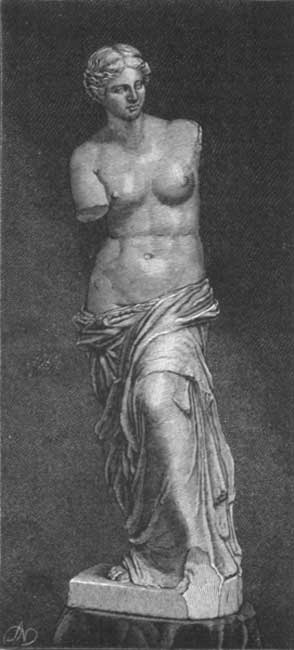 Fig. 58.—The Venus of Milo. (See page 87.)
Fig. 58.—The Venus of Milo. (See page 87.)
The Project Gutenberg EBook of A History of Art for Beginners and Students, by
Clara Erskine Clement
This eBook is for the use of anyone anywhere at no cost and with
almost no restrictions whatsoever. You may copy it, give it away or
re-use it under the terms of the Project Gutenberg License included
with this eBook or online at www.gutenberg.org
Title: A History of Art for Beginners and Students
Painting, Sculpture, Architecture
Author: Clara Erskine Clement
Release Date: May 29, 2008 [EBook #25632]
Language: English
Character set encoding: ISO-8859-1
*** START OF THIS PROJECT GUTENBERG EBOOK A HISTORY OF ART ***
Produced by Juliet Sutherland, Janet Blenkinship and the
Online Distributed Proofreading Team at https://www.pgdp.net
AUTHOR OF "HANDBOOK OF LEGENDARY AND MYTHOLOGICAL ART,"
"PAINTERS,
SCULPTORS, ENGRAVERS, ARCHITECTS AND THEIR WORKS,"
"ARTISTS OF THE
NINETEENTH CENTURY," ETC.

NEW YORK
FREDERICK A. STOKES COMPANY MDCCCXCI
Copyright, 1887,
By FREDERICK A. STOKES,
Successor to White, Stokes, & Allen.
| CHAPTER I. | |
|---|---|
| Ancient Sculpture: | |
| Egypt, | 1 |
| Assyria, | 10 |
| CHAPTER II. | |
| Greek Sculpture, | 18 |
| CHAPTER III. | |
| Ancient Italian Sculpture, | 82 |
| CHAPTER IV. | |
| Mediæval Sculpture, from the Fifth to the Fifteenth Century, | 105 |
| CHAPTER V. | |
| Italian Sculpture in the Fifteenth Century, | 136 |
| CHAPTER VI. | |
| Sculpture in Germany, France, England, and Spain, from 1450 to 1550, | 160 |
| CHAPTER VII. | |
| Italian Sculpture in the Sixteenth Century—Cellini, Michael Angelo, and Others, | 181 |
| CHAPTER VIII. | |
| European Sculpture from Michael Angelo to Canova, | 213 |
| CHAPTER IX. | |
| Canova, Thorwaldsen, and Other Recent Sculptors, | 235 |
| Venus of Milo, | Frontispiece |
| Statue of Cephren in the Museum at Cairo, | 3 |
| Various Kinds of Dogs, | 5 |
| Androsphinx, | 6 |
| Kriosphinx, | 6 |
| The Great Sphinx, | 7 |
| Hieracosphinx, | 8 |
| The Colossi at Thebes, | 9 |
| Polishing a Colossal Statue, | 10 |
| Mode of Transporting a Colossus from the Quarries (from a lithographic Drawing), | 11 |
| Statue of Sardanapalus I. (from Nimrud), | 12 |
| Lion-Hunt (from Nimrud), | 13 |
| Wounded Lion Biting a Chariot-wheel, | 15 |
| Arm-chair or Throne (Khorsabad), | 16 |
| Mode of Drawing the Bow (Koyunjik), | 17 |
| Lion Devouring Deer, | 22 |
| Heracles, Triton, and Nereids, | 23 |
| Heracles and the Cecrops, | 23 |
| Actæon and his Dogs, | 24 |
| From the Harpy Monument, London, | 25 |
| Figures from the Pediment of the Temple of Minerva, at Ægina, | 27 |
| Archaistic Artemis at Naples, | 28 |
| The Discobolus (Myron), | 30 |
| Athenian Coins with the Minerva Promachos, | 34 |
| Coin of Elis with the Olympian Zeus, | 36 |
| Bust of Jupiter found at Otricoli, | 37 |
| Torso of a Statue of Theseus (?), | 38 |
| From the Frieze of the Parthenon, | 43 |
| The Five Central Figures, | 44 |
| Youths Preparing to join the Cavalcade, | 45 |
| Horsemen Starting, | 46 |
| Procession of Cavalry, | 46 |
| Procession of Chariots, | 47 |
| Train of Musicians and Youths, | 47 |
| Cows for Sacrifice, | 48 |
| Train of Noble Maidens, | 48 |
| Head of Asclepius (in the British Museum), | 50 |
| A Wounded Amazon (Cresilas), | 52 |
| Statue of Pericles (Cresilas), | 52 |
| Eirene and the Young Plutus (Cephisodotus), | 56 |
| Portrait of Mausolus, | 57 |
| From the Frieze of the Mausoleum, | 58 |
| The Eros of Centocelle, | 60 |
| Niobe and her Youngest Daughter, | 62 |
| Brother and Sister, | 63 |
| The Eldest Daughter, | 64 |
| A Niobid, | 65 |
| Ganymede (after Leochares), | 66 |
| Monument of Lysicrates (Athens), | 67 |
| Bacchus and Lion (from the Lysicrates Monument), | 68 |
| The Apoxyomenos of Lysippus, | 69 |
| The Laocoon Group, | 75 |
| The Farnese Bull, | 77 |
| Gallic Warrior (Venice), | 78 |
| The Dying Gaul, | 79 |
| Boy and Goose, | 80 |
| Spinario, | 81 |
| Venus de' Medici, | 86 |
| The Farnesian Hercules, | 89 |
| The Apollo Belvedere, | 90 |
| Head of Apollo Belvedere, | 91 |
| The Steinhäuser Head, | 91 |
| The Stroganoff Apollo, | 92 |
| Diane à la Biche, | 95 |
| Athena of the Capitol, | 96 |
| Triumphal Procession from Arch of Titus, | 97 |
| From the Reliefs of Trajan's Column, | 99 |
| Portrait of Sophocles, | 101 |
| Statue of Augustus, | 102 |
| Agrippina the Elder, | 103 |
| Statue of St. Peter, | 106 |
| From the Cathedra of Maximianus, | 109 |
| Diptych (Zurich), | 110 |
| From the Façade of Chartres Cathedral, | 113 |
| From the North Transept of Rheims Cathedral, | 118 |
| From the West Façade of Strasburg Cathedral, | 120 |
| Duke Robert of Normandy, | 121 |
| Ivory Relief (Hunting Scene), | 124 |
| Relief by Nicola Pisano (Lucca), | 128 |
| Relief from the Pulpit at Pisa (Nicola Pisano), | 129 |
| Campo Santo of Pisa (Giovanni Pisano), | 132 |
| Relief by Jacopo della Quercia (Bologna), | 138 |
| From the Eastern Gates (showing compartments 6, 8, and 10), | 141 |
| The Annunciation (Donatello), | 143 |
| Statue of St. George (Donatello), | 144 |
| Dancing Boys (Luca della Robbia), | 147 |
| Boy with Dolphin (Verocchio), | 149 |
| Statue of Colleoni (Verocchio), | 150 |
| Terra-cottas from the Ospedale Grande (Milan), | 156 |
| Count Eberhard von Grumbach (Rimpar), | 169 |
| Justice, | 170 |
| The Three Wise Virgins, | 170 |
| Tomb of St. Sebald (Nuremberg), | 172 |
| Peter Vischer's Statue, | 173 |
| St. Sebald and the Burning Icicles (Vischer), | 174 |
| Peter (Vischer), | 175 |
| John (Vischer), | 175 |
| Man and Geese (Labenwolf), | 176 |
| Pharisee, Levite (Rustici), | 183 |
| Bacchus (Jacopo Sansovino), | 185 |
| Perseus (Benvenuto Cellini), | 191 |
| Michael Angelo's Angel (Bologna), | 197 |
| Pietà (Michael Angelo), | 199 |
| Michael Angelo's David, | 201 |
| Giuliano de' Medici (Michael Angelo), | 205 |
| Statue of Moses (Michael Angelo), | 207 |
| Mercury (Giovanni da Bologna), | 215 |
| Relief by Berruguete (Valladolid), | 217 |
| Rape of Proserpine (Bernini), | 225 |
| Caryatide (Quellinus), | 231 |
| Heads of Dying Warriors (Schlüter), | 232 |
| The Great Elector (Schlüter), | 233 |
| The Three Graces (Canova), | 241 |
| Hebe (Canova), | 246 |
| Ariadne and the Panther (Dannecker), | 249 |
| Jason (Thorwaldsen), | 256 |
| Ganymede and the Eagle (Thorwaldsen), | 260 |
| The Three Graces (Thorwaldsen), | 261 |
| Statue of Queen Louise (Rauch), | 270 |
| Nymph (by Bosio), | 273 |

No one can speak with exactness as to the time when sculpture was first practised by the Egyptians; we only know that it was a very long time ago. But we do know that in the time of the twelfth dynasty, which dates from 2466 B.C., sculpture had reached a stage of excellence such as could only have resulted from the experience of many years of training and practice in this art.
In the Egyptian collection of the Louvre, at Paris, there is the memorial stone of an old Egyptian sculptor which has an inscription that reads as if he had written it himself; this was the way by which Egyptians made these inscriptions sound as if the dead themselves spoke to those who were still alive. This sculptor's name was Martisen, and he lived about forty-four centuries ago. Brugsch-Bey, a very learned writer on Egypt, says: "He calls himself 'a master among those who understand art, and a plastic artist,' who 'was a wise artist in his art.' He relates in succession his knowledge in the making of statues, in every position,[Pg 2] according to prescribed use and measure; and brings forward, as his particular invention, an etching with colors, if I have rightly understood the expression, 'which can neither be injured by fire nor washed off by water; 'and, as a further explanation of this, states that 'no man has arisen who has been able to do this except himself alone and the eldest son of his race, whom God's will has created. He has arisen able to do this, and the exercise of his hand has been admired in masterly works in all sorts of precious stones, from gold and silver to ivory and ebony.'"
There is no doubt but that Martisen and his son, who was named Usurtasen, were sculptors at the time when Egyptian art reached its highest point.
The earliest works of Egyptian sculpture are the bas-reliefs found in the chambers of the tombs; the walls are almost covered with them, and they are painted with colors which are still bright and fresh, though more than four thousand years have passed since they were put on. The subjects of these reliefs are taken from the life of the persons buried in the tombs, and even their possessions and occupations are thus represented. These sculptures were made by tracing the designs on the stone and then cutting it away between the figures. The mode of arrangement in these reliefs does not satisfy our ideas of what it should be. It seems as if the artists had no plan of their work in their minds—no aim as to what the effect should be when finished. On the contrary, the reliefs impress us as if the sculptors made one figure, and then added another and another in such a way as to represent the fact they wished to tell without any attention to the beauty of the whole; and so it does not seem as if there was any unity in them, but as if the large bas-reliefs were made up of disjointed parts which in one sense really have no relation to each other.
The same is true of the Egyptian statues. It appears as if the different parts might have been made separately or[Pg 3] even by different sculptors, and then joined together. All this is because the Egyptians seemed to think of an object in parts and not as a whole. Then, too, the position of the early statues was so unnatural and awkward. The arms were placed close to the sides of the body, and there was no separation between the legs; and though in some of their articles of furniture, their pottery, and in the details of their architecture, the Egyptians made a great advance, they did not equally improve in their sculpture.
One great hindrance to the progress of Egyptian sculpture was the fact that figures were never represented in action. They were not figures moving and living in stone; they were like figures petrified and fixed: they were statues, and no one can forget this for a moment while looking at them. I can learn of but one Egyptian figure sculptured as if in action; this is a quoit-thrower in the Tombs of the Kings. A sitting statue, whether of a man or a woman, had the hands rested on the knees or held across the breast (Fig. 1).
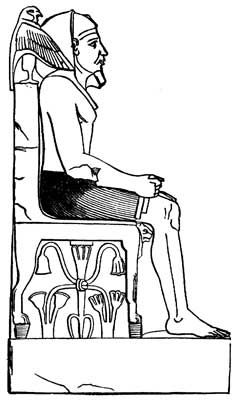 Fig. 1.—Statue of Cephren in the Museum at Cairo.
Fig. 1.—Statue of Cephren in the Museum at Cairo.
There were very few groups in Egyptian sculpture, and these seldom had more than two figures. It was customary to represent a husband and wife sitting on the same chair holding each other's hands, or having their arms around[Pg 4] one another's waists or shoulders. Sometimes the principal figure is of large size, and the inferior persons are made much smaller and placed at the sides of the larger figure. In short, very few attitudes are represented in Egyptian sculpture, and it almost seems as if there must have been fixed rules for a certain limited number of positions after which all sculptured figures were made.
In spite of this sameness and stiffness, Egyptian sculpture is remarkable, and it is probable that if they had not been fettered by prejudices and rules the Egyptians would have excelled both in sculpture and painting.
The sides of obelisks and, more especially, the walls of temples were covered with sculptures which gave the history of kings—of their wars and conquests, and of their great works in their kingdoms. The sculptures upon the temple walls could be estimated by square rods, or even acres, better than by lesser measures. Their amount and the labor it required to make them are simply marvellous.
I will describe the subjects depicted upon one inner wall in the palace-temple of Medemet Haboo, and will quote from Wilkinson's "Egypt and Thebes." On the west wall "the Egyptian princes and generals conduct the 'captive chiefs' into the presence of the king. He is seated at the back of his car, and the spirited horses are held by his attendants on foot. Large heaps of hands are placed before him, which an officer counts, one by one, as the other notes down their number on a scroll; each heap containing three thousand, and the total indicating the returns of the enemy's slain. The number of captives, reckoned one thousand in each line, is also mentioned in the hieroglyphics above, where the name of the Rebo points out the nation against whom this war was carried on. Their flowing dresses, striped horizontally with blue or green bands on a white ground, and their long hair and aquiline noses give them the character of an Eastern nation in the vicinity of[Pg 5] Assyria and Persia, as their name reminds us of the Rhibii of Ptolemy, whom he places near the Caspian." ...
The suite of this historical subject continues on the south wall. The king, returning victorious to Egypt, proceeds slowly in his car, conducting in triumph the prisoners he has made, who walk beside and before it, three others being bound to the axle. Two of his sons attend as fan-bearers, and the several regiments of Egyptian infantry, with a corps of their allies, under the command of these princes, marching in regular step and in the close array of disciplined troops, accompany their king. He arrives at Thebes, and presents his captives to Amen-Ra and Mut, the deities of the city, who compliment him, as usual, on the victory he has gained, and the overthrow of the enemy he has "trampled beneath his feet."
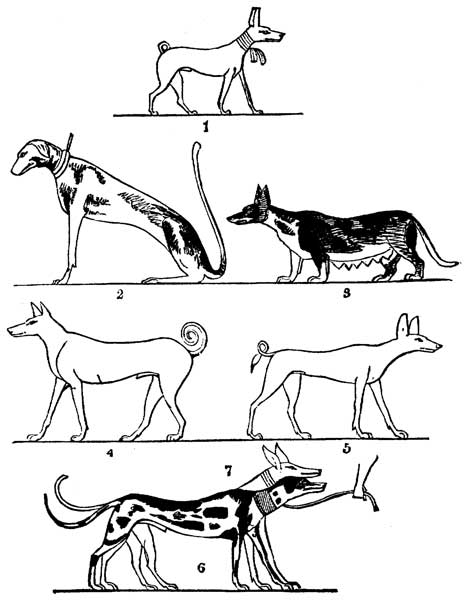 Fig. 2—Various Kinds of Dogs.
Fig. 2—Various Kinds of Dogs.
This description of these bas-reliefs, which are usually painted, will give an idea of the great works of Egyptian sculptors.
The representation of the animals in these sculptures is as successful as any part of them. There being no intel[Pg 6]lectual expression required, they are more pleasing than the human beings, with their set, unchanging features and expression. The Egyptians had several breeds of dogs, and the picture here (Fig. 2) is made up from the dogs found in the sculptures—No. 1, hound; 2, mastiff; 3, turnspit; 4, 5, fox-dogs; 6, 7, greyhounds.
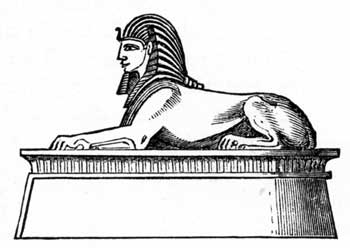 Fig. 3.--Androsphinx.
Fig. 3.--Androsphinx.
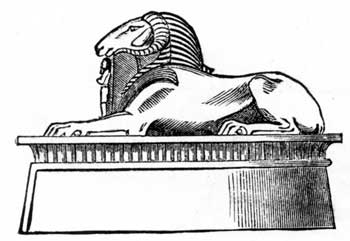 Fig. 4.—Kriosphinx.
Fig. 4.—Kriosphinx.
[Pg 7]One of the figures often repeated by the sculptors of Egypt was the Sphinx. The colossal and most famous one (Fig. 5) is not far from the great pyramid, and has the form of a recumbent lion with a human head. It is one hundred and seventy-two feet long, and is the Sphinx of the world; but there were great numbers of these strange figures in Egypt—in some cases there were avenues leading to the temples bordered by them on each side. The form of the Sphinx was intended to express some spiritual thought to the Egyptians, and the stories about it are very interesting. Its form certainly denotes the union of physical and mental power. The form of which we have spoken as being that of the great Sphinx is called the androsphinx (Fig. 3). Another has the body of the lion with the head of the ram, and is called the kriosphinx (Fig. 4); still another has the same body and the head of a hawk; this is called the hieracosphinx (Fig. 6). They all typified the king, without[Pg 8] doubt, and it is probable that the various heads were so given to show respect for the different gods who were represented with the heads of these creatures. Sometimes the androsphinx has human hands in place of the lion's paws. The winged Sphinx has been found in Egypt, but it is rare.
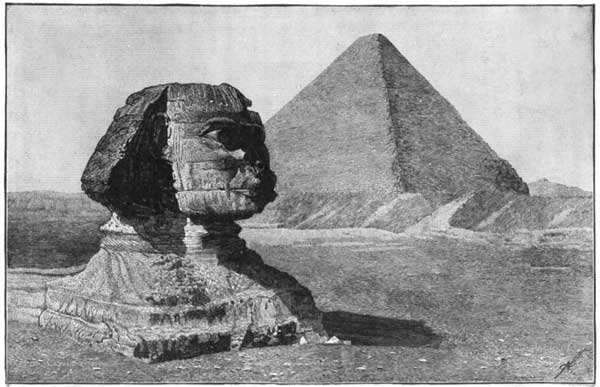 Fig. 5.—The Great Sphinx.
Fig. 5.—The Great Sphinx.
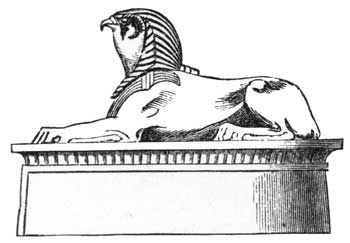 Fig. 6.—Hieracosphinx.
Fig. 6.—Hieracosphinx.
The colossal statues of Egypt are very wonderful on account of their vast weight and size. The most famous are two which stand on the west bank of the Nile at Thebes (Fig. 7). Each of these colossi is made from a single block of stone such as is not found within several days' journey of the place where they stand. They are forty-seven feet high, and contain eleven thousand five hundred cubic feet each. But a third is still larger; it represents the King Rameses II., and, when whole, was of a single stone, and weighed eight hundred and eighty-seven tons. It was brought from Assouan to Thebes, a distance of one hundred and thirty-eight miles. It is wonderful to think of moving such a vast weight over such a distance, and one would naturally wish to know also how the sculptors could work on such a statue. The plate here given (Fig. 8) shows the process of polishing a statue, and the following one (Fig. 9) illustrates the mode of moving one when finished. These representations are found in tombs and grottoes, and tell us plainly just what we wish to know about these things.[Pg 9]
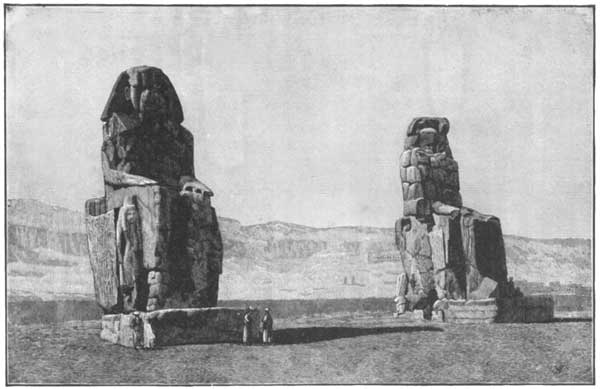 Fig. 7.—The Colossi at Thebes.
Fig. 7.—The Colossi at Thebes.
I have now pointed out the marked peculiarities of Egyptian sculpture, and before leaving the subject will call your attention to the fact that in most cases it was used in connection with and almost as a part of Egyptian archi[Pg 10]tecture. In the tombs the bas-reliefs are for the decoration of the walls and to finish the work of the architect, while at the same time they are an interesting feature of the art of the nation and period. In the temple palaces this is also true—though the reliefs serve the purpose of telling the history of the kings; they are, as it were, framed into and make a part of the architectural effect. The obelisks, colossal figures and Sphinxes were placed before the grand buildings, and made a part of them architecturally. In general terms we may say that sculpture never became an independent art in Egypt, but was essentially wedded to architecture; and this fact largely accounts for that other truth that sculpture never reached the perfection in Egypt that it promised, or the excellence that would have seemed to be the natural result of its earliest attainments.
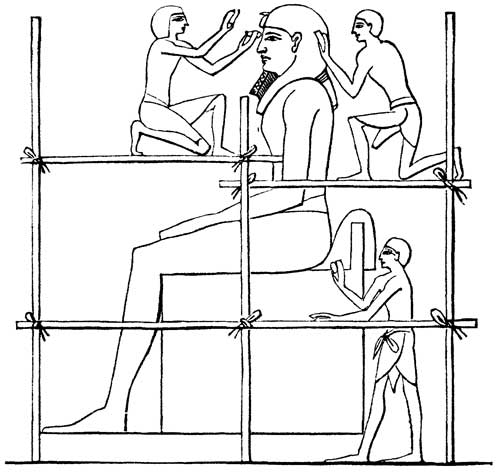 Fig. 8—Polishing a colossal Statue.
Fig. 8—Polishing a colossal Statue.
The works of sculpture in Assyria consisted of statues, bas-reliefs, statuettes in clay, carvings in ivory, metal castings, and some smaller works, such as articles for jewelry, made in minute imitation of larger works in sculpture.[Pg 11]
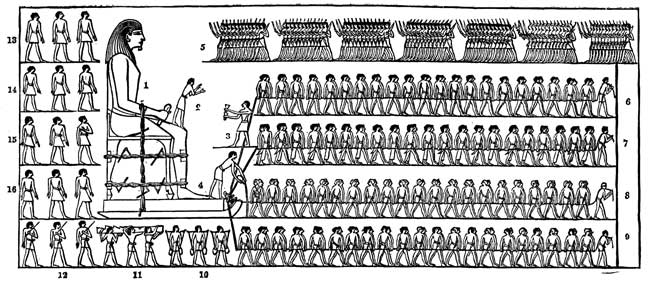 Fig. 9.—Mode of Transporting a Colossus from the
Quarries.
Fig. 9.—Mode of Transporting a Colossus from the
Quarries.In a Grotto at Dayr E'Shake, near El Bersheh.
1. The statue bound upon a sledge with ropes. It is of a private individual, not of a king, or a deity.
2. Man probably beating time with his hands, and giving out the verse of a song, to which the men responded; though 3 appears as if about to throw something which 2 is preparing to catch, or striking crotala.
4. Pouring a liquid, perhaps grease, from a vase.
5. Egyptian soldiers, carrying boughs.
6, 7, 8, 9. Men, probably captives and convicts, dragging the statue.
10. Men carrying water, or grease.
11. Some implements.
12. Taskmasters.
13, 14, 15, 16. Reliefs of men.
The statues found in Assyria are by no means beautiful, according to our idea of beauty. They are as set and stiff in design as the Egyptian works of this sort, and they have suffered so much injury from the weather and from violence that we cannot judge of the manner in which they were originally finished.
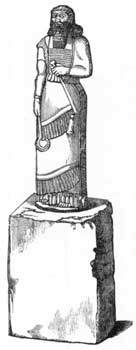 Fig. 10.—Statue of Sardanapalus I.
Fig. 10.—Statue of Sardanapalus I.The number of Assyrian statues that have been found is small; this one given here (Fig. 10), of Sardanapalus I., is in the best state of preservation of any of them. It is smaller than life size, being about forty-two inches high. The statuettes of the Assyrians are less artistic than the statues. They are made from a clay which turned red in baking, and are colored so as to resemble Greek pottery. They are almost always of a grotesque appearance, and usually represent gods or genii. They also combine human and animal forms in a less noble and artistic way than is done in the Egyptian representation of the Sphinx. There are also small figures of animals in terra-cotta, principally dogs and ducks. But the large and small statues of the Assyrians are their most unimportant works in sculpture. It is in their bas-reliefs that their greatest excellence is seen, and in them alone their progress in art can be traced. This sort of sculpture seems to have been used by the Assyrians just as painting was used in Italy after the Renaissance. It was their mode of expressing everything. Through it they gave expression to their religious feeling;[Pg 13] they told the history of their nation, and glorified their kings; they represented the domestic scenes which now make the subjects of genre pictures; and even imitated vegetables and fruits, as well as to reproduce landscapes and architecture in these pictures cut from stone. In truth, it is chiefly from the bas-reliefs that we learn the history of Assyria, and in this view their sculptures are even more important than when they are considered merely from an artistic view.
The most ancient palaces at Nimrud furnish the earliest examples of bas-relief. These date at about the end of the tenth century B.C. One striking peculiarity in the design is that all the figures, both men and animals, are given in exact profile. In spite of this sameness of position they have much spirit and action. The picture of a lion-hunt given here (Fig. 11) is one of the very best of these reliefs, and you will notice that the animal forms are much superior to those of the human beings. This is true of all Assyrian art in all its stages. In these oldest bas-reliefs there are no backgrounds; but later on these are added, and mountains, hills, streams, trees, and wild animals are all introduced as details of the general design. The highest state of this art[Pg 14] was reached about 650 B.C. At this period the various forms seem to be more varied and less arranged according to some rule. The human faces and figures are more delicately finished, and there is an air of freedom and a spirit in the handling of the subjects that is far better than that of any other time. The plants and trees are far more beautiful than before.
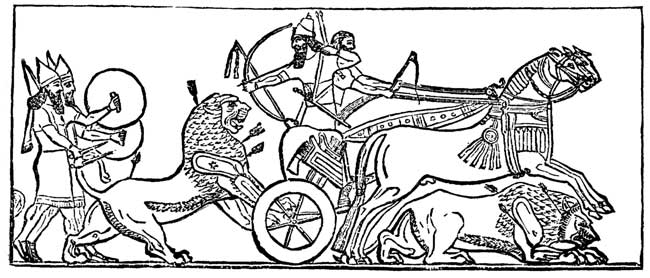 Fig. 11.—Lion-hunt.
Fig. 11.—Lion-hunt.The figures of animals, too, are full of life and action in this period. I shall only give one illustration, and shall choose the head of a lion, probably the best specimen of animal drawing which is yet known in Assyrian art. It represents the head of a wounded lion, who, in his agony, rushes upon a chariot and seizes the wheel with his teeth. The drawing of this head, as a portrayal of agony and fierceness, compares favorably with anything of the same kind belonging to any age of art, either classic or modern (Fig. 12).
There is a question which has not yet been decided as to the amount of color used on the Assyrian bas-reliefs. From the traces of color remaining on those that are found in the excavations, and from what we know of the use of colors on the buildings to which the bas-reliefs belonged, we may be sure that colors were used on them; but to what extent cannot be told. It may have been applied with the freedom of the Egyptians, or it may have been sparingly used, as was the manner of the ancient Greeks. The colors that have been found in the ruins of Assyria are white, black, red and blue.
Next to the sculpture, the metal work of the Assyrians was the most important of their arts. This work was done in three ways: I. Whole[Pg 15] figures or parts of figures cast in a solid shape. II. Castings of low bas-reliefs. III. Embossed designs made chiefly with the hammer, but finished with the graver. In the solid castings there are only animal forms, and lions are far more numerous than any other creature. Many of them have a ring fastened to the back,[Pg 16] which indicates that they were used for weights. These castings are all small and their form good; but we have no reason to think that the Assyrians could make large metal castings.
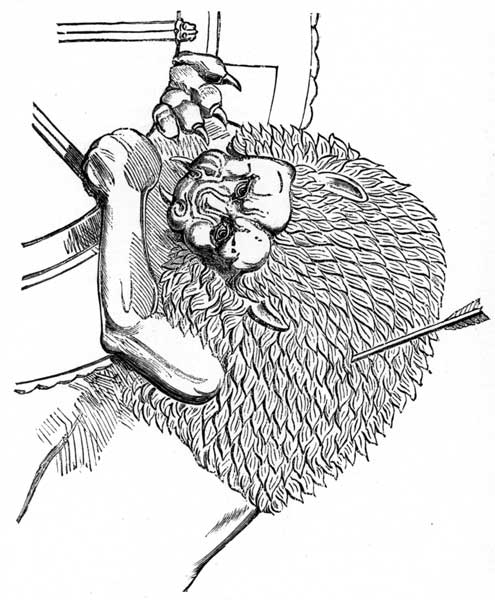 Fig. 12.—Wounded Lion biting a Chariot-wheel.
Fig. 12.—Wounded Lion biting a Chariot-wheel.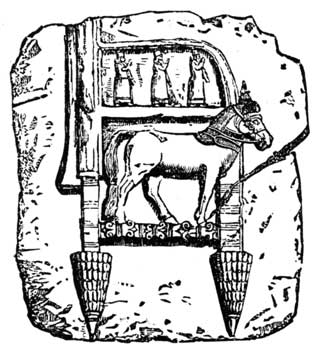 Fig. 13.—Arm-chair or Throne.
Fig. 13.—Arm-chair or Throne.The castings in relief were used to ornament thrones, furniture, and perhaps chariots. They were fastened in their places by means of small nails. They had no great merit. The embossed or hammered work, on the contrary, is artistic and very curious. Large numbers of embossed bowls and dishes have been found, and this work was used for the end of sword-sheaths, the sides of chairs and stools, and various other ornamental purposes. It is probable that the main part of the tables, chairs, and so on were of wood, with the ornaments in embossed metals. All this shows the Assyrians to have been an artistic people, and to have reached an interesting stage in their arts, though their works are coarse and imperfect when judged by Greek standards or by our own idea of what is beautiful. If we had the space to consider all the various designs of the bas-reliefs in detail, you would learn from them a great many interesting facts concerning the domestic life of this ancient and interesting people. From them we can learn all about the costumes worn by the king and those of lesser rank; can see how their wars were carried on, and[Pg 17] what their chariots, weapons, and equipments were. Their games, amusements, musical instruments, agricultural pursuits, food, and, in short, everything connected with their daily life is plainly shown in these sculptures, and, as I have said before, the whole history of Assyria is better studied from them than from any other one source. For this reason their great value cannot be over-estimated (Fig. 13).
Other very ancient nations had sculptors, and a few remains of their arts still exist. This is true of the Medes, Babylonians, and Persians; but the general features of their arts resembled those of the Assyrians, though they were less advanced than that nation, and have left nothing as interesting as the Egyptian and Assyrian remains which we have considered. I shall therefore leave them and pass to the sculpture of Greece.
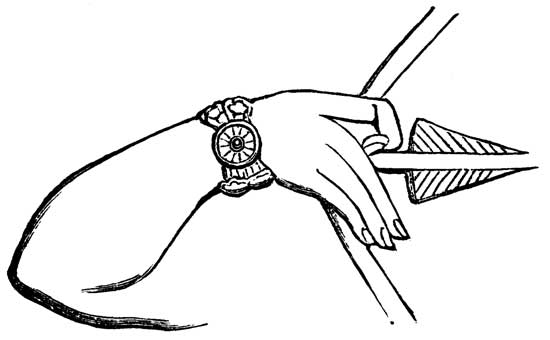 Fig. 14.—Mode of Drawing the Bow.
Fig. 14.—Mode of Drawing the Bow.
We have seen that the Egyptians and Assyrians were skilful in sculpture, but at the same time their works have not moved us as we wish to be moved by art; there is always something beyond them to be desired, and it remained for the Greeks to attain to that perfection in sculpture which satisfies all our nature and fills our highest conceptions of beauty and grace. In truth, in Greece alone has this perfection in plastic art existed, and since the time of its highest excellence there no other nation has equalled the examples of Greek sculpture which still exist, though we have reason to believe that its finest works have perished, and that those remaining are of the second grade.
There are many reasons for the high artistic attainments of the Greeks, and a discussion or even a simple statement of them would require an essay far too learned and lengthy for the scope of this book; but I will speak of one truth that had great influence and went far to perfect Greek art—that is, the unbounded love of beauty, which was an essential part of the Greek nature. To the Greek, in fact, beauty and good had the same meaning—beauty was good, and the good must be beautiful.
Sculpture deals almost exclusively with the form of man, and the other features in it have some relation to the human element of the design; and it would have been impossible for a true Greek to represent the human form[Pg 19] otherwise than beautiful. A writer on this point says: "The chief aim of the enlightened Greek, his highest ambition and his greatest joy, was to be a man in the fullest sense of the word—man in the most complete development of his bodily strength and beauty, in the active exercise of the keenest senses, in the greatest because tempered enjoyment of sensual pleasure, in the free and joyous play of an intellect strong by nature, graced and guided by the most exquisite taste, and enlightened by the sublimest philosophy." Thus, beauty was so important to the Greek that every parent prayed that his children might have this gift, and the names of beautiful persons were engraved upon pillars set where all could read them; and at times there were competitions for the prize of beauty.
The religion of the Greek, too, taught that the body was the beautiful and godlike temple of his soul; and the truth that human beings have something in common with a higher power than their own gave him a great respect for humanity, and, in truth, he felt that if he could escape death he should be content and almost, if not quite, a god. For we must remember that the gods of the Greek were not all-wise, all-powerful, and all-good, as we believe our God to be. If you read their mythology you will find that with the power of the god much imperfection and weakness were mingled. They did not believe that Zeus had been the greatest god from the beginning, but that there was a time when he had no power. He was not omniscient nor omnipresent, and was himself subject to the decrees of Fate, as when he could not save his loved Sarpedon from death. Not knowing all things, even the gods are sometimes represented as depending upon mortals for information, and all these religious views tended to make the human form far more noble to the Greek than it can be to the Christian, with his different views of the relations of God and man.
Greek sculpture existed in very early days, and we have[Pg 20] vague accounts of a person called Dædalus, who seems to have been a wood-carver. Many cities claimed to have been his birthplace, and no one can give any clear account of this ancient artist. He is called the inventor of the axe, saw, gimlet, plummet-line, and a kind of fish-glue or isinglass. He is also said to have been the first sculptor who separated the arms from the bodies of his statues, or made the feet to step out; he also opened their eyes, and there is a legend that the statues of Dædalus were so full of life that they were chained lest they should run away.
We call the time to which Dædalus belonged the prehistoric period, and his works and those of other artists of his day have all perished. Two very ancient specimens of sculpture remain—the Lion Gate of Mycenæ and the Niobe of Mount Sipylus; but as their origin is not known, and they may not be the work of Greek artists, it is best for us to pass on to about 700 B.C., when the records of individual artists begin.
Among the earliest of these was Dibutades, of whom Pliny said that he was the first who made likenesses in clay. This author also adds that Dibutades first mixed red earth with clay, and made the masks which were fastened to the end of the lowest hollow tiles on the roofs of temples. Pliny relates the following story of the making of the first portrait in bas-relief.
Dibutades lived in Sicyon, and had a daughter called sometimes Kora, and again Callirhoe. She could not aid her father very much in his work as a sculptor, but she went each day to the flower-market and brought home flowers, which gave a very gay and cheerful air to her father's little shop. Kora was very beautiful, and many young Greeks visited her father for the sake of seeing the daughter. At length one of these youths asked Dibutades to take him as an apprentice; and when this request was granted the young man made one of the family of the[Pg 21] sculptor. Their life was one of simple content. The young man could play upon the reed, and his education fitted him to be the instructor of Kora. After a time, for some reason that Pliny does not mention, it was best for the youth to go away from the artist's home, and he then asked Kora if she would be his wife. She consented, and vows of betrothal were exchanged, while they were sad at the thought of parting.
The last evening of his stay, as they sat together, Kora seized a coal from the brazier, and traced upon the wall the outline of the face that was so dear to her; and she did this so correctly that when her father saw it he knew instantly from what face it had been drawn. Then he wished to do his part, for he also loved the young man. So he brought his clay and filled in the outline which Kora had drawn, and so went on to model the first portrait in bas-relief that was ever made. Thus did this great art grow out of the love of this beautiful maiden of Sicyon, about twenty-five hundred years ago.
After this beginning Dibutades went on to perfect his art. He made medallions and busts, and decorated the beautiful Grecian structures with his work, and work in bas-relief became the most beautiful ornamentation of the splendid temples and theatres of Greece. He also founded a school for modelling at Sicyon, and became so famous an artist that several Greek cities claim the honor of having been his birthplace.
The bas-relief made from Kora's outline was preserved in the Nymphæum at Corinth for almost two hundred years, but was then destroyed by fire. She married her lover, and he became a famous artist at Corinth.
We have said that accounts of individual artists exist from about 700 B.C.; but these accounts are of so general a character and so wanting in detail that I shall pass on about two hundred years, after saying a few words of the[Pg 22] advance made in the arts of sculpture, and mentioning a few of the examples which remain from that early time, which is called the Archaic period. This expression not only means an ancient period of art, but carries also the idea of an obsolete art—of something that is not only ancient, but something that is no longer practised in the same manner or by the same people as existed in this ancient or archaic time. During this archaic period a beginning was made in many branches of plastic art. There were statues in metal and marble, bas-reliefs in various kinds of stone and marble, as well as some chryselephantine statues. This kind of work is often said to have been invented by Phidias, but the truth seems to be that he was not its inventor, but carried it to great perfection. These chryselephantine statues were made of wood and then covered with ivory and gold; the ivory was used for the flesh parts of the statue, and gold for the drapery and ornaments of the figure, and the finished work was very brilliant in its effect.
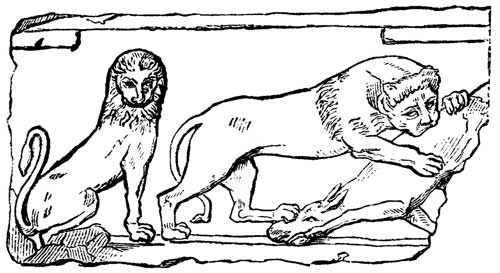 Fig. 15.—Lion devouring Deer.
Fig. 15.—Lion devouring Deer.
The principal subjects represented in the sculpture of the archaic period were connected with the religion of the Greeks, which is known to us as mythology. Most statues were of the gods, but portrait statues were not unknown, and the custom of setting up statues of the victors in the Greek games dates back to this very early time. This was a custom which afforded a large field for sculptors to work in, and must have had a great influence to give life and progress to their art.[Pg 23]
Of the remains of this art very interesting things have been written, but I shall speak only of a few such objects of which pictures can be given to aid you in understanding about them. Among the earliest reliefs that have been preserved are those now in the Museum of the Louvre, at Paris, which were found in the ruins of a Doric temple at Assos (Fig. 15).
 Fig. 16.—Heracles, Triton, and Nereids.
Fig. 16.—Heracles, Triton, and Nereids.
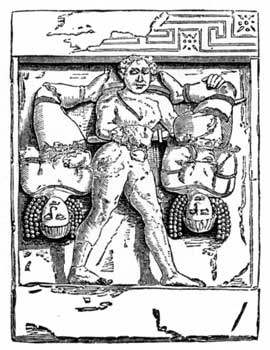 Fig. 17.—Heracles and the Cecrops.
Fig. 17.—Heracles and the Cecrops.
The various designs upon these marbles seem to have no connection with each other, and are executed in a rude manner. The most interesting one represents Heracles, or Hercules, struggling with a Triton (Fig. 16).
The female figures represent Nereids, who are terrified by seeing Heracles in contest with the sea-monster. There are many proofs that these reliefs belong to a very ancient day.
An interesting relief from the temple of Selinus represents Heracles striding off with a pole across his shoulders, to which are hung two Cecrops who had robbed and tormented him (Fig. 17).[Pg 24]
A very fine work is also from Selinus, and represents Actæon torn by his dogs. The mythological story was that Zeus, or Jupiter, was angry with Actæon because he wished to marry Semele, and the great god commanded Artemis, or Diana, to throw a stag's skin over Actæon, so that his own dogs would tear him. In the relief Artemis stands at the left (Fig. 18).
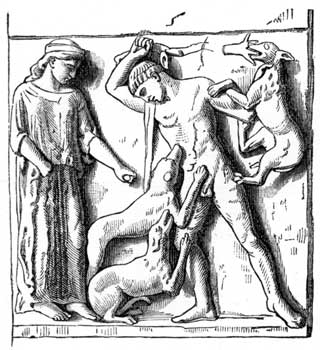 Fig. 18.—Actæon and his Dogs.
Fig. 18.—Actæon and his Dogs.
There is in the British Museum a monument which was discovered at Xanthos in 1838. It is thought to have been made about 500 B.C., and is called "The Harpy Monument," It is a tower, round the four sides of which runs a frieze at a height of about twenty-one feet from the ground. The frieze is of white marble, and is let into the frieze which is of sandstone. The Lycians, in whose country it was found, were accustomed to bury their dead at the top of such towers.
There is very great difference of opinion among scholars and critics concerning the meaning of the various scenes in these sculptures; and as all their writing is speculation, and no one knows the truth about it, I shall only say that it is a very interesting object in the history of art, and shall speak of the four corner figures on the shortest parts of the frieze, from which the whole work takes its name. The Harpies[Pg 25] are very curious; they had wings, and arms like human arms, with claws for hands, and feathered tails. Their bodies are egg-shaped, which is a very strange feature in their formation. We cannot explain all these different things, but there is little doubt that, with the little forms which they have in their arms, they represent the messengers of death bearing away the souls of the deceased. In the Odyssey, Homer represents the Harpies as carrying off the daughters of King Pandareus and giving them to the cruel Erinnyes for servants. For this reason the Harpies were considered as robbers, and whenever a person suddenly disappeared it was said that they had been carried off by Harpies (Fig. 19).
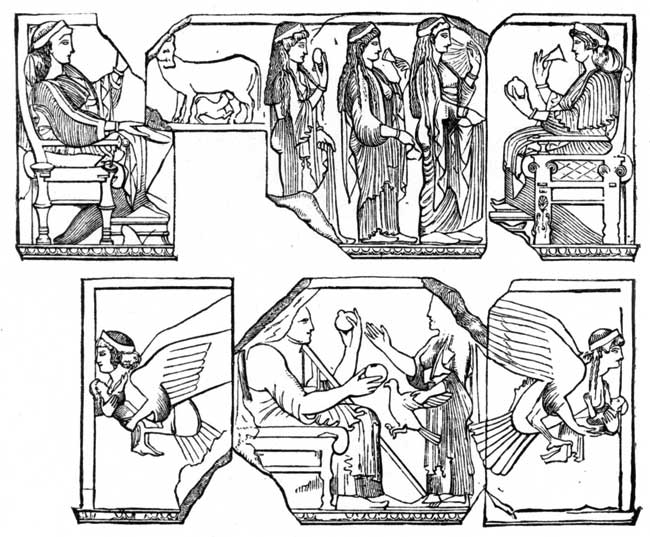 Fig. 19.—From the Harpy Monument, London.
Fig. 19.—From the Harpy Monument, London.
Before leaving this subject of existing sculptures from the fifth century B.C., I will speak of the two groups which belonged to the temple of Minerva in Ægina, and are now in the Glyptothek at Munich. The city of Ægina was the[Pg 26] principal city of the island of Ægina, which was in the gulf of the same name, near the south-west coast of Greece. This city was at the height of its prosperity about 475 B.C., at which time a beautiful temple was built, of which many columns are still standing, though much of it has fallen down. In 1811 some English and German architects visited this place, and the marbles they obtained are the most remarkable works which still exist from so early a period. Thorwaldsen, the Danish sculptor, restored these reliefs, and the King of Bavaria bought them.
Upon the western pediment there were eleven figures which represented an episode in the Trojan war; it was the struggle of Ajax, Ulysses, and other Greek warriors to obtain the dead body of Achilles, which was held by the Trojans. The story is that the goddess Thetis had dipped her son Achilles in the river Styx for the purpose of making him invulnerable, or safe from wounds by weapons. But as she held him by the ankles they were not wetted, and so he could be wounded in them. During the siege of Troy Apollo guided the arrow of Paris to this spot, and the great leader of the Greeks was killed. It is believed that the warrior in this picture who is about to send his arrow is Paris. In the central or highest part of the pediment the goddess Minerva stands and tries to cover the fallen body of Achilles with her shield. These figures are on the side where the space grows narrower. You can judge of what the action and spirit of the whole must be when these smaller figures have so much. We are sure that the arrow will shoot out with such force as must carry death to its victim, and the second warrior, who braces himself on his feet and knee, will thrust his lance with equal power (Fig. 20).
There are traces of color and of metal ornaments upon these Æginetan statues; the weapons, helmets, shields, and quivers were red or blue; the eyes, hair, and lips were[Pg 27] painted, and there are marks upon the garments of the goddess that show that she must have had bronze ornaments. There was a famous sculptor of Ægina named Callon, who lived about the time that this temple was built; and though it is not known to be so, yet many critics and scholars believe that he may have been the sculptor of these works, because they resemble the written descriptions of his statues and reliefs.
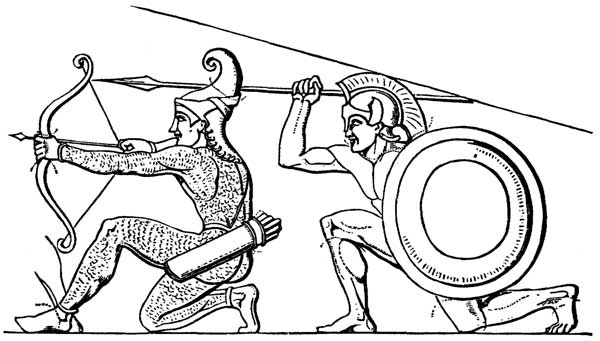 Fig. 20.—Figures from the Pediment of the Temple of
Minerva, at Ægina.
Fig. 20.—Figures from the Pediment of the Temple of
Minerva, at Ægina.
There was a period which we call archaistic, and by this we indicate a time when it was the fashion for the sculptors to imitate as nearly as possible the works of the true archaic period. It has constantly happened in the history of society that fashion has ordained this same thing, though the objects of imitation have varied with the different ages and nations. This archaistic "craze" to imitate old sculptures was at its height in the times of the Roman emperors Augustus and Hadrian; but here in America we have seen the same passion manifested in the desire to have such furniture as Queen Anne and her people admired, or such as "came over in the Mayflower;" and when the true original articles were no longer to be found in garrets and out-of-the-way places, then manufacturers began to imitate[Pg 28] the old in the new, and one can now buy all sorts of ancient-looking furniture that is only just from the workmen's hands.
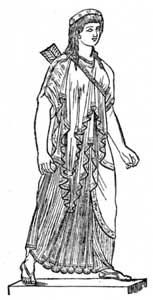 Fig. 21.—Archaistic Artemis at Naples.
Fig. 21.—Archaistic Artemis at Naples.
But among the Greeks there was a second motive for reproducing the works of the earlier artists, which was the fact that the images of the gods and such articles as belonged to religious services were sacred in their earliest forms, and were venerated by the people. Thus it followed that the advance and change in the taste of the people and the skill of the artists was more suited to other subjects, while the religious images were made as nearly as possible like the older ones. If it happened that a rude ancient image of a god was placed side by side with a modern and more beautiful statue of the same deity, the pious Greek would prefer the ugly one, while he could well admire the most lovely. You should remember that these temple images were really objects of actual worship.
Many of these archaistic works are in various museums of art.
This is a very beautiful temple image, and was discovered at Pompeii in 1760. It was found in a small temple or chapel, of which it must have been the principal deity. It is in excellent preservation; the only parts which are wanting are the fingers of the right hand and the object which it held. Like many of these statues, it is less than life-size—four feet and two inches in height. When it was first discovered there were many traces of color about it. The hair was gilded to represent the blonde hair which the poets ascribed to Artemis (Diana). There was considerable red about the garments, and some flowers were upon the border[Pg 29] of the drapery. There is an archaic stiffness about this statue, but the flowing hair, the form of the eyes, and the free style of the nude parts all show that it belongs to the archaistic period (Fig. 21).
It would be pleasant and satisfying if we could trace step by step the progress of Greek sculpture from the rude archaic manner to that of the Periclean age, or from such art as is seen in the sculpture of Ægina to the perfections of the reliefs of the Parthenon. This we cannot do; but we know some of the causes that led to this progress, and can give accounts of a few sculptors who, while they did not equal the great Phidias, were at least the forerunners of such a type of art as his.
The chief cause of the progress of art was the greater freedom of the artist in the choice and treatment of his subjects. So long as the subjects were almost entirely religious there could be little variety in the manner of treating them. Each god or goddess had its own attributes, which must be rendered with exact care; and any new mode of portraying them was almost a sacrilege. But as time passed on and the Panhellenic games and the national Pantheon at Olympia grew into their great importance, new subjects were furnished for the artists, which allowed them to show their originality and to indulge their artistic imaginations to their fullest extent. The victors in the games were heroes, and regarded even as demi-gods, and statues were allowed to be erected to them, although this had hitherto been considered a divine honor and was accorded to the gods alone. When these heroes were represented, the artists, not being bound by any laws, could study their subjects and represent them to the life as nearly as they were able to do. This exaltation of the Olympian victors gave an opportunity for the development of sculpture such as cannot be over-estimated in its influence and results.
Another characteristic of the art of the time we are now[Pg 30] considering was the almost universal use of bronze. This metal is excellent for displaying the minute features of the nude parts of statues, but it is not equal to marble in the representation of draperies or for giving expression to the face. Pythagoras of Rhegium was a famous artist who worked entirely in bronze. The only copies from his works of which we know are on two gems, one of which is in the Berlin Museum. He made exact studies of the body in action, and gave new importance to the reproduction of the veins and muscles. It is also claimed that Pythagoras was the first to lay down clearly the laws of symmetry or proportion which is governed by strict mathematical rules.
Myron of Eleutheræ flourished about 500 to 440 B.C., and was reckoned among Athenian artists because, though not born at Athens, he did most of his works there, and his most famous work, the statue of a cow, stood on the Acropolis of that city. This cow was represented as in the act of lowing, and was elevated upon a marble base. It was carried from Athens to Rome, where it stood in the Forum of Peace. Many writers mentioned this work of Myron's, and thirty-seven epigrams were written concerning it.
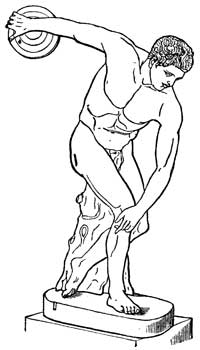 Fig. 22.—The Discobolus.
Fig. 22.—The Discobolus.
Though the cow was so much talked of, the artistic fame of Myron rests more upon the "Discobolus," or quoit-thrower. The original statue does not exist, but there are several copies of it. That in the Massimi Villa is[Pg 31] a very accurate one, and was found on the Esquiline Hill at Rome in A.D. 1782; our illustration is made from this statue. Myron's great skill in representing the human figure in excited action is well shown in the quoit-thrower. To make such a figure as this requires great power in a sculptor. No model could constantly repeat this action, and if he could there is but a flash of time in which the artist sees just the position he reproduces. This figure, however, is so true to life that one feels like keeping out of the range of the quoit when it flies (Fig. 22). There are several other existing works attributed to Myron: they are a marble copy of his statue of Marsyas, in the Lateran at Rome; two torsi in the gallery at Florence; a figure called Diomed, and a bronze in the gallery at Munich.
Myron made statues of gods and heroes, but he excelled in representing athletes. His works were very numerous, and a list of those which are only known through the mention of them by various writers would be of little value here. While Myron reproduced the form and action of the body with marvellous effect, he made no advance in representing the expression of the face, nor in the treatment of the hair. He was daring in his art, for he not only imitated what he saw in life, but he also represented grotesque imaginary creatures, and in many ways proved that he had a rich creative fancy.
A third sculptor of this time was Calamis, who was in his prime about B.C. 450. He was not born in Athens, but he worked there. Calamis added to the exact representations of Pythagoras and Myron the element of grace beyond their powers in that direction. He made a greater variety of figures than they, for to gods and heroes he added heroines, boys and horses. His works were in bronze, gold and ivory, as well as marble. But what we know of Calamis is gathered from the writings of Greek authors rather than from works, or copies of works, by him still existing;[Pg 32] indeed, no statue remains known to be his own, though there are some which critics fancy may be so. But we may be certain of his great excellence from the many praises sung and said of him, and Lucian, who knew all the best works of all the greatest masters of Greece, puts Calamis before them all for elegance and grace, and for the finer expression of faces; when imagining a beautiful statue of a young girl he declares that he would go to Calamis to impart to it a chaste modesty and give it a sweet and unaffected smile.
Phidias is the most famous of all Greek sculptors, and as Greek sculpture is the finest sculpture of which we have any knowledge, it follows that Phidias was the first sculptor of the world. And yet, in spite of his fame, we do not know the time of his birth. We know that he was the son of Charmidas, but we know nothing of the father except that he had a brother who was a painter, and this makes it probable that the family of Phidias were artists.
As nearly as can be told, Phidias was born about B.C. 500. This would have made him ten years old at the time of the battle of Marathon and twenty years old when Salamis was fought, while he came of age at the time of Platæa. He seems to have begun his artistic life as a painter, and we know nothing of him as an independent sculptor until the administration of Cimon, about B.C. 471. But his finest works belong to the time of Pericles, who was his friend as well as patron, and made him the master over all the great public works at Athens during what we speak of as the Periclean age.
It seems that the favor of Pericles was a dear privilege to Phidias, for it exposed him to bitter envy and hatred; and those who feared to attack Pericles himself avenged themselves upon Phidias, and accused him of dishonesty in obtaining the gold for the robe of the statue of Minerva which he made for the Parthenon. He proved himself in[Pg 33]nocent of this, but he was accused of other crimes, and one account says that he was thrown into prison and died there of disease or poison. Another account relates that the great sculptor went into exile at Elis, where he made his most famous statue, the Olympian Zeus, and that he was there convicted of theft and put to death. With such contradictory stories we cannot know the exact truth; but we do know that he went to Elis accompanied by distinguished artists. He was received with honor, and for a long time the studio that he occupied there was shown to strangers. The Olympians also allowed him an honor which the Athenians never extended to him—that is, to inscribe his name upon the base of the statue of Zeus, which he was not permitted to do in the case of the Minerva (or Athena) of the Parthenon.
It often happens in the case of a very great man that the events which have preceded his manhood have prepared the way for him and his work in so striking a manner that it seems as if he could not have been great at any other time, and that he could not avoid being so, when everything had been shaped to his advantage. This was true of Phidias. When he came to be a man the dreadful wars which had ravaged Greece were over, and the destruction of the older structures prepared the way for the rebuilding of Athens. Large quantities of "marble, bronze, ivory, gold, ebony and cypress wood" were there, and a great number of skilful workmen were at hand to work under his command. The Athenians were ablaze with zeal to rebuild the temples and shrines of their gods, who, as they believed, had led them to their victories, and not only the public, but the private means were used to make Athens the grandest and most beautiful city of the world.
The first great work with which the name of Phidias was connected was the building of the temple of Theseus, called also the Theseion. This was a very important temple, and was constructed in obedience to the command of an oracle[Pg 34] in this wise: In B.C. 470 the island of Scyros had been taken by the Athenians, and upon this island Theseus had been buried. After the battle of Marathon, in which he had aided the Athenians, Theseus was much regarded by them, and in B.C. 476 they were directed to remove his bones to Athens and build over them a shrine worthy of so great a champion. Just then a gigantic skeleton was discovered at Scyros by Cimon, and was brought to Athens with great ceremony, and laid to rest with pompous respect, and the splendid temple dedicated to Theseus was begun, and Phidias was commissioned to make its plastic ornaments. The precincts of this temple later became a sanctuary where the poor man and the slave could be safe from the oppressor.
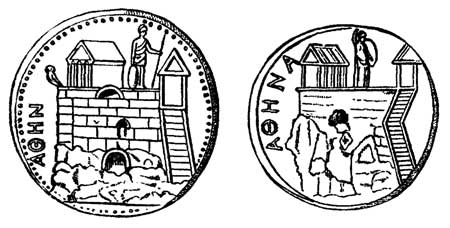 Fig. 23.—Athenian Coins with the Minerva Promachos.
Fig. 23.—Athenian Coins with the Minerva Promachos.
Phidias executed many works under the patronage of Cimon, the greatest of which was the colossal statue of Minerva, which stood on the Acropolis. It was called the "Minerva Promachos," and was so gigantic that "the crest of her helmet and the point of her spear could be seen by the mariner off the promontory of Sunium glittering in the sunlight as a welcome to her own chosen people, and an awful warning to her foes." The meaning of Promachos may be given as champion or guardian, and we know from existing descriptions that, with its pedestal, it must have been at least seventy feet in height. It was made from the spoils taken at Marathon; its pedestal was found, in 1840, standing between the Parthenon and the Erechtheium. It has been called the "Pallas with the golden spear," for this goddess was known as Athena, Minerva, and Pallas, and it is said that[Pg 35] Alaric was so impressed by its awful aspect that he shrank from it in horror. The only representations of this statue now in existence are upon Athenian coins, and the position of the goddess differs in these, as you will see by the illustration (Fig. 23); there are reasons for believing that the one in which the shield rests upon the ground is correct, one of which is that some years after the death of Phidias the inside of the shield was ornamented by a relief of the battle of the Centaurs.
Though Phidias proved himself to be a great artist during the reign of Cimon, it was not until the time of Pericles that he reached the glorious height of his genius. Pericles and Phidias seem to have been two grand forces working in harmony for the political and artistic grandeur of Athens, and, indeed, of all Attica, for within a period of twenty years nearly all the great works of that country were begun and completed. Plutarch writes of these wonders in these words: "Hence we have the more reason to wonder that the structures raised by Pericles should be built in so short a time, and yet built for ages. For as each of them, as soon as it was finished, had the venerable air of antiquity, so now that they are old they have the freshness of a modern building. A bloom is diffused over them which preserves their aspect untarnished by time, as if they were animated with a spirit of perpetual youth and unfading elegance."
It is quite impossible that I should speak here of the works of Phidias in detail, and I have decided to speak only of the frieze of the Parthenon, because the Elgin marbles enable us to give illustrations from it and to know more about this than of the other works of the great masters about whom whole volumes might be written with justice. But, first, I will give a picture of a coin which shows the great Olympian Zeus, or Jupiter, which Phidias made at Elis, after he was an exile from Athens (Fig. 24). When[Pg 36] Phidias was asked how he had found a model for this Jupiter, he quoted the lines from Homer:
"He said, and nodded with his shadowy brows,
Waved on the immortal head the ambrosial locks,
And all Olympus trembled at the nod."
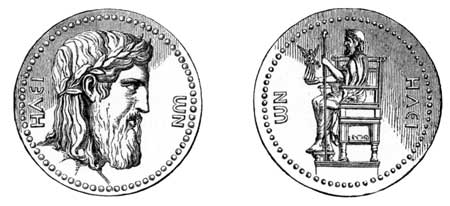 Fig. 24.—Coin of Elis with the Olympian Zeus.
Fig. 24.—Coin of Elis with the Olympian Zeus.
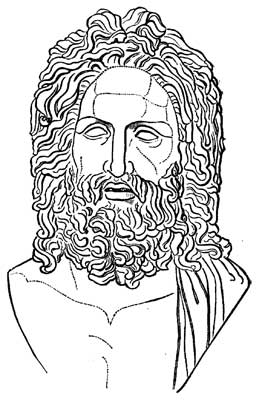 Fig. 25.—Bust of Jupiter found at Otricoli.
Fig. 25.—Bust of Jupiter found at Otricoli.
The writings of the ancients have almost numberless references to this statue, and its praise is unending. It was colossal in size and made of ivory and gold, and one historian says that though the temple had great height, yet the Jupiter was so large that if he had risen from his throne he must have carried the roof away. It is related that when the work was completed Phidias prayed to Jupiter to give him a sign from heaven that he might know whether his work was pleasing to the great god or not. This prayer was answered, and a flash of lightning came which struck the pavement in front of the statue. This statue was reckoned among the seven wonders of the world, and it is believed that the magnificent bust called the "Jupiter Otricoli" is a copy from the Olympian statue (Fig. 25).
I shall speak in another volume (upon Architecture) of the former glory and the present ruin of the Parthenon at Athens, and tell how upon its decoration Phidias lavished his thought and care until it surpassed in beauty any[Pg 37] other structure of which we have knowledge. Early in the present century Lord Elgin, the English Ambassador to the Porte, interested himself in having the sculptures found in the ruins taken to England. In 1812 eighty chests containing these priceless works of the greatest sculptor who ever lived were placed in Burlington House, and a few years later Parliament purchased them for £35,000, and they were placed in the British Museum, where they now are. There is a great number of them, and all are of great interest; but I shall pass over the metopes and the pediments, and shall pass to the frieze after speaking of this one figure of Theseus, which is from the sculptures of the eastern pediment. The sculptures upon this pediment represented the story of the birth of Athena, and it was proper that Theseus should be present, as he was king over Athens, of which city Athena, or Minerva, was the protecting goddess. Torso is a term used in sculpture to denote a mutilated figure, and many such remains of ancient sculpture exist which are so beautiful, even in their ruin, that they are the pride of the museums where they are, and serve as studies for the artists of all time. This figure of Theseus is wonderful for the majesty and grace of its attitude, for perfection of its anatomical accuracy, and for[Pg 38] the appearance of elasticity of muscle with which it impresses one, even though made of marble. It really seems as if the skin could be moved upon it, so soft does its surface look to be. It is ranked as the greatest miracle of sculpture. Though it is called a Theseus, I ought to state that some critics take exceptions to this name, and believe it to be Hercules or Bacchus; but by almost general consent it is called a Theseus (Fig. 26).
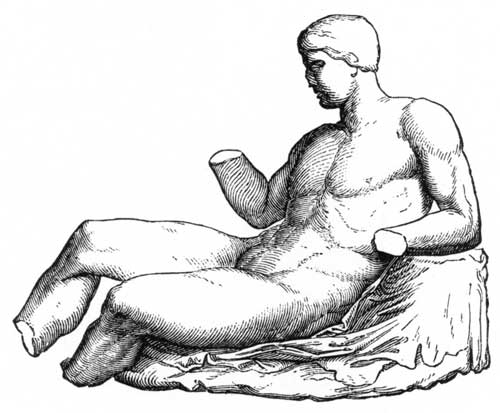 Fig. 26.—Torso of a Statue of Theseus (?).
Fig. 26.—Torso of a Statue of Theseus (?).
We may imagine that the representation upon this eastern pediment must have been magnificent. Of course the chosen goddess of Athens would be made to appear with great glory. The myth relates that Athena was born in an instant, by springing forth from the head of Zeus, or Jupiter, fully armed. It is believed that in this sculpture she was represented a moment after birth when she appeared in full, colossal majesty, shouting her war-cry and waving her lance—something as these lines represent the scene:[Pg 39]
"Wonder strange possessed
The everlasting gods, that shape to see
Shaking a javelin keen, impetuously
Rush from the crest of ægis-bearing Jove.
Fearfully Heaven was shaken, and did move
Beneath the might of the Cærulean-eyed
Earth dreadfully surrounded far and wide,
And lifted from its depths; the sea swelled high
In purple billows."
It is very important, when considering the sculpture at Athens, to know something about the character of this goddess whose power and influence was so great there. I shall give an extract from an English writer on Greek sculpture, Mr. Walter Copeland Perry:
"It is a very remarkable fact, and one which gives us a deep insight into the character of the Athenians, that the central figure in their religion, the most perfect representative of their feelings, thoughts, and aspirations, was not Zeus or Hera (Juno), nor the most popular gods of all times and nations, Ares (Mars) and Aphrodite (Venus), but Athena, the virgin, the goddess of wise counsel and brave deed! She was enthroned in the very heart of their citadel; and she stood in colossal grandeur on the battlements to terrify their foes, and to give the first welcome to the mariner or the exile when he approached his divine and beautiful home, which reposed in safety under the protection of her lance and shield."
The attributes of this goddess, as given in Greek literature and shown forth in Greek art, are very varied and hard to be understood as belonging to one person. She is the patroness of war, and in Homer's Iliad she is represented as rushing into battle in this wise:
"The cuirass donn'd of cloud-compelling force
And stood accoutred for the bloody fray.
Her tasselled ægis round her shoulders next
[Pg 40]She threw, with terror circled all around,
And on its face were figured deeds of arms
And Strife and Courage high, and panic Rout.
There too a Gorgon's head of monstrous size
Frown'd terrible, portent of angry Jove.
. . . . . . . In her hand
A spear she bore, long, weighty, tough, wherewith
The mighty daughter of a mighty sire
Sweeps down the ranks of those her hate pursues."
But this warlike goddess is also represented as the wise counsellor who restrains Achilles from rash action; and though she does not shrink from war and danger, yet the most precious gift to her people was not the war-horse, but the olive, the emblem of peace, and to her honor was this sacred tree planted. "She stands in full armor, with brandished lance, on the highest point of the Acropolis, and yet she is the patroness of all household and female work, in which she herself excels."
It is very interesting to notice that in the early representations of Athena, while she is very warlike in her bearing and raises her lance in her right hand, she also carries in her left the distaff and the spindle and the lamp of knowledge. In the later art of Phidias she is still stern and severe, but her face also expresses dignity and grandeur of thought and character. Later still, her warlike attributes are made less prominent: the shield rests on the ground, and the lance is more like a sceptre, until, in the decline of art, she is represented as lovely and gentle, and all her grand power is lost, and she is not above a great number of other goddesses who are attractive for their soft, lovely grace, but have no selfhood, no individuality to command our admiration or respect.
We come now to speak of the Elgin marbles from the frieze of the Parthenon. It was about thirty-five feet above the floor, three feet three inches broad, and about five hundred and twenty-two feet long. It represented a continuous procession, and the subject is called[Pg 41] the great Panathenaic Procession. About four hundred feet of this frieze remains, so that a good judgment can be formed of it. First I must tell you what this procession means. The festival of the Panathenæa was the most important of all the splendid pomps which were celebrated at Athens. It is probable that this festival was held every year about the middle of August, but the great Panathenaic occurred only in the third year of each olympiad; an olympiad was a period of four years, extending from one celebration of the Olympic games to another, which was an event of great importance in reckoning time with the Greeks; thus we see that the great procession represented on the frieze occurred once in every four years. This festival continued several days, and all were filled with horse-racing, cock-fighting, gymnastic and musical contests, and a great variety of games; poets also recited their verses, and philosophers held arguments in public places.[A] But the most important day was that on which a procession went up to the Parthenon and carried the peplos, or garment for the great goddess, which had been woven by the maidens of Athens. This peplos was made of crocus-colored stuff, on which the figures of the gods engaged in their contests with the giants appeared in beautiful, rich embroidery. In later years, after the Athenians had fallen from their first high-minded simplicity, they sometimes embroidered on the peplos the likeness of a man whom they wished to flatter, as thus placing him in the company of the gods was a very great compliment.
[A] In the Persian invasion of Greece by Xerxes, B.C. 480, that monarch was surprised to learn that the Olympic games were not suspended at the approach of his army.
The procession of the peplos was formed at daybreak in the Potters' Quarter of the city, and passed to the Dromos, then to the market-place, onward to the temple[Pg 42] of Demeter, round the Acropolis along the Pelasgic wall, through the Propylæa to the temple of Athena Polias. The procession was as splendid as all the wealth, nobility, youth and beauty of Athens could make it. Of the vast multitude which joined it some were in chariots, others on horses and almost countless numbers on foot. After the most important officers of the government come the envoys of the Attic colonies with the noble Athenian maidens, the basket-bearers, the aliens who resided in Athens dressed in red instead of white, and a chosen company of aged men bearing branches of the sacred olive.
The peplos was not borne by hands, but was suspended from the mast of a ship, upon wheels, which some writers say was moved by machinery placed underground. When the temple was reached the splendid garment was placed upon the sacred statue, which was believed to have fallen from heaven. During the festival of the Panathenæa prisoners were permitted to enjoy their freedom, men whose services to the public merited recognition received gifts of gold crowns, and their names were announced by heralds in public places, and many interesting ceremonies filled up the time. We do not know the exact order in which all these things happened; but it is believed that the procession of the peplos was the crowning glory of it all, and was celebrated on the final day.
The plan of the Parthenon frieze which represented this great procession was as follows: On the eastern side above the main entrance to the temple there were two groups of the most important and powerful of the many gods of the Greek religion. Each of these groups had six gods and an attendant, so that there were seven figures in each of these groups, as you will see by the illustration (Fig. 27).
There has been much study of these sculptures, and many scholars have written about them. There is still a difference of opinion as to which gods are here represented,[Pg 43] but I shall give you the most generally accepted opinion, which calls a, Hermes, or Mercury, the messenger of the gods; b, Apollo; c, Artemis, or Diana; d, Ares, or Mars; e, Iris, who is attending upon f, Hera, or Juno; g, Zeus, or Jupiter; h, Athena, Minerva, or Pallas; i, Hephæstus, or Vulcan; j, Poseidon, or Neptune; k, Dionysus, or Bacchus; l, m, n are more doubtful, but are probably Aphrodite, or Venus, Demeter, or Ceres, and Triptolemus, the boy who was a favorite with Ceres, who invented the plough and first sowed corn.
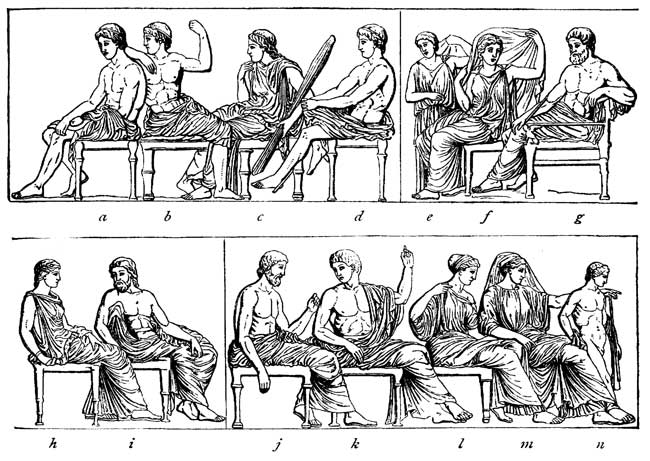 Fig. 27.
Fig. 27.
Now, these two groups of divinities were divided by a very singular group containing five figures (Fig. 28).
There has been much controversy as to these figures and what they are doing. They seem to be unconscious of the great gods who are near to them on either side. The greater number of critics consider that the two maidens, e and d, are of the number who have embroidered the[Pg 44] peplos; the central figure, c, a priestess of Athena; a, the Archon Basileus; and b, a consecrated servant-boy, who is delivering up the peplos. Other critics believe, however, that these figures are all preparing for the sacred ceremonies about to begin, and that the priest is giving the boy-servant a garment which he has taken off. Other theories may arise, and we can only listen to them all, and yet not know the truth; but the more we study the more we shall admire these exquisite figures.
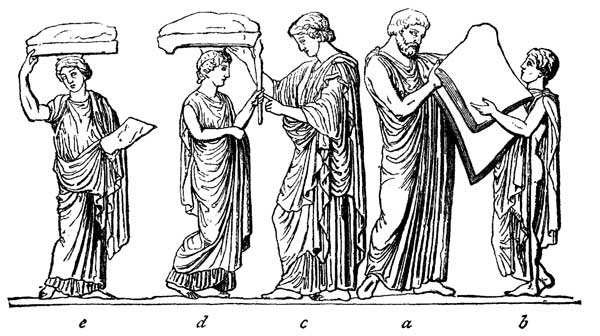 Fig. 28.—The Five Central Figures.
Fig. 28.—The Five Central Figures.
Just here I will call your attention to one feature of these antique bas-reliefs which is called Isocephalism, and means that all the heads are at an equal height. You will see that all figures, whether standing or sitting, walking, in chariots, or on horseback, have the heads on the same level.
These three groups, the five central figures and the two groups of gods, are approached on each side by long, continuous processions, and these processions each start out from the south-west corner of the Parthenon, so that one branch goes along the south and a part of the east side, and the other and longer division marches on the whole of the west and north, and a portion of the east side. I shall give here a series of pictures which are all explained by their[Pg 45] titles, and will give you an excellent idea of this magnificent frieze, and doubtless many of my readers have studied or will study and admire it in the British Museum (Figs. 29, 30, 31, 32, 33, 34, 35).
 Fig. 29—Youths Preparing to Join the Cavalcade.
Fig. 29—Youths Preparing to Join the Cavalcade.
Though all this frieze was the conception of the great Phidias, it must have been the work of many hands, and close examination shows that some portions of it are done much better than others. These sculptures have a double value; for while they are so priceless as treasures of art, they tell us much of that prosperous, glorious Athens of which we love to read and hear stories. These figures show us how the people dressed and moved, and we see in them the "stately" magistrates and venerable seers of Athens, the sacred envoys of dependent states, the victors in their chariots drawn by the steeds which had won for them the cheap but priceless garland, the full-armed warriors, the splendid cavalry, and the[Pg 46] noble youths of 'horse-loving' Athens on their favorite steeds, in the flush and pride of their young life; and last, not least, the train of high-born Athenian maidens, marching with bowed heads and quiet gait, for they are engaged in holy work, with modest mien, and gentle dignity and grace. All that was sacred, powerful, and grand—all that was beautiful, graceful, and joyous in Athenian life, is represented there, in ideal form, of course, but in strict conformity with the realities of life.... It is by the study of such works as these that we get the clearest insight into the essence and spirit of classical antiquity; and they help us better to understand all that we may read in history or poetry concerning the ancient, classic Greeks.
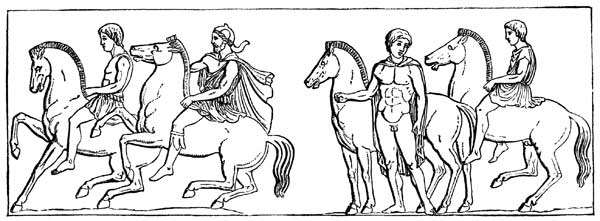 Fig. 30.—Horsemen Starting.
Fig. 30.—Horsemen Starting.
 Fig. 31.—Procession of Cavalry.
Fig. 31.—Procession of Cavalry.
 Fig. 32.—Procession of Chariots.
Fig. 32.—Procession of Chariots.
 Fig. 33.—Train of Musicians and Youths.
Fig. 33.—Train of Musicians and Youths.
 Fig. 34.—Cows for Sacrifice.
Fig. 34.—Cows for Sacrifice.
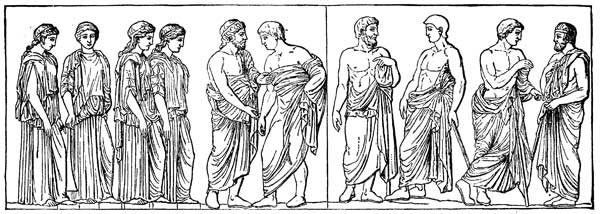 Fig. 35.—Train of Noble Maidens.
Fig. 35.—Train of Noble Maidens.
We must now leave Phidias and speak of other sculptors who were his contemporaries and pupils. Among the last Alcamenes was the most celebrated. He was born in Lemnos, but was a citizen of Athens; so he is sometimes called an Athenian, and again a Lemnian. His statues were numerous, and most of them represented the gods. One of Hephæstus, or Vulcan, was remarkable for the way in which his lameness was concealed so skilfully that no deformity appeared.
His most famous statue was a Venus, or Aphrodite, concerning which it is related that Agoracritus, another celebrated pupil of Phidias, contended with Alcamenes in making a statue of that goddess. The preference was given to Alcamenes, and Agoracritus believed this to have been done on account of his being an Athenian citizen, and not solely for the merit of the statue. The Venus of Alcamenes stood in a temple of that goddess in a garden beyond the eastern wall of Athens. This statue was very much praised for its beauty by ancient writers, who all mention with especial pride the eurythmy of the action of the wrist. This is a term frequently used in regard to sculpture, and is somewhat difficult to explain. It means a[Pg 50] harmony and proportion of action which corresponds to rhythm in music. When a statue has the effect it should have it appears as if the motion of the figure was arrested for a moment, and would be resumed immediately. That is what we mean when we say a statue has life; and, as in life, the motion of a statue may be awkward or it may be graceful; it may be harmonious to the eye, just as music is harmonious to the ear, or it may seem out of tune and time, just as inharmonious sounds are to a correct ear for the rhythm of sound; so when we speak of the eurythmy of sculpture we mean that its apparent motion is in accord with the laws of proportion, and is harmonious and graceful to the eye.
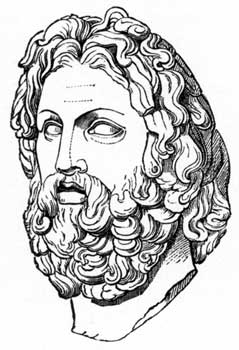 Fig. 36.—Head of Asclepius.
Fig. 36.—Head of Asclepius.While Alcamenes had this power of imparting grace to his statues, he also approached Phidias in majesty and a divine sweetness, which was the sweetness of great strength. In truth, he is recognized as the sculptor who most nearly approached the great Phidias. He represented also for the first time the god Asclepius, or Æsculapius, who was very important to the Greeks, who placed great value upon physical health. Alcamenes represented him as a sort of humanized Zeus or Jupiter. Of the Asclepius heads found at Melos we may regard this one given here as a free copy of the type of god which this great sculptor represented the god of medicine and health to be (Fig. 36).
Alcamenes was also the principal assistant of Phidias in[Pg 51] his decoration of the temple of Jupiter at Olympia, and is said to have himself executed the relief upon the western pediment, in which the battle of the Centaurs and Lapithæ was represented with great spirit.
Agoracritus of Paros, who has been mentioned as the rival of Alcamenes, is called the favorite pupil of Phidias, and it is said that the master even gave Agoracritus some of his works, and allowed the pupil to inscribe his name upon them. For this reason the ancient writers were often in doubt as to the authorship of the statues called by the names of these sculptors. It is said that when the Venus of Alcamenes was preferred before that of Agoracritus the latter changed his mark, and made it to represent a Nemesis, or the goddess who sent suffering to those who were blessed with too many gifts. It is said that this statue was cut from a block of marble which the Persians brought with them to Marathon for the purpose of making a trophy of it which they could set up to commemorate the victory they felt so sure of gaining; in their flight and adversity it was left, and at last served a Greek sculptor in making a statue of an avenging goddess. This seems to be a striking illustration of "poetic justice."
Agoracritus sold the Nemesis to the people of Rhamnus, who had a temple dedicated to that goddess, and made a condition that it should never be set up in Athens. In the museum of the Lateran at Rome there is a small but very beautiful antique statue of Nemesis, which is thought to be a copy of this famous work. As Nemesis was the goddess who meted out fortune according to her idea of right, a measure was her symbol, and the Greek measure of a cubit was generally placed in her hand. The word cubit means the length of the forearm from the elbow to the wrist, and in this statue of which we speak this part of the arm is made very prominent, and the measure itself is omitted.[Pg 52]
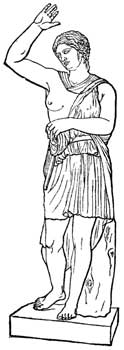 Fig. 37.—A Wounded Amazon.
Fig. 37.—A Wounded Amazon.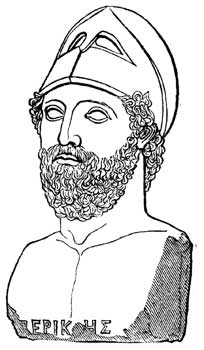 Fig. 38.—Statue of Pericles.
Fig. 38.—Statue of Pericles.The sculptor Myron also had pupils and followers who executed many works, and of this school was Cresilas of Cydonia, in Crete. We are interested in him because two copies from his works exist, of which I give pictures here. Pliny, in speaking of the portrait statue of Pericles, said it was a marvel of the art "which makes illustrious men still more illustrious." The cut given here is from a bust in the British Museum. There is reason to believe that Cresilas excelled Myron in the expression of his faces (Figs. 37, 38).
Callimachus is an artist of whom we know little, but that little is interesting. We do not know where he was born, but as he was employed to make a candelabra for the eternal lamp which burned before the sacred statue of Athena Polias, we may suppose that he was an Athenian.[Pg 53] Some writers say that he invented a lamp which would burn a year without going out, and that such an one made of gold was the work he did for the temple of Minerva. Callimachus lived between B.C. 550 and 396, and is credited with having invented the Corinthian capital in this wise: A young girl of Corinth died, and her nurse, according to custom, placed a basket upon her grave containing the food she had loved best in life. It chanced that the basket was put down upon a young acanthus plant, and the leaves grew up about the basket in such a way that when Callimachus saw it the design for the capital which we know as Corinthian was suggested to him, and was thus named from the city in which all this had occurred.
While the plastic art of Athens, or the Attic school of sculpture, reached its greatest excellence in Phidias, there was in the Peloponnesus another school of much importance. Argos was the chief city of this school, and its best master was Polycleitus of Sicyon, who was born about B.C. 482. He was thus about twelve years younger than Phidias. Polycleitus was held in such esteem that many of the ancient writers couple his name with that of Phidias. He was employed in the decoration of the Heraion, or temple of Hera, at Argos. But his greatest work was a statue of Hera, or Juno, for a temple on Mount Eubœa, between Argos and Mycenæ. This statue was chryselephantine, and as Juno was the majestic, white-armed, ox-eyed goddess consort of Jupiter, it is a striking coincidence that Phidias at Olympia and Polycleitus on Mount Eubœa should have made from ivory and gold two famous statues of this renowned pair, who reigned over the mythical world of the Greek religion. There are several copies of heads of Juno in various museums, and some of them have been ascribed to Polycleitus; but the proof of the truth of this is far from being satisfactory. This master made other statues of divinities, but he excelled in representing ath[Pg 54]letes; and however fine his other works may have been, it was in the reproduction of strong, youthful, manly beauty that he surpassed other sculptors. Some of his statues of this sort, especially a Doryphorus, or spear-bearer, were considered as models from which all other artists could work.
Polycleitus is said to have written a treatise in which he gave exact rules for the proportions of the different parts of the body. This was called "the canon" of Polycleitus, and there is good reason to believe that the Doryphorus was called by the same name, "the canon," because it was fashioned according to the rules laid down by Polycleitus in his treatise. His pupils and followers are mentioned with honor by the Greek authors of his time, but I need not mention them here.
The art of Phidias and Polycleitus was the art of Greece at its best period. After the close of the Persian wars the people of Greece were a religious and patriotic people. The Persian wars developed the best quality of character, for these wars were waged against a foreign foe, and the Greeks were defending their freedom and their civilization, and at the end of the struggle Pericles, who guided them to their greatest prosperity, was a statesman and a man of high aims; he was a gentleman as well as a strong ruler. The Peloponnesian war, on the contrary, was a civil war, and it divided the Greeks among themselves and roused the evil passions of friend against friend all over their country. It was the cause of selfishness, treachery, and immorality, and one of its worst effects was seen in the loss of religious tone among the people: their old contented simplicity of life and thought was gone; every man thought only of himself, and the nation began to sink into the condition which at last made it an easy prey to the Macedonians. We have studied all these wars in our histories, but perhaps we have not thought how much they[Pg 55] affected sculpture and the other arts, and brought them down from the lofty heights of the Periclean age.
But there were still men who strove to be great and grand in morals and in intellect, and perhaps strove all the more earnestly for this on account of the decline they saw about them. Few countries in any age have had more splendid men than Socrates, Plato, Euripides, Aristophanes, Pelopidas, Epaminondas, Demosthenes, Dion, and Timoleon, and these all lived between the Peloponnesian and the Macedonian wars. And while the arts were less grand than before, they did not fall into decline for some years, though they took on new features. The gods who had been mostly represented were less often the subjects of the sculptor, and when they were so they were softened and made less awful in their effect. Other gods were more freely taken for models, such as came nearer to human life and thought, because less sublime in their attributes and characters. Among these were Venus as a lovely woman rather than as the great mother of all living creatures, and Eros, or Love; while Plutus, or Wealth, and satyrs, nymphs, and tritons were multiplied in great numbers.
When the gods who were represented were more like human beings in their character, it followed that the statues of them more nearly resembled men and women, and gradually the old grandeur and sublimity were changed to grace, beauty, and mirth. Many people would prefer these works because they come nearer to the every-day life of the world; but earnest, thoughtful minds look for something more noble in art—something that will not come down to us as we are, but will help us to rise above ourselves and to strive after better things.
Cephisodotus was a sculptor who lived until about B.C. 385, or a little later, and stood between the old and the new schools of Greek art. The cut given here is from a group at Munich, which is believed to be a copy of a work[Pg 56] by him, and it is a combination of the simple dignity of the art of Phidias (which is seen in the flowing drapery and the wavy edge of its folds) and the later Attic style (which is seen in the dreamy, gentle air of the face of the nurse of the little god). (Fig. 39.) We know very little of the life of Cephisodotus, and as little is said of his works by ancient writers.
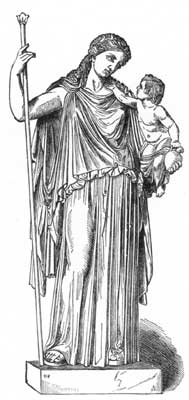 Fig. 39.—Eirene and the Young Plutus.
Fig. 39.—Eirene and the Young Plutus.Scopas of Paros was one of the greatest sculptors of the later Attic school. The island of Paros, where he was born, was the place where the finest Greek marble was found; but he worked so much at Athens that he is spoken of as an Athenian. He was an architect as well as a sculptor, and he superintended the erection of some splendid structures, which he also ornamented with his sculptures. I shall speak especially of the tomb of Mausolus, the King of Caria. Scopas executed the sculptures of the east side, and as he was the best artist of the sculptors employed there, it is probable that he had much to do with the design for all the work. This mausoleum was reckoned as one of the "seven wonders of the world," and has given a name to fine tombs the world over.[Pg 57]
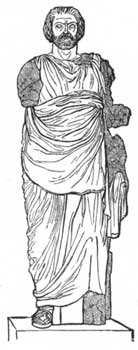 Fig. 40.—Portrait of Mausolus.
Fig. 40.—Portrait of Mausolus.
The most interesting of the sculptures from this tomb which are now in the British Museum seems to me to be the statue of Mausolus himself. It is plainly intended to be an exact portrait of the king, and it is so designed and executed that we feel sure it must show him to us just as he was when alive, more than twenty-two hundred years ago (Fig. 40).
A part of the frieze upon the mausoleum showed the battle of the Greeks and the Amazons, and this illustration from it gives an idea of the boldness of action and the correctness of the design (Fig. 41). This picture is from a slab in the possession of the Serra family in Genoa. On the right a warrior holds down an Amazon whom he has forced to her knees and is about to kill, while she stretches out her right hand in supplication. The figures to the left are full of spirit, and absolutely seem to be in motion. We do not know that any of these figures were executed by the hand of Scopas, but it is probable that they were, and they give us an idea of the art of his time.
Scopas also carved one of the splendid pillars of the temple of Diana at Ephesus, and did much architectural decoration, as well as to execute many statues and groups of figures. The ancient writers say very little of the art of Scopas, but when all that we can learn is brought together, it shows that he had great fertility in expressing his own ideas, that his genius was creative and his works original. He represented the gods which the earlier sculptors had shown in their works in quite a new manner, and he was the[Pg 58] first to show the goddess Venus in all the beauty which imagination could attribute to her. His representations of nymphs of wood and sea, of monsters, and all sorts of strange, imaginary beings were numberless, and he made his sculptured figures to express every emotion that can be fancied or felt, from the tenderest and sweetest affection to the wildest passions of the soul.
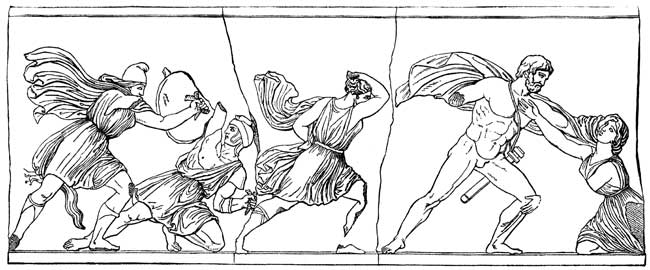 Fig. 41—From the Frieze of the Mausoleum.
Fig. 41—From the Frieze of the Mausoleum.
His works were always representations of gods or of sentiments as shown by some superhuman beings; he never portrayed a[Pg 59] hero, with the exception of Hercules, and was ever busy with the ideal rather than with realities about him. He worked in marble only, which is far more suited to the elegant beauty of his style than are bronze and gold or ivory.
We are accustomed to call Praxiteles the greatest sculptor of the second school of Greek art, just as we give that place to Phidias in the first. We have no fixed dates concerning Praxiteles. We know that he was the son of a Cephisodotus, who was a bronze worker, and was thought to be a son of Alcamenes, thus making Praxiteles a grandson of the latter. Praxiteles was first instructed by his father. Later he came under the influence of Scopas, who was much older than he; and by Scopas he was persuaded to give up working in bronze and confine himself to marble. Perhaps the most authentic date we have concerning him is that given by Pliny, who says that he was in his prime from B.C. 364-360.
It is impossible to praise a sculptor more than Praxiteles was praised by the Greek authors; and, although Athens was the place where he lived and labored most, yet he was known to all Greece, and even to other countries, and the number of his works was marvellous. There are trustworthy accounts of forty-seven groups, reliefs, and statues by his hand, and it is not probable that these are all that he executed.
Praxiteles represented youth and beauty and such subjects as are most pleasing to popular taste. Thus it happened that his male figures were the young Apollo, Eros, and youthful satyrs, while a large proportion of his statues represented lovely women. Venus was frequently repeated by him, and there is a story that he made two statues of her, one being draped and the other nude. The people of Cos bought the first, and the last was purchased by the Cnidians, who placed it in the midst of an open temple, where it could be seen from all sides. It became so famous[Pg 60] that many people went to Cnidos solely for the purpose of seeing it, and the "Cnidian Venus" acquired a reputation wherever art was known. When the oppressor of the Cnidians, King Nicodemus of Bithynia, offered to release them from a debt of one hundred talents (about $100,000) if they would give him the Venus, they refused, and declared that it was the chief glory of their State.
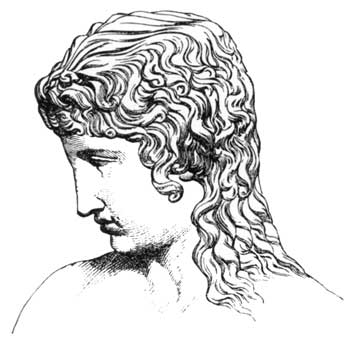 Fig. 42.—The Eros of Centocelle.
Fig. 42.—The Eros of Centocelle.
Another story relates that Phryne, a friend of Praxiteles, had been told by him that she could have any work which she might choose from his workshop. She wished to have the one which the artist himself considered the best. In order to find out which he so esteemed she sent a servant to tell him that his workshop was on fire. He exclaimed, "All is lost if my Satyr and Cupid are not saved!" Then Phryne told him of her trick, and chose the Cupid, or Eros, for her gift. Phryne then offered the statue to the temple of Thespiæ, in Bœotia, where it was placed between a statue of Venus and one of Phryne herself. This Cupid was almost as celebrated as the Cnidian Venus, and was visited by many people. The head given here (Fig. 42), which was found in Centocelle by Gavin Hamilton, and is now in the Vatican, is thought by many to be a copy of a Cupid by Praxiteles, and even of the Thespian statue; but we have no proof of this. The Cupid, or Eros, of the art of Scopas and Praxiteles is not the merry little creature who bears that name in later art; he is a youth just coming into manhood, with a dreamy, melancholy face, the tender beauty[Pg 61] of which makes him one of the most attractive subjects in sculpture. Caligula carried the Thespian Cupid to Rome; Claudius restored it to its original place, but Nero again bore it to Rome, where it was burned in a conflagration in the time of Titus.
I shall say no more of Praxiteles personally, because I wish to describe to you the largest and grandest group of Greek statues which exists, or, as I should say, of which we have any copies. We do not know whether Scopas or Praxiteles made these famous figures, since they are attributed to both these sculptors; perhaps we can never positively know to whom to ascribe the fame of this marvellous work. The historian Pliny tells us that they stood in the temple of Apollo Sosianus at Rome. Sosius was the legate of Antony in Syria and Cilicia; he erected this temple in his own honor, and brought many beautiful works from the East for its decoration. It is believed that he brought the Niobe group from Cilicia, and displayed it when celebrating his victory over Judea, B.C. 35.
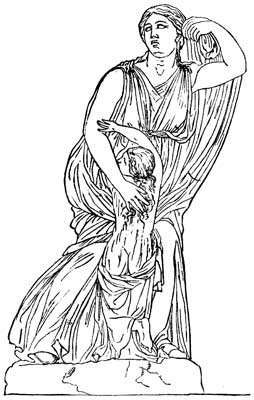 Fig. 43.—Niobe and Her Youngest Daughter.
Fig. 43.—Niobe and Her Youngest Daughter.
In A.D. 1583 a large number of statues representing this subject were found in Rome, and were purchased by the Grand Duke of Tuscany, who placed them in the Villa Medici. In 1775 they were removed to the Palace of the Uffizi, in Florence, where an apartment was assigned to them. The figures were restored, and each one placed on its own pedestal, which work was not completed until 1794.[Pg 62]
The group must have had originally seventeen figures—Niobe and fourteen children, a pedagogue and a female nurse. Now there are but twelve—Niobe, six sons, four daughters, and the pedagogue. At first it was supposed that these figures ornamented the temple pediment, but it is now thought that they stood on an undulating rocky base, with a background at a little distance. Niobe is the central figure, in any case, and the children were fleeing toward her from either side; she is the only one represented in such a way as to present the full face to the beholder (Fig. 43). But we shall better understand our subject if I recount as concisely as possible the story of Niobe, which, as you know, is a Grecian myth. Niobe was the daughter of Tantalus, and was born on Mount Sipylus. When a child Niobe played with Lato, or Latona, who afterward married the great god Jupiter, or Zeus. Niobe became the wife of Amphion, and had a very happy life; she was the mother of seven sons and seven daughters, and all this prosperity made her forget that she was mortal, and she dared to be insolent even to the gods themselves. Lato had but two children, the beautiful Apollo and the archer-queen of heaven, called Diana, or Artemis.
Amphion and Niobe were the King and Queen of Thebes, and when the worship of Lato was established in that city Niobe was very angry. She thought of Lato as her playmate and not a goddess, and was so imprudent as to drive in her chariot to the temple and command the Theban women not to join in this worship. Niobe also[Pg 63] asserted that she was superior to this Lato, who had but two children, while she had fourteen lovely sons and daughters, any one of which was worthy of honor. All this so enraged Lato that she begged Apollo, who was the god of the silver bow, and Diana, her huntress daughter, to take revenge on Niobe. Obedient to her commands, Apollo and Artemis descended to earth, and in one day slew all the children of Niobe. Then this proud mother, left alone, could do nothing but weep, and this she did continually until Jupiter took pity on her and turned her into stone, and whirled her away from Thebes to Mount Sipylus, the scene of her happy childhood. In this picture of Niobe she[Pg 64] clasps her youngest child, who has fled to her for protection.
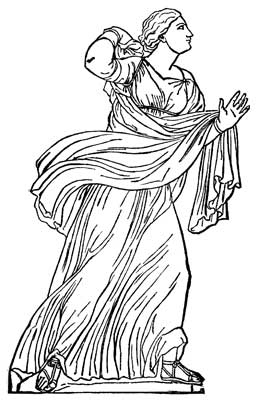 Fig. 45.—The Eldest Daughter.
Fig. 45.—The Eldest Daughter.
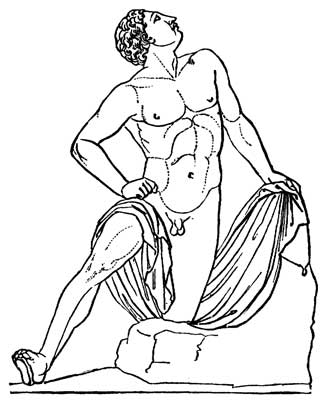 Fig. 46.—A Niobid.
Fig. 46.—A Niobid.
I cannot give pictures of all the figures, but one of the most interesting is this brother and sister. She is wounded, and he endeavors to raise his garment so as to shield her and himself from the deadly arrows which pursue them (Fig. 44).
This figure of the eldest daughter is very beautiful. An arrow has pierced her neck, and the right hand is bent back to the wound. The face is noble and simple, and has been a favorite model to Guido Reni and other Italian masters (Fig. 45).
Fig. 46 shows one of the older sons, who, though wounded and fallen on one knee, still looks toward his slayer with an air of defiance. There is a world of interest connected with these statues, and they move us with a variety of emotions. The poor mother, so prosperous a moment before, and now seeing her children dying around her, slain by the sure arrows of the unseen gods—how can we pity her enough! and then the brave son who tries to shield his sister while he is dazed by the suddenness of the misfortunes which he cannot account for; the old pedagogue, to whom the youngest boy has run for protection—and, in[Pg 65]deed, all demand our sympathy for their grief and our admiration for their beauty, which is still theirs in spite of their woe.
One of the young sculptors who was employed with Scopas in the work on the mausoleum was Leochares. We read of several statues of Zeus and Apollo by this master, but his most celebrated work was the group of Ganymede borne upward by the eagle of Zeus. There are several copies of this sculpture, but that given here, from the Vatican figure, is the best of all, and is very beautiful. We know very few facts concerning Leochares, and cannot even say whether he was an Athenian or not (Fig. 47).
There is still standing at Athens, in its original place, the Choragic monument of Lysicrates; and though we do not know the names of the architects and sculptors who made it, there are traces upon it which indicate that it belonged to the school of Scopas (Fig. 48).
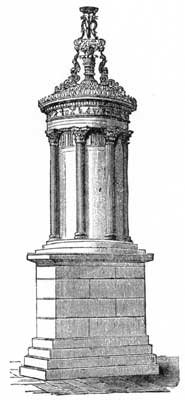 Fig. 48.—Monument of Lysicrates.
Fig. 48.—Monument of Lysicrates.This monument was erected B.C. 334, when Lysicrates was choragus—that is, when it was his office to provide the chorus for the plays represented at Athens. This was an expensive office, and one that demanded much labor and care. He had first to find the choristers, and then bring them together to be instructed, and provide them with proper food while they studied. The choragus who gave the best musical entertainment received a tripod as his reward, and it was the custom to build a monument upon which to place the tripod, so that it should be a lasting honor to the choragus and his family. The street in which these monuments were erected was called "the street of the Tripods."
It was also the custom to dedicate each tripod to some special divinity, and this of Lysicrates was dedicated to Bacchus, and had a frieze with sculptures telling the story of that god and the Tyrrhenian robbers who bore him off to their ship. In order to revenge himself he changed the oars and masts into serpents and himself into a lion; music was heard, and ivy grew all over the vessel; the robbers went mad and leaped into the sea, and changed into dolphins.
In the frieze, however, it is represented that the god is on shore quietly amusing himself with the lion (Fig. 49), while satyrs and sileni punish the robbers by beating them with sticks and chasing them with fury, while they are turning gradually into dolphins and rushing into the sea. The design is so fine that it might easily be attributed to one of the best sculptors; but the execution is careless, and this is not strange when we[Pg 68] remember that it was all done at the expense of one man, and he a private citizen.
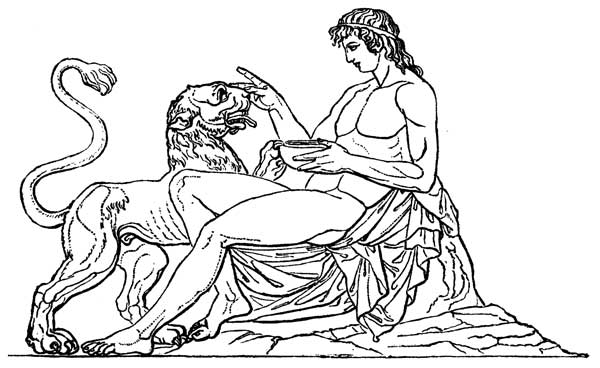 Fig. 49.—Bacchus and Lion.
Fig. 49.—Bacchus and Lion.We will return now to the Peloponnesian school, of which Polycleitus was the head in its earliest period. After his time the sculptors of his school continued to prefer the subjects in which he excelled, and represented youthful heroes and victors with as much industry as the artists of Athens bestowed upon their statues of womanly grace and beauty. The subjects of the Peloponnesian school were especially suited to the use of bronze, and the chief sculptor of his time, Lysippus, whose works are said to have numbered fifteen hundred, worked entirely in bronze. In order to keep a record of the number of his works, he adopted the plan of putting aside one gold coin from the price of every statue, and at his death his heirs are said to have found the above number of these coins thus laid away. His home was at Sicyon, and his time of work is given as B.C. 372-316. This seems a long period for active employment as a sculptor; but the number of his works accords well with this estimate of his working years.
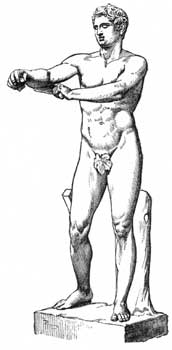 Fig. 50.—The Apoxyomenos of Lysippus.
Fig. 50.—The Apoxyomenos of Lysippus.
Lysippus cannot be said to have followed any school; he was original, and this trait made him prominent, for he was not bound by old customs, but was able to adapt himself to the new spirit of the age, which came to Greece with the reign of Alexander. This sculptor made a great number of statues of Hercules; and as Alexander loved to regard himself as a modern Hercules, Lysippus also represented the monarch in many different ways, and with much the same spirit as that he put into the statues of the hero-god. For example, he made a statue of "Alexander with his Spear," "Alexander at a Lion Hunt," "Alexander as the Sun-God," and so on through many changes of expression and attributes, but all being likenesses of the great king. There is in the Capitol at Rome a head of Alexander called Helios, which is thought by many critics to be the best bust of him in existence. There are metal rays fastened to the head; it has a wild, Bacchus-like air, and the hair is thrown back, as if he had shaken his head furiously; and the defect of a wry neck, which the monarch had, is cleverly concealed by this motion. Alexander was a very handsome man, his[Pg 70] faults being this twist in his neck and a peculiar shape of the eye.
We cannot here give the long list of works by Lysippus, but will speak of that which interests us most, because we have a beautiful copy of it. I mean the Apoxyomenos, which is in the Vatican. It represents a youth scraping himself (as the name denotes) with the strigil after a contest in the arena (Fig. 50). The Vatican copy was found in the Trastevere at Rome in 1849, and is well preserved. Without doubt it is a faithful reproduction of the original, which was probably brought from Greece to Rome by Agrippa, who set it up in front of his public baths. Here it became such a favorite with the people that when Tiberius removed it to his own house there was a demonstration in the theatre, and so violent a demand was made for its restoration that the cunning emperor dared not refuse. This statue may be called an example of a grand genre style. It represents a scene from common life in Greece, but it is so simply natural, so graceful and free from restraint, that one could not weary of it. The expression of the face is that of quiet content—his task has been faithfully done, and the remembrance of it is pleasant. The hair is finely executed; this was a point in which Lysippus excelled; but the great charm of the whole is in the pose of the figure. In his occupation of scraping one portion of the body after another he must constantly change his position, and this one, in which he can rest but a moment, seems to have the motion in it which he must almost instantly make, while it is full of easy grace in itself. The art of Lysippus was not as elevated as that of Phidias, who tried to represent the highest ideal which a mortal may form of a god; but there was nothing mean or vulgar in the works of the former; on the contrary, it was with a pure and noble spirit that he endeavored to represent the perfections of youthful, manly beauty, and his naturalism was of a healthy and dignified sort.[Pg 71]
The most important pupil of Lysippus was Chares Of Lindos, who was prominent not only on account of his own works, but also because he introduced the art of Sicyon into his native island of Rhodes. This island is but forty-five miles long and twenty miles wide at its broadest part, and yet its art became second only to that of Athens.
At the city of Rhodes alone there were three thousand statues, besides many paintings and other rare and beautiful objects. Chares is best known for the sun-god which he erected here; it was called the "Colossus of Rhodes," and was reckoned as one of the seven wonders of the world. One hundred statues of the sun were erected at Rhodes, and Pliny says that any one of them was beautiful enough to have been famous; but that of Chares was so remarkable that it overshadowed all the rest.
It stood quite near the entrance to the harbor of Rhodes, but we have no reason to believe that its legs spanned the mouth of the port so that ships sailed between them, as has often been said, although its size was almost beyond our imagination. The statue was one hundred and five feet high, and few men could reach around one of its thumbs with their arms, while each finger was as large as most statues. Twelve years were occupied in its erection, from B.C. 292 to 280, and it cost three hundred talents, or about $300,000 of our money, according to its usual estimate, though there are those who name its cost as more than four times that amount. The men of Rhodes obtained this great sum by selling the engines of war which Demetrius Poliorcetes left behind him when he abandoned the siege of Rhodes in B.C. 303. We have no copy of this statue, but there are coins of Rhodes which bear a face that is believed with good reason to be that of the Colossus.
Fifty-six years after its completion, in B.C. 224, the Colossus was overthrown by an earthquake, and an oracle forbade the restoration of it by the Rhodians. In A.D. 672,[Pg 72] nearly a thousand years after its fall, its fragments were sold to a Jew of Emesa by the command of the Caliph Othman IV. It is said that they weighed seven hundred thousand pounds, and nine hundred camels were required to bear them away. When we consider what care must have been needful to cast this huge figure in bronze, and so adjust the separate parts that the whole would satisfy the standard of art at Rhodes, we are not surprised that it should have been reckoned among the seven wonders, and that Chares should have become a famous master.
Chares also founded a school of art which became very important, and, indeed, it seems to have been the continuance of the school of the Peloponnesus; for after the time of Lysippus the sculpture of Argos and Sicyon came to an end, and we may add that with Lysippus and his school the growth of art in Greece ceased; it had reached the highest point to which it ever attained, and all its later works were of its decline, and foreshadowed its death.
The reign of Alexander the Great was so brilliant that it is difficult to realize that it was a time of decline to the Greeks; and during the life of Alexander perhaps this does not appear with clearness; but at the close of his reign there arose such contentions and troubles among his generals that everything in Greece suffered, and with the rest Greek art was degraded. In the time of Pericles it was thought to be a crime in him that he permitted his portrait to be put upon the shield of the Parthenon, and he was prosecuted for thus exalting himself to a privilege which belonged to the gods alone. Alexander, on the contrary, claimed to be a god, and was represented by painters and sculptors until his portraits and statues were almost numberless.
Soon after the death of Alexander the humiliation of Athens and its old Periclean spirit was complete. If you read the history of Demetrius Poliorcetes, who was even[Pg 73] allowed to hold his revels in the most sacred part of the Parthenon—the temple of Minerva—you will see that Athens was enslaved and her people no longer worthy to lead the world in the arts of peace, as they were no longer the brave men who could stand first in war. In their degraded state the Athenians suffered three hundred and sixty statues to be erected to Demetrius Phalereus, and these were destroyed to make way for the golden images of the conquering freebooter Poliorcetes. This last was hailed by the debased people as a god and a saviour. His name and that of his father, Antigonus, were woven into the sacred peplos.
At length, under the Diadochi, or successors of Alexander, order was restored, and Antigonus, Ptolemy, Seleucus, and Lysimachus divided the kingdom of Alexander into four Græco-Oriental monarchies. The dynasty of the Ptolemies in Egypt was the most reputable of these, and gave much encouragement to art and letters. But the sacred fire seems to have died out, or did not burn clearly when transplanted from Athens to Alexandria. The Alexandrines seem to have been mere imitators of what had gone before, and there is nothing to be said of them that is of importance enough for us to linger over it. Very few works remain from this Diadochean period. The Metope of Ilium, which Dr. Schliemann has in his garden in Athens, the Barberini Faun, in the Glyptothek at Munich, and the Nile of the Vatican are the most important remnants of Alexandrine sculpture.
Amid all the confusion and strife which followed the death of Alexander the island of Rhodes remained undisturbed, and when the division of the monarchies was made the Rhodians still retained their independence. They were neutral, and so had a commerce with all the monarchies, and thus gained great wealth; and theirs was the only independent State of the old Hellenic world which was able to[Pg 74] found and maintain a school of art. Among the great works of the Rhodian artists none is more familiar to us than the group of the Laocoon.
In the time of Pliny this work stood in the palace of Titus, and the historian called it "preferable to all other works of pictorial or plastic art." There is a difference of opinion as to the period when it was made, and many date it in the time of Titus, who lived A.D. 40 to 81. But the weight of argument seems to me to rest with those who believe that it was made at Rhodes in the time of the Diadochi.
The group in the Vatican is probably a copy, because Pliny says that the original was made of one block, and that of the Vatican is composed of six pieces. Pliny also tells us that the Laocoon was the work of three sculptors, Agesander, Polydorus, and Athenodorus. The Vatican group was found in 1506 in the excavation of the Baths of Titus, in Rome, and was placed in its present position by Pope Julius II. (Fig. 51). The right arm of Laocoon was missing, and Michael Angelo attempted to restore it, but left it incomplete; Montorsoli made an unsatisfactory attempt for its restoration, and the arm as it now is was made by Cornacini, and more straight than it should be.
The story which these statues illustrate is told in the second book of the Æneid, and says that Laocoon was a priest of Apollo at Troy, who, when the Greeks left the wooden horse outside the city and pretended to sail away, warned the Trojans against taking the horse inside the walls; he also struck his spear into the side of the monster. But Sinon, who had been left behind by the Greeks, persuaded the Trojans that the horse would prove a blessing to them, and they drew it into the city, and ordered feasts and sacrifices to be celebrated to do honor to the occasion. Laocoon had much offended Pallas Athene by his words and acts, and when he went to prepare a sacrifice to Neptune that goddess sent two huge serpents up out of the sea[Pg 75] to destroy him and his two sons, who were with him by the altar. When the three victims were dead the fearful creatures went to the Acropolis and disappeared.
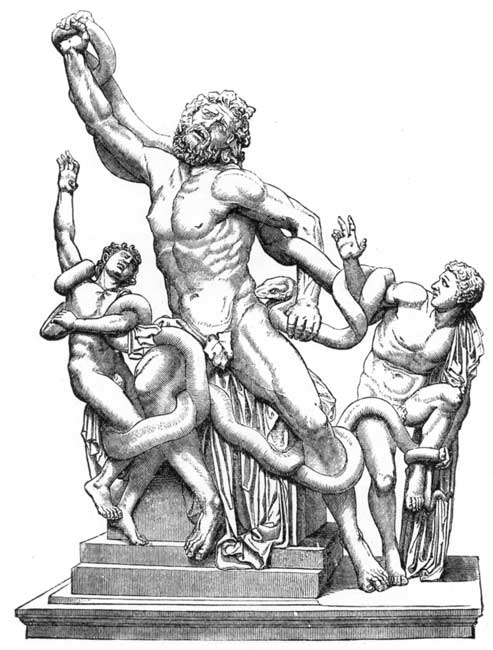 Fig. 51.—The Laocoon Group.
Fig. 51.—The Laocoon Group.
In the Laocoon group it appears that the eldest son will save himself, and in certain minor points the sculptors seem not to have followed the account of Virgil; but we see that it must be the same story that is illustrated, and we[Pg 76] know that it was told with some variation by other poets. This group is a wonderful piece of sculpture, but it is not of the highest art, and it is far from pleasant to look at. The same is true of another famous group which is in Naples, and which is also from the Rhodian school.
I mean the Farnesian Bull, or the Toro Farnese. This group was made by Apollonius and Tauriscus, who are believed to have been brothers. It was probably made at Tralles, in Caria, which was their native place, and sent by them to Rhodes, the great art-centre; from Rhodes it was sent to Rome, where it was in the possession of Asinius Pollio. This splendid group, which is probably the original work, was found in the Baths of Caracalla, in 1546, and was first placed in the Farnese Palace, from which it was removed to the National Museum in Naples, in 1786 (Fig. 52).
This group tells a part of the story of Dirce, who had incurred the hatred and displeasure of Antiope, the mother of Amphion, who was King of Thebes and the husband of Niobe. In order to appease the wrath of his mother, Amphion, with the aid of his twin-brother Zethus, bound Dirce to the horns of a wild bull to be dashed to pieces. All this takes place on Mount Cithæron, and it is said that after Dirce had suffered horrible agonies the god Dionysus changed her into a fountain, which always remains upon this mountain.
In this piece of sculpture, dreadful as the idea is, there is less of horror than in the Laocoon, for the reason that the moment chosen is that just before the climax of the catastrophe, while in the Laocoon it is in its midst. The latter group is made to be seen from but one side, and was probably intended for a niche; but the Farnese Bull is perfect, and presents a finished aspect on all sides and from every point of view. There are numerous accessories and much attention to detail, while the rocky base represents Mount[Pg 77] Cithæron and the wildness of the scene in a manner not before known in sculpture. The group has been much restored, but its excellences support the theory of its being the original work of the Greek artists, and the skill with which the various figures are brought into one stupendous moment is such as commands great praise and admiration; it is doubtful if any other work of sculpture tells its story with power equal to that of this celebrated group.
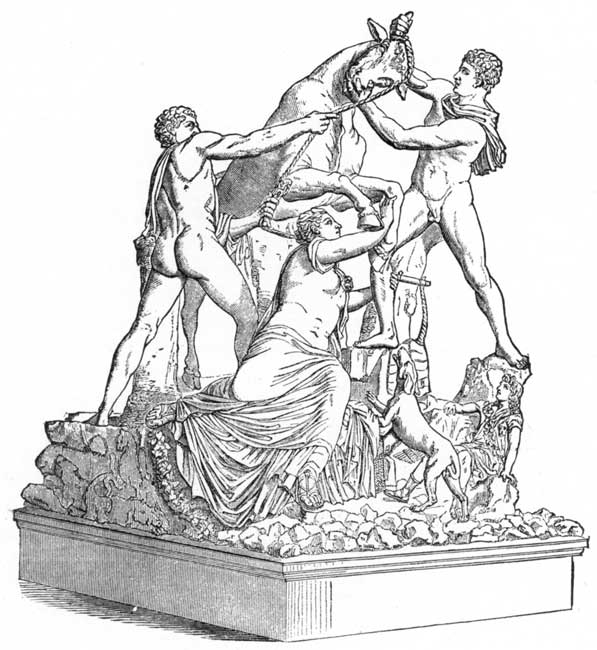 Fig. 52.—The Farnese Bull.
Fig. 52.—The Farnese Bull.
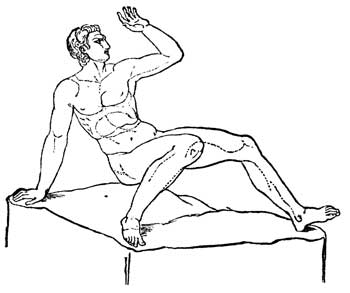 Fig. 53.—Gallic Warrior.
Fig. 53.—Gallic Warrior.After the art of Rhodes that of Pergamon was important. When Attalus I., King of Pergamon, gained his victory over the Gauls, in B.C. 229, the Greek artists were aroused to new efforts to record in sculpture the great deeds of Attalus and to place him on a level with the glorious heroes of their nation who had preceded him. It is recorded that the conqueror himself offered four groups of statues at Athens, and that they stood on the southern wall of the Acropolis. The subjects were: "The Battle of the Gods and Giants," "The Battle of Athenians and Amazons," "The Battle of Marathon," and "The Destruction of the Gauls in Mysia by Attalus." Thus the different epochs of Greek history were represented, and Attalus placed himself near the other great warriors who had preserved the honor and freedom of their nation. These groups consisted of many figures, and are estimated to have been from sixty to eighty in number. It is believed that at least ten of them are now in European collections—that is, three in Venice, four in Naples, one in Paris, one in the Vatican, and the last in the Castellani collection in Rome. This picture of one of those in Venice seems to represent a warrior who has been suddenly thrown down; his weapons and shield—which last was probably held in the left hand—have been dropped in the violence of the shock which has prostrated him (Fig. 53). His face and hair are of the barbarian type, and the power and elasticity of his powerful frame are manifest[Pg 79] even in this moment of his defeat. He is yet unwounded, but the weapon of his adversary may be before his eyes, and in another moment he may sink back in the agony of death.
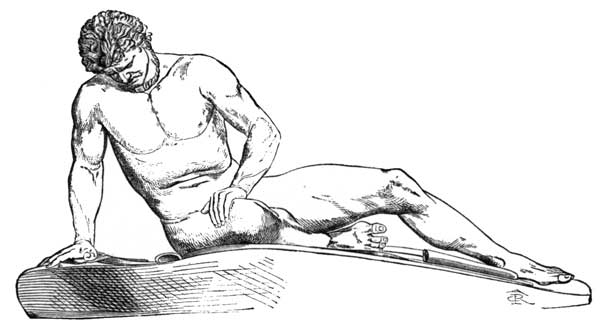 Fig. 54.—The Dying Gaul.
Fig. 54.—The Dying Gaul.
It is now believed that the statue of the Dying Gaul, often called the Dying Gladiator, was the work of a sculptor of Pergamon, and represents a Gaul who has killed himself rather than submit as a slave to his conquerors. The moment had come when he could not escape, and he chose death rather than humiliation. We learn from history that when these barbarians saw that all was lost they frequently slew their wives and children and then themselves, to avoid being taken as prisoners, which really meant being made slaves. This warrior has thrown himself upon his shield; his battle-horn is broken, and the sword which has given him the freedom of death has fallen from his hand. His eye is already dim, his right arm can scarce sustain him, his brow is contracted with pain, and it seems as if a sigh escaped his lips. He has not the noble form of the Greeks; we do not feel the exalted spirit which is shown in the death scenes of some of the Periclean statue[Pg 80] heroes; here it is only a rude, barbarous Gaul, suffering death as a brute might; it is very realistic, and when we are near the marble itself we see the coarseness of the skin, the hardened soles of the feet, the coarse hand, and we are sure the artist must have made a true representation of this wild, savage man, who yet had the nobility of nature which would not live to be enslaved (Fig. 54).
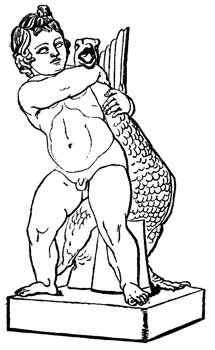 Fig. 55.—Boy and Goose.
Fig. 55.—Boy and Goose.
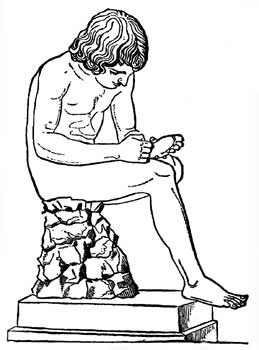 Fig. 56.—Spinario.
Fig. 56.—Spinario.
These illustrations and remarks will give you some idea of the art of Pergamon, and I shall now leave the subject of Greek sculpture after some account of Boethus of Chalcedon. His date is very uncertain, though we have accounts of his works by ancient writers. Some scholars believe that he lived about B.C. 275. Many works in chased silver made by Boethus were in the temple of Athena in Lindus in the time of the historian Pliny; there are accounts of a figure of a boy made in gold and one of the youthful Asclepius; but the Boy Strangling a Goose, in the gallery of the Louvre, is his most interesting work for us (Fig. 55). You will remember that even the ancient Egyptians made caricatures and playful, mocking pictures not unlike some of our own day. This boy and goose are of the same spirit, and is intended as a parody on the representations of Hercules struggling with the Nemean lion, which had been represented many times by Greek artists. The boy seems to be working as hard as any giant could do. The execution of this work is fine. It was probably made for a fountain, the water coming through the beak of the goose. There are several works of ancient sculpture which are of the same spirit, and[Pg 81] for this reason are attributed to Boethus. The Spinario, or Thorn-extractor, in the museum of the Capitol, at Rome, is one of the most charming pieces of genre statuary in existence (Fig. 56).
It represents a boy taking a thorn from his foot. His attitude is natural and graceful, and the purity and simplicity of its style places it on an equality with works of the best period of sculpture. The expression of the face is that of perfect absorption in what he is doing, and is given with great skill and truthfulness. The treatment of the hair is like that of the archaic period, and there will always be some critics who cannot think that such perfection could exist in the sculpture of what we call the Alexandrian age.[Pg 82]

Ancient Italian sculpture was essentially Greek in its spirit, and originated with the Etruscans, a very ancient people in Italy. There are traces of an Oriental influence in the art of Etruria—a suggestion of the sculpture of Egypt and Assyria, just as there is in Greek archaic art; but the real feeling and spirit of it is Greek, and must have been borrowed from Greece in some way.
The different theories and opinions about the Etruscans and their origin do not concern us here; we have to do only with their sculpture as it is seen in the remnants of it now in existence. In the beginning the Etruscans made their statues of clay; marble was very rarely used. Later on they learned the art of working in bronze, and carried it to great perfection. Their bronze works were so numerous that in B.C. 295 Fulvius Flaccus is said to have carried away two thousand statues from Volsinii alone. Some of their figures were colossal, but the greater number were statuettes.
There are some Etruscan bronzes remaining in the museums of Europe. The Etruscans always were copyists rather than original artists; but they copied such excellent things, and did it so well, that their productions are by no means to be despised, and the skill which they acquired caused their bronze and metal work to be highly valued, even in Athens itself.[Pg 83]
The Etruscans were physically a more luxurious people than the Greeks, as may be seen in the pictures of them which still remain in the tombs of Corneto and other places. They gave much attention to luxury of living, and the richly decorated goblets and other articles of table furniture which they made may be seen in the Vatican and British Museum, while the delicate and artistic gold work of their personal ornaments is still much admired and copied diligently.
The Romans as a people were patrons of art rather than artists. They seem from very early days to have admired the plastic art of other nations; but of Romans themselves there were very few sculptors; their artists were architects of grand structures rather than workers in the lesser monuments of artistic skill and genius. At first, as we have said, they relied upon the Etruscans, who built their earliest temples and adorned them with sculptures, and the first record which we have of Greek artists working in Rome gives us the names of Damophilus and Gorgasus, who decorated the temple of Ceres with paintings and sculptures. This temple was consecrated in B.C. 493; if its adornment was of the same date, the knowledge of Greek art was brought to Rome at a very early period—at least fifty-six years before the completion of the Parthenon.
But the means by which the whole Roman people were made familiar with the beauties of Greek art are to be found in another direction. It was not the building of their own temples, or any work done by Greek artists in Rome, that gave the Romans their love and appreciation for art; it was rather the art spoils seized by their victorious leaders and brought home to adorn and beautify every portion of the Eternal City. In B.C. 212 Marcellus carried to Rome the spoils he had taken at Syracuse; he exhibited them in his triumphal procession, and afterward consecrated them in the temple of Honor and Valor which he built.[Pg 84] From this time it was the fashion to bring home all the choice things that Roman conquerors could seize, and the number of beautiful objects thus gained for Rome was marvellous.
When Flaminius defeated Philip of Macedon it required two days to gather up the spoils. After Fulvius Nobilior conquered the Ætolians he brought Greek artists to Rome to arrange his festivities, and he exhibited five hundred and fifteen bronze and marble statues which he had taken from the defeated people. When Perseus of Macedon was overcome by Æmilius Paulus it required two hundred and fifty wagons to remove the pictures and statues alone which he displayed in his triumphal procession; among these treasures there was a statue of Athena by Phidias himself. This work of spoiling the Grecian cities which came into their power was diligently carried on by Mummius, Sulla, and others, until at length the Emperor Augustus removed many of the archaic sculptures to Rome. But the works which best pleased the Romans were those of the later school of Athens. The ruling gods at Rome were Mars, Bacchus, and Venus, and the statues of these deities were much valued.
So far, to the time of Augustus, the statues and other objects removed had been the spoils of war; but Caligula and Nero did not hesitate to go in times of peace and act the part of robbers. The first sent a consul in A.D. 31 with orders to bring the best works of art from Greece to Rome to adorn his villas; Nero went so far as to send his agents to bring even the images of the deities from the most sacred temples, together with the offerings made to them, for the decoration of his Golden House; it is said that from Delphi alone he received five hundred statues of bronze.
At first the larger number of these art spoils were so placed as to be constantly seen by the whole Roman people, and there is no doubt that their influence was very[Pg 85] great and went far to refine their ideas and to prepare the way for the polish and grace of the Augustan age. Very soon the individual desire for works of art was felt, and wealthy men began to decorate their homes with pictures and statues; and at last these things were thought to be necessary to the proper enjoyment of life.
From all these causes there came about a revival of Greek art under the Romans, and in it many beautiful works were produced. Indeed, the greater portion of the sculptures which are now the pride of the collections all over Europe belong to this period. It cannot be said that the artists of this date originated much, but they followed the greatest masters that ever lived; and if they repeated their subjects they so changed them to suit the spirit of their time that they gave their works a certain effect of being something new, and threw their own individuality about them.
The list of names which can be given as belonging to Greek sculptors who worked at Rome is long, and would have little interest here. Instead of speaking of the artists I shall speak of the most famous works of the time which remain; most of these are so placed that they are seen by travellers, and have become familiar to all the world.
The beautiful statue which is known as the Venus de' Medici is so called because after its discovery it rested for a time in the Medici Palace in Rome. It was found in the seventeenth century in the Portico of Octavia at Rome, and was broken into eleven fragments. The arms from the elbows down are restored; when it was found it had traces of gilding on the hair; the ears are pierced, as if gold rings had sometimes been placed in them. In 1680 Duke Cosmo III. removed it to Florence, where it is the chief glory of the famous Tribune of the Uffizi Gallery. Many persons believe this to have been a copy of the renowned Cnidian Venus by Praxiteles, of which I have told you.[Pg 86] This Venus de' Medici was the work of an Athenian artist named Cleomenes. He was the son of Apollodorus, a sculptor who lived in Rome in the first or second century of the Christian era. (Fig. 57.)
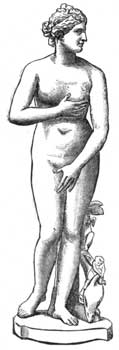 Fig. 57.—Venus de' Medici.
Fig. 57.—Venus de' Medici.
The aim of the sculptor was not to make a goddess, and his work lacks the dignity which was thrown around the more ancient statues of Venus. Cleomenes endeavored to produce a lovely woman in the youth of her beauty. Some critics believe that this Venus is intended to represent the moment when that goddess stood before Paris for judgment. If this story is not well known I will tell how when Peleus and Thetis were married they invited all the gods to their wedding save the goddess Discordia, and she was so offended by this slight that she threw into the midst of the assembly a golden apple on which were the words, "To the fairest." Juno, Minerva, and Venus all claimed it, and Jupiter sent Mercury to conduct these three beautiful goddesses to Paris, that he might decide to which it belonged. His decision gave the apple to Venus; and this so excited the jealousy and hatred of the others that a long list of serious troubles arose until Paris was driven out of Greece, and, going to the house of Menelaus, he saw and loved Helen, carried her off to Troy, and thus brought on the Trojan war of which the world has heard so much ever since. If I were writing a Sunday-school book I could draw many lessons from this story; but as I am only writing about art, I will go back and remind you that many persons try to study these old[Pg 87] statues and to find out exactly what they mean; some such students say that the moment when Paris pronounced Venus to be the most lovely of the goddesses is the time represented by the sculptor of the Venus de' Medici.
As Venus was the goddess of Love and Beauty, it was natural that statues of her should be multiplied. The Chigi Venus in the Vatican has much the same pose as the Venus de' Medici, but she holds the end of a fringed garment in her hand. The Venus of the Capitol, in Rome, is larger than these; the Venus Callipiga, which was found in the Golden House of Nero, and is now in the Museum of Naples, is also worthy of being mentioned in company with these other exquisite sculptures.
However, there is yet another Venus more admirable and more praised than these. She is called the Venus of Milo, or Melos, and is in the gallery of the Louvre, at Paris. This statue is probably of a later date than those of which we have spoken, and is thought to be the work of Alexandros, the son of Menides of Antiocheia, or one of those sculptors who are called Asiatic Greeks. It is said that the base of this statue with the name of the artist upon it was destroyed, for the purpose of leading the King of France to believe it to be more ancient than it really is (Fig. 58, frontispiece).
This magnificent statue was discovered in 1820 by a peasant of the town of Melos, or Milo, on the island of the same name. It was in a niche of a wall which had long been buried. The Marquis of Rivière, who was the French Ambassador at Constantinople, purchased it and presented it to King Louis XVIII., who placed it in the Louvre. It is made from two blocks of marble joined above the drapery which envelops the legs. As the statue now stands it has the tip of the nose and the foot which projects beyond the drapery as they have been restored by modern artists.
This is the only Venus which has come down to us from[Pg 88] the past which represents a goddess rather than a beautiful woman. The form has beauty of the highest type, but it has a grandeur which exalts it far above mere beauty. The pure, majestic expression of the head and face speak the calm dignity of a superior being. I shall quote from Perry, who says: "The Venus de Milo is justly admired, not only for the grandeur of its design, the perfection of its proportion, and the exquisite moulding of the superb and luxuriant form, but for the vivid freshness of the flesh and the velvet softness of the skin, in which it stands unrivalled in ancient and modern art. The extraordinary skill with which minute details, such as the folds of the skin in the neck, are harmonized with the ideal beauty of the whole is beyond all imitation and all praise. The life-like effect of this wonderful masterpiece is greatly enhanced by the rare and perfect preservation of the epidermis and by the beautiful warm, yellowish tinge which the lapse of centuries has given to the marble."
In the Museum at Naples is the Farnesian Hercules, which was found in the Baths of Caracalla, in Rome, in 1540. It was first placed in the Farnese Palace, and from that circumstance received the name by which it is known. It is the work of Glycon, an Athenian, and his name is inscribed upon it. There is little doubt that this is a copy of a more ancient statue by the great Lysippus; that master created representations of Hercules in all ages and forms. Glycon probably worked in the time of Hadrian; and though he copied the design and form of Lysippus, he exaggerated some points so as to injure the effect of the whole. For example, the head is small in proportion to the breadth of the breast and shoulders; and because Hercules was a swift runner the sculptor has made the legs too long to be natural. It is in such particulars as these that the decline of art may be traced, even in works that command admiration (Fig. 59).[Pg 89]
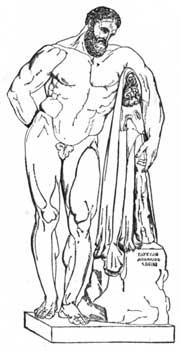 Fig. 59.—The Farnesian Hercules.
Fig. 59.—The Farnesian Hercules.
The moment in which the god is represented is that which immediately followed his securing the apples of the Hesperides, the wedding present of Ge to Juno. Of all the labors of Hercules, perhaps this was the most arduous. Juno had left these apples with the Hesperides for safekeeping. These goddesses lived on Mount Atlas, and the serpent Ladon helped them to guard their precious trust. Hercules did not know just where the apples were kept, and this made his task all the more difficult. When, therefore, he arrived at Mount Atlas he offered to hold up the world for Atlas if he would go and fetch the apples. This Atlas did, but refused to take the weight from Hercules again. However, Hercules took the apples and hastened to his master, Eurystheus, with them. While performing this labor he had a terrible struggle with Ladon, and some accounts say that he killed the monster.
Now, the statue represents the god with the apples in his right hand, the world held on his back, while he leans heavily on his club covered with a lion's skin. All the muscles of his body are swollen from his struggle; his head droops, his whole expression of face and form is that of sadness and weariness. The youthfulness and strength with which the older sculptors invested him is not here. It is a splendid work, but it is not of the best; it belongs to an age when there was too much straining after effect, when the moderation of the best Greek masters did not satisfy the spirit of the time; and no sculptor lived whose power equalled that of Phidias or Lysippus.[Pg 90]
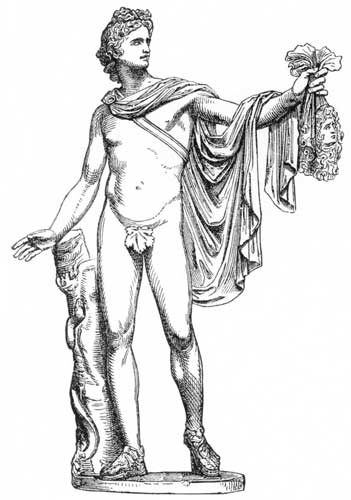 Fig. 60.—The Apollo Belvedere.
Fig. 60.—The Apollo Belvedere.
There are some reliefs and vases of this Roman period that are very interesting. I shall speak of but one relief—the Sacrifice of Iphigenia, which is in Florence. It is called the work of Cleomenes, and his name is inscribed upon it; but there is some doubt as to the genuineness of the inscription. This relief is very beautiful. It represents a priest cutting off the hair of the lovely maiden as a preparation for her sacrifice.
The story runs that Iphigenia was the daughter of Agamemnon, who killed a hart sacred to Diana. To revenge this act the goddess becalmed the Greek fleet on its way to Aulis. The seer Calchas advised Agamemnon to sacrifice his daughter to appease Diana; this he consented to do, but Diana put a hart in the place of the maiden, whom she bore to Tauris and made a priestess. In this relief the maiden has an air of resigned grief; her father stands by himself with his head covered. The sculptor of this relief was not the first who had represented Agamemnon thus, for a painter, Timanthes, had made a picture of this subject about B.C. 400, and in[Pg 91] describing it Quintilian said that "when he had painted Calchas sad, Ulysses sadder, and had represented in the face of Menelaus the most poignant grief that art can express, having exhausted the deepest feelings and finding no means of worthily portraying the countenance of the father, he covered his head and left it to every man's own heart to estimate his sufferings."
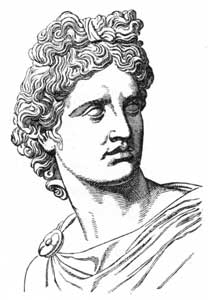 Fig. 61.—Head of Apollo Belvedere
Fig. 61.—Head of Apollo Belvedere
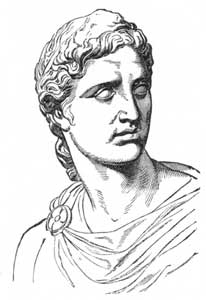 Fig. 62.—The Steinhäuser Head.
Fig. 62.—The Steinhäuser Head.
I come now to the Apollo Belvedere, one of the most celebrated of all the statues in the Vatican, and the best known and most universally admired of all the ancient statues which remain to us. It was found at about the end of the fifteenth century at the ancient city of Antium, where it probably made one of the ornaments of the Imperial Palace. The authorities upon such subjects have never yet agreed as to whether the marble from which it is cut is a marble of Greece or of Italy (Fig. 60).
This statue has been lauded in all tongues of the civilized world, and nothing could be added to what has been said in its praise; and yet all who see it wish to exalt it still higher if possible. A few years ago another head of Apollo, of Greek marble, was found in a magazine in Rome, by Herr Steinhäuser, by whose name it is known; it is now in the museum at Basle (Figs. 61, 62).[Pg 92]
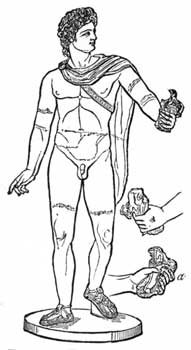 Fig. 63.—The Stroganoff Apollo.
Fig. 63.—The Stroganoff Apollo.
Though this statue has been so much studied and admired it has never yet been satisfactorily explained, and there are several important questions about it which cannot be answered with certainty. Nothing is known of its age or of the name of its sculptor. It is not described by any ancient writer, neither can any one say whether it is an original or a copy; and above all in importance is the question of what this beautiful young god is doing—what is the meaning of it?
The answers of the authorities to these queries vary so much that here I shall only mention the theory which I love, and which is accepted by many. When the statue was found the left hand was missing, and a bow was believed to have been the article which it held; and it was said that Apollo had just shot an arrow on some dreadful flight, and was watching for its effect. This theory was the principal one until 1860, when a scholar, Stephani, called attention to the fact that in St. Petersburg there is a bronze statuette, less than two feet high, which is almost exactly the same as the Apollo Belvedere—too nearly the same to be an accidental likeness. Now, as this is an antique bronze, it seems to prove that both it and the marble of the Vatican are copies of an ancient work. The statuette is called the Stroganoff Apollo, because it belongs to the collection of a nobleman of that name. It is believed to be one of a number of bronzes which were found near Janina in 1792, and given[Pg 93] by the son of Ali Pasha to his physician, Dr. Frank (Fig. 63).
The chief importance of this discovery was the fact that the left hand was perfect, and did not hold a bow, but some soft, elastic substance which Stephani believes to be the ægis, or shield, of Jupiter, on which was the head of Medusa. The sight of this shield paralyzed those who saw it; and though it belonged to Jupiter and Minerva, Jupiter sometimes lent it to his son Apollo to aid him in his warfare; such instances are recorded by Homer. After Stephani had told his idea of it, the German scholar Ludwig Preller pointed out what seems to be the true meaning of it by suggesting that Apollo was extending this dreadful ægis before the sight of the Gauls at Delphi, in B.C. 279. History relates that when the Gauls approached Delphi the people asked the oracle if they should carry away and conceal the treasures of the temple. The oracle replied, "I myself and the White Maidens (meaning Athena and Artemis) will take care of that." Then four thousand Greeks stood by ready to defend the sacred place; but in the midst of the battle the youthful god came down through the roof of the temple, and the White Maidens left their own altars to aid him in driving back the barbarous foe. A great tempest arose, and rocks fell from Parnassus on the heads of the Gauls, and it seemed as if all the powers of heaven and earth had united to sustain the Greeks against their enemies. It is also written that the spectres of Greek heroes who had long been dead were seen in the midst of the battle dealing death upon the Gauls. But above all the fury of the tempest and the noise of war the clashing of the shield and spear of Athena and the twanging sound of the oft-discharged bow of Artemis were heard, while the flash of the awful shield of Apollo was seen to be even more vivid and terrific than the forked lightnings themselves.
It is recorded that after this victory two statues of[Pg 94] Apollo and one each of Athena and Artemis were offered in the temple of Apollo as thank-offerings for its preservation and the victory over the Gauls. It is delightful to regard the Apollo Belvedere as a copy of one of these, and this view of it is most satisfying. Lübke, in speaking of this theory, says: "Not till now have we understood the Apollo Belvedere. In unveiled beauty we see the elegant form of the slender figure, the left shoulder only being covered by the chlamys, which falls down over the arm, which, far outstretched, holds the ægis with its Medusa head. The right arm is slightly turned aside, but both hands have been unskilfully restored. The attitude of the god is full of pathos, and is conceived at a dramatic moment. Ardently excited and filled with divine anger, with which is mingled a touch of triumphant scorn, the intellectual head is turned sideward, while the figure, with elastic step, is hastening forward. The eye seems to shoot forth lightning; there is an expression of contempt in the corners of the mouth, and the distended nostrils seem to breathe forth divine anger. It is a bold attitude thus transfixed in marble, full of life-like and excited action."
In the Iliad Homer describes the scene when Jupiter gave the ægis to Apollo, that he might put the Achæans to flight with it. In connection with the Apollo Belvedere it is well to recall that description which is thus translated by Lord Derby
"While Phœbus motionless his ægis held,
Thick flew the shafts, and fast the people fell
On either side; but when he turned its flash
Full in the faces of the astonished Greeks,
And shouted loud, their spirits within them quailed,
Their fiery courage borne in mind no more."
It is very interesting to know that many who believe that the Apollo Belvedere represents that god when terri[Pg 95]fying the Gauls, believe also that the statues of the "White Maidens" rushing forth from their temples to aid him are in existence, the Artemis being the statue at the Louvre known as "Diane à la Biche" and the Minerva being the Athena with spear and shield in the museum of the Capitol at Rome.
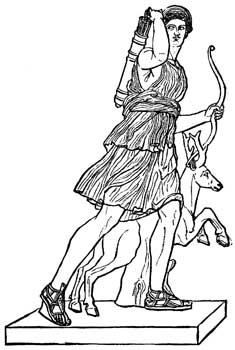 Fig. 64.—Diane À La Biche.
Fig. 64.—Diane À La Biche.
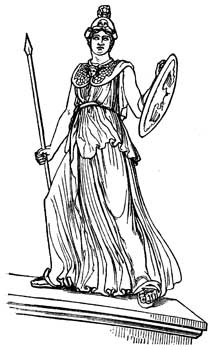 Fig. 65.—Athena of the Capitol.
Fig. 65.—Athena of the Capitol.
This statue of Artemis, or Diana, has been in France since the time of Henry IV. Formerly it was at Versailles, but is now one of the treasures of the Louvre. The left hand with the bow is restored. The effect of the figure is that of lightness combined with strength. She is going forward rapidly, with her eyes fixed on some distant object, and draws an arrow from her quiver even as she flies. This figure corresponds to the Apollo Belvedere in its spirit and apparent earnestness of purpose; it is of the same proportions, and in such details of treatment as the rich sandals it plainly belongs to the time and the school of the Apollo—indeed, there is no reason why it might not have formed a part of a group in which the Apollo stood. (Fig. 64.)
If we think of this Diana simply as an ideal huntress hastening to the chase the statue is very beautiful, and a remarkable example of such a subject; but when she is regarded as one of the "White Maidens" rushing forth to[Pg 96] aid her brother in defending his temple against a barbarous enemy she is invested with a deeper interest; she becomes an important actor in a terrible drama, and those of us who could have no sympathy with her love for hunting are roused to an enthusiastic hope that she will succeed in doing her part to turn the savage foe away from the sacred hill of Pytho, and thus preserve its temple and its treasures.
The statue of Athena, advancing with spear and shield, is supposed to be a third member of the group which commemorated the victory over the Gauls. The position of the two goddesses would indicate that they were represented as hastening from opposite directions toward the Apollo Belvedere, the central figure of the whole. The whole bearing of this statue carries out the impression which Homer gives of the delight with which Athena led the Greeks to battle; she is full of eagerness, and rushes forward with the undaunted vigor of the confidence and courage of one who goes to fight for a just and holy cause (Fig. 65).
Whether this "Gallic theory," as it is called, concerning the Apollo, Diana, and Athena be correct or no, it is the most satisfactory in sentiment of any that has been advanced, and certainly, when we consider the three statues in this connection, there is nothing inharmonious in the[Pg 97] supposition that they made the important parts of a whole which may have had many other figures of lesser importance in it.
There are many other statues of the Roman period in various museums, but I shall leave this part of our subject here, and speak briefly of the historical sculpture in the reliefs upon the triumphal arches of the Eternal City. In an age when martial glory was the chief desire of man, and among a people who accorded to successful generals the highest honors, it was most natural that the conquerors should desire to place some monument of their exploits where it would be constantly before the eyes of the people, and thus keep in perpetual remembrance their valiant deeds and their great successes.
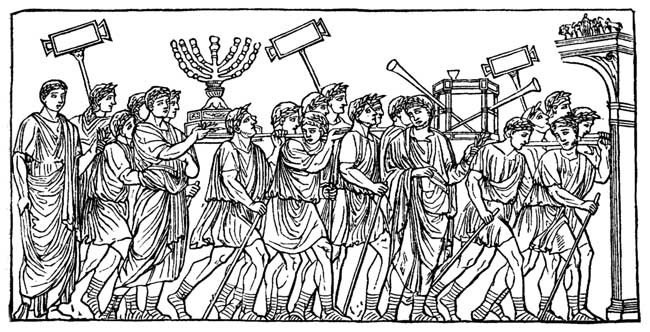 Fig. 66.—Triumphal Procession from Arch of Titus.
Fig. 66.—Triumphal Procession from Arch of Titus.
We read that pictures of the foreign scenes of sieges and battles were displayed in public places in Rome at a very early date. We cannot find records of plastic works of this sort before the time of the emperors, but after such sculptures came into favor they were multiplied rapidly. The principal historical reliefs in Rome were upon the arches of[Pg 98] Claudius, Titus, Trajan, Marcus Aurelius, and Septimius Severus, and on the architrave of the temple of Minerva in the Forum.
Of the arch of Claudius there are some remaining fragments of sculpture, now in the Villa Borghese. The arch of Titus was erected to celebrate the taking of Jerusalem in A.D. 70. It was restored in 1822. The frieze represents both a triumphal procession and one of sacrifice. The picture we give here shows a company of warriors in the dress of peace, who bear articles of booty taken from the conquered city. They have the candelabra with seven branches, the table of the shew-bread, the silver trumpets, etc. This will give you a good idea of these reliefs. (Fig. 66.)
The arch of Trajan no longer stands, and its reliefs are now on the arch of Constantine; but Trajan's Pillar is one of the best preserved of all the antique monuments of Rome, and with some account of this column and a picture from it we will leave the historical sculptures of Rome. The Senate and people of Rome decreed that this column should be erected to the memory of Trajan, and it was in the centre of the Forum which bore the same name—the Forum Trajani. The column is about one hundred and six feet high, and originally was surmounted by a bronze statue of Trajan, which was replaced by one of St. Peter by Pope Sixtus V. A band of reliefs runs around this pillar in a spiral form; this band is six hundred feet long, and the sculptures represent Trajan's campaign against the Dacians. Many of the figures lose their effect on account of the height at which they are placed. There are more than a hundred scenes upon it, in which are about twenty-five hundred human figures, besides many horses and other objects. The whole is executed with the greatest care.
The real object of the whole work was to glorify the Emperor Trajan, and he is represented in many of the scenes; sometimes he is conducting engagements, storming[Pg 99] a fort, or encouraging his troops; again he is holding an audience, protecting the women of a conquered city, or sitting in judgment on captives. Fig. 67 represents the Dacians assaulting a Roman fort. It is winter, and while some have crossed the ice in safety, others have broken through. Everything about it is represented in the most life-like and matter-of-fact manner, and this shows distinctly the principal difference between the Greek and the Roman art when the latter was not influenced by the former. It is pure, realistic, historical sculpture, and this pillar shows this at its very best estate; it is a splendid specimen of this kind of art. In all these many scenes there are but two mythological figures: one is Selene, used to represent Night, and the other is Jupiter tonans, who indicates Storm. But the correctness and elegance of the sculptures show what the Greek teaching did for the Romans; for it was to the Greeks that the latter owed their knowledge of the human form and their power to render it properly in sculpture.
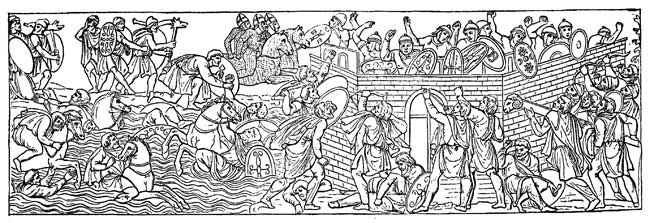 Fig. 67.—From the Reliefs of Trajan's Column.
Fig. 67.—From the Reliefs of Trajan's Column.
The last sort of ancient sculpture of which I shall speak is portrait sculpture, and perhaps this belongs also to historical sculpture, for it is by means of statues and busts that we know the faces and forms of many of the great men and women who hold their places in the regard of the world through all the centuries, because they were concerned in the events which make up what we call the history of the world. We have said that in Greece in very early times there were no portrait sculptures; gradually they were introduced until, in the time of Alexander, portrait statues were almost numberless, and these and busts were used for the decoration of libraries and public buildings, as well as for the adornment of squares and places of resort in the open air.
The finest life-size statue which remains from the Greeks is that of Sophocles, of which we give a picture (Fig. 68). It was not found until about 1839, and was presented to Pope Gregory XVI. by Cardinal Antonelli; it is in the museum of the Lateran. This engraving from it shows its beauties so well that it is scarcely needful to speak of it in detail. This statue is valuable not only as a portrait of Sophocles, but as a representation of a true product of the highest and best of Athenian civilization and culture; of an elegant, aristocratic man who was trained in gymnastic and warlike exercises which developed his physical parts, as well as in science, philosophy, and music—in various deep studies and lighter accomplishments which rendered him profound and scholarly, and at the same time elegant and graceful. "The attitude, though simple, is well chosen to show the most graceful lines of the figure; and the position of the arms—the one gracefully enveloped in the himation, and the other firmly planted on the hip—gives to the whole form an air of mingled ease and dignity. The face is handsome and full of winning grace, and bears the stamp not only of the creative genius of the poet, but of the experi[Pg 101]ence of the active citizen; of one who has felt both the joys and the sufferings of human lot, and preserved amid them the constitutional calmness, the gentle benevolence, the tranquil, meditative piety for which he was renowned and loved by the people among whom he lived and sang."
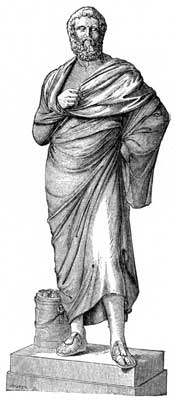 Fig. 68.—Portrait Statue of Sophocles.
Fig. 68.—Portrait Statue of Sophocles.
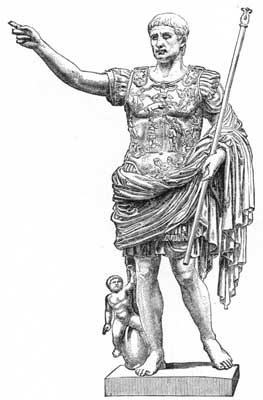 Fig. 69.—Statue of Augustus.
Fig. 69.—Statue of Augustus.
Among the Romans portrait sculpture held a position of importance. This people had always placed great value upon the likenesses of the dead, and from the earliest times had used different means of making them. In the very early days of the nation the custom prevailed of making masks of the faces of the dead in wax, and these masks were worn in the funeral procession by one of the mourners, who also wore the dress and insignia of the departed. The first aim in these masks was to have an exact resemblance to the dead; and this idea was carried on through all the eras of Roman art, and is a strong distinguishing feature between Greek and Roman sculpture; for while the Greeks wished to reproduce the face of one of whom they made a bust or statue, they did not hesitate to idealize that face; but the Romans labored to make an exact likeness of the man, leaving him in his statue as nothing more than he looked to be. This manner of portraiture often does great injustice to its model, for the changing expressions which come with emotions and with conversation often illuminate the plainest faces with a rare beauty; therefore the aim of portraiture should be to give the very most and best that can be imagined as coming to the face which is reproduced.
I can speak of but a few of the almost numberless Roman portrait sculptures.
This statue of Augustus was found in 1863 in a villa built by his wife, Livia, about nine miles from Rome, at Porta Prima. It is a noble work, and every minute detail of the ornamentation has a force and meaning that can be[Pg 103] explained. At the same time the whole work is full of strength and dignity, which comes from the character of the man himself, and is in no sense dependent on all the emblems of his rank and power, with which the dress is loaded (Fig. 69). This statue is in the Vatican, and there one can compare it with the exquisite bust known as the "Young Augustus" and with the statue of the emperor when aged, in which he is veiled as a priest. The study of these three sculptures, thus fortunately near each other, is most interesting.
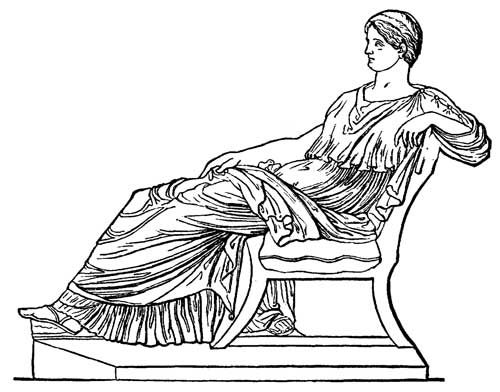 Fig. 70.—Agrippina the Elder.
Fig. 70.—Agrippina the Elder.
The Roman women who held important positions were frequently honored with statues. Among those that remain none is more interesting than this of the elder Agrippina. She was a woman of great strength and equally great purity of character, and as we study this statue we can easily understand that she could perform the duties of a general when occasion demanded this service, and when that necessity was past could nurse the sick and wounded with all the tenderness of a true womanly nature. It is in every way a noble work of art, combining grace, dignity, and the aristo[Pg 104]cratic refinement of a high-born lady. The drapery of this and other similar statues is very beautiful, and fully satisfies all artistic demands. We have full proof that such garments were in actual use by the women of Greece and Rome (Fig. 70).
It was not unusual for the great men and women of Rome to be represented in portrait statues with the attributes of gods and goddesses. Livia appears as Ceres, Julia as Flora, and so on; and during the best days of Roman art these statues were very beautiful. But at last they, like all other sculptures, grew less and less worthy, until they became positively absurd, and lacked any power to command our admiration.
What is thus true of portrait sculpture is true of all Roman art. Its decline kept step with the decline of the nation, and both fell at length into a pitiable state of feebleness and corruption. From this we are glad to turn to the study of Christian art, which, even in its primary struggles, when groping its way through ignorance and helplessness, was still a living thing, and held the promise of a new life—a renaissance of that which had gradually died in Greece and Rome.[Pg 105]

The ancient or classic Italian sculpture of which we have spoken may be said to have extended to about the middle of the fourth century of the Christian era. The arch of Constantine was one of its latest works, and is interesting as an example of the decline of art. The sculptures upon it, which were taken from the arch of Trajan, executed two centuries earlier, are so superior to those that were added in the time of Constantine, that nothing could give one a clearer idea of the decadence of sculpture than seeing the works of two periods thus placed side by side.
After the time of Constantine, when the Christians were no longer forced to hide their art in the catacombs, they began to have a sculpture of their own. The first Christians in Rome were brought into contact with the worship of Isis and Pan, Venus and Apollo, and were filled with horror at the sight of the statues of these divinities. They believed that any representation of the human form was forbidden by the commandment which says, "Thou shalt not make to thyself any graven image, nor the likeness of anything that is in the heaven above, or in the earth beneath, or in the water under the earth." Thus it happened that when[Pg 106] the early Christians desired to represent the Saviour they employed painting, such as is found in the catacombs, rather than sculpture, and separate statues are the rarest remains of early Christian art.
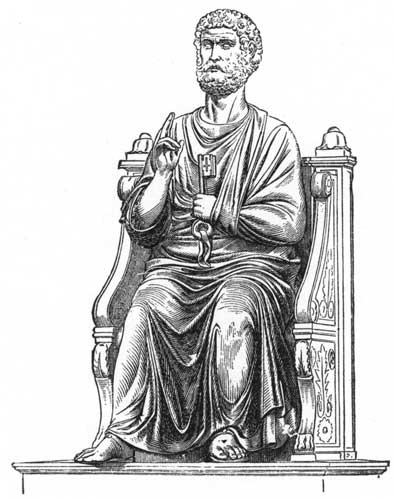 Fig. 71.—Statue of St. Peter.
Fig. 71.—Statue of St. Peter.
The oldest Christian statue which is known in marble is that of St. Hippolytus, which is in the Museum of the Lateran Palace, where there are also two small statues of Christ as the Good Shepherd, which were found in the catacombs.
The most important statue of this period is that of St. Peter, which is held in great reverence by Roman Catholics, who kiss its toe as they enter the church of St. Peter's at Rome, and press their foreheads against the[Pg 107] extended foot. The statue is of bronze, and some antiquarians believe that it is the Jupiter of the Capitol changed so as to answer for a statue of St. Peter; others say that it was cast from the metal of the statue of Jupiter; and the usual belief is that it was made by the order of Pope Leo I. about the middle of the fifth century as a thank-offering for the deliverance of Rome from the barbarian Attila by the miraculous protection of St. Peter and St. Paul. This statue is too rude to belong to classic art, though it is of remarkable excellence for a work of the fifth century (Fig. 71).
The principal use of sculpture by the early Christians was for the decoration of the sarcophagi, or burial-cases. These were cut in bas-reliefs after the manner of the ancients, the subjects being taken from the life of Christ; the ornaments were the Christian emblems, such as the lamb, cross, vine, palm, dove, and the monogram of Christ. As time passed the designs were more and more elaborate; stories from the Old Testament were frequently illustrated, and numerous figures were crowded together, with many symbols ingeniously inserted to make the meaning of the whole more clear.
The largest number and the best of these sarcophagi are now in the museums of the Lateran and the Vatican. In the centre of one of the finest of these is a shell, in which are the half figures of the two who were buried in this sarcophagus. At the upper left hand is the Saviour before the tomb of Lazarus; one of the sisters of the dead man kisses the hand of Jesus; next to this is the Denial of Peter; nearest the shell Moses reaches up to receive the Table of the Law. On the right of the shell, in the upper row, is the Sacrifice of Isaac and the Washing of Pilate's Hands. On the lower row, beginning at the left, is Moses causing the Water to flow from the Rock; next is the Apprehension of Peter, and next, Daniel in the Lions' Den.[Pg 108] Besides these there are the Healing of the Blind and the Miracle of the Loaves and Fishes. This will show how elaborate the carving is on these burial-cases, and how the subjects from the Old and New Testaments are mingled without order or apparent reason. These sarcophagi have been found in various parts of Italy and in France, and are seen in many museums.
In no part of the Roman Empire was sculpture as favorably regarded by the early Christians as at Byzantium. Several attempts to adorn the city with statues and other works of art were made there, and many of the Greek sculptures which had been carried to Rome were again borne off to decorate this new Capitol. The Emperor Constantine there erected a column a hundred feet high, and placed his statue on it; Theodosius also erected a column and an obelisk; but Justinian excelled all these, and about 543 A.D. set up a monument with a colossal equestrian statue of himself in bronze upon it. The column which supported this statue was of brick masonry covered with plates of bronze. From the accounts we have of it we conclude that this was a fine work for its time; it was called the Augustio, and was placed on the Augusteum near the church of St. Sophia; in the sixteenth century it had been overthrown and broken in pieces, and the metal was then melted down. The artist who executed the Augustio was Eustathius of Rome, who was sent to Byzantium for this purpose.
But the Byzantine Christians soon grew into a fixed disapproval of statues, and favored only the lesser works of art. Ivory-carving, which long before had been brought from the East by the Greeks, now came into special favor, and the Byzantine artists devoted all their talent to making beautiful works of this sort. The most important of these carvings which remains is in the cathedral of Ravenna. It is the episcopal chair or cathedra of Maximianus, and was made between 546 and 552 (Fig. 72).[Pg 109]
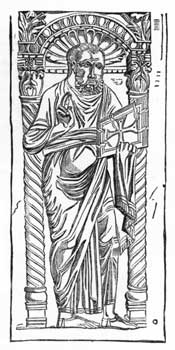 Fig. 72.—From the Cathedra of Maximianus.
Fig. 72.—From the Cathedra of Maximianus.
This chair is composed entirely of carved plates of ivory; scenes from the life of Joseph and other similar designs are represented, and these are surrounded by a great variety of small figures, which form a sort of framework around the principal parts; for example, animals and birds among vine-branches, and all arranged in a life-like and artistic manner. So large a work as this chair in ivory is unusual. The greater number of ivory carvings are upon small objects, such as drinking-cups and other vessels, book-covers and diptychs, or tablets for writing, of which fine specimens remain and are seen in art collections.
Diptychs were carved ivory tablets, with the inner surface waxed for writing, and were used by the early Christians, as they had been by the ancients. The illustration given here is from the diptych of the Consul Areobrudus, and belongs to the year 506 (Fig. 73). The whole design upon it represents a contest with lions and bears; the scene is where—the circus gates being thrown open—the animals rush into the arena to be slain by the gladiators. Some diptychs are ornamented with subjects from the life of Christ and other religious themes.
About the beginning of the tenth century ivory-carving was much used for church purposes. The smaller altars were covered with it, the vessels used for the Holy Sacra[Pg 110]ment were made of it, magnificent covers for church books, were carved, and as much thought seems to have been given to the designs upon these small objects as had formerly been devoted to the splendid temples of the ancients. Ivory-carving extended from Byzantium into Germany and other Western countries, and along with it went the working in rich and precious metals, which had also been practised somewhat by the earlier Christians.
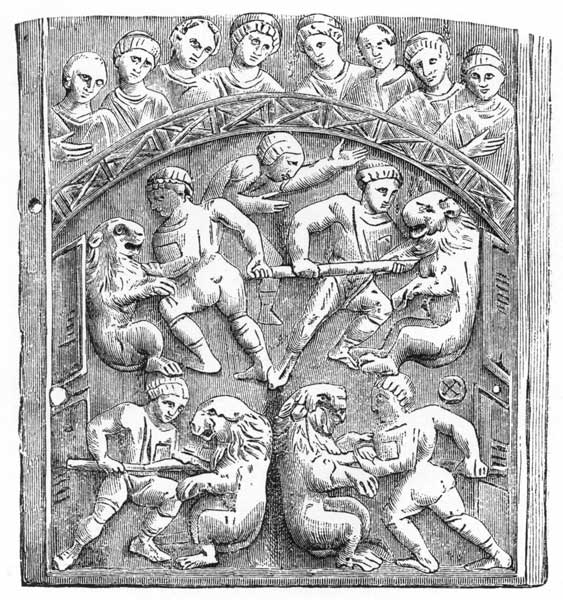 Fig. 73.—Diptych.
Fig. 73.—Diptych.During the tenth century the metal works were very costly, and the different cathedrals and churches rivalled each other in possessions of this sort. Altar tables were[Pg 111] covered with embossed metal plates, which were extended down from the top of the table to the floor, forming antependiums, as they are called, in the same way that those of cloth are now used. These plates of metal were worked into designs in relief, ornamented with delicate filigree work, with paintings in enamel, and even with rare antique cameos and exquisite gems. Crucifixes were also made of metals and richly adorned, as well as all the vessels and smaller articles used in the service and ceremonials of the church—incense-burners, candlesticks, tabernacles and reliquaries, or caskets for preserving relics. In the sacristies of many old churches and in art collections these rare, costly articles are still preserved, and are of great interest in the study of art.
Many of the designs used on these objects were quaint and even grotesque, while the drawing of the figures and the arrangement of the subjects is often done in the crudest and most inartistic manner. Vessels for church use were made in the shapes of griffins, dragons, cranes, lions, and other curious birds and beasts, while the human faces represented sometimes had enamelled or jewelled eye balls. In one case the eyes of the Saviour were made of large carbuncles; you can understand that this would give an expression quite the opposite of that gentleness and peace which we look for in the face of the Redeemer. In truth, there is so much of the grotesque and even barbarous element in many of these works, that we can but ridicule while we recognize the industry and care which was expended upon them. It is also difficult to understand how the feeling for art and the practice of it which had attained to such perfection among the ancients could have died out of the world so completely, for in these mediæval days it existed nowhere on the face of the earth.
About the beginning of the eleventh century bronze casting came to hold an important place in the art of Ger[Pg 112]many, and as architecture now received more attention, and bronze gates, and occasionally bronze figures of bishops and other church dignitaries, were used for the decoration of church buildings, we may say that bronze works made the medium through which sculpture in connection with architecture was again brought into use. At Hildesheim there is still a bronze gate at the principal entrance to the cathedral, which was cast in 1015, and in various places in Germany, France, and Northern Italy works of this kind are seen which belong to the eleventh century, while a bit of stone or wood sculpture of this period is very rarely met.
The twelfth century brought about a great change in sculpture and its uses. This century was a period of remarkable activity in every department of human life. The Crusades were then preached, and armies of zealous Christians went forth to redeem Jerusalem from the power of the Pagans; in this century all the institutions of chivalry flourished; the nations of the world had more intercourse with each other than had before existed; commerce was extended into new channels; men were more individual and thought more independently for themselves than they had done hitherto; and, in short, human intellect all over the Western world seemed to be awakening from a long, deep sleep, and to be inspired with strength and activity.
With all the other changes there came revivals of architecture and sculpture, which went hand in hand, and in the beginning can scarcely be separated from each other. The early Christians had been content with the decoration of interiors; now the exteriors received much attention, and the portals or entrances to the churches were richly decorated with statues and other sculptured ornaments, and the exterior decoration soon extended to many portions of the edifices. In the interiors, too, the altars, fonts, choir-screens, and other objects were made of carved stone or of stucco, which hardened like stone, and were all richly orna[Pg 113]mented with sculpture. A completely new spirit seemed to possess the artists, who thus found a satisfactory field for their labors, and the period known as the Romanesque was thus ushered in.
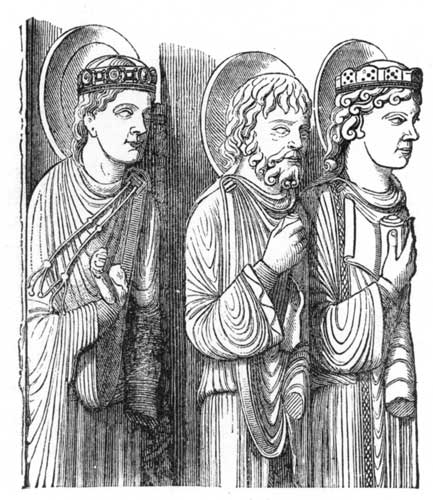 Fig. 74.—From the Façade of Chartres Cathedral.
Fig. 74.—From the Façade of Chartres Cathedral.
We cannot claim that the works of the twelfth century were free from the faults of the preceding eras, or were satisfactory to our artistic sense; but we may say that they show the effect of the new life which had come into the world, and give unerring promise of the progress which followed. The same improvement is seen in bronze-casting as in sculpture; and though to our eyes it still remains crude and ungraceful, yet by comparing it with the work of the previous century we mark a hopeful and important change.
Germany, in its different provinces, took the lead in this artistic progress; but France was not far behind; and, in[Pg 114]deed, in the cathedral of Chartres the first promise was given of the splendid church portals of the early Gothic style of architecture which followed the Romanesque. In this cathedral, too, we see for the first time an attempt to make the head and face a reproduction of nature rather than a repetition of the classic head, which had come to be so imperfectly copied that it had degenerated into a caricature. (Fig. 74.)
Other cathedrals at St. Denis, Le Mans, Bourges, and Paris are splendid examples of the art of this time; and when we remember how Italy took the lead of these northern countries in later days, it seems strange that at this era she was far behind them. It is even true that the first works in Northern Italy which indicated that the awakening which had come north of the Alps had reached that country were executed wholly or in part by German artists; but by the end of the twelfth century both the sculpture and bronze-casting of Italy gave promise of the great revival of true art which was to come in that home of the arts.
However, it is not possible to connect the art of Italy with that of any other country in any comprehensive sense. Italian art may be said to have died out more completely in the beginning of the middle ages than did the art of northern nations; its period of decline, too, was longer; but when its awakening came it aroused itself and took on new strength by a method of its own, and may be said to have been distinct from northern art in every respect, and divided from it by its different spirit as clearly as Italy was divided from other lands by the towering summits of the Alps.
About the beginning of the thirteenth century there dawned upon the northern nations a new era in literature. Hitherto the written language had been the monkish Latin; now the poets began to use their own tongues. This new writing may be said to have commenced with the Provençal[Pg 115] poets, who were followed by those of Northern France; but it was in Germany that such song broke forth as showed how the national feeling had been repressed, and how, now that it had burst its bonds, it resembled the freshets of spring when they escape from the icy hand of Winter and rush from one point to another, brushing aside every obstacle which lies in their way. I cannot here speak in detail of these poets and their works, but Hartmann of Aue, Walther von der Vogelweid, Wolfram and Gottfried of Strasburg are names which grow brighter with passing centuries.
At the same time with this advance in letters there came, in North-eastern France, the new Gothic style of architecture, which had the effect to revive sculpture and in a degree restore to it the importance it had in classic days. Now, the same artist was both architect and sculptor, and the result was that architecture was so arranged as to afford an honorable place to sculpture, which, in its turn, added much to the grand and full effect of architecture.
Artists now began to study nature and the life about them in preference to the antique, and the sculptors of the thirteenth century were fortunate in living in a time when costumes were picturesque and suited to artistic representations. The dress of a knight was as graceful as one could wish, with its flowing lines and the mantle clasped at one side of the neck, or thrown loosely over the arm and shoulder; and the costume of the other sex, with the full folds of the lower garment fastened by the girdle, and veiling without hiding the movement of the figure, was scarcely less fitting for the artists use than were the classic robes of the Greeks.
The effect of the sculpture of this period was frequently heightened by the use of color. The draperies were enriched by gold ornaments, and painted in rich blue and red, while the flesh parts were delicately tinted. Colors were[Pg 116] used with care, and often served to conceal the defects in the sculpture itself, and were thus of great advantage. Color was most frequently used in interior decoration, but it was not unknown upon exterior portals, and porches were introduced to protect this polychromy, as the painting of sculpture was called.
The subjects now represented in sculpture were far more numerous than formerly. While the life of Christ and the Virgin still made the central and most important topic, there were added scenes from the lives of the saints, those who were regarded as the patrons of the city or those to whom the edifice was dedicated being most frequently chosen. New symbolic designs were made showing the flight of time by seasons and months; others represented the virtues, and even the customs and habits of the people were sometimes introduced. There were also humorous representations, even on sacred edifices. Water-pipes and gutter-spouts were ended with the heads of monsters and curious animals, and even with grotesque faces; in short, the smaller details of the architecture of this period show the vividness of the imagination of the time. For example, the leaf-work which was used in the ornamental portions of sculpture had hitherto copied the antique acanthus leaf; now the flowers and leaves native to France were the models of the sculptors, and a charming variety of life-like ornament was the result.
The church of Ste. Chapelle, at Paris, completed about 1248, was the first edifice in which this style was seen in its full development. Here, for the first time, the statues were not placed in the stiff, perpendicular posture, but, by being inclined to different positions, had a light appearance and an air of movement, which was a great relief from the rigidity which had ruled up to this time.
The cathedral at Rheims, however, shows the perfection of thirteenth-century art. It is conceded to be the best[Pg 117] example of church building of its time, and its façade the most beautiful structure of the Middle Ages. Its wealth of sculpture is wonderful; its three great portals, the buttresses, the space above the great window and various other portions are so much ornamented that the whole effect is that of a forest of sculpture, and it is difficult to turn from it to consider the architecture of the edifice. It naturally follows that in this vast amount of artistic work there is no equality of excellence; some of the statues are like those of an earlier date: some are too tall and awkward; others too short and rotund; but there are many elegant figures, full of grace and dignity, with the drapery falling in natural folds, and an air of life and freedom of movement about the heads quite unknown before this time.
In one of the side portals of this cathedral there is a figure of Christ which was not surpassed by any work of this period. The study of every portion of the figure is so perfect as to surprise us when we remember that anatomy was not then studied by artists as it had been in classic times or as it has been in more recent days. This statue holds an orb in the left hand, and the right hand is uplifted; not only the nails of the fingers, but the structure of all the joints is skilfully indicated.
It frequently happens that the reliefs are far more excellent than the statues of mediæval date. This is so noticeable that it would seem as if the best sculptors preferred to make the reliefs, and that the figures were left to those of less talent. On the pediment at Rheims the Last Judgment is represented in five divisions, and these reliefs are among the most beautiful sculptures of this century. The scene of the Resurrection of the Dead is arranged in two rows of figures; a section of it is here given (Fig. 75).
There are twenty-nine of these little figures in the whole subject, and the variety of positions and the naturalness of the various expressions are all that could be desired in any[Pg 118] age of art. The forms are in good proportions, and the faces are filled with fear, surprise, hope, and supplication. A volume might be written upon the sculptures of the Rheims Cathedral which would be full of interest to the student of mediæval art.
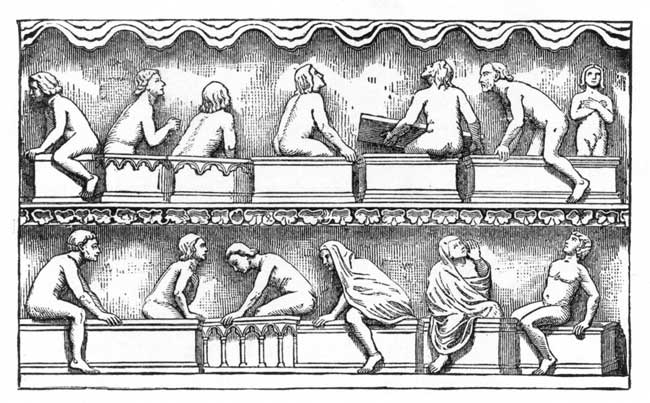 Fig. 75.—From the North Transept of Rheims Cathedral.
Fig. 75.—From the North Transept of Rheims Cathedral.
Critics have compared the progress and life which pervaded the art of the thirteenth century with the spirit of the age of Phidias. The two periods are alike in the fact that the artists of each broke away from the traditions of those who had preceded them, and took up their work with a desire to come nearer to nature. They were alike, too, in the union of architecture and sculpture, and in the fact that all kinds of sculpture were required for the adornment of a single structure. Colossal and full-sized statues, statuettes, reliefs, and a great variety of simply ornamental designs were lavished upon the Christian cathedral, as they had been upon the Greek temple; and in one case as in the other the various groups and scenes represented were intended to show forth religious mysteries, and to illustrate[Pg 119] the working of the supreme power which controls the world in relation to human beings.
But I must leave this part of our subject and speak of the monumental sculpture of the thirteenth century. While many of the tomb statues still retained a general resemblance to those of the past, there were many examples of new strength and progress. In a church near Le Mans the statue of Berengaria, the wife of Richard Cœur de Lion, who died in 1219, was made with open eyes; this gives a very life-like appearance to the face, and the whole head is as noble as that of an antique statue; the drapery is full and free; the feet rest upon a dog, which is the emblem of fidelity, and in the hands is a casket. There is something about this statue which appeals to us—a human element which had been sadly wanting in the monumental statues of the preceding centuries.
But the series of reliefs which were made for the Cathedral of St. Denis were the most important tomb sculptures of this period. They were sixteen in number, and represented princes of the early lines of French sovereigns down to the thirteenth century. Of course those of the Merovingians and Carlovingians could not be portrait statues, and the heads of both kings and queens are all of the same type until those of Philip the Bold, who died in 1285, and his wife, Isabella of Aragon, who died in 1271, are reached. These two are intended to be portraits, and they show the individual characters of these royal personages. In all France there is no more interesting succession of monuments than these.
In Germany the Romanesque style of architecture and the sculpture which went with it held their sway much longer than in France, and the new Gothic style made its way very slowly in the countries north of France. Slight traces of its influence in one way and another may be found about the middle of the thirteenth century; but it was not[Pg 120] until the very end of this period that the Gothic style had affected German art, except in the south-western portions of the country. These provinces bordered upon France, and formed a sort of middle ground between the two nations. In Strasburg, at the end of the century, a cathedral was built which was one of the most splendid examples of a union of the two styles that could be produced. The sculptures show the effect of the new French manner in their life and ease of grouping and attitude, while they are still crowded and over-decorated, as in the earlier days, and the fixed architectural frame of the German style is preserved throughout. (Fig. 76.)
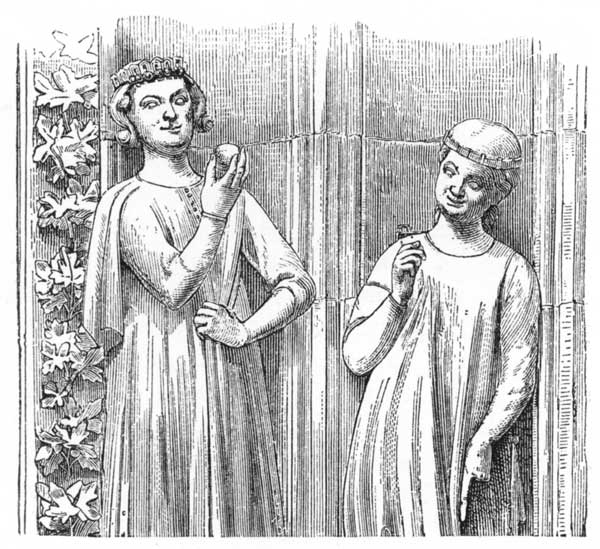 Fig. 76.—From the West Façade, Strasburg Cathedral.
Fig. 76.—From the West Façade, Strasburg Cathedral.
There is reason to believe that the relief of the Death of the Virgin, at Strasburg, was the work of Sabina von Steinbach, a daughter of the architect of the west façade of the cathedral. The grouping is fine, and the transparent dra[Pg 121]pery, which reminds us of the same effects in antique sculpture, is beautifully executed.
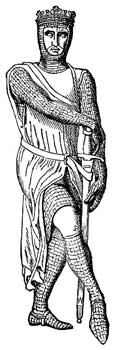 Fig. 77.—Duke Robert of Normandy.
Fig. 77.—Duke Robert of Normandy.
In the Cathedral of Freiburg, the nave of which was completed in 1270, there are some very fine sculptures, which are like the Rheims works in spirit and execution; a figure of the Madonna is one of the best statues of the time in any country. There is much to admire in the whole of this cathedral. Here and there in Germany there are some tomb-sculptures of the thirteenth century, which are simple, noble, and individual; but the progress of art here was much less rapid than in France.
Another marked event in the art history of the thirteenth century was the introduction of sculpture into England. The few pieces of plastic art which existed in that country before this date were not sufficient in number or excellence to merit the name of English sculpture.
The first important step was made about the end of the twelfth century, when Guillaume de Sens, a French architect, was employed to build a new choir to Canterbury Cathedral. Not long after this the Temple Church was erected; then Westminster Abbey followed, and at length, under Henry III., all the arts were rapidly advanced in his kingdom. This king summoned artists and skilled workmen from different countries, and portrait-sculpture received especial attention in the England of that day. By comparing English tomb-sculpture with that of other countries, it is seen that the aim of the artists was to make the statues resemble those whose mem[Pg 122]ories they honored, far more than other nations had done. The illustration given here, with its air of life—almost of motion—is a good example of what I mean (Fig. 77).
The sculptures upon the English exteriors, and, indeed, upon the interiors of edifices, were far less lavish than on the Continent; but in Wells Cathedral, completed before 1250, there is a wealth of sculpture for an English church of this date, and from this time forward the plastic arts were of great importance in Great Britain.
With the beginning of the fourteenth century there were great changes in the religious and political affairs of all Europe. The Pope no longer held the supreme authority that had belonged to his office, and the imperial power was also much shaken. We cannot speak of these subjects in detail here, but the result to art of these changes was seen in a development of individualism, and the effects of it did not show an improvement when considered as a whole, though it has some new features which were attractive.
In these days of which we now speak the word citizen had a far deeper meaning than ever before, and the growth of wealth and prosperity in the citizen classes gave a new impulse to all the activities of life, and to art along with others.
This new life and spirit gave more freedom to artists, and they attempted new effects, so that a far greater variety was made in their works. The statue of the Madonna, for example, was so often repeated that it afforded an opportunity for all sorts of experiments, by which the sculptors tried to add to the deep feeling and the devotion that had already been expressed in the representations of the sweet Mother of Christ. But just here they failed; the new era brought more realism, more likeness to nature, more freedom to the artist to put something of himself into his work; but much of the deep thought and the devout[Pg 123] feeling of the thirteenth century was lost, and it cannot be said that art was elevated in its tone.
There were influences, too, in the new state of society which permitted details to be introduced into religious subjects which were far from suitable or devotional; sometimes they were even comic in their effects. For example, such scenes as allowed the representation of evil spirits or devils were made to serve for all sorts of coarse, grotesque, and burlesque side-play, and the little figures which represented these powers were made to do all kinds of ridiculous capers side by side with such serious subjects as the Last Judgment or the death scenes of eminent men. This makes us feel, when we study the fourteenth century, that the sculpture of the Middle Ages reached its highest point in the thirteenth century, and soon after began to decline.
In Germany the most important sculptures of this period were executed at Nuremberg. The Church of St. Laurence, that of St. Sebald, the Frauenkirche, or the Church of Our Lady, are all great monuments to the art of this city and the calm dignity and grace which marked the works of the Nuremberg sculptors.
At the close of the century, between 1385 and 1396, Master Heinrich den Balier erected the "Beautiful Fountain," which is still the pride of the city and a splendid monument of the time. In Nuremberg many of the dwelling-houses were decorated with sculptures, and it is now one of the most interesting places in all Germany to the student of ancient art.
We have not the space to speak in detail of the sculpture of the time; Augsburg, Prague, Stuttgart, Bamberg, Würzburg, Cologne, and many other German towns and cities have rich treasures of its work, but its character is everywhere much the same, and great activity, with a tendency toward decline, are its prominent features.
In Germany in this century ivory-carving was much[Pg 124] practised and used for a great variety of purposes. In these smaller works the life and freshness, the grace and spirit of the manner of the time were very attractive (Fig. 78).
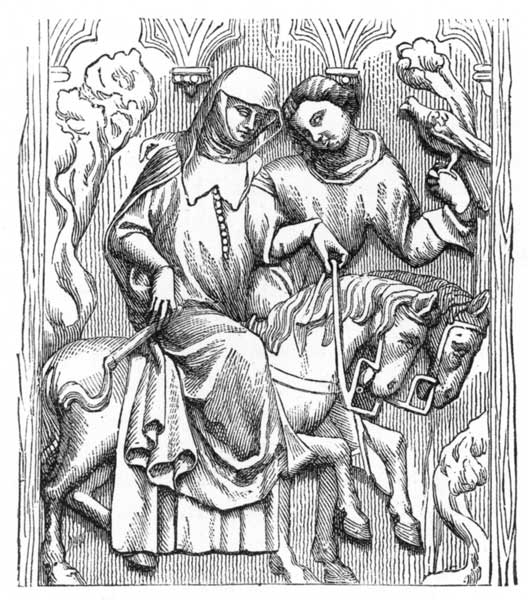 Fig. 78.—Ivory Relief. Hunting Scene.
Fig. 78.—Ivory Relief. Hunting Scene.
In France the fourteenth century was much less productive of works of art than the preceding one had been. The fact that so much had been done in the thirteenth century—so many new churches built and so many older ones remodelled—is one reason for this change. In this direction there was very little left to be done. Then, too, the country was so disturbed by wars with England that the arts of peace suffered neglect. However, there was still much to be done to complete the grand works already begun, and during the early part of this century a great deal was accomplished by way of interior decoration in edifices not yet[Pg 125] completed, and in the making of monuments in memory of persons of rank and importance. Those in the Cathedral of St. Denis were much increased in number, and in all parts of France these works were multiplied.
During this century many artists from the Netherlands were employed in France; and in the city of Dijon, which was the residence of the dukes of Burgundy, the works of Flemish artists were very numerous.
Perhaps the most skilful of these masters was Claux Sluter, who was the favorite of Philip the Bold, and executed the splendid monument to that duke which is now in the Museum at Dijon. He was also the sculptor of the Moses Fountain, the decorations of the Carthusian chapel, and other works which still remain to show how fine a sculptor he was. Sluter had a great influence upon art, and, in fact, may be said to have established a school the effects of which endured long after his time.
In England sculpture made no progress during the fourteenth century. Large architectural sculptures were neither numerous nor fine. Tomb-sculptures and monuments with portrait reliefs and statues were the principal plastic works of the time. The habit of erecting monuments to the dead now extended to all classes, whereas it had formerly been confined to noble and distinguished people. The result was that the monuments of the higher classes were more and more splendid in order to mark the differences of rank, and much grand effect was thus produced; but the merits of the sculpture was less than formerly, and the monuments of this age are wanting in spirit, stiff and unattractive. The costume of the time, too, was so ugly that it served to give a grotesque air to many figures, and thus added to the general appearance of decline which marked the English tomb-sculpture of the fourteenth century. It compares unfavorably with the German monuments of the same period, and the realistic portrait element which ruled it makes it[Pg 126] seem like a monotonous and feeble system of mechanics rather than a style of art.
As we have said, the sculpture of Italy was quite different from that of the more northern countries of Europe. One great reason for this was that individualism in art was a strong power in Italy much earlier than in more northern countries. In Germany the early sculptors of the Middle Ages did not put their names upon their works; they practised their art as a religious service, and their pious devotion made them forget themselves. Not so in Italy: there each artist wished to be known in his works, and regarded them as works of art, done for the sake of art, and not as acts of piety. One result of this difference was that the northern sculptures had more of deep feeling and profound thought in them, while the Italian works had more perfection of form.
In Italy sculpture held the second place in the decoration of churches. Painting was preferred before it, and in spite of the influence of the Gothic style, which extended south of the Alps, the Italians would not give up their large wall-spaces and the splendid Christian paintings which were their glory. They built their edifices with this end in view, and as the same person was frequently an architect, painter and sculptor, he knew how to arrange his plans so as to suit his ideas of the merits of each art.
So it happened that the principal works which the sculptors did for the church were separate objects, such as altar-pieces, fonts, pulpits, and tombs. It rarely occurred that whole fronts of churches were covered with sculptures, as in Germany or France, and there were few richly sculptured portals of churches in Italy. The material mostly used for Italian sculpture was fine white marble, which was very rarely colored; sometimes a little gilding was used; but as a rule painting and sculpture were not united, as they had been north of the Alps.[Pg 127]
However, the sculptors of Italy had a wider range in art than in other lands; for being less devoted to the service of the church, they were employed for more secular works. It is true that the separate statues of the Madonna were very numerous, and that tomb-sculpture was important; but added to these there were civil monuments to show forth the glory of the cities and their great men, and there were public fountains and other sculptures which told of the splendor and fame of each one of the many petty powers into which the whole country was divided. The council-halls of the free cities were very fine, and gave great opportunity to Italian artists to give variety to their works, and the sculptors very early excelled in reliefs, which told historical stones with great clearness.
As early as the beginning of the thirteenth century we can trace the progress of Italian sculpture by telling the story of the lives of separate artists. The first man of importance who thus claims our attention is Nicola Pisano, who was born at Pisa between 1205 and 1207, and who, according to the custom of his time, was both architect and sculptor. When he was but fifteen years old he received an appointment as architect to Frederic II., with whom he went to Naples; he served this sovereign ten years, and then went to Padua, where he was employed as the architect of the Basilica of St. Anthony.
In 1237 Nicola made his first essay in sculpture, and executed a relief representing the Deposition from the Cross, which still remains in its place over one of the side doors of the Cathedral of San Martino at Lucca. This work was most excellent as the attempt of a young artist, and it was also excellent when compared with the work of other Italian sculptors who had preceded him. (Fig. 79.)[Pg 128]
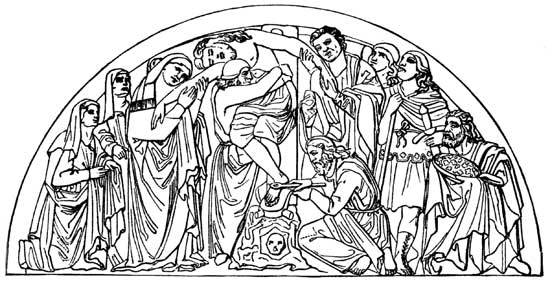 Fig. 79.—Relief by Nicola Pisano.
Fig. 79.—Relief by Nicola Pisano.During the twelve years following this time Nicola Pisano was chiefly employed as an architect, and it was not until 1260 that he established his fame as a sculptor; but when we consider the pulpit for the Baptistery of Pisa, which he now did, it is plain that he must have given much thought and study to sculpture since his first work at Lucca; and this last work has such qualities as indicate that he had studied the sculpture of classic days. The work upon this pulpit is a wonderful advance upon the sculpture of the period; and though there are marks of his inexperience in its arrangement, as a whole it is above criticism when the time to which it belonged and the circumstances of its sculpture are taken into account. (Fig. 80.)
Nicola went next to Bologna to make a sarcophagus to contain the remains of St. Dominick, who had died there in 1221. This burial-case was completed in 1267, and is very interesting as an illustration of the art of the thirteenth century. The next work of this sculptor was a pulpit for the Cathedral of Siena. When he undertook this work he agreed to live at Siena until it was completed, with the exception of short visits to Pisa—four in each year. He had assistants in this work, and it was completed in about a year and a half. Meantime he exerted a great influence upon the sculpture of Siena, which up to this time had[Pg 129] amounted to little more than good stone-cutting. Indeed, Nicola Pisano had an effect upon the art of all Italy: in the north at Padua, in the south at Naples, and in Central Italy at Pisa, Lucca, and Siena.
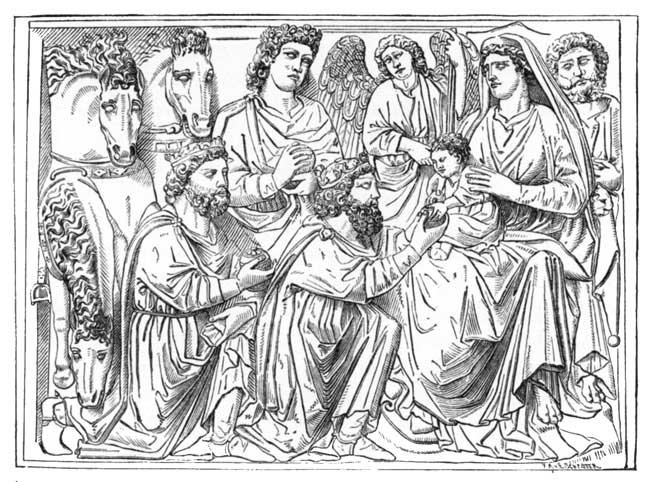 Fig. 80.—Relief from the Pulpit at Pisa.
Fig. 80.—Relief from the Pulpit at Pisa.In 1269 he was commissioned to build a convent and an abbey at La Scorgola, which are now in ruins. In 1274 Nicola commenced his last work, the Fountain of Perugia. He did not remain constantly in that city, but after making the plans he left his son Giovanni in charge of the work, while he returned to Pisa and occupied himself with making the figures for its decoration. This fountain was held in such esteem that laws were enacted for its preservation, and it was called the most valuable possession of the city, while some went so far as to say that it could not be surpassed in the world. Even now, after all it has suffered from time and weather, it commands our admiration.[Pg 130]
In 1278 Nicola died, after a life of great achievements. He left an untarnished name, too, for he had been loved and respected by all his associates, and as patron, friend, and servant had done all his duty. Mr. Perkins, in his "Tuscan Sculptors," says of him: "Inestimable were the services rendered to art by this great man. He gave the death-blow to Byzantinism and barbarism; established new architectural principles; founded a new school of sculpture in Italy, and opened men's eyes to the degraded state of art by showing them where to study and how to study; so that Cimabue, Guido da Siena, the Masuccios and the Cosmati all profited by his pervading and enduring influence. Never hurried by an ill-regulated imagination into extravagances, he was careful in selecting his objects of study and his methods of self-cultivation; an indefatigable worker, who spared neither time nor strength in obedience to the numerous calls made upon him from all parts of the peninsula; now in Pisa, then in Naples, Padua, Siena, Lucca, or Florence; here to design a church, there to model a bas-relief, erect a pulpit, a palace or a tower; by turns architect and sculptor, great in both, original in both, a reviver in both, laying deep and well the foundations of his edifices by hitherto unpractised methods, and sculpturing his bas-reliefs upon principles evolved from the study of antique models long unheeded. Ever respected and esteemed by the many persons of all classes with whom he came in contact, he was truly a great man—one to whom the world owes an eternal debt of gratitude, and who looms up in gigantic proportions through the mist of five centuries, holding the same relation to Italian art which Dante holds to Italian literature."
Fra Guglielmo d'Agnello (1238-1314?), also a Pisan, was a pupil of Nicola Pisano, and worked with him at Bologna. There is little to be said of his works after his master's death.[Pg 131]
Giovanni Pisano (about 1240-1320) was born at Pisa, and though a pupil of his father and a co-worker with him, he seems to have fallen under some other and a very different influence. In architecture he preferred the Gothic style, and in sculpture he was fond of all sorts of fantastic action and expression; his works were full of exaggeration. He was an architect as well as sculptor, and was a master in his own right when twenty years old, and in 1268 he went to Naples to design a church for the Franciscans; he was also the architect of the episcopal palace there.
After the death of his father the Pisans were anxious to retain Giovanni in their service; he first transformed an old church into a new one in the pointed style of architecture. It was named Santa Maria della Spina, because a rich merchant had presented one of the thorns from the crown of Christ to it. This was the first building in Italy of this style of architecture. Giovanni next built the Campo Santo of Pisa. Many shiploads of earth had been brought from Palestine to Pisa in order to make a burial-place in which Christians could be laid in the sacred earth. Giovanni Pisano inclosed the spot where this earth was laid with walls and arranged the interior of the inclosure in such a way that it could be extensively decorated with works of art. He made it the most beautiful Campo Santo in Italy. Many of the sculptures are by his own hand. (Fig. 81.)
This allegorical representation of Pisa was the first attempt at making large statues in Italy since the days of the Emperor Constantine. The city stands alone, and is a proud princess with a diadem, holding in her arms two infants to indicate her fruitfulness. Below her are four statues of the cardinal virtues, Temperance being a nude figure. It is a very strange work, and in some respects not attractive, but it shows the originality of the sculptor; the principal figure has much intensity of expression.
From this monument and his other works in Pisa, Gio[Pg 132]vanni became famous, and was called to Siena to build the front of the cathedral. The people of Siena held out every inducement to him to make his home there, by freeing him from taxes for life; but after three years he went to Perugia, where he erected a monument which has been destroyed. After this time he devoted himself entirely to sculpture, and executed a variety of works at Arezzo, Pistoja, Florence, Perugia, and Cortona. In 1312 he commenced the rebuilding of the cathedral at Prato.[Pg 133]
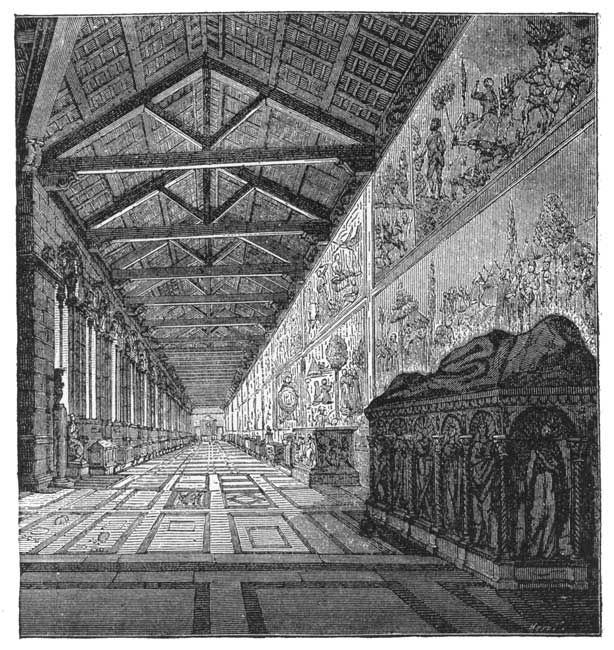 Fig. 81.—Campo Santo of Pisa.
Fig. 81.—Campo Santo of Pisa.We have not the space to speak of his works in detail. The Campo Santo has more of interest than the others, and is Romanesque in its character; and yet it is true that he employed Gothic forms far more than any other. Some authors credit Giovanni with having introduced an independent art into Italy; but let that be as it may, he had not the feeling for beauty, neither had he the repose which was such a charm in the works of his father. At the same time his works are full of life and dramatic action, and could never have been designed or executed by any man who had not an uncommon genius.
Arnolfo di Cambio (1232-1310) was also a pupil of Nicola Pisano, and though eight years older than Giovanni Pisano he did not become an independent master until after Giovanni had won much fame. There are some works in Rome which are attributed to Arnolfo, but as there are uncertainties about his being their author, it is not best for us to discuss them here. He erected at Orvieto, in the church of San Domenico, a monument to the Cardinal de Braye. It was a very elaborate work, and the statue of the Madonna, which is placed above that of the cardinal, is full of majestic spirit and dignified repose. This is the only well-authenticated sculptural work by Arnolfo, but this is one of the most finished monuments of the art of the Pisan school, and is quite sufficient to bring his name through the centuries with honor.
Andrea Pisano (1270-1345) is principally famous as a bronze-caster, and his chief work was the making of the gates to the Baptistery of Florence, which have since been replaced by those of Ghiberti. When these gates were finished, in 1339, the Signory went in procession to view them; this proves in what esteem they must have been held, for the Signory never left the Palazzo Vecchio in a body except on the most important occasions. After examining the gates they conferred the honor of citizenship[Pg 134] upon the sculptor. These gates told the story of John the Baptist, and the work is full of sentiment, beauty, and simplicity, while the design is pure, the draperies full of elegant grace, and the execution of the whole almost perfect.
Nino Pisano was the son of the latter. The time of his birth is not known; he died before 1361. His works are pleasing, and he especially excelled in drapery. They are not numerous, and are seen in the churches of Pisa.
But by far the most important pupil of Andrea Pisano, and, indeed, the most important Tuscan master of the end of the fourteenth century, was Andrea Arcagnuolo di Cione, commonly called Andrea Orcagna (1329-1376?). This artist was the son of Maestro Cione, a goldsmith of Florence. Orcagna was an architect, goldsmith, sculptor, painter, mosaist, and poet. Painting is the art by which he is best known and of which he executed the greatest number of interesting works. In this place we shall speak of his most important work as a sculptor, which was the tabernacle in the church of Or San Michele, in Florence, made to hold the picture of the Madonna painted by Ugolino da Siena. This tabernacle is of white marble in the Gothic style. It rises from the centre high up toward the roof of the church, and has sculptures in bas-relief, statuettes and busts, all illustrating the life of the Virgin from her birth to her death. It is also enriched with mosaics, intaglios, enamels, gilded glass, pietra dura, and all of these arranged in a whole which is quite unique in art. It may be regarded as a piece of architecture or as a sculptural work, and it is full of symbolism; and whatever view is taken of it, it commands admiration for the artist who conceived and executed so difficult a task.
During the later years of the fourteenth century there were many sculptors in Italy of whom we know very little more than their names. They did a vast amount of work in all parts of the country, much of which is still to be seen.[Pg 135] One of these, of whom few personal facts are known, exerted a large influence in Florence, where the fruits of his industry were almost marvellous. He was called Pietro di Giovanni and Pietro Tedesco, or "the German". The time and place of his birth are not known, but the records show that he worked on the Cathedral of Florence from 1386 to 1399. He worked in true German style; wherever scroll-work and simple ornamental designs were required he mingled a variety of leaves and flowers where the acanthus alone had before been used. He also made fantastic little human beings, dwarfs and grotesque beings of different sorts, and exhausted the animal world in his designs. Lions, bears, apes, dogs, lizards, crabs, birds and fish, bees, butterflies, and all manner of insects may be seen nestling among vines and branches, while angels play on pipes and violas. The whole effect of these works is cheerful and natural, and would be as suitable to decorate a music hall or a theatre as they are for a church.
The works of this master are too extreme in the realistic element to be taken as a fair example of the Italian sculpture of this time, but Niccolò of Arrezzo, the Massegne, and the Bon or Buoni family, and many others in different portions of the country contributed to put aside the stiff, formal manner of the past, and to bring in the more sympathetic and natural one of the fifteenth century. In truth, the last decades of the fourteenth century were a transition period, when art was bursting its bonds, and was preparing for the glorious works of the golden days of sculpture in Italy.[Pg 136]

There was no one great influence or circumstance which led up to the revival of art and letters which took place in the fifteenth century, and which is known under the general name of the Renaissance. Its causes were many, and may be traced in every department of the life of the Middle Ages—in religion, politics, learning, and the habits of the people. This is far too great a topic for us to enter on here, and we must keep to the one matter which we have in hand.
In Italy, heretofore, as we have shown, sculpture had been almost entirely separated from other arts, and stood by itself. Its works had been the smaller objects of which we have spoken; and though these were oftentimes splendid in their design and execution, they did not afford the sculptor the same broad field for his work as he has when his productions are combined with architecture. Now all this was changed. The French and German artists had brought out a style of architecture of their own, the Italians pursued another course, and went back to classic art for their teaching, and now every opportunity was given for sculpture to assume its utmost importance; and the art of ancient Greece was studied with all the enthusiasm of the Italian nature.
The masters of Florence, or, rather, of Tuscany, were of great importance in the beginning of the new movement,[Pg 137] and I shall speak first of them. Francesco Squarcione, who lived from 1396 to 1474, was a painter, and travelled into Greece to collect antique objects, and made many drawings from the monuments which he saw. He established a school in Padua, and his museum was of advantage to sculptors as well as to painters. Other Tuscan artists who were in love with classic art wandered among its remains in Rome and other parts of Italy, and brought back to their homes a greater knowledge of sculpture, as well as the drawings which they had made; and in this part of Italy the Renaissance early made itself a living, active power.
Among the very first of these sculptors was Jacopo della Quercia (1374-1438), who was so called from the little market town of Quercia, near Siena, in which he was born. His father was a goldsmith, and instructed his son in his art; but the boy loved sculpture, and studied it under one Luca di Giovanni. When but nineteen years old he made an equestrian statue of wood, and covered it with cloth, and painted it to represent marble in a manner which proved him to be an artist. About this time he left his home, and the next that we know of him was about ten years later, when his design for the gates of the Baptistery of Florence was pronounced to be next in merit to those of Ghiberti and Brunelleschi.
In 1408 Quercia went to Ferrara, where he did several works. While there he was called by the Signory of Siena to make a new fountain in the Piazza del Campo. This was a beautiful work, and even in this century, though much injured, its remaining sculptures prove that it must have been a wonder in its day. It has been restored after the original model by Quercia, who was often called Jacopo della Fonte on account of this work. He executed some sculptures in Lucca, but his masterpiece was the decoration of the great portal of the Basilica of San Petronio, at Bologna. (Fig. 82.)[Pg 138]
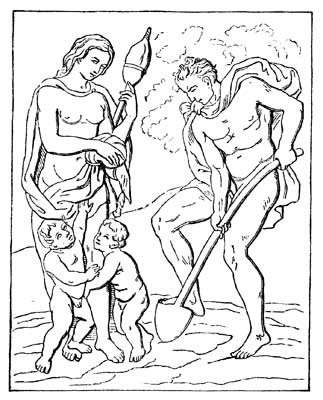 Fig. 82.—Relief by Jacopo della Quercia.
Fig. 82.—Relief by Jacopo della Quercia.The fifteen reliefs here represent the history of Adam and Eve, and other stories from the creation to the deluge. They show the full freedom and power of Quercia's style, and are among the most attractive of all the Tuscan sculptures of this period. Duringd the last years of his life this artist was employed as superintendent of the works upon the Cathedral of Siena, in which city he died.
We come now to speak of the famous Lorenzo Ghiberti (1378-1455), who was born in Florence, and was both a goldsmith and sculptor; and though his fame rests upon his bas-reliefs, yet the exquisite detail and careful finish in them came from his practice of the goldsmith's art. In 1398 a plague broke out in Florence, and Ghiberti fled to Rimini for safety. While there he painted a few pictures; but his name is so linked with the splendid gates which he made for the Baptistery of Florence that it is of those that one naturally thinks when his name is heard.
We have spoken of the gates which Andrea Pisano had made to this Baptistery long before; these were for the south side; and when, in 1400, the plague again visited Florence the people believed that the wrath of Heaven should be appeased by a thank-offering. Accordingly the[Pg 139] Guild of Wool-merchants promised to add gates on the north and east of the Baptistery of St. John the Baptist.
A time was appointed for the examination of designs, and many artists entered into the competition, and sent in their drawings and models. A great number of these represented the Sacrifice of Isaac. At length all the models were set aside but two, and these were made by Brunelleschi and Ghiberti; then the former declared that he thought his rival's design the best, thus showing a nobility of character which cannot be too much praised.
The commission was thus given to Ghiberti, who first executed the northern gates. He began them in 1403, and finished them twenty-one years later. They illustrate the life of Christ in twenty scenes; they have also the figures of the evangelists and the four Fathers of the Church in a beautiful framework of foliage, animals, and other ornamental figures, which divides and incloses the larger compositions. These gates are done in a manner much in advance of that of Pisano, and yet they retain some features of an earlier style which are not found in Ghiberti's later works. But from the first he showed original talent, as one may see by his model of the Sacrifice of Isaac, which is preserved in the Museum of the Bargello, beside that of Brunelleschi.
These northern gates are very beautiful, but those on the east are far more so; it is of these last that Michael Angelo declared, "They are worthy to be the gates of Paradise!" These are divided into ten compartments, representing: 1, Creation of Adam and Eve; 2, History of Cain and Abel; 3, Noah; 4, Abraham and Isaac; 5, Jacob and Esau; 6, History of Joseph; 7, Moses on Mount Sinai; 8, Joshua before Jericho; 9, David and Goliath; 10, Solomon and the Queen of Sheba (Fig. 83).
This sculptor showed great skill for one in his age, but to us there is some disappointment in them on account of[Pg 140] the crowded appearance of the figures. Familiarity with them, however, reveals their beauty, and we find that, in truth, the stories Ghiberti wished to tell are brought out with much distinctness. They will ever remain one of the great monuments of the sculpture of the Renaissance.
Ghiberti endeavored to introduce fine backgrounds to his reliefs, which gave him an opportunity to add figures illustrating other incidents than the principal one of the work. His sculptures show the influence of the Gothic style, the study of nature and that of the antique all combined; with these are united his own power of conception, his ability in design, and his wonderful delicacy of execution. These gates have been continually studied by the artists of his own and succeeding generations.[Pg 141]
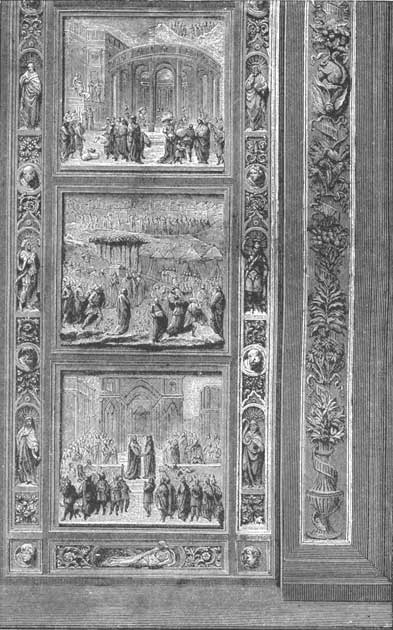 Fig. 83.—From the Eastern Gates.
Fig. 83.—From the Eastern Gates.The next work of importance by Ghiberti is the sarcophagus of St. Zenobius in the Cathedral of Florence. Other lesser sculptures are in other churches in Florence and in the Cathedral of Siena.
We come now to one of the most interesting sculptors of the fifteenth century. Donatello he was called, but his real name was Donato di Betto Bardi (1386-1468). He was born in Florence, and from his boyhood was a member of the family of the rich banker Ruberto Martelli, who was the firm friend of the sculptor for life, and when he died he provided in his will that the works by Donatello which he bequeathed to his family should never be pledged, sold, or given away, but kept as a perpetual inheritance for his heirs. Donatello was a realist, and followed nature with great exactness. This was not always productive of beauty in his works; indeed, some of them are very ugly, and a story which illustrates this is told of himself and Brunelleschi. Donatello had made a crucifix, carved from wood, for the Church of Santa Croce, and when it was finished he asked Brunelleschi's opinion of it. This latter artist was principally an architect; but as he had learned the gold[Pg 142]smith's trade, he executed some sculptures, and a close friendship existed between himself and Donatello. Relying on their love for each other, Brunelleschi frankly told Donatello that his crucifix was very ugly, and his figure of Christ like that of a day-laborer, whereas it should represent a person of the greatest possible beauty.
Donatello was very angry at this, and exclaimed, "It is easier to criticise than to execute; do you take a piece of wood and make a better crucifix!" Brunelleschi determined to do this, and when his work was finished he invited Donatello to sup with him. He placed the crucifix in a conspicuous place in his house, and then took Donatello with him to the market to buy their food. He gave the parcels to Donatello, and asked him to go before to the house, saying that he would soon follow. When Donatello entered and saw the crucifix he was so delighted at the sight that he forgot everything else, and dropped the eggs, cheese, and all on the floor, and stood gazing at the carving as motionless as if he were a statue himself. When Brunelleschi came he said, "What are we to do now? You have spoiled all the dinner!"
"I have had dinner enough for to-day," replied Donatello. "You may have a better appetite. To you, I confess, belongs the power of carving the figure of Christ; to me that of representing day-laborers."
This famous crucifix by Brunelleschi is now in the Gondi Chapel of the Church of Santa Maria Novella; that by Donatello is in the chapel of Saints Ludovico and Bartolommeo in the Church of Santa Croce.
The Annunciation cut from sandstone, which is in Santa Croce, is one of his earliest works, and is full of grace and nobleness (Fig. 84). He made some beautiful groups of dancing children, which are now in the Uffizi Gallery; but he considered his David, which is in the same gallery, as his masterpiece. He was so proud of it that he swore by[Pg 143] it, saying, "By the faith I have in my Zuccone!" This word means bald-head, and had come to be used as the usual name for the David.
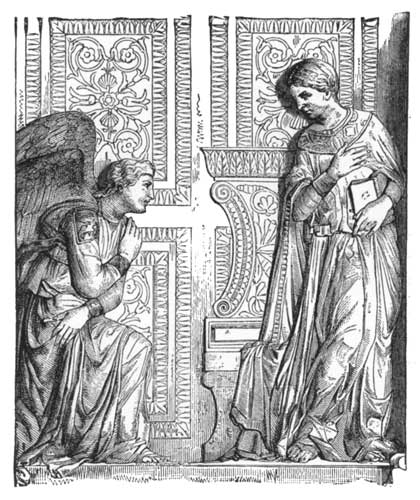 Fig. 84.—The Annunciation.
Fig. 84.—The Annunciation.But in spite of his liking for the David, it is generally thought that his St. George, on the exterior of the Church of Or San Michele, is far better. The German art-writer Grimm thus speaks of this work: "What a man is the St. George in the niche of the Church of Or San Michele! He stands there in complete armor, sturdily, with his legs somewhat striding apart, resting on both with equal weight, as if he meant to stand so that no power could move him from his post. Straight before him he holds up[Pg 144] his high shield; both hands touch its edge, partly for the sake of holding it, partly in order to rest on it; the eyes and brows are full of expectant boldness.... We approach this St. George, and the mere artistic interest is transformed suddenly into a more lively sympathy with the person of the master.... Who is it, we ask, who has placed such a man there, so ready for battle?" (Fig. 85.)
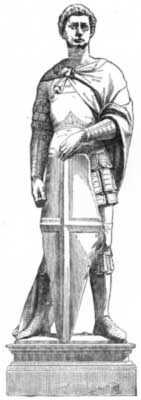 Fig. 85.—Statue of St. George.
Fig. 85.—Statue of St. George.Donatello's impetuosity led him into many rash acts. Among other instances of this it is related that a rich Genoese merchant gave an order for a portrait bust of himself in bronze; when it was finished the great Duke Cosimo de' Medici, who was a friend of Donatello, admired the work so much that he placed it on his balcony, so that all Florentines who passed by could see it. When the merchant was given the price of the bust he objected to it, and it was referred to Duke Cosimo for settlement. In the conversation the Genoese said that the bust could be made in a month, and[Pg 145] that he was willing to pay the artist a dollar a day for his time and labor.
When Donatello heard this he exclaimed, "I know how to destroy the result of the study of years in the twinkling of an eye!" and he threw the bust into the street below, where it was broken into fragments. Then the merchant was deeply mortified, and offered the sculptor double the price he had asked if he would repeat the work; but though Donatello sadly needed the money he would not do this, and persisted in his refusal, even when Cosimo de' Medici tried to persuade him to consent.
When Donatello was old Duke Cosimo gave him an allowance which would support himself and four workmen; but in spite of this Donatello wore such shabby clothes that Cosimo sent him a red surcoat, a mantle and hood. These Donatello returned, saying they were far too fine for him. When the sculptor at length became feeble and bedridden his benefactor had died, but Piero de' Medici, the son of Cosimo, was careful to keep him in comfort; and when he died his funeral was attended with much ceremony. He was buried near Duke Cosimo, in the Church of San Lorenzo.
Several of Donatello's works are in this church, and are a more suitable monument to his memory than any that could be made by other hands.
The works of Donatello are numerous, both in marble and bronze, and in both these substances he made statues and reliefs. We cannot speak in detail of all that he accomplished; but as he lived in an age when every advance in art was an event in history, we must not forget to say that he made the first equestrian statue which had been produced since the time of the Romans. This statue is in Padua, in front of the Church of San Antonio; it is of colossal size, and represents the Venetian General Gattamelata; and though it does not satisfy our conception as an[Pg 146] equestrian statue, it is worthy of some praise when we remember all the circumstances of its origin. It is not probable that Donatello had ever seen an antique equestrian statue, unless it might have been that of Marcus Aurelius, which was found in the Forum in 1187; no modern statues existed as examples for him; he was not familiar with the modelling of horses, and for every reason it was a bold thing for him to undertake such a work.
Donatello had more influence upon the art of his time than any other Tuscan sculptor, with the single exception of Michael Angelo. As a man he was honest, simple, and upright in all his dealings; as a friend he was loyal and faithful; as a Christian he was humble and charitable, and left behind him a name which has been handed down through more than four centuries with respect and honor.
Luca della Robbia (1400-1481) is another native of Florence, whose name is widely known. Like many others, he began life as a goldsmith, and in this way gained a mastery over detail and a finish of style that are remarkable in all his works. He turned his attention to sculpture early in life, and was so enthusiastic in his pursuit of this art that he worked night and day, minding neither cold nor hunger and fatigue; in the beginning he made numerous wax models, which have perished, and with all his industry we have no work of his before he was forty-five years old, except the reliefs of Music, Philosophy, Geometry, Grammar and Astronomy, Plato and Aristotle, Ptolemy and Euclid, and a man playing a lute, which are set into the side of the Campanile at Florence, and two scenes from the life of St. Peter, which are in the Uffizi.
In the same gallery are also the series of reliefs which Luca began when forty-five years old for the balustrade of an organ in the cathedral. These reliefs represent boys singing, dancing, and playing on musical instruments (Fig. 86). The attitudes are so graceful and so varied, and the[Pg 147] expressions on the faces are so many, that there is much to admire in a subject which in unskilful hands would be very monotonous.
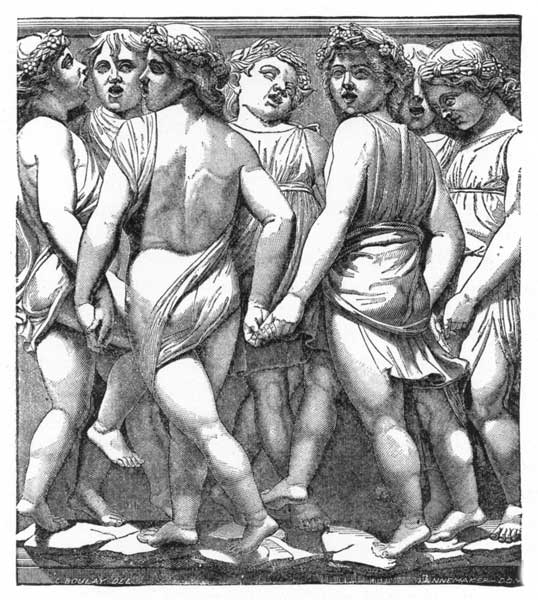 Fig. 86.—dancing Boys.
Fig. 86.—dancing Boys.No sculptures since the classic days represent child-life with such freshness and charming qualities, and these alone would have raised Luca to a high rank as a sculptor. In the Uffizi one is able to examine these works closely, and they gain by this nearness to the eye, which enables one to see the minuteness of his finish. There are various works of his in bronze and marble still to be seen in the churches[Pg 148] of Florence, but the special art to which he gave his attention was to the perfecting of enamel upon terra-cotta—on the making of what is known as the Robbia ware. In this he achieved a great success, and his bas-reliefs are very beautiful. At first he used but few colors, but later he increased their number, and was able to produce a combined effect of painting and relief that is very pleasing.
These works were used for altar-pieces, medallions on exteriors, fountains, wall decoration, and a great variety of purposes. Twelve medallions representing the months, which are in the South Kensington Museum, are said to have been made by Luca to decorate a writing cabinet for one of the Medici.
Luca worked with his nephew, Andrea, who had four sons; and when Luca died his secrets belonged to them, and made their fortunes. They were occupied eleven years in making a frieze to a hospital in Pistoja; it represented the Seven Acts of Mercy. One of them went to France and decorated the Château of Madrid for Francis I. Pope Leo X. employed another to pave the Loggie of the Vatican with Robbia tiles, and these wares, in one form and another, were used in numberless ways, both useful and decorative.
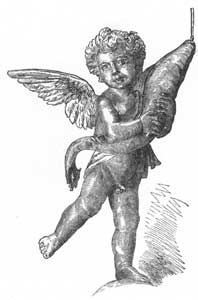 Fig. 87.—Boy with Dolphin.
Fig. 87.—Boy with Dolphin.The Robbia family was followed by other workers in glazed ware, and during about a century it was a prominent feature in art, and then was gradually given up.
The most noted pupil of Donatello was Andrea del Verocchio (1432-1488). He was born at Florence, and was early apprenticed to a goldsmith called Verocchio, from whom the sculptor took his surname. It is said that this name came from the fact that the elder Verocchio had remarkable exactness of sight.
Neither the metal works nor the paintings which Verocchio did remain, and after about 1466 he devoted himself entirely to sculpture. It is difficult to associate him with[Pg 149] Donatello; his execution is finished like most sculptors who were also metal-workers; his nude parts are true to nature, but not graceful or attractive, and his draperies are in small folds, which give a tumbled, crumpled effect rather than that of the easy, graceful falling of soft material.
His best works are a David in the Museum of the Bargello, Florence; a bronze Genius pressing a Dolphin to itself on a fountain in the court of the Palazzo Vecchio (Fig. 87); an equestrian statue of Colleoni before the Church of San Giovanni e Paolo, Venice (Fig. 88); and a group of St. Thomas examining the Wounds of Christ at the Church of Or San Michele, Florence. This last work is in his best and latest manner; the expression is powerful, but the drapery is still very faulty.
Although this equestrian statue is called by Verocchio's name, he did not live to see it completed; and though it was without doubt made from his design, still some credit for its execution is due to Alessandro Leopardo, who finished it. When Colleoni died he left all his large fortune to the Republic of Venice on condition that they should[Pg 150] erect an equestrian monument to him in the square of St. Mark. As it was forbidden by the laws of Venice to place such things in the Piazza of St. Mark, it was placed in its present position, before the Church of San Giovanni e Paolo, on the square of the School of St. Mark, and it was thought that this answered the requirements of the will.
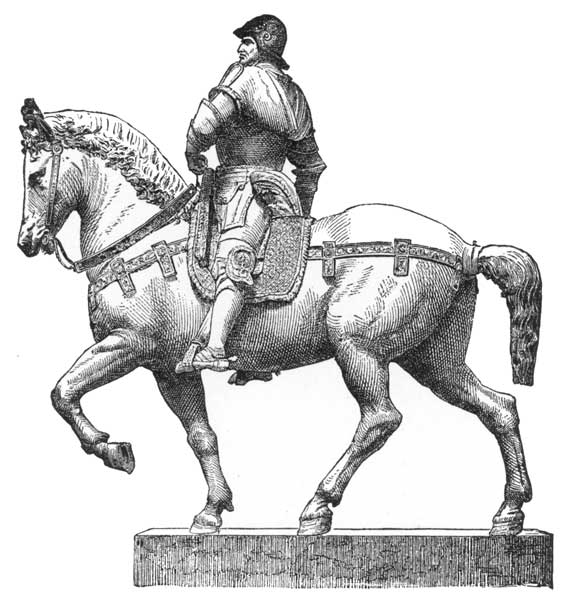 Fig. 88.—Statue of Colleoni.
Fig. 88.—Statue of Colleoni.When Verocchio had gone to Venice and had modelled the horse, he was told that the Signory intended to have the rider made by another sculptor. He felt this to be an insult, and broke off the head and legs of the horse, and left Venice for Florence. The Signory issued a decree forbidding him to set foot again on Venetian soil under pain of death. The sculptor replied that he should not take the[Pg 151] risk, as he well knew that the Signory could take off his head, and he could not put it on, while he could replace his horse's head with a better one. The Venetians knew that this was true, and repealed their decree, and doubling his pay, asked him to come to complete his work. Verocchio consented to do so, but had not been long in Venice when he died. Verocchio is said to have spent much time in drawing from the antique, and his works prove him to have been diligent and painstaking; these qualities made him the sculptor that he was; but we see no traces in his work of the heaven-born genius which makes the artist great, and so inspires himself that his works fill all beholders with an enthusiasm in a degree akin to his own; the works of such artists as Verocchio, who have only the excellencies which come from patient industry, interest us, but they cannot move our hearts.
It often happened in Italy that a number of artists belonged to the same family, as in the case of the Robbias. One such family had the name of Gambarelli, but were known in art as the Rossellini. There were five sculptors of this name, all brothers. Two of them had great ability, Bernardo and Antonio. Bernardo was most distinguished as an architect, and some very celebrated edifices were built from his designs; he also executed some excellent sculptures, among which are the fine monument of Lionardo Bruni in the Church of Santa Croce, and that of the Beata Villana in Santa Maria Novella, Florence. The first is one of the best monuments in Tuscany. In the Uffizi are a bust of St. John, a charming work, and a portrait bust of Battista Sforza.
Antonio Rossellino (1427-1490), called Proconsolo, from the quarter of Florence in which he was born, was by far the best sculptor of the family. He is called a pupil of Donatello, but his work very closely resembles that of Ghiberti. Among his best works are the monument to[Pg 152] Cardinal Portogallo, in the Church of San Miniato, near Florence; that of Mary of Aragon in Monte Oliveto at Naples; a relief of the Nativity in the same church, and a relief of the Adoring Madonna in the Uffizi Gallery. His characteristics were grace, delicacy of treatment, sweetness of expression, and all these combined with a noble dignity.
Other Tuscan sculptors of this period were Desiderio da Settignano, Mino da Fiesole (1400-1486), Andrea Ferrucci (1465-1526), and Benedetto da Majano (1442-1498), who was eminent as an architect as well as for his sculpture. His father was a stone-cutter, and two other sons in the family were artists. Benedetto began life as a worker in wooden mosaics, or intarsiatore, as it is called. He made two beautiful inlaid chests, and carried them to Hungary as a gift to King Matthias Corvinus, whose fame as a patron of art had reached his ears. But the young artist was doomed to a dreadful disappointment, for when he unpacked his chests in the presence of the king it was found that the sea-damp had spoiled them, and the mosaics had fallen apart. Benedetto then determined to work in more durable materials, and executed some sculptures in marble and terra-cotta while he remained in Hungary.
After his return to Florence, Benedetto worked as an architect, and the Strozzi Palace was built after his design. His masterpiece in sculpture was the monument to Filippo Strozzi, in the Strozzi Chapel in Santa Maria Novella, and it also merits mention among the best works of the fifteenth century. A pulpit in Santa Croce, by Benedetto, is also very fine, and his skill was shown here in his supporting the pulpit against a column and putting the staircase by which the pulpit is entered inside the column; thus it was concealed, and the building in no wise weakened, while the pulpit is far more beautiful than it would be were the staircase in sight.[Pg 153]
Benedetto was summoned to Naples by the Duke of Calabria, who gave him commissions which occupied him for two years. Few Tuscan sculptors have produced more pleasing works than Benedetto's; though not profound they are pleasing and unaffected, and in whatever frame of mind one may be, they do not disturb, but rather soothe and charm, as they could not do if they were false in sentiment or executed in an affected manner.
Matteo Civitali di Giovanni (1435-1501) was born in Lucca, but studied art in Florence. His statue of St. Sebastian in the Cathedral of Lucca was so much admired by the painter Perugino that he copied it in his picture of the Entombment.
Civitali's chief work in sculpture was the tomb of Pietro da Noceto in the same cathedral. In Genoa, in the Chapel of St. John the Baptist, he executed six statues and five bas-reliefs. A bas-relief of Faith by Civitali in the Uffizi Gallery is a fine work, full of earnestness and deep religious feeling.
Civitali was also an accomplished architect, and did much to improve the style of building in Lucca. The beautiful temple of the Volto Santo in the cathedral was designed by him.
This sculptor may be said to have had four different styles of work. The St. Sebastian was in his earliest manner, and is simply realistic; his second manner was the best; it is pure and dignified in conception, while deep feeling pervades all; the tomb of Noceto was in this second style; his third manner was more free and less pure, while the fourth, as seen in his work at Genoa, is full of extravagant exaggeration.
Next to the sculptors of the Tuscan or Florentine school of this period were those of Venice in importance and independence of manner. This school was much influenced by that of Tuscany because of the nearness of the two cities[Pg 154] and the constant communication between them, as well as by the fact that Tuscan sculptors were more or less employed in Venice. One of the earliest Venetian sculptors was Antonio Giovanni Bregno, called Antonio Rizzo or Riccio (about 1430-1498?). Although he was born in Verona, and there had the opportunity to study the Roman ruins which are the pride of the city, he is yet essentially an artist of Venice, since he spent most of his life there, and was even at the head of the workshop for the sculptors who worked upon the palace. One little episode in the life of this artist was an expedition to Scutari with the Venetian soldiers, who went to its defence against the Turks. Rizzo showed himself so brave in action, and was so severely wounded, that after his return to Venice the Senate gave him a pension which lasted through twenty years. Rizzo so won the confidence of the Venetians that he was appointed to important offices with large salaries, and it is sad to be forced to add that he proved to be a dishonest man, and when his accounts were examined he fled to Foligno, where he soon died. We will not speak of him as an architect; as a sculptor he is known by statues of Adam and Eve in niches opposite the Giant's Staircase in the Ducal Palace, and by sepulchral monuments in the Church of the Frari. While his works cannot be highly praised for beauty, they do show the style of the Renaissance distinctly.
Lombardo is the family name of three sculptors of this period in Venice. They were Pietro and his two sons, Tullio and Antonio, and the three together are spoken of as the Lombardi. Pietro, the father, was as much an architect as a sculptor, and the works of the father and son are so associated that it is difficult to speak of them separately. We know that Tullio was the superior artist of the three, but there are no works of theirs that command a detailed description here. The monument to the Doge Pietro[Pg 155] Mocenigo, in the Church of SS. Giovanni e Paolo, the angels of the font in San Martino, an altar-relief in the altar of San Giovanni Crisostomo, reliefs on the front of the Scuola di San Marco, and two reliefs in the Church of San Antonio at Padua, are the principal sculptures of the Lombardi.
Alessandro Leopardo, who flourished about 1490, was the most eminent bronze-caster of his time, and was distinguished for the happy manner in which he adapted classic ideas to his needs in his works.
Very little is known of the life of this sculptor, and that little is not to his credit. He lived in Venice, and had a studio in the Piazza del Cavallo, and in 1487 committed a forgery, for which he was banished from the city. But when Verocchio died, leaving the Colleoni statue unfinished, the Senate desired to have it completed by Leopardo, so they sent him a safe-conduct for six months, and he returned to Venice. As there is no account of his again leaving the city, it is supposed that he was allowed to remain as long as he chose. There has been much difference of opinion as to which artist—Verocchio or Leopardo—should be credited with the excellence of the Colleoni statue. The truth, as near as it can be told, seems to be that Verocchio designed and modelled it, that Leopardo completed and cast it, and made the lofty pedestal upon which it stands, and which, taken by itself, is a splendid work. It is of fine proportions, and has six Corinthian columns, in the capitals of which there are dolphins, while the frieze is composed of trophies and marine animals, all of which are symbols of the City on the Sea which erected the monument.
After the Colleoni statue was unveiled the Senate gave Leopardo an order for three standard bases of bronze to be placed in the Piazza of St. Mark's. He also made three splendid candelabra for the Venetian Academy. Leopardo[Pg 156] was also an architect. The time of his death is very uncertain, but a writer speaks of him in 1541 as "the new glory of our age, who shines like a star in the Venetian waters."
Although an immense amount of sculpture of this period remains in various parts of Italy, it is very difficult to trace the story of separate artists and to give a satisfactory account of those whose works are worthy of high praise. There is scarcely an Italian city of any size which has not some splendid remains of this morning of the Renaissance. In Ancona there are the portal of San Francesco and the front of Mercanzia, with which the name of Giorgio da Sebenico is associated. At Rimini the Church of San Francesco, with its wealth of plastic ornament, cannot be ascribed to any one artist or to any number with surety; it is in the style of Luca della Robbia and Donatello, but in the execution does not reach their standard. In Cesena, Padua, and Verona there are fifteenth-century sculptures, and in the Milanese territory the plastic art of this period is very interesting.
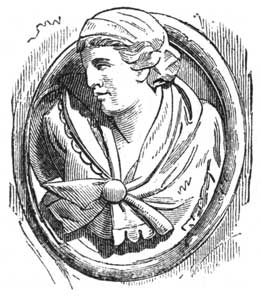 |
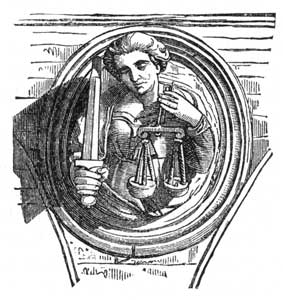 |
| Figs. 89, 90.—Terra-cottas from the Ospedale Grande.
Milan. | |
In Milan, in the Church of Santa Maria delle Grazie, in[Pg 157] the Ospedale Grande, and in the cathedral there is a wealth of sculpture to reward the student of this art who visits them; and in the Museum of the Breda there are many interesting works. The terra-cotta decoration of the Ospedale excels all other works of this sort in upper Italy, and the immense façade of this edifice is a marvel in its way (Figs. 89, 90). The differences between this hospital and the wonderful Milan Cathedral afford a remarkable contrast in works of the same period.
Giovanni Antonio Amadeo, or Omodeo (1447-1520), was born on a farm near the Certosa of Pavia. When but nineteen years old his name appears as one of those who were employed upon this splendid edifice, and the records of his payments show that his work was well considered, even then. Omodeo was undoubtedly the best sculptor of his time in all Lombardy, and his sculptures in the Colleoni Chapel at Bergamo would be sufficient to make any artist famous. The whole work may be called his, for he designed the building and the sculptures of the façade, which are in the richest style of the Renaissance; there are statuettes, colonettes, busts, medallions, and bas-reliefs, and wherever a flat surface exists it is divided into diamond-shaped slabs of colored marbles. The portal is very much ornamented: on each side of the rose window above this entrance there are busts of Cæsar and Augustus in contrast with numbers of angels' heads not far away. There are bas-reliefs representing children playing upon musical instruments, and the whole front of the chapel, with its numerous pilasters and colonettes, has been compared to a gigantic organ, by Mr. Perkins, in his "Italian Sculptors".
Of the interior decoration we can only say that it is much in Omodeo's style, though the monument to Colleoni, the founder of the chapel, is said to be the work of German sculptors, and to have been done after Omodeo left Bergamo.[Pg 158]
At Pavia, Omodeo succeeded Guiniforte as chief architect of the Certosa, and designed the façade, which was made by him and his successors. The bas-relief of the Deposition from the Cross, which is on the front of the high-altar here, is the work of Omodeo. At Cremona and at Isola Bella he executed some monuments, but at length, in 1490, he began his work on the Cathedral of Milan. Here a cupola was commenced after his model and under his direction; but when it was partly done doubts of its solidity were expressed, and Omodeo was commanded to leave it and design the north door to the cathedral. He also constructed the spiral staircase leading to the roof through an elegant Gothic turret, where the medallion portrait of Omodeo may be seen. It has since been proved that the cupola of Omodeo was solid enough, for it has sustained the spire which was put upon it in 1772; but he was tormented concerning it in many ways, and died without justification.
Omodeo stands at the head of northern Italian sculptors in his dexterous use of his chisel; his ease in composition and his skill in the management of drapery would have made him eminent; but the effect of all these good qualities was injured by his mannerism, and the fact that his standard of beauty was not a high one. This may be partly accounted for by the fact that in Lombardy an artist had no opportunity to study the remains of classic art, and this one circumstance very largely excuses the inferiority of the northern sculptors to those of Tuscany, whose taste had been much improved by close study of ancient plastic art.
There are many sculptors mentioned as having done some part of the work upon the Milan Cathedral, but very few are known, except by casual remark. Cristoforo Solari, called "Il Gobbo, or del Gobbo," was one of the most prominent, and yet we know almost nothing of his history until, in 1490, he was so disappointed when Omo[Pg 159]deo was made architect of the cathedral instead of himself that he went to Venice, and remained there during several years.
After a time Solari was appointed ducal sculptor to Ludovico Moro, and the monument which he erected to Beatrice d'Este was one of his principal works. When Ludovico lost his power Solari went to Rome, and remained until he was recalled to Milan to execute sculptures for the cathedral. He was very independent in his reply, and refused to go unless his conditions were complied with; one of these conditions was that he should not be under the direction of any one, but should select his marbles and his subjects to please himself. The statues he made are not as fine as we might expect them to be after this beginning; however, he was at length appointed head architect. Soon after this he was engaged in making a new model for a cupola, and then suddenly his name ceases to appear upon the registers.
The Cathedral of Como is another of those vast edifices which afforded opportunities for artists to make themselves famous. The principal part of the façade to this cathedral was ornamented by Tommaso and Jacopo Rodari. The first was at one time architect of the cathedral, and together they executed a large portion of the sculptures. Their best work was in the ornamental parts.
In the southern parts of Italy, both in the states of the Church and in Naples, there are many works of the fifteenth century which were executed by artists from Florence and other parts of Italy. Thus there is nothing new to be said concerning sculpture in Southern Italy during this period, since the works which are not by foreign artists are in the same style as theirs; for the native sculptors copied those from Central and Northern Italy, and no great progress or original manner can be found in these southern districts.[Pg 160]
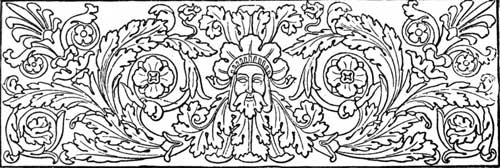
In Italy, as we have seen, the sculpture of the Renaissance was much advanced by the fact that in the beginning of its growth the architecture of the country was largely an imitation of Greek architecture; and as the same artist was frequently an architect, sculptor, and painter, edifices were designed with the purpose of placing the works of the sculptor in the most favorable positions.
In the countries north of Italy sculpture had no such aid or advantages. The Gothic style of architecture was a hindrance to the sculptor, whose works were combined with it. The Gothic construction afforded no broad, generous spaces for sculpture; all plastic work must be confined in limited spaces between columns and baldachins, or in arched niches, or between narrow flutings; and though something had been done to vary the upright stiffness of the statues of its earliest days, there was no freedom for the realistic and natural tendencies of the Renaissance art to develop in.
Another advantage on the side of Italian art was the fact that Italy was a land of grace and beauty; its people were more refined in manner, more elegant and picturesque in their costumes than were those of Northern Europe, and all the influences surrounding the Italian artist were far more favorable to a development of his artistic nature than were those of France or Germany. Then, too, the remains[Pg 161] of antique art which were within reach of the Italian sculptor were quite shut off from others. For all these and other reasons the sculpture of the north was more tardy in taking on the better spirit and form of the Renaissance, and as a whole it never became as pleasing to most people as was the sculpture of Italy.
In a former chapter we have spoken of the sculptor Claux Sluter and his work at Dijon in the fourteenth century; the desire which he showed to make his figures like the men they represented, and a general study of nature rather than of older works of sculpture, had much effect upon the sculpture of his time, and gradually became much exaggerated. German sculptors tried not only to make exact portraits of the faces and heads of their figures, but they gave the same attention to imitating every detail of costume and every personal peculiarity of the model from which they worked. This tended to weaken and narrow their own designs, and the whole effect of their work is fantastic and exaggerated—an effect quite opposed to the noble and harmonious treatment of the whole which the best Italian masters strove to attain.
The attempt to produce startling effects in German art made such subjects as the Passion of Christ, the Temptation of St. Anthony, and the Martyrdoms of the Saints to be constantly repeated, and many reliefs are overloaded with such details as may very properly be used in painting, and which belong to picturesque art, but which take away the dignity and calm grandeur which should make the spirit of sculpture. But there is one feature of German sculpture at this time which appeals to our sympathy—that is, the deep, earnest feeling which pervades it, and which constantly tried new methods of expression.
In Germany there were guilds or trade-associations, and the members of these guilds were allowed to work in the special branch only of sculpture which belonged to their[Pg 162] company, so that this art was divided by more fixed lines than in Italy, where, in truth, at the period of which we speak, the Florentine school was a supreme power, and its sculptors, as we have seen, worked in as many sorts of sculpture as pleased them.
The schools of Germany were far more independent of each other, and the entire organization of art in Germany was very different from that of Italy.
One of the most prominent effects of the architecture of Germany was to drive the sculptors to seek for such work as had no relation to architecture, and an important result from this was the great attention which they paid to wood-carving; indeed, this was the favorite pursuit of the German sculptors for many years. About the middle of the fifteenth century the importance of this art in Germany was far greater than those of bronze-casting or stone sculpture.
The principal works in wood-carving were the altars, which finally came to be colossal in size, and with their multitude of reliefs, statuettes, and ornaments were marvellous monuments to the industry and skill of the wood-carvers. The reliefs in these works are usually arranged on landscape backgrounds, and so much resemble pictures in many ways that the colors and gilding which were freely used on them do not seem out of place, and it appears to be quite natural that wood-carvers should often have been painters also.
The Swabian school, the principal seat of which was Ulm, was the earliest to adopt the new, realistic style. There are works by Swabian artists which show this tendency as early as 1431. Jörg Syrlin, who flourished during the last half of the fifteenth century, was an eminent wood-carver, and as he did not color his works he can be better judged as a sculptor than he could be if the effect of the whole depended partly upon painting. The choir-stalls in the Cathedral of Ulm and the fountain in the market-[Pg 163]place, called "Fischkasten," are his most important works; but a singing-desk, now in the museum, and other lesser pieces are also excellent examples of his style. The choir-stalls have an immense number of figures and a mass of ornament, which made them far richer than any such work of an earlier date, and none that have since been made have equalled them. It is almost incredible that they were completed in four years, and yet there are no marks of haste upon the work. The figures are dignified and graceful, the faces delicate and expressive, the hands well formed, and a beauty of design and execution marks the whole. The lower figures, which come nearest the eye, are finer than those which are higher up, so that a unity of effect is preserved throughout the whole. He sometimes took occasion to give touches of humor in his works, and in these stalls he introduced his own portrait and that of his wife.
The "Fischkasten" is sculptured in stone, and has three knights upon it which appear to be boldly advancing, as if about to step off and walk away. Other works by this master are less important, and it is doubtful if all that are called by his name are really his own. Jörg Syrlin, the younger, trained by his father, adopted his style, and became an excellent artist.
We have not space to speak of the Swabian sculptures in detail. Fine works exist in Tiefenbronn, Rothenburg, Blaubeuren, Herrenberg, Gmünd, Ravensburg, and many other places.
The influence of the Swabian school was very wide; it can be traced in many parts of Germany, in Hungary and Transylvania, and even in Switzerland, Austria, and Bavaria. Swabian artists were often summoned to adjacent provinces, and thus did much work away from their homes. The reliefs upon the door of the Cathedral of Constance were executed by Simon Hayder, a Swabian, in 1470. The altar[Pg 164] of the cathedral at Chur was the work of Jacob Rösch, another Swabian master, who thus labored on the very boundary of Italy. The school at Augsburg was the second Swabian school in importance, and much influence went out from that centre, though its sculptures were not as fine as those of Ulm.
In some cases fine old sculptures still exist in the churches and other places for which they were intended. Again we find them either whole, or in parts, in museums to which they have been removed when they were no longer required for the uses for which they were made, or when they were replaced by more modern works. So few facts are known concerning them that it is almost impossible to do more than repeat descriptions of the subjects they represent; and this is neither profitable nor entertaining in a book of this kind; therefore I shall now speak only of such artists as have left some record behind them, and of works whose authorship can be given.
Veit Stoss, who flourished about the middle of the fifteenth century, was an eminent wood-carver. Very little is known about him. His name is sometimes said to be Wit Stwosz, and Cracow and Nuremberg both claim to have been his birthplace. But it is now believed that he was born in Nuremberg, as it is known that in 1477 he gave up his citizenship there and went to Cracow, and in 1496 he paid a small sum to be again made a citizen of Nuremberg.
We also know that his reputation as a man was not good. In a Nuremberg decree he is called a "reckless and graceless citizen, who has caused much uneasiness to the honorable council and the whole town." He was convicted of crimes for which he should have suffered death, but the sentence was changed, and he was branded: both cheeks were pierced with a hot iron. After this he broke the oath he had taken to the city, and joined her enemies in plotting[Pg 165] against her; he was subsequently imprisoned, and at his death, in 1533, he was very old and perfectly blind.
It seems almost like a contradiction to say that this master was one of the most tender in feeling of all the wood-carvers of his time. He was especially successful in representing the purity of the Madonna and of youthful saints. His principal works are in the churches of Cracow and Nuremberg. In the Frauenkirche at Cracow the high-altar, a part of the stalls in the choir, and some other sculptures are his. In Nuremberg his best works are a bas-relief of the Crowning of the Virgin, which is preserved in the Burgkapelle; the great Madonna statue, which was placed in the Frauenkirche in 1504; and the colossal Angel's Salutation, which is suspended in the choir of the Church of St. Laurence. This last is an unusual and important work. The angel appears as if flying, and the drapery is much inflated; the Virgin is queenly and majestic, yet graceful; all around are medallions in which are represented the Seven Sorrows of the Virgin. The style of these reliefs is charming if we except the drapery; that has the faults of the time, and is bad in style; but the female heads are all that we could ask; the whole design is distinct, and few reliefs could surpass these in simple beauty and genuine artistic feeling.
Another remarkable work of his is a panel of roses, now in the Burgkapelle. The panel is seven feet high by five wide; more than half of this is covered by a wreath of roses; there are besides four rows of small half-length figures arranged round a cross of St. Anthony, a representation of the Last Judgment, scenes in the history of man from the creation to the death of the Virgin, and many other saints and like subjects in bits of reliefs, which fill up all spare spaces. The style is very distinct, and the draperies better in this work than in others from his hand.
There are other works in Nuremberg and elsewhere[Pg 166] which are attributed to Veit Stoss, but these that are known to be his are quite enough to establish his fame as a gifted artist and a remarkable sculptor for his time.
Though Stoss is among the early masters of Nuremberg, it is yet true that others had been at work while he was in Cracow, and the way had been prepared for him and his work when he returned to his native city in 1496. Among the most active artists in Nuremberg was Michael Wohlgemuth (1434-1519), who is generally considered as a painter only; but we know that he made contracts for entire works in which sculpture and painting are combined, and must have had the oversight of the whole; and in this view it is proper to mention this master's name. The altars at Haller Cross Chapel, Nuremberg, one at Zwickau, another at Schwabach, and that of the Heilsbronn Monastery, near Nuremberg, are all ascribed to Wohlgemuth.
Albrecht Dürer (1471-1528), who was one of the great masters of the world, was an architect, painter, and sculptor. He was a pupil of Michael Wohlgemuth, and sculpture was less practised by him than other arts; yet the few works of his which remain are much valued.
Dürer probably executed his carvings about 1510-1520. In the British Museum there is a relief of the Birth of St. John the Baptist, which was purchased in the Netherlands more than eighty years since for $2500. It is cut in a block of cream-colored stone, seven and one half by five and one half inches in size, and is a wonderful work. The companion piece, which represents the same saint Preaching in the Wilderness, is in the Brunswick Museum, where there is also an "Ecce Homo" carved in wood.
Dürer executed many little carvings in stone, ivory, and boxwood, and the existing ones are seen in various collections in Germany. It is quite probable that others are in private hands.
There are in Nuremberg many most excellent wood-[Pg 167]carvings by unknown masters; one who cares for this art is well repaid for a visit to this old city, and, indeed, this is true of other old German towns. Bamberg, Marburg, Frankfort-on-the-Main, Dortmund, Halle, and many other towns have riches in this kind of art.
The stone sculpture of Germany in the fifteenth century was of less importance than the wood-carving until toward the close of the period. The exteriors of the churches and other edifices erected at this time had but little sculptural ornament, and that consisted principally of traceries and figures in geometric designs. Some small detached works, such as fonts, pulpits, or fountains, were made in stone, but the chief use of stone sculpture was for monuments to the dead.
Adam Krafft (about 1430-1507), of whose early history almost nothing is known, is a very important master of this time, and his principal works add another charm to the city of Nuremberg. A remarkable series of works by Krafft are the Seven Stages, or seven bas-reliefs placed on the way to the Johannis Cemetery, the designs representing the seven falls of Christ on his way to Golgotha.
These reliefs are much crowded, and the only part that is at all idealized is the figure of Christ; that is noble and calm in effect, and the drapery is simple and dignified. The other figures are coarse and dressed like the Nurembergers of the time in which Krafft lived.
In the churches of St. Sebald and St. Laurence and in the Frauenkirche there are other splendid works of Krafft, and in some dwelling-houses of Nuremberg there are sculptures of his. A Madonna on the houses, 1306, in the Hirschelgasse, is one of the finest, perhaps the very best in all Germany. We do not know whether this was by Krafft or not, but it has a purity and nobleness that scarcely any other German sculptor attained.
That Krafft had a sense of humor is shown by a bas-[Pg 168]relief above the entrance to the Public Scales. The weigher stands observing the beam, and beneath it is written, "To thyself as to others." Another man adds a weight to one scale, and the man who is to be taxed puts his hand into his money-bag very reluctantly.
Perhaps his most artistic work was the tabernacle in the Church of St. Laurence. It is sixty-four feet high; the lower part is supported by the kneeling figures of Krafft and two of his associates. Above this rises a slender Gothic pyramid ornamented with bas-reliefs and statuettes. He was employed upon this tabernacle from 1496 to 1500. It is believed that a "Burial of Christ," in the chapel of the Johannis Cemetery, was his latest work, and executed in 1507, the year in which he died, in the hospital of Schwabach. Krafft led a most industrious life, and was so skilful a workman that he could work with his left hand as readily as with his right.
Tilman Riemenschneider was an important sculptor, born at Osterode, in the Hartz Mountains, probably about 1460. In 1483 he went to Würzburg, and was elected to one honorable office after another, until, in 1520, he was head burgomaster. After the Peasants' War, in 1525, he was deprived of his office; he lived but six years after this, and kept himself in close retirement, not even practising his art.
His sculptures are mostly in stone, and are quite numerous in Würzburg and its vicinity. His monument to the Knight Eberhard von Grumbach, in the church at Rimpar, was probably his earliest important work. In it he has contrived to express strength and bravery of character in spite of the stiff costume, every detail of which is worked out (Fig. 91).
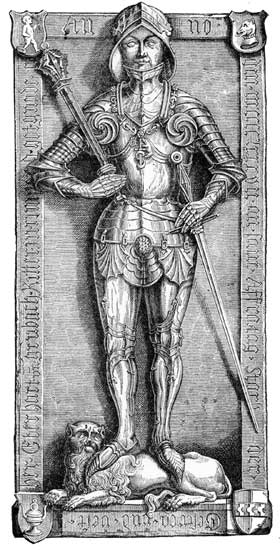 Fig. 91.—Count Eberhard von Grumbach.
Fig. 91.—Count Eberhard von Grumbach.In 1495 Riemenschneider received the important commission to erect in Bamberg Cathedral a splendid monument to the Emperor Heinrich II. and his wife Kunigunde.[Pg 170] This occupied him until 1513, and is a splendid example of his skill. The figures of the two royal personages lie upon a large sarcophagus; the statues are more than life-size, and are dressed in the fantastic costume of the fifteenth century. Upon the sides of the sarcophagus are five reliefs, representing as many scenes from the lives of the emperor and empress. The monuments and religious subjects executed by this sculptor are very numerous. In the church at Maidbrunn there is a relief representing the "Lamentation over the Dead Body of Christ," which is probably his latest work. It is cut from sandstone, and the figure of Nicodemus is believed to be the sculptor's own portrait.
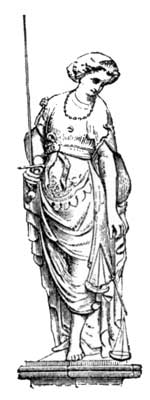 |
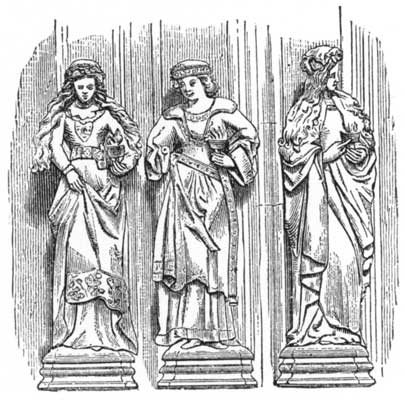 |
| Fig. 92.—Justice. Fig. 93.—The Three Wise Virgins. | |
We give here four figures from the portal of the cathedral at Berne, in Switzerland. The really splendid sculptures were the work of Nicolaus Künz, and from their style seem to belong to about 1520. They show the influence of such artists as the painters Nicolaus Manuel (1484-1531) and Hans Holbein (about 1459-1524). The statues of the Wise and Foolish Virgins are fine, and that of Justice, whose[Pg 171] pose is full of grace, and whose almost transparent garment is an exquisite work, affords an excellent illustration of the most pleasing sculpture of this period (Figs. 92, 93).
Another art, which had its headquarters at Nuremberg in the fifteenth century, is bronze-casting, and its chief master was the famous Peter Vischer, who was the son of another brasier, Hermann Vischer. The date of Peter Vischer's birth is given as 1460, and he was admitted to be a master in his art in 1489. Five years later than this he was summoned to Heidelberg together with a sculptor, Simon Lamberger, to aid the Elector Philip with advice and skill. Nothing is known of any work which Vischer did there.
Vischer's foundry at Nuremberg enjoyed a great fame, and orders were sent to it from far and near. No doubt a great many monuments were cast here which were not designed by Vischer at all. His works were numerous, but I shall only describe his masterpiece, which was the shrine or tomb of St. Sebald, and occupied Peter Vischer from 1508 to 1519, he being assisted by his five sons. The son Peter was admitted as a master in the thimble trade in 1527. Hans was called "the caster," and seems to have superintended the carving of models; Hermann went to Italy and brought home designs and models; and Jacob and Paul seem to have had no special departments. Between 1495 and 1508 so little was recorded of Peter Vischer that it leads to the belief that these years must have been given to study and to the improvement which the tomb of St. Sebald shows over the work of the monument to Archbishop Ernst, in the Magdeburg Cathedral, which was done in 1495.
The bones of St. Sebald had been inclosed in a sarcophagus of the Middle Ages, and the work required of Vischer was a fitting tomb for such precious and honored relics, for St. Sebald is the special patron saint of Nuremberg, and dwelt in a cell near that city. His legend relates[Pg 172] that he was the son of a Danish king, who came to Germany as a missionary and settled at Nuremberg, where he did many miraculous works of charity. On one occasion, during very cold weather, he is said to have found a family nearly frozen and without fuel; he commanded them to bring the icicles hanging from the roof and make a fire of[Pg 173] them. They obeyed, and were thus warmed. Many such wonders are told of him, and Vischer in his statue makes him to appear as a pilgrim, with shell in hat, staff, rosary and wallet, while in his hand he holds a model of a church intended to represent that in which the tomb is erected. This Church of St. Sebald is now used for the Lutheran service, and the shrine still stands in the centre of the choir. (Fig. 94.)
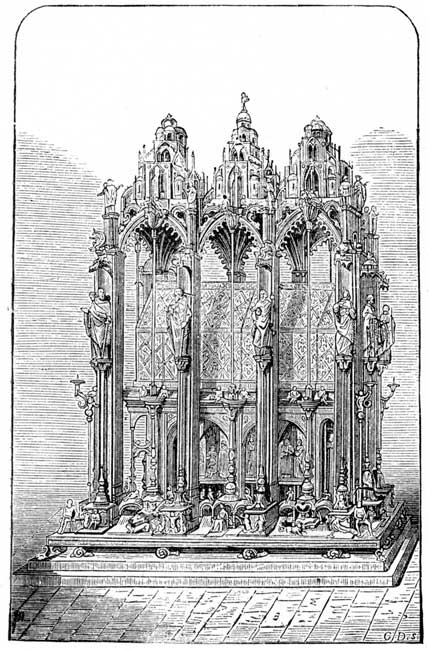 Fig. 94.—Tomb of St. Sebald.
Fig. 94.—Tomb of St. Sebald.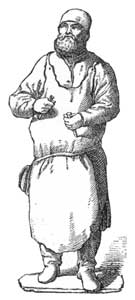 Fig. 95.—Peter Vischer's Statue.
Fig. 95.—Peter Vischer's Statue.
The architecture of this remarkable work is of the richest style of Gothic, and the whole of it is in bronze, except that the oaken sarcophagus is encased in silver plates. This rests beneath a fret-work canopy supported on slender pillars. There is an abundance of ornament everywhere, but the close examination of its detail shows beauty and fitness in every part. For example, if we compare the statue of the saint, of which we have spoken, which stands at the end of the shrine most exposed, with the statue of Vischer himself, which is at the opposite end, we shall see how the saint, with his symbols and his flowing drapery, is an ideal work, and seems to be advancing with authority and the air which befits the son of a king, while Vischer, with his round cap, leather apron, and German face, is simply the representation of a worker bent upon doing his best (Fig. 95).
The sarcophagus rests upon a base on which are four reliefs of scenes from the life of the saint, all in the purest manner of the time. One of these represents the burning of the icicles recounted above (Fig. 96).
This base and sarcophagus and the fret-work above it form the centre of the tomb. Then outside of this are[Pg 174] eight pillars supporting a baldachin, or canopy, in the richly ornamented Romanesque style, and the combinations of the Gothic and the decorative architecture are so skilfully made as not to offend our taste. But it is generally acknowledged that the chief beauty of this work is the series of the figures of the apostles, which are upon the pillars. They are slender in proportion, gracefully draped, and bear their distinctive symbols. They are perfectly free from the realism of the earlier works of Vischer, and have more of the purity and nobleness of the works of Ghiberti than are seen in the statues of any other German artist of this age (Figs. 97, 98).
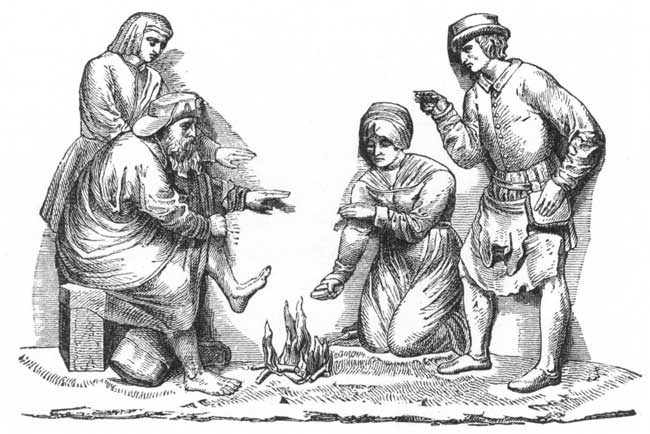 Fig. 96.—St. Sebald and the Burning Icicles.
Fig. 96.—St. Sebald and the Burning Icicles.Above the apostles are figures of prophets and other Biblical personages; Perseus and Hercules are also represented, and other statues typify Strength, Justice, Prudence, and Moderation. The figure of the Infant Christ is upon the centre of the highest, or middle dome. Between the pillars at their bases stand graceful candelabra, and the base itself rests upon snails. Besides all these principal figures there are almost numberless others and many orna[Pg 175]mental designs. There are harpies, sirens, satyrs, fawns, and all sorts of fantastic creatures. The whole work is full of the deep feeling of the north and the beauty and richness of the south, and is a most remarkable production.
We are told that Vischer was but poorly paid for this labor, with all its thought and skill. He inscribed upon it these words: "... He completed it for the praise of God Almighty alone, and for the honor of St. Sebald, Prince of Heaven, by the aid of pious persons, paid by their voluntary contributions." There is a satisfaction in remembering that Vischer lived ten years after this tomb was completed, and must have heard many praises of his work.
The later works of Vischer were a few reliefs and two important monuments at Aschaffenburg and Wittenberg. His sons Hans and Hermann executed a few monuments, which are done in the manner of their father, but do not equal him in design or finish. There are numerous works which must be regarded as productions of Vischer's studio and foundry of which we cannot give clear accounts, not knowing whether they were the earlier works of the father, or were executed by the sons or other pupils, of which he had many.
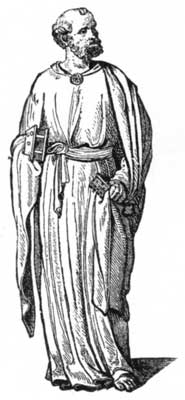 |
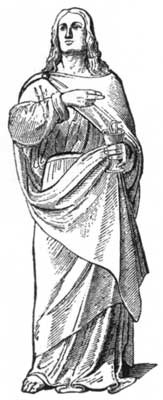 |
| Fig. 97.—Peter. By Peter Vischer. |
Fig. 98.—John. By Peter Vischer. |
Pankraz Labenwolf was one of Vischer's pupils, and completed the splendid lattice-work over the Town-hall which the master left unfinished; Labenwolf added some ornaments and coats-of-arms to it. In 1550 he cast the[Pg 176] fountain in the court-yard of the same building, which is a graceful and creditable work; but another fountain in the vegetable market, behind the Frauenkirche, is truly original; the water flows from the mouths of two geese held under the arms of a peasant; the whole effect is droll and unique (Fig. 99).
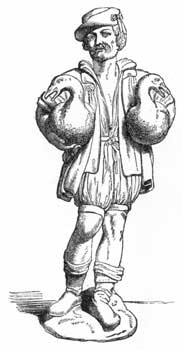 Fig. 99.—Man and Geese.
Fig. 99.—Man and Geese.You will remember how, about 1390, Claux Sluter, by his works in Dijon, had a great influence upon French sculpture. A century and more later this art in France was largely under the influence of Italian masters, who had been called into France by Francis I. and other patrons of art. Splendid works of sculpture were also imported from Italy, and the effect of the Italian Renaissance, which was so plainly seen upon the painting of France, was also at work upon its sculpture.
Where the sculptures were a part of an architectural decoration, as in the case of the choir screen in the cathedral at Amiens, and other like works, the change was not as complete as in cases where the work was one of independent sculpture, as in monuments and statues to commemorate the dead, or in portrait sculpture.
The wealth and power of the nobility of France at this period enabled them to gratify their desire to leave fine monuments of themselves, in order to keep their names in memory in future centuries. In these the Italian manner[Pg 177] was adopted, and the works when completed were far more splendid and elegant than were the corresponding works in Germany. But they have a grave fault, which makes them much less interesting than are the German sculptures: they are more conventional, less expressive, and far less artistic in spirit. They impress one as if the soft, luxurious court atmosphere had passed over them, and taking away their strong points, had left them only a general air of being well-bred and well-kept persons, of little importance to the real life of the world.
In the Louvre, in the Museum of Modern Sculpture, all this change can be traced, and the traveller in France may see such monuments as we refer to in all the cathedrals and most of the churches all over the country. Many of them cannot be traced to any one master. A fine specimen is the Amboise Monument in Rouen Cathedral, which is said to have been the work of one Roulland de Roux and his assistants.
Jean Juste of Tours was one of the best French artists of his day. In the Cathedral of Tours is a monument to two young children of Charles VIII., which proves him to have had much delicacy and tenderness of execution. The sarcophagus is covered with graceful designs, and on the lid lie the two babies, for the eldest was but three years old. The whole work is exquisite, and gives one a feeling of satisfaction.
About 1530 Juste erected the splendid monument to Louis XII. and Anne of Brittany in the Church of St. Denis. While the general form of the monument is much like that of the Visconti in the Certosa at Pavia, the figures of the dead couple are quite different from the Italian manner. Below on a bier the two nude bodies are stretched in all the realism possible, and the heads are noble and touching in expression. Above, on the upper part of the monument, where in Italy the patron saint or[Pg 178] some other figure usually is placed, the king and queen again appear; they are kneeling, with full drapery about them, while the faces are characteristic and very expressive. This monument, taken all in all, is in the perfection of the French art of the time. Another work by Juste now in the Louvre is the monument to Louis de Poncher, one of the ministers of Francis I., and his wife, Roberta. These statues are in alabaster, and were formerly in the Church of St. Germain l'Auxerrois, which was built by Poncher.
Pierre Bontemps must have been a famous sculptor, as he was chosen to erect the monument to Francis I., his wife Claude and their three children. This is also at St. Denis, and is even more grand than that to Louis XII. On the upper platform the five figures are kneeling; they are noble and simple, with an air of great repose. These examples serve to give an idea of the religious sculpture of the time.
Secular subjects were unusual. A house in Bourges is decorated with the figures of the master and mistress above the entrance, as if they would speak a welcome, while reliefs of industrial scenes, such as might be seen outside and inside of the house, are placed in various positions over the building and in the court-yard. Something of a like sort is upon the Hotel Bourgtheroulde at Rouen, where the friezes show scenes between Francis I. and Henry VIII. Biblical scenes are also distributed over the building.
Bruges is almost the only city of the Netherlands that has any sculptures of this period of which one would speak. Just at this time the art of that country was painting preeminently, and the Van Eycks and their followers had done such things as held the attention of all to the neglect of other arts. At Bruges in the cathedral, the Church of St. Jacques, and the Liebfrauenkirche there are some fine monuments, and the Palais de Justice has a carved chim[Pg 179]ney-piece which is magnificent, and a work of the highest rank.
In England sculpture was of less account even than in the Netherlands. One circumstance is worthy of notice. Pietro Torrigiano, after quarrelling with Michael Angelo and breaking his nose, fled to England, and his monument of Henry VII. and his queen in Westminster Abbey, erected in 1519, marks the introduction of the style of the Italian Renaissance into England. The structure is of black marble; the statues of the king and queen are in gilt bronze, and are grandly noble in design and finished in execution. The smaller figures and all the details of the monument are fine. The master received £1000 for this work. Torrigiano executed other works, and entered into an agreement to make a monument to Henry VIII. and Catherine of Aragon, but for some reason he went to Spain in 1519 and never returned, as he was destroyed by the Inquisition three years later.
It is probable that Torrigiano may have been led to Spain by hearing of the revival of art which was taking place there. Flemish and Italian artists went there, and the influence of their styles was felt by the native masters. The result was that they brought forth a manner of their own, combining certain features of northern and of southern art, and used to express the thoughts of the Spaniards themselves. The carved altars of Seville, Toledo, and Burgos show how splendid this art was; and though we cannot trace the lives and works of Spanish sculptors as we should like to do, we can be sure that there were men among them equal to any demand that could be made upon decorative sculptors.
This is proved by the portals and fronts of the churches, by the highly ornamented chapels, the wall niches and choir screens of the interiors, while the monuments are also equal to those of other nations. That of Ferdinand and[Pg 180] Isabella in the Church of the Guardian Angel, at Granada, is noble and magnificent. It is believed to have been erected before the death of Ferdinand in 1516, and was probably the work of an Italian sculptor. This monument has a large marble sarcophagus, with a structure above it in the Renaissance style. At the corners of the sarcophagus there are griffins of excellent workmanship, and on the sides reliefs and statuettes of the Four Fathers of the Church; on the lid repose the figures of the royal pair, executed in a grand and dignified simplicity.[Pg 181]

By the beginning of the sixteenth century sculpture occupied a different place with relation to architecture from that which it had held in the previous centuries which we have just considered. The architecture of Italy became much more plain, and its union with sculpture in any large degree was rare.
Painting, too, had now an effect to lessen the sphere of sculpture. This art was always preferred by the Christians, as has been shown before, and now, when it had reached most satisfactory heights, it was used in many places where sculpture had before been placed. One important example of this is seen in the decoration of altars; where bas-reliefs had been used paintings were now preferred, and the end of all was that sculpture was limited to monuments and to separate pieces—reliefs or single statues or groups of figures.
In some ways this separation of the arts was a benefit to all. Under the old rule sculptors had often been forced to sacrifice their design to the needs of the architecture their work adorned. At other times they were compelled to put aside their own feeling and their artistic ideas as to how a subject should be treated, and suit themselves to such forms as were approved by the particular priest or bishop whose church they decorated. Now, when left to itself,[Pg 182] sculpture became more individual in its expression, and far more free and interesting in itself. In the beginning of the sixteenth century the works of Italian sculpture were splendid in the extreme. It was delicate and beautiful; the drapery was made to show the figure and its natural motion, while it added an exquisite grace to the whole; many works of this period were fine in conception, good in their arrangement, and executed in a noble, spirited manner. Some critics believe that during the first four decades of this era Italian sculpture equalled the antique art of the Romans. Others make 1520, or the time of Raphael, the limit to the best epoch of this art; but it is scarcely possible thus to fix an exact bound; the important point is that this excellence was reached, and the regret follows that it could not endure for a longer period.
A far greater variety of subjects was represented in this age of sculpture than before. Formerly the rule was the production of religious effects. Scenes from the life of Christ and his disciples, others from those of the saints, or the illustration of scriptural stories, with the portrait tomb-sculpture, had been the sculptor's work. Now all the stories of mythology were studied as diligently as they had been in classic days, and artists studied to clothe the pagan personages with new forms; and in all this effort much appeared that was original. It is easy to see that such sculpture from the hand of a Christian artist must lack the important element of pure sincerity. An artist who believed in Jesus Christ could not conceive a statue of Jupiter, with all the glorious attributes, that an ancient Greek would have given to his god of gods. In this view the sculpture of classic subjects of this sixteenth century may be said to have been two-sided—the work illustrated a religion in which the artist pleased his imagination, but for which he had no reverence or love. But in spite of all it was a golden age, and many of its works are a "joy forever."[Pg 183]
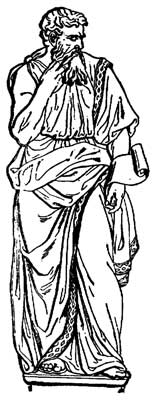 |
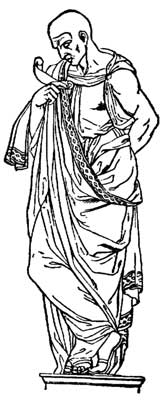 |
| Fig. 100. Pharisee. By Rustici. |
Fig. 101. Levite. By Rustici. |
Although the first public work which Leonardo Da Vinci did at Milan was to model an equestrian statue, we can scarcely speak of him as a sculptor. But the first Florentine of this period whom I shall mention is Giovanni Francesco Rustici (1476-1550), who was a fellow-pupil with Leonardo under Verocchio. Very few works by this master remain, but a prominent and important one is the bronze group above the northern portal to the baptistery at Florence. It represents the "preaching of St. John The Baptist," and is grand in the free action of its figures. The Drapery is in a pure style, very much like that of Ghiberti (figs. 100, 101). This work was ordered by a guild of merchants, and they failed to pay the price which had been fixed for it. Rustici was so embarrassed by this that he undertook no more large works, and after the Medici were expelled from florence he went into the service of Francis I. in France he had executed various works, and was finally commissioned to model an equestrian statue of the king in colossal size, when the sovereign died. Rustici survived but three years, and we are told that he only executed small works, and those "for the most part for the sake of kindness."
Andrea Contucci dal Monte San Savino, called Sansovino (1460-1529), was a very important sculptor, because large works were committed to him, and his name must remain associated with them. Like Giotto, Sansovino was a shepherd-boy, and drew pictures upon the stones of[Pg 184] the fields. Like Giotto, too, he was sent to Florence to study, and in the school of Pallajuolo made good progress. When thirty years old he was appointed architect and sculptor to the King of Portugal. After an absence of ten years he returned to Florence, and later to Rome, where Pope Julius II. commissioned him to erect monuments to the Cardinals Rovere and Sforza, in the Church of Santa Maria del Popolo.
These monuments were his best works, but they cannot be praised. The statues are in positions which seem to be uncomfortable, and there is such a mass of ornament and so many statuettes that the whole has an effect of confusion.
In 1513 Leo X. sent Sansovino to Loreto to adorn the temple which incloses the "Casa Santa" with bas-reliefs. This Casa Santa is believed to be the house in which the Virgin Mary was born at Nazareth; and when the Saracens invaded the land four angels are said to have borne the house to the coast of Dalmatia, and later to a spot near Loreto; but here some brigands entered it, and again it was removed to its present position in the Church of Loreto; this is said to have been done in 1295. Naturally this "Casa Santa" is a sacred object to all Roman Catholics, and it is visited by thousands and thousands of pilgrims each year.
The decoration of this shrine was very important, and an honorable work for any artist. Sansovino did not execute all the reliefs, and the highest praise that can be given to those he did is to say that they are superior to the others that are beside them. He was a most skilful workman, and it seems as if marble became like wax under his hand; but this very skill led him to multiply his ornaments, and to repeat acanthus leaves and honeysuckle vines until the whole was a weariness and confusion, and conveyed no meaning or sentiment whatever.[Pg 185]
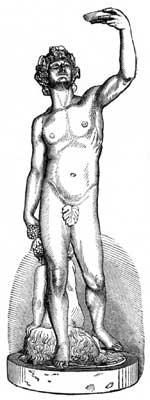 Fig. 102.—Bacchus.
Fig. 102.—Bacchus.Sansovino's most important pupil was Jacopo Tatti, who, on account of his master, is called Jacopo Sansovino (1477-1570). He was born at Florence, and when Andrea Sansovino returned from Portugal Jacopo became his pupil. Early in life he went to Rome, and there studied and copied the works of antiquity; among other things he made a copy of the Laocoon, which was cast in bronze at a later time. Soon after his return to Florence, in 1511, Jacopo received orders for some works, but the most important statue which he made about this time is the Bacchus, now in the Uffizi. In this work he showed how completely he was in sympathy with the classic spirit; this Bacchus is a triumph in this manner, and has been called "the most beautiful and spirited pagan statue of the Renaissance period." It is full of gladness, and is simple, delicate, and beautiful. The young god is advancing and holding up a cup, which he regards with an expression of delight; in his right hand he has a bunch of grapes, from which a Pan is eating stealthily (Fig. 102).
In 1514 Jacopo Sansovino was employed upon the decorations for the visit of Leo X. to Florence. Soon after this[Pg 186] he went again to Rome and submitted plans for the Church of San Giovanni de' Fiorentini, which the Florentines were about to erect—for this master was an architect as well as a sculptor. The taking of Rome by Constable de Bourbon, in 1527, drove Sansovino away; he went to Venice, intending to go to France, but Venice charmed him, and his work pleased the Venetians, and the result was that from 1529 he served the Venetians as long as he lived. He was appointed Protomastro of the Republic of Venice, and had the care of St. Mark's, the Campanile, the Piazza, and the surrounding buildings. He received a good salary, and was provided with a handsome house to live in.
He first restored the cupolas of St. Mark's; then completed the Scuola della Misericordia; he next made the interior of San Francesco della Vigna; then the Zecca, the Fabbriche Nuove, and the Loggietta of the Campanile. He also erected other churches and palaces, besides smaller sculptural works. But his architectural masterpiece was the Library of St. Mark's. The bronze gate to the Sacristy of St. Mark's was one of his principal works. It is subject to criticism as being too crowded; but it is a fine work and full of strong feeling.
His statues are numerous and seen all over Venice; indeed, it is proper to speak of him as a Venetian, so thoroughly did he adopt that city, and so industriously did he work for it during forty years. Had he remained in Florence he might have been a better artist; the splendor and luxury of the Venetians brought out corresponding traits in Jacopo, and he fell short of the purity which the influence of Florence might have given him. He is one of the masters in whom the sensual influence of the study of pagan art was fully manifested. Many of his subjects were mythological; among them were the story of Phrixos and Helle, Mercury, Apollo, Pallas, Mars, and Neptune, the last two being colossal figures on the steps of the Doge's Palace.[Pg 187]
Among the pupils and associates of Sansovino were Niccolo Braccini (1485-1550), called Il Tribolo, and Francesco Sangallo (1498-1570), neither of whom were important artists, though many works by them are seen in various places in Italy.
Benvenuto Cellini (1500-1572) is a far more interesting study than were many sculptors of his time. His life was an eventful one, and his own account of it is one of the most interesting books of its class in existence. His statement of the origin of his family is that "Julius Cæsar had a chief and valorous captain named Fiorino da Cellino, from a castle situated four miles from Monte Fiascone. This Fiorino having pitched his camp below Fiesole, where Florence now stands, in order to be near the river Arno, for the convenience of the army, the soldiers and other persons, when they had the occasion to visit him, said to each other, 'Let us go to Fiorenza,' which name they gave to the place where they were encamped, partly from their captain's name of Fiorino, and partly from the abundance of flowers which grew there; wherefore Cæsar, thinking it a beautiful name, and considering flowers to be of good augury, and also wishing to honor his captain, whom he had raised from an humble station, and to whom he was greatly attached, gave it to the city which he founded on that spot."
When this artist was born his father was quite old, and named him Benvenuto, which means welcome, on account of his pleasure in the child of his old age. The father had a passion for music, and from the first wished that his son should study this art; but the boy loved drawing, and was determined to be an artist; thus his time was divided between these two pursuits until he was fifteen years old, when he was apprenticed to a goldsmith.
Benvenuto had a fiery temper, and when still very young he became involved in so serious a quarrel that he was[Pg 188] obliged to flee from Florence. He went first to Siena, and thence to Bologna, and at last back to Florence, where he resumed his work. It was not long, however, before he became angry again because his best clothes were given to his brother, and he walked off to Pisa, where he remained a year. He had even then become so skilful in his art that some of his works done there have never been excelled either in design or execution.
When Cellini was eighteen years old Torrigiano came to Florence to engage artists to go to England to aid him in some works he was to execute. He wished to have Cellini in the number; but Torrigiano so disgusted Benvenuto by his boasting of the blow that he had given Michael Angelo, that though he had the natural youthful desire to travel, he refused to be employed by such a man as Torrigiano. We can safely assume that this predisposed Michael Angelo in Cellini's favor, and was the foundation of the friendship which he afterward showed to the younger sculptor.
From his eighteenth to his fortieth year Cellini lived mostly at Rome. He was employed by Pope Clement VII., the cardinals and Roman nobles. The Pope desired to have a cope button made and a magnificent diamond set in it. This jewel had cost Julius II. thirty-six thousand ducats. Many artists sent in designs for this button, and Clement chose that by Cellini. He used the diamond as a throne, and placed a figure of the Almighty upon it; the hand was raised as if in blessing, and many angels fluttered about the folds of the drapery, while various jewels were set around the whole. When other artists saw the design they did not believe that it could be executed successfully; but Cellini made it a perfect work of art and of beauty.
Cellini writes of himself as being very active in the siege of Rome, May 5th, 1527. He says that he killed the Constable de Bourbon, who led the siege, and that he wounded the Prince of Orange, who was chosen in Bourbon's place.[Pg 189] No one else saw him perform these feats. Cellini went to the Pope, who was in the Castle of St. Angelo, and he there rendered such services to the cause of the Church that the Holy Father pardoned him for all the sins into which his temper had led him—"for all the homicides he had committed or might commit in the service of the Apostolic Church." A few years later, when Cellini was called upon to take part in the defence of his own city, he put all his property into the care of a friend, and stole away to Rome.
In 1534 Cellini killed a fellow-goldsmith, called Pompeo; Paul III. was now Pope; and as he needed the services of Benvenuto very much he pardoned him. But the sculptor felt that he was in ill favor with all about him, and went to France. In about a year he returned to find that he had been accused of stealing some jewels which the pope had commanded him to take out of their settings. Cellini was held a prisoner nearly two years, but his guilt was never proved.
At the end of this time the Cardinal Ippolito d'Este obtained his release in order that he might go to France to execute some work for Francis I. Cellini remained in France five years, and received many honors and gifts; but as Madame d'Étampes and other persons to whose advice the king listened were enemies of Cellini, he never was treated as his artistic qualities merited. Francis I. really admired Cellini, and presented him with the Hôtel de Petit Nesle, which was on the site of the present Hôtel de la Monnaie; he also made him a lord, and on one occasion expressed his fear of losing him, when Madame d'Étampes replied, "The surest way of keeping him would be to hang him on a gibbet."
Of all the objects which Cellini made during his five years in France but two remain. One is a splendid salt-cellar, and the other is a nymph in bronze, which was made for the Palace of Fontainebleau, and is now in the Renais[Pg 190]sance Museum of the Louvre. This salt-cellar is now in the Ambraser Gallery at Vienna. The frieze around the base has figures in relief which represent the hours of the day and the winds. The upper part is made like the surface of the sea, and from it rise figures of Neptune and Cybele. The first is a symbol of the salt of the sea, and the second of the spices which the earth gives. The god is placing his arm on a small ship intended for the salt, and a vessel for pepper, in the form of a triumphal arch, is near the goddess. All this is made of fine embossed gold, and has some touches of enamel-work. It is one of the finest pieces of the goldsmith's art which remains from the sixteenth century.
In 1545 Cellini returned to Florence, and remained there, with short absences, until his death. Duke Cosmo de' Medici became his patron, and commissioned him to make a statue of Perseus for the Loggia de' Lanzi. The ambition of the artist was much excited by the thought of having his work placed by those of Donatello and Michael Angelo, and all care was taken from his mind, as the Duke provided him with a comfortable house and gave him a salary sufficient for his support.
It was nine years before the statue was completed and in its place, and in this time Cellini had suffered much. Baccio Bandinelli and others were his enemies, and at times the Duke had been under their influence, and would not furnish the money necessary to the work. But at last all was ready for the casting; and just at this unfortunate moment for Cellini to leave it he was seized with a severe illness; he was suffering much, and believed himself about to die, when some one ran in shouting, "Oh, Benvenuto, your work is ruined past earthly remedy!"
Ill as he was he rushed out to the furnace, to find that the fire was too low, and the metal, being cool, had ceased flowing into the mould. By almost superhuman efforts he[Pg 191] remedied the evil, and again the bronze flowed; he prayed earnestly, and when the mould was filled he writes: "I fell on my knees and thanked God with all my heart, after which I ate a hearty meal with my assistants, and it being then two hours before dawn, went to bed with a light heart, and slept as sweetly as if I had never been ill in all my life."
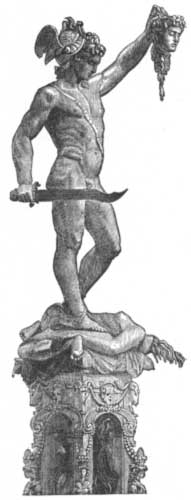 Fig. 103.—Perseus.
Fig. 103.—Perseus.When the statue was unveiled Cellini's prediction that it would please all the world except Bandinelli and his friends was fulfilled. Perseus is represented just at the moment when he has cut off the head of Medusa, who was one of the Gorgons, and had turned to stone every one who looked at her. (Fig. 103.)
After the completion of the Perseus, Cellini went to Rome for a short time. While there he made a bust of Bindo Altoviti; when Michael Angelo saw this he[Pg 192] wrote: "My Benvenuto, I have long known you as the best goldsmith in the world, and I now know you as an equally good sculptor, through the bust of Messer Bindo Altoviti." Cellini did no more important works, though he was always industrious. He made a crucifix which he intended for his own grave, but he gave it to the Duchess Eleanora; this was afterward sent to Philip II. of Spain, and is now in the Escurial.
Cellini's life was by no means a model one, but he had his good qualities. He took a widowed sister with six children to his home, and made them welcome and happy. At his death he was buried in the Church of the Annunziata, beneath the chapel of the Company of St. Luke, and many honors were paid to his memory.
His autobiography was so rich in its use of the Florentine manner of speech and so fine in its diction that it was honored as an authority by the Accademia della Crusca. He also wrote valuable works on the goldsmith's art and on bronze-casting and sculpture. He wrote poems and various kinds of verses, but his large acquaintance with popes, cardinals, kings, artists, and men of letters makes his story of his life far more interesting than his other writings.
The artists of Upper Italy were much influenced by Florentine art, as they had formerly been, and we can speak of no very great sculptor of this century who belonged to this part of the country. Alfonso Lombardo (1488-1537) was a native of Lucca; his principal works are seen in Ferrara, Bologna, and Cesena.
Properzia de' Rossi (1490-1530) was born at Bologna, and is interesting as the one Italian sculptress of that time. She was born about a year after her father had returned from the galleys, where he had worked out a sentence of eighteen years for the crime of manslaughter. Properzia seems to have inherited her father's violent temper, and was twice arraigned in court. She was very beautiful in[Pg 193] person, and had a devoted lover in Antonio Galeazzo Malvasia de' Bottigari, who did not marry until many years after the death of Properzia.
Properzia studied drawing under Marc Antonio Raimondi, the famous engraver. She first devoted herself to the cutting of intaglios, which demanded an immense amount of patient labor. There is in the cabinet of gems in the Uffizi Gallery, at Florence, a cherry-stone carved by Properzia, on which sixty heads may be counted; the subject is a Glory of Saints. Other like works of hers exist in the Palazzo Grassi, in Bologna. Her next work was in arabesques, marble ornaments, lions, griffins, vases, eagles, and similar objects.
Finally she essayed a bust of Count Guido Pepoli; it is now in the Sacristy of San Petronio, in Bologna. In the same place are two bas-reliefs by her hand, Solomon receiving the Queen of Sheba, and Joseph and Potiphar's Wife. In the chapel Zambeccari in San Petronio there are two large figures of angels by Properzia, which are near the Ascension of the Virgin by Il Tribolo. Her manner was much influenced by her contact with this sculptor. Properzia was employed, with other artists, to finish the sculpture of the portal of San Petronio, left unfinished by Jacopo della Quercia.
Antonio Begarelli (1499-1565), called also Antonio da Modena, from the place of his birth, was a celebrated modeller in clay. It is said that when Michael Angelo visited Modena in 1529 he saw Begarelli and his works, and exclaimed, "Alas for the statues of the ancients, if this clay were changed to marble!" Begarelli had a school for teaching design and modelling, and he greatly influenced the manner of the Lombard school of painting. Its foreshortening, its relief and grace are largely due to him and his teaching.
Begarelli and Correggio were fast friends, and resembled[Pg 194] each other in their conception of the grand and beautiful. When Correggio was decorating the cupola of the Cathedral of Parma, Begarelli was at work in the same place, and made many models from which Correggio painted his floating figures. Some works by Begarelli may be seen in the Berlin Museum. His Descent from the Cross, in the Church of San Francesco, at Modena, is one of his best works. He was also employed in the Church of San Benedetto, in Mantua, and in San Giovanni, at Parma.
During the sixteenth century the works at the Certosa at Pavia and in various edifices in Milan were constantly carried on. Frequently the same sculptors worked in both cities, but there is no one artist of great excellence among them of whom we can give an account. The same is true of the works in Venice and in Southern Italy. The traveller sees many pieces of sculpture belonging to this period, but there are no great and interesting men whose story we can tell in connection with them, and I shall now pass to an account of the great Florentine.
Michael Angelo Buonarroti (1475-1564) was born in the Castle of Caprese, where his father, Ludovico Buonarroti, was stationed at that time, holding the office of Podesta, or Governor, of the towns of Caprese and Chiusi. The Buonarroti family held good rank in Florence, and the mother of the great artist was also a woman of good position. When his father returned to Florence the child Michael was left at Settignano upon an estate of the family, and was in the care of the wife of a stone-mason. As soon as the boy could use his hands he drew pictures everywhere that it was possible, and his nurse could show many of these childish drawings with which he adorned the walls of her house.
At a proper time Michael Angelo was removed to Florence and placed in a school, where he became intimate with Francesco Granacci, who was a pupil of the artist[Pg 195] Ghirlandajo. Michael Angelo's father and his uncles were firmly opposed to his being an artist; they wished him to follow the traditions of his family, and carry on the silk and woollen trade. But the boy was firm in his determination, and after many trials was at length, in 1488, apprenticed to the Ghirlandaji for three years.
Domenico Ghirlandajo was at this time engaged in the restoration of the Church of Santa Maria Novella, and Michael Angelo came into the midst of great artistic works. One day at the dinner hour he drew a picture of the scaffolding and all its belongings, with the men at work on it; it was a remarkable drawing for a boy, and when the master saw it he exclaimed, "He understands more than I do myself!" The master really became jealous of his pupil, more especially when Michael Angelo corrected the drawings which Ghirlandajo gave his scholars for models.
About this time Michael Angelo was brought to the notice of Lorenzo de' Medici, who was at that time at the head of the government of Florence, and from him the boy-artist obtained admission for himself and Granacci to study in the gardens of San Marco. The art treasures of the Medici were placed in these gardens; works of sculpture were there, and cartoons and pictures were hung in buildings erected for the purpose, and art-students were admitted to study there and proper instructors provided for them.
The master in sculpture was old Bertoldo, and Michael Angelo, forsaking painting, obtained some instruments and a piece of marble, and copied a mask of a faun. He changed his own work somewhat from the model, and opened the mouth so that the teeth could be seen. When Lorenzo saw this he praised the work, but said, "You have made your faun old, and yet you have left all his teeth; you should have known that at such an age there are generally some teeth wanting." When he came again he saw that a[Pg 196] gap had been made in the teeth, and so well done that he was delighted. This work is now in the Uffizi Gallery.
Very soon Lorenzo sent for Michael Angelo's father, who had been sad enough at the thought that his son might be a painter, and was now in despair when he found that he inclined also to be a stone-mason. At first he refused to see the duke, but Granacci persuaded him to go. He went with a firm determination to yield to nothing, but once in presence of Lorenzo he yielded everything, and returned home declaring that not only Michael, but he himself, and all that he had were at the nobleman's service.
Lorenzo at once took Michael Angelo into his palace; he clothed the boy properly, and gave him five ducats a month for spending money. Each day Lorenzo gave an entertainment, and it was the rule that the first person who came should sit next the duke at the head of the table. Michael Angelo often had this place, and he soon became a great favorite with Lorenzo, and obtained besides the greatest advantages from the life in the palace; for many eminent men from all parts of the world came to visit there, and all sorts of subjects were discussed in such a manner that a young man could learn much of the world and what was in it, and acquire a feeling of ease with strangers and in society such as few young persons possess.
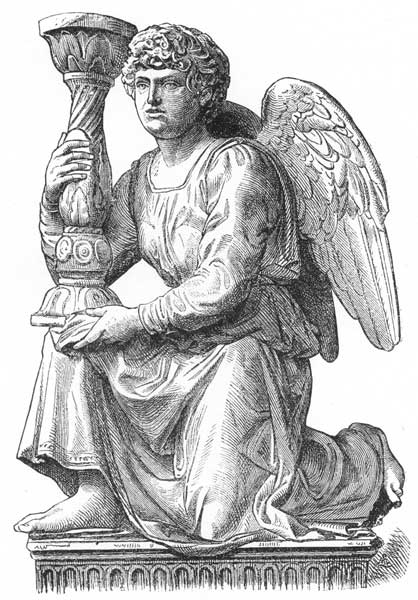 Fig. 104.—Michael Angelo's Angel.
Fig. 104.—Michael Angelo's Angel.Michael Angelo was but seventeen years old when Poliziano advised him to attempt an original work, and gave him the marble for a relief of the contest between Hercules and the Centaurs. This work surprised every one, and is still preserved in the collection of the Buonarroti family. In the year 1492 he also made a relief of the Madonna Suckling the Child Jesus, which is also in the same place. In the same year Lorenzo de' Medici died, and Michael Angelo, full of grief, went to his father's house and arranged a studio there. After a time Piero de Medici invited him to come back to the palace, and he went; but it was[Pg 198] no more the same place as formerly, and he was unhappy there. Soon political troubles drove the Medici from power, and in 1494, in the midst of the confusion, Michael Angelo escaped to Venice. There he made friends with Gian Francesco Aldovrandi of Bologna, and was persuaded by that nobleman to accompany him to his own city.
While at Bologna he executed an angel holding a candelabra, which is one of the most lovely and pleasing things he ever made (Fig. 104). When he received the commission to ornament the sarcophagus which contained the remains of San Domenico in the Church of San Petronio, the Bolognese artists were so angry at being thus set aside for a stranger, and a youth of twenty, that they threatened vengeance on him, and he returned to Florence.
It was at this time that he executed a Cupid, which was the means of leading him to Rome. The story is that when he had the statue completed Lorenzo de' Medici, a relative of his first patron, advised him to give it the appearance of an antique marble, and added that he would then sell it in Rome and get a good price for it. Michael Angelo consented to this plan, and in the end he received thirty ducats for the work. The secret of its origin was not kept, and the cardinal who had bought it sent an agent to Florence to find out the truth about it. This agent pretended to be in search of a sculptor; and when he saw Michael Angelo he asked him what works he had done. When he mentioned a Sleeping Cupid, and the agent asked questions, the young sculptor found that the cardinal had paid two hundred ducats for it, and that he had been greatly deceived when attempting to deceive others.
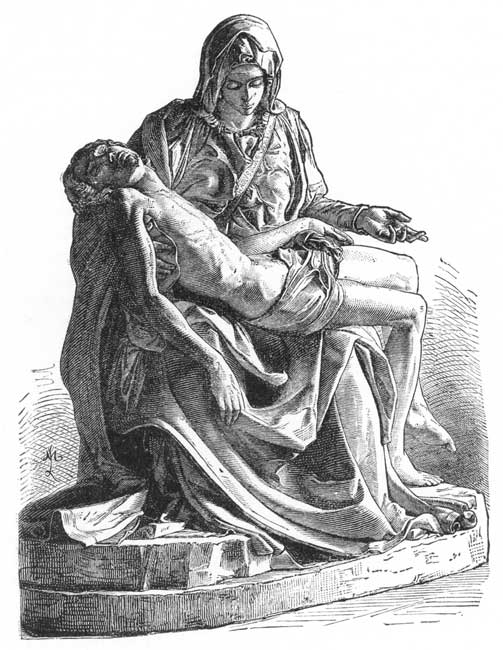 Fig. 105.—Pietà.
Fig. 105.—Pietà.Michael Angelo consented to go to Rome with this man, who promised to receive him into his own house, and assured him that he would be fully occupied in the Eternal City. The oldest writing by the hand of Michael Angelo is the letter which he wrote to Lorenzo telling him of his[Pg 200] arrival in Rome; when this was written he was twenty-one years old. The first work which he did after he reached Rome was the "Drunken Bacchus," now in the Uffizi Gallery; it shows a great knowledge of anatomy in one so young, and the expression of drunkenness is given in the most natural manner.
But the work that established his fame as a great sculptor is the Pietà, now in St. Peter's at Rome (Fig. 105). He was twenty-five years old when he executed this work, and from that time was acknowledged to be the greatest sculptor of Italy—a decision which has never been reversed.
Soon after this Michael Angelo returned to Florence, and his first important work was a Madonna, now at Bruges; it is life-size, and one of his finest sculptures. There was at this time an immense block of marble which had lain many years in the yard to the workshops of the cathedral. Several sculptors had talked of making something from it, and now Michael Angelo was asked by the consuls to make something good of it. He had just taken an order for fifteen statues for the Piccolomini tomb at Siena; but when he saw the immense block he gave up the Siena work, and contracted to make a statue in two years. He was to be paid six gold florins a month, and as much more as could be agreed upon when the work was done. He first made a model in wax of his David; it was very small, and is now in the Uffizi. In the beginning of 1504, after about two years and a half had been spent upon it, the work was done, and a discussion then arose as to where it should be placed.
At length it was decided to put it where Michael Angelo himself wished it to be, next the gate of the palace where the Judith of Donatello then stood. The statue weighed eighteen thousand pounds, and its removal was a work of great importance. I shall not give all the details of it here, but shall quote what Grimm says: "The erection of this[Pg 201] David was like an occurrence in nature from which people are accustomed to reckon. We find events dated so many years after the erection of the giant. It was mentioned in records in which there was not a line respecting art."
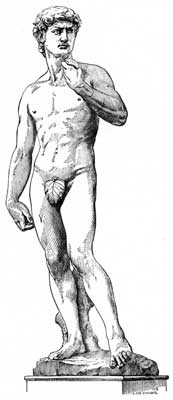 Fig. 106.—Michael Angelo's David.
Fig. 106.—Michael Angelo's David.
In 1527 the statue was injured by a stone thrown in a riot. At length it began to show the effect of time and weather, and the people of Florence talked of removing it for better preservation. There was much feeling against this; the Florentines feared that misfortunes would fall upon them if this great work were disturbed; but at last, in 1873, it was placed in the Academy of Fine Arts. It represents the youthful David at the moment when he declares to Goliath, "I come unto thee in the name of the Lord of[Pg 202] Hosts." The beautiful figure is muscular and pliant, and the face is full of courage. (Fig. 106.)
About the beginning of the year 1505 Pope Julius II. summoned Michael Angelo to Rome, and after a time gave him a commission to build a colossal mausoleum to be erected for himself. The design was made and accepted, and then Michael Angelo went to Carrara to select marble; after much trouble he succeeded in getting it to Rome, where all who saw it were astonished at the size of the blocks. Pope Julius was delighted, and had a passage made from the palace to the workshop of the sculptor, so that he could visit the artist without being seen. Other sculptors now became jealous of Michael Angelo, and when he went a second time to Carrara, Bramante persuaded the pope that it was a bad sign to build his tomb while he was still living. When Michael Angelo returned and the workmen he had hired arrived from Florence, he found the pope much changed toward him. He no longer hastened the work, neither would he furnish money to carry it on.
Michael Angelo sought the pope for an explanation, and was refused an audience. He wrote a letter thus: "Most Holy Father, I was this morning driven from the palace by the order of your Holiness. If you require me in future you can seek me elsewhere than in Rome." He ordered a Jew to sell all he possessed in Rome, and started for Florence, and stopped not until he was on the ground of Tuscany. The pope sent after him, but as he was a citizen of Florence he threatened the messengers if they touched him. He said he had been treated as a criminal, and he considered himself free from his engagements, and would not return then or ever.
When he reached home a letter came to the Signory of Florence urging his return, and saying that he should be safe. But Michael waited until the third letter was[Pg 203] received, and only consented to go when it was arranged that he should be sent as an ambassador of Florence, and be under the protection of the Florentine Republic.
In November, 1506, when the pope had taken Bologna, he sent for Michael Angelo to come to him there. Michael Angelo had not yet seen the pope since he left Rome in anger. When he reached Bologna he went first to San Petronio to hear mass. A servant of the pope recognized him and led him to his Holiness. Julius was at table, but ordered that Michael Angelo should come in, and said to him, "You have waited thus long, it seems, till we should ourselves come to seek you." Michael Angelo kneeled down and begged his pardon, but added that he had remained away because he had been offended. The pope looked at him doubtfully, when one of the priests, fearing what would happen, advised the pope not to judge an ignorant artist as he would another man. Then the pope turned upon him in great anger, and declaring that he himself was ignorant and miserable, ordered him out of his sight. The poor ecclesiastic was so terrified that the attendants were obliged to carry him out, and then the pope spoke graciously to the sculptor, and commanded him not to leave Bologna without his permission. The pope soon gave him an order for a colossal statue in bronze to be erected in Bologna.
The first cast of this statue failed, and the work was not ready to be put in its place until February, 1508. This being done, Michael Angelo returned to Florence, where he had much to do; but Julius soon sent for him to go to Rome, and insisted that he should paint the roof of the Sistine Chapel, which occupied him a long time.
In 1513 Julius II. died, and Michael Angelo resumed his work upon his mausoleum. The pope had mentioned it in his will, and his heirs wished it to be completed. At this time he probably worked upon the statue of Moses and[Pg 204] upon the two chained youths. He devoted himself to the mausoleum during three years.
Leo X., who was now pope, demanded the services of Michael Angelo to erect a façade to the Church of San Lorenzo in Florence. The artist objected to this great work, and declared that he was bound to complete the tomb for which he had already received money. But Leo insisted upon his going to Florence. He had much trouble to get his marble from the quarries—the men were ill there. He was ill himself, and he passed a year of great anxiety and trouble, when there came word from Rome that the work must be given up; the building was postponed, and no payment was made to Michael Angelo! He was much disheartened, but returned to his work on the mausoleum.
About 1523, when, after many changes, Cardinal Medici was pope, the work at San Lorenzo was resumed. But in 1525 the pope again summoned Michael Angelo to Rome. The heirs of Julius were complaining of delay, but at last the pope insisted upon his great need of the artist, and again he was sent back to Florence, where the cupola of the new Sacristy to San Lorenzo was soon finished. Great political confusion now ensued, and little can be said of Michael Angelo as a sculptor until 1530, when he again resumed his work on the Sacristy.
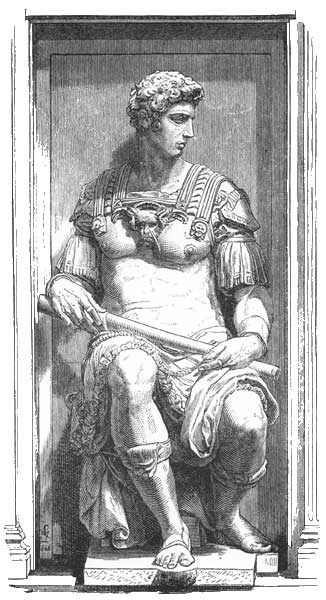 Fig. 107.—Giuliano de' Medici.
Fig. 107.—Giuliano de' Medici.He worked with the greatest industry and rapidity, and in a few months had nearly finished the four colossal figures which rest upon the sarcophagi of Lorenzo and Giuliano de' Medici. The pope was forced to command the sculptor to rest. His health was so broken by the sorrow which the political condition of Florence caused him, and by his anxiety about the mausoleum of Julius, that there was much danger of his killing himself with work and worry. He went to Rome, and matters were more satisfactorily arranged. He returned to Florence, and labored there until 1534, when Clement VII. died, and Michael Angelo left[Pg 206] his work in San Lorenzo, never to resume it. Unfinished as these sculptures are, they make a grand part of the wonderful works of this great man. The statues of the two Medici and those of Morning, Evening, Day, and Night would be sufficient to establish the fame of an artist if he had done nothing more. (Fig. 107.)
Under the new pope, Paul III., he was constantly employed as a painter, and architectural labors were put upon him, so that as a sculptor we have no more works of his to mention except an unfinished group which was in his studio at the time of his death. It represents the dead Christ upon his mother's lap, with Joseph of Arimathea standing by. This group is now in the Church of Santa Maria del Fiore, or the Cathedral of Florence. The mausoleum of Julius II. caused Michael Angelo and others so much trouble and vexation that the whole affair came to be known as the "tragedy of the sepulchre." When Julius first ordered it he intended to place it in St. Peter's, but in the end it was erected in the Church of San Pietro in Vincoli, of which Julius had been the titular cardinal. Of all the monument but three figures can really be called the work of Michael Angelo. These are the Leah and Rachel upon the lower stage, and the Moses, which is one of the most famous statues in the world. Paul III., with eight cardinals, once visited the studio of the sculptor when he was at work upon this statue, and they declared that this alone was sufficient for the pope's monument (Fig. 108).
The life of Michael Angelo was a sad one; indeed, it is scarcely possible to recount a more pathetic story than was his. The misfortunes which came to the Medici were sharp griefs to him, and his temperament was such that he could not forget his woes. His family, too, looked to him for large sums of money, and while he lived most frugally they spent his earnings. In his old age he said, "Rich as I am, I have always lived like a poor man."[Pg 207]
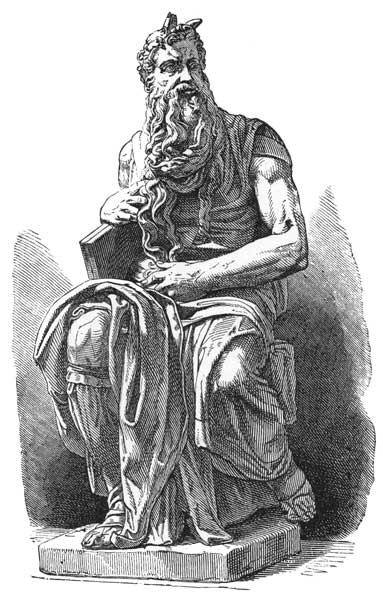 Fig. 108.—Statue of Moses.
Fig. 108.—Statue of Moses.In 1529, when Florence was under great political excitement, Michael Angelo was appointed superintendent of all the fortifications of the Florentine territory. In the midst of his duties he became aware of facts which determined him to fly. He went to Venice, and was proscribed as a rebel. We cannot stay here to inquire as to his wisdom in this, but must go on to say that at length he was so much needed that he was persuaded to return. Then he had the dreadful experiences of hope and fear, sickness and famine, and all the horrors of a siege, only to see his beloved home deprived of its freedom, and in the possession of those whom he despised and hated. To Michael Angelo this was far more bitter than any personal sorrow; he never recovered from its effects, and it was immediately after this that he worked in the Sacristy of San Lorenzo as if trying to kill himself.
He was bold as he was angry. He was treated kindly, and advised to forget the past; but he never concealed his views. When his statue of Night was exhibited, verses were put upon it, according to the custom of the time; one verse read, "Night, whom you see slumbering here so charmingly, has been carved by an angel, in marble. She sleeps, she lives; waken her, if you will not believe it, and she will speak."
To this Michael Angelo replied, "Sleep is dear to me, and still more that I am stone, so long as dishonor and shame last among us; the happiest fate is to see, to hear nothing; for this reason waken me not. I pray you, speak gently." He had great courage to speak his anger thus publicly in the midst of those who could easily destroy him.
In 1537 or 1538 his father died, and the artist suffered terribly from his grief. He wrote a sonnet beginning:
"Already had I wept and sighed so much.
I thought all grief forever at an end,
Exhaled in sighs, shed forth in bitter tears."
[Pg 209]
The religious views of Michael Angelo were very broad, and he had a trustful and obedient dependence upon God, in whose mercy and love he gratefully rested with the simple faith of a child. It was not far from the time when his father died that Michael Angelo first met Vittoria Colonna. He was now more than sixty years old; and though his poems show that he had loved children and women all his life, yet he had allowed himself no attachments; his life had been lonely and alone. Now, at this late hour, he yielded his heart to this beautiful, gifted woman, who returned his friendship with the fullest esteem. During these years he was happier than he had ever been. But in 1541 she fell under the suspicion of the Inquisition, and was obliged to leave Rome.
During two years they wrote constantly to each other, and each sent to the other the sonnets they wrote. At this time all Italy read the poems of Vittoria, and those of Michael Angelo still stand the test of time. In them he shows the blessed effect of her influence over him. At length she returned to Rome and entered a convent, where she died in 1547. Michael Angelo was with her to the last, and years later he declared that he regretted nothing so much as that he had only kissed her hand, and not her forehead or cheeks in that last hour. His loss was far too great to be told. (An engraving of a portrait of Michael Angelo can be seen in Mrs. Clement's "Painting," p. 95.)
In the year following Vittoria's death all the hopes which he had cherished for the freedom of Florence were crushed. High honors were offered him to induce him to return there, but he would not go. His health failed, his sadness increased, and his writings show how constantly he mourned for Vittoria. After this he did much work as an architect, and held the post of director of the building of St. Peter's. He superintended the erection of the statue of Marcus Aurelius, and completed the Farnese Palace, and had many improvements in mind.[Pg 210]
Now, in his old age, he was authority itself in Rome. He had no rival, and his advice was sought by artists as well as others. He lived very simply: he dined alone, and received his visitors in the plainest manner. Anatomy, which had always been a passion with him, was now his chief pursuit. He made many dissections of animals, and was grateful when a human subject could be allowed him.
When he could not sleep he would get up at night and work upon the group of which we have spoken; he had a cap with a candle in it, so that it cast a light upon his work. Vasari once entered when he was at work upon this group, and had a lantern in his hand; he dropped it purposely, so that the sculpture should not be seen, and said: "I am so old that death often pulls me by the coat to come to him, and some day I shall fall down like this lantern, and my last spark of life will be extinguished."
There are many very interesting circumstances told of his last years and his strength of mind, and the work which he did was wonderful; but we have not space to recount it here.
At length, in February, 1564, when almost ninety years old, he died. He had asked to be buried in Florence. His friends feared that this would be opposed, so they held burial-services in Rome, and his body was afterward carried through the gates as merchandise. In Florence the body was first laid in San Piero Maggiore, and on Sunday, at evening, the artists assembled, and forming a procession, proceeded to Santa Croce, where he was buried. The younger artists bore the bier upon their shoulders, and the older ones carried torches to light the way. A great multitude followed the procession, and in the Sacristy of Santa Croce the coffin was opened; though three weeks had passed since his death, his face appeared as if he had just died; the crowd was very great, but all was quiet, and before morning it had dispersed. The Duke had thought that a public funeral would recall old memories, and might cause[Pg 211] a disturbance; but Michael Angelo had left Florence thirty years before his death, and his connection with the city was forgotten by many.
The July following was appointed for a memorial service in his honor; San Lorenzo was splendidly decorated; Varchi delivered an oration. Leonardo, his nephew, erected a monument to him in Santa Croce, for which the Duke gave the marble. His statue stands in the court of the Uffizi with those of other great Florentines, but with no especial prominence. His house in the Ghibelline Street is preserved as a museum, and visitors there see many mementos of this great man.
In 1875 a grand festival was held in Florence to celebrate the four hundredth anniversary of his birth. The ceremonies were impressive, and certain documents relating to his life which had never been opened, by command of the king, were given to suitable persons for examination. Mr. Heath Wilson, an English artist, then residing at Florence, wrote a new life of Michael Angelo, and the last signature which Victor Emmanuel wrote before his death was upon the paper which conferred on Mr. Wilson the Order of the Corona d'Italia, given as a recognition of his services in writing this book.
The national pride in Michael Angelo is very strong. "All Italians feel that he occupies the third place by the side of Dante and Raphael, and forms with them a triumvirate of the greatest men produced by their country—a poet, a painter, and one who was great in all arts. Who would place a general or a statesman by their side as equal to them? It is art alone which marks the prime of nations."
The genius of Michael Angelo and his spirit were powerful forces. They pervaded the whole art of Italy to such an extent that it may be said that all sculptors were his imitators, both while he lived and after his death. He loved to treat strong subjects, such as demanded violent[Pg 212] movement and unusual positions. It was only a man of his genius who could raise such subjects above grotesqueness and the one effect of strange and unnatural exaggeration. As we look over all his works it seems as if the idea of beauty and such things as are pleasing to the ordinary mind rarely, if ever, came to his mind. Noble feeling, depth of thought, strength, and grandeur are the associations which we have with him, and in the hands of weaker men, as his imitators were, these subjects became barren, hollow displays of distorted limbs and soulless heads and faces.
The result is, that there is little to be said of the immediate followers of this great man. Guglielmo della Porta was one of his most able scholars, and his chief work was a monument to Pope Paul III. in the Church of St. Peter's. The figure of the pope is in bronze, is seated, and holding the right hand in benediction. It is dignified and well designed. The figures of Justice and Prudence are not as good, and two others, Peace and Abundance, which were a part of this work, but are now in the Farnese Palace, lack power, and show an attempt at a representation of mere physical beauty.
Baccio Bandinelli (1487-1559) is more noticeable for his hatred of Michael Angelo than for any other characteristic. He was a native of Florence and a friend of Leonardo da Vinci. He was powerful in his design and bold in his treatment of his subjects, but he was full of affectation and mannerisms in his execution of his works. He was false and envious, and his one good quality was that of industry. His best works are on the screen of the high-altar in the Cathedral of Florence, a relief on a pedestal in the Piazza of San Lorenzo, in Florence, and a group in the Church of the Annunziata, which he intended for his own monument; the subject is Nicodemus supporting Christ, and the Nicodemus is a portrait of Bandinelli himself.[Pg 213]

Not only Italian artists attempted to follow the great sculptor of Italy, but those of other nations flocked to Rome, and whatever ideas they may have had before reaching that city they seemed to lose them all and to aim simply at one thing—to be Michaelangeloesque.
Giovanni da Bologna (1529-1608) was born in Douai, in Flanders, and was called Il Fiammingo for this reason. Giovanni was intended for a notary by his father, who planned his education with that end in view; but the boy's passion for sculpture was so great that the father was obliged to yield to it, and placed him under the instruction of a sculptor named Beuch, who had studied in Italy. Later Giovanni went to Rome, and finally settled in Florence, where his most important works remain.
He was an imitator of Michael Angelo, and one of his best imitators; but when his works are compared with those of the great master, or with the masterpieces of the fifteenth century, we see a decline in them. In religious subjects Giovanni was not at home; his most successful works were those which represented sentiment or abstract ideas, because on them he could lavish his skill in execution, and use ornaments that did not suit the simplicity of religious subjects. In the Loggia de' Lanzi, at Florence,[Pg 214] there are two groups by him, the Rape of the Sabines and Hercules and Nessus. In the Piazza della Signoria is his excellent statue of Duke Cosmo I., and in the Uffizi Gallery a bronze statue of Mercury. The Rape of the Sabines is his masterpiece, and the Mercury is one of the best works of its kind since the days of classic art. It is the favorite Mercury of the world, and has been frequently copied. It is seen in many galleries and collections in its original size, and a small copy is much used in private houses. (Fig. 109.)
Giovanni was especially happy in his designs for fountains, and that which he erected in Bologna, in 1564, in front of the Palazzo Pubblico, is a splendid work of this kind. The statue of Neptune at its summit is stately and free in its action; the children are charming and life-like, and the Sirens at the base give an harmonious finish and complete the outline with easy grace.
He also erected a magnificent fountain in the island of the Boboli Gardens. In the Palazzo Vecchio is a marble group by Giovanni representing Virtue conquering Vice. At Petraja there is a beautiful Venus crowning a fountain remarkable for grace and delicacy, and, all in all, his works prove him to have been the best sculptor of his own time. Tuscany may claim him and be proud of him, for he was far more her son than that of his native Flanders.
Giovanni da Bologna was far less successful in reliefs than in statues, as may be seen in the bronze gates to the Cathedral of Pisa, which he made in the last years of his life. In his character this master was attractive and much beloved by his friends. One of them wrote of him: "The best fellow in the world, not in the least covetous, as he shows by his poverty; filled with a love of glory, and ambitious of rivalling Michael Angelo."
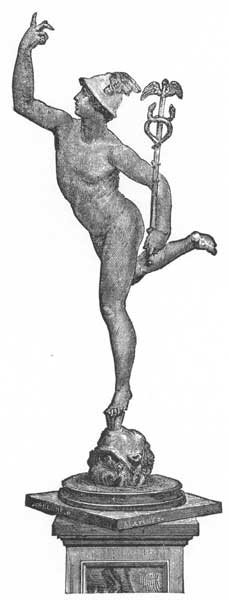 Fig. 109.—Mercury.
Fig. 109.—Mercury.Giovanni decorated a chapel in the Church of the Annunziata with several reliefs in bronze and with a crucifix;[Pg 216] he not only wished to be buried here himself, as he was, but he also desired to provide a place of burial for any of his countrymen who might die in Florence. The chapel is called that of the Madonna del Soccorso.
The decline of sculpture in Italy at this period makes its study so unpromising that it is a pleasure to turn to France, where the works of Jean Goujon show that he had the true idea of sculpture in relief. From 1555 to 1562 this sculptor was employed on the works at the Louvre, and during the massacre of St. Bartholomew he was shot while on a scaffold quietly working at a bas-relief on that palace.
Goujon was an architect as well as a sculptor, and also a medal engraver, as is shown by the curious and rare medal which he made for Catherine de' Medici. Many of his works are preserved in different parts of France, and some bas-reliefs in the Museum of the Louvre are excellent specimens of his style.
One also sees in France many works by Germain Pilon, who died in 1590. He executed the monument to Francis I., and took a part in that of Henry II. and Catherine de' Medici at the Church of St. Denis. He was the sculptor of the group of the three Graces in the Louvre, which formerly bore an urn containing the heart of Henry II., and was in the Church of the Celestines.
But the sculptors of France at this time are not of such interest as to hold our attention long. There was a certain amount of spirit in their decorations of palaces and tombs, but there were no men of great genius, and no splendid works upon which we can dwell with pleasure or profit.
In Germany, too, while there was much activity in sculpture, and public fountains and luxurious palaces and rich ornaments employed many artists, yet there was no originality or freshness in these works, and they fell below those of the past. Bronzes are still made at Nuremberg, but they only serve to make one regret that they are so[Pg 217] inferior to those of earlier days; and nowhere in all Germany does any one artist stand out and present a man to be studied in his works or remembered as one of the gifted of the earth. And yet a list of the names of German sculptors of this time would be very long, for all over the land churches were being decorated, monuments built, and statues and fountains erected.
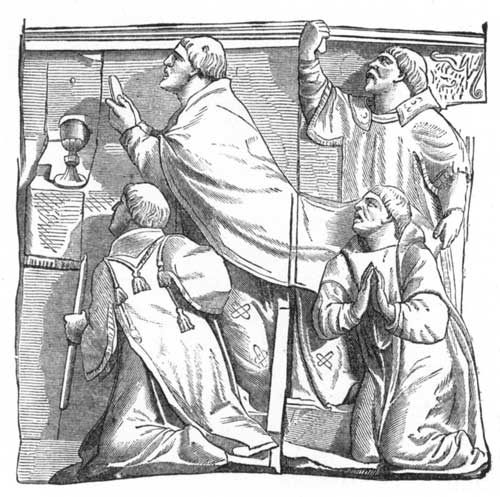 Fig. 110.—Relief by Berruguete.
Fig. 110.—Relief by Berruguete.In England the best sculpture of the sixteenth century was seen in the portrait statues on monuments, and we find no great artists there of whom to give an account.
In Spain Alonso Berruguete (1480-1561), who was the most eminent artist of his time, had introduced the Italian manner. He went to Italy about 1503, and studied in Rome and Florence during seventeen years. This was at the time when Italian sculpture was at the height of its excellence; and Berruguete returned to Spain filled with[Pg 218] the purest and best conceptions of what art should be, and the ends it should serve. He has been called the Michael Angelo of Spain, because he was an architect, painter, and sculptor.
Upon his return to Spain he was appointed painter and sculptor to Charles V. Among his most celebrated works in sculpture are the reliefs in the choir of the Cathedral at Toledo; the altar in the Church of San Benito el Real at Valladolid (Fig. 110), for which he was paid forty-four hundred ducats, and his sculptures in the Collegio Mayor at Salamanca. His final work was a monument to the Cardinal and Grand Inquisitor, Don Juan de Tavera, which is in the Church of the Hospital of St. John at Toledo. The sarcophagus is ornamented by reliefs from the story of John the Baptist, which are executed in an excellent manner, simple and expressive.
Other Spanish sculptors were Esteban Jordan, an eminent wood-carver, Gregorio Hernandez (1566-1636), who has been called "the sculptor of religion." His works are so full of a spirit of devotion that they seem to have been executed under an inspiration. Hernandez was very devout in his life, and did many works of charity; he often provided decent burial for the very poor who died without friends who could bury them.
Many of his works have been removed from the chapels for which they were designed, and are now in the Museum of Valladolid, where they are not as effective as when placed in their original positions. He is superior to other Spanish sculptors in his representation of nude figures and in the grandeur of his expression.
Juan de Juni (died 1614) studied in Italy, and acquired much mannerism; his works are seen in Valladolid.
Juan Martinez Montañes (died 1650) was a famous sculptor, and excelled in figures of children and cherubs. His conceptions had much beauty and depth of feeling, and[Pg 219] his draperies were most graceful; and to this power of thinking out clearly and well the subject he wished to represent he added the ability to do his work in an artistic manner, and to give it an elegance of finish without taking away its strength. A Conception by him, in the Cathedral of Seville, is a noble work, and in the university church of the same city there is an altar which is one of his important works. Other sculptures by Montañes are in the Museum of Seville.
The great Alonso Cano (1601-1667) was a pupil of Montañes in sculpture, and, like so many other artists of his time, was a painter and architect as well as a sculptor. His personal history is very peculiar. He was a man of violent temper, and was often involved in serious quarrels. He was obliged to flee from Granada to Madrid on account of a duel, and when his wife was found murdered in her bed he was suspected of the crime. In spite of all this he took priest's orders, and was appointed to a canonry in the Cathedral of Granada; but on account of his temper he was deprived of this office by the chapter of the cathedral. He was so angry at this that he would do no more work for the cathedral.
He devoted the remainder of his life to religious and charitable works. He gave away the money he earned as soon as he received it, and when he had no money to give away he was in the habit of making drawings, which he signed and marked with a suitable price; these he gave to the person he desired to assist, and recommended some person to whom application to buy the work could be made. After his death a large number of these charitable works was collected.
He hated Jews with such hatred that he could not endure to look at one, and many strange stories are told of him in connection with these people.
He loved his chisel better than his brush, and was ac[Pg 220]customed to say that when weary he carved for rest. One of his pupils expressed great surprise at this, when Cano answered, "Blockhead, don't you perceive that to create form and relief on a flat surface is a greater service than to fashion one shape into another?"
The most beautiful sculpture by Cano which remains is a Virgin about a foot high in the Sacristy of the Cathedral of Granada, where there are several other statuettes by him. These are colored in a manner which the Spaniards call "estofado;" it has the effect to soften the whole appearance of the works, like an enamel. At the entrance of the choir of the cathedral there are two colossal busts by Cano; they are grand works, and are called Adam and Eve.
Pedro Roldan (1624-1700), born at Seville, is an interesting sculptor because of his work, and on account of his being the last one whose manner was like that of Juni and Hernandez. His first celebrated work was the high-altar in the chapel of the Biscayans in the Franciscan convent. When the Caridad, or Hospital of Charity, was restored, Roldan executed the last great work in painted sculpture; it was an immense piece for the centre of the retablo of the high-altar of the church, and represented the Entombment of Christ.
Seville abounds in his works, and he executed bas-reliefs in stone for the exterior of the Cathedral at Jaen. He was so devoted to his art that he felt every moment to be lost that was not spent in its service. He married a lady of good family, and lived in the country; when obliged to go to Seville he was accustomed to carry a lump of clay, and model from it as he rode along. Roldan was not by any means the best of Spanish sculptors, but he had great skill in the composition of his works, and the draperies and all the details were carefully studied. His daughter, Doña Luisa Roldan, studied sculpture under her father's instruction, and became a good artist; he was accustomed to allow[Pg 221] her to superintend her studio and his pupils. She often aided him by her suggestions, and on one occasion, when a statue that he had made was rejected, she pointed out to him certain anatomical defects, which he remedied, and the whole appearance of the work was so changed that it was thought to be new, and was accepted for the place for which it had been ordered.
The works executed by Doña Luisa were principally small figures of the Virgin, the Adoration of the Shepherds, and kindred subjects. Several of these were presented to King Charles II., and he was so pleased by them that he ordered a life-size statue of St. Michael for the Church of the Escorial. She executed this to his satisfaction, and he then appointed her sculptress in ordinary to the king. She died at Madrid in 1704, surviving her father but four years. She left works in various convents and churches.
In Italy at the beginning of the seventeenth century a new era in sculpture was inaugurated. Art was now required to serve the Church in the way of appealing to sentiments and feeling in a far coarser and more sensational a manner than formerly. Painting was suited to these purposes far more than sculpture, and it had been raised to great heights, in Spain, by Murillo, in the North by Rubens and his followers, and in Italy by numerous masters.
Lübke says of this period: "All that was now demanded of art was effect and feeling at any price. The one was attained through the other. A passionate excitement pulsates throughout all artistic works; the ideal repose of the former altar-pieces no longer satisfied. Longing, devotional ardor, passionate rapture, enthusiastic ecstasy—these are the aims of the new art. No longer the solemn dignity of the saint, but the nervous visions of enraptured monks, are its ideal. It delights in thrilling delineations of martyrdom, seeking to render such scenes as effective and touching as possible. A desire for substantial power, a political-[Pg 222]religious tendency, had taken possession of art, and had adapted it to its own objects. That, under such circumstances, painting reaches a new and truly artistic importance may be traced above all to the great masters who now cultivated the art, and still more to the tone of the age, which promoted it in a rare measure.... The same spirit, however, which imparted such genuine importance to painting produced the ruin of sculpture. This epoch, more than any other, is a proof that the greatest men of talent, appearing in a perverted age, are carried by their very genius all the more certainly to ruin. All that, in a more favorable period, would have raised them to be stars in the art firmament, now made them fall like some ignis fatuus, the brilliant light of which owes its illusory existence only to miasma. This striking fact appears, at first sight, inexplicable; but it is easy to understand, if we consider the different character of the two arts. Plastic art had formerly emulated painting, and thus, especially in relief, had suffered unmistakable injury to its own peculiar nature. At that time, however, painting itself was full of architectural severity and plastic nobleness of form. Now, when everything depended on striking effect and speaking delineation of passionate emotions, it was compelled to have recourse to naturalistic representation, to freer arrangements and to more striking forms that emulated reality. If, however, sculpture, which could not keep pace with its rival in the enamelled coloring and mysterious charm of the chiaro-oscuro which it brought into the field, would, in anywise, do the same as painting, it was compelled to plunge regardlessly into the same naturalism of forms and into the same bold display of passion with which painting produced such grand effects. And this sculpture did without the slightest scruple, and in this lack of an artistic conscience its whole glory perished. It is true in this passion for excited compositions an excess of splendid works were pro[Pg 223]duced; it is true immense resources were expended, and able artists were employed; but such inner hollowness stares at us with inanimate eye from the greater number of these works that we turn from them with repugnance, and even often with disgust."
The artist who first met this new demand upon sculpture, and may be called the founder of a new style, was Giovanni Lorenzo Bernini (1598-1680), a very gifted man. When but ten years old this remarkable genius was known as a prodigy in art, and it was at this early age that his father took him to Rome. Pope Paul V. was soon interested in him, and Cardinal Barberini assisted him in his studies; from this fortunate beginning all through his life good fortune attended his steps. He lived through the pontificate of nine popes, and was always in favor with the reigning head of the Church. This gave him the opportunity to fill Rome with his works, and he imprinted himself upon the art of the Eternal City; no artist since the time of Michael Angelo held such sway, and Bernini acquired his power easily, while the grand Michael Angelo was disputed at every step, and fought a long, hard battle before he was allowed to take the place which was so clearly his by right.
The fame of Bernini extended to other lands, and he was invited to France, where he went when sixty-eight years old, accompanied by one of his sons and a numerous retinue. He was loaded with favors, and received large sums of money and many valuable presents. In Rome, too, he was much favored; he held several church benefices, and his son was made a Canon of Santa Maria Maggiore; and it was in this church that Bernini was buried with great magnificence, as became his position and his wealth, for he left the immense fortune of four hundred thousand Roman crowns.
Bernini had great versatility of talent, a remarkable imagination and power of conceiving his subjects clearly,[Pg 224] and, more than all, he had marvellous power of execution and compelling his marble to show forth his thought. It has been said that marble was like wax or clay beneath his hand. He was subject to no rules; indeed, he believed that an artist must set aside all rules if he would excel. This sounds very fascinating, but a study of Bernini's works will show that it is a deceitful maxim. A man of small talent could do nothing in this way, and even Bernini, who without doubt had great gifts, often failed to make up in any way for the sins against rules of which he was guilty. Westmacott, in his writing upon sculpture, says it would have been better for art if Bernini had never lived; and it is true that in his struggle for effect he was an injury rather than a benefit to the art of his own day and the succeeding years.
The worst defect in the sculpture of Bernini is his treatment of the human body. At times he exaggerates the muscular power beyond all resemblance to nature, and again he seems to leave out all anatomy and soften the body to a point that far exceeds possibility. This softness is seen in his Apollo and Daphne, which shows the moment when she is suddenly changed into a laurel-tree in order to escape the pursuit of the young god. This group is in the Villa Borghese, at Rome; it was executed when Bernini was but eighteen years old, and near the close of his life he declared that he had made little progress after its production.
But he reached the height of this objectionable manner in his representation of the Rape of Proserpine, which is in the Villa Ludovisi. The Pluto is a rough, repulsive man, with whom no association of a god can be made, and the Proserpine is made a soulless, sensual figure, so far from attractive in a pure sense that we are almost willing that Pluto should carry her to some region from which she is not likely to come back. At the same time we are sorry not to[Pg 225] provide her with an ointment for the blue marks which the big hands of Pluto are making on her soft flesh. The plain truth is, that this work makes a low and common thing of a subject which could be so treated as to be a "thing of beauty" in a charming sense. (Fig. 111.)
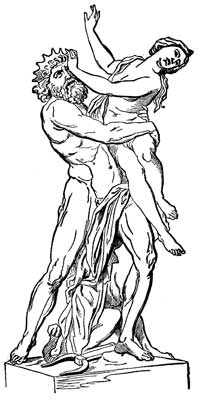 Fig. 111.—Rape of Proserpine.
Fig. 111.—Rape of Proserpine.Bernini executed a statue of St. Bibiana for the church of that saint at Rome, and one of St. Longinus in one of the niches to the dome of St. Peter's; he also made the designs for the one hundred and sixty-two statues in the colonnades of St. Peter's, and for the decorations of the bridge of St. Angelo; in such works, almost without exception, he chose some moment in the lives of the persons represented that called for a striking attitude and gave an opportunity for an effect that is often theatrical. As a mere decoration such statues have a certain value of an inferior sort; but as works of art, as intellectual efforts, they are worthless. However, this decorative effect, as it is seen on the façade of the Lateran, where the figures stand out against the sky, or on the bridge of St. Angelo, is not by any means to be despised; only we cannot call a sculptor a great artist when he can do nothing finer than this.[Pg 226]
Some of Bernini's works in which he shows intense suffering have more genuine feeling, and are finer in artistic qualities. One of these is Pietà, in the chapel of St. Andreas Corsini in the Lateran. But he frequently goes beyond the bounds of good taste, as, for example, on the monument to Pope Urban VIII., in St. Peter's, where he represents Death with his bony hand writing the inscription on the panel; this is truly terrible, and not less so is another Death upon the monument of Alexander VII., raising the marble curtain before the entrance to the vault, as if he were inviting one to walk in. Many objections can be made to his draperies. He exaggerated the small curtains seen on some ancient tombs until they were huge objects of ugliness; the drapery upon his figures is so prominently treated that instead of being a minor object it sometimes seems like the principal one; it no longer serves to conceal forms, and at the same time show their grace and motion, but it is inflated, fluttering, grotesque in form and quite absurd when compared with statues in which it answers its true purpose.
Charles I. of England heard so much of Bernini that he desired to have a statue of himself executed by this sculptor; three of Vandyck's portraits of the king were sent to him, and the likeness of the statue was so satisfactory to the monarch that he sent the artist six thousand crowns and a ring worth as much more.
Bernini executed a colossal equestrian statue of Constantine for the portico of St. Peter's; he made another of Louis XIV., which was changed into a Marcus Curtius, and sent to Versailles. He also executed the fountain in the Piazza Navona, at Rome, which is one of his exaggerated works.
François Duquesnoy (1594-1646) was born at Brussels, and was known in Rome as Il Fiammingo. The Archduke Albert sent him to Rome to study, and he was a contemporary of Bernini. When his patron died Duques[Pg 227]noy was left without means, and was forced to carve small figures in ivory for his support. His figures of children, which were full of life and child-like expression, became quite famous. An important work of his in this way is the fountain of the Manneken-Pis, at Brussels.
His masterpiece is a colossal statue of St. Andrew in the Church of St. Peter's; it occupied him five years, and is one of the best works of modern art. His statue of St. Susanna in the Church of Santa Maria di Loreto, in Rome, is simple and noble, and is much admired. Little is known of this artist's life, and it is said that he was poisoned by his brother when on his way to France.
There was a goodly company of sculptors following Bernini, but none whose works or life was of sufficient importance or interest to demand our attention here, and we will pass to the sculpture of France, where the arts were less devoted to the service of the Church and more to the uses of kings, princes, and noblemen. The court of France was devoted to pomp and pleasure, and sculpture was used for the glorification of the leaders in all its follies. In one sense this is more agreeable than the art in Italy which we have been considering, for nothing can be more disagreeable than a false religious sentiment in art; it is only when the artist is filled with true devotion and feels deeply in his own soul all that he tries to express in his work that religious representations can appeal to us agreeably or benefit us by their influence.
Simon Guillain (1581-1658) is especially interesting as the sculptor of the statue of Louis XIV. as a boy, which is in the Louvre; those of his parents are also there; formerly they decorated the Pont au Change. Other works by this master are in the same museum.
Jacques Sarrazin (1588-1660) is only known by his works, which are now in the Louvre, of which a bronze bust of the Chancellor Pierre Séguier is worthy of notice.[Pg 228]
François Anguier (1604-1669) was born at Eu, in Normandy, and was the son of a carpenter, who taught his son to carve in wood at an early age. When still quite young François went to Paris to study, and later to Rome. He became one of the first artists of his time in France, and was a favorite of the king, Louis XIII., who made him keeper of the gallery of antiquities, and gave him apartments in the Louvre. Most of his important works were monuments to illustrious men. His copies of antique sculptures were very fine.
Michel Anguier (1612-1686) was a brother of the preceding, with whom he studied until they both went to Rome. Michel remained there ten years, and was employed with other artists in St. Peter's and in some palaces. In 1651 he returned to Paris, and assisted François in the great work of the tomb of the Duke de Montmorenci at Moulins.
Michel executed a statue of Louis XIII., which was cast in bronze. He adorned the apartments of Queen Anne of Austria in the Louvre, and for her executed the principal sculptures in the Church of Val de Grace; a Nativity in this church is his best work. His sculptures are seen in various churches, and he also executed statues of ancient gods and vases for garden ornaments. He was a professor in the Academy of Arts in Paris, and wrote lectures on sculpture.
François Girardon (1630-1715), born at Troyes, was a protégé of the Chancellor Séguier. Louis XIV. gave him a pension, by which he was enabled to study in Rome, and after his return to France the king gave him many commissions. The monument to Cardinal Richelieu in the Church of the Sorbonne is from the hand of this sculptor. Perhaps his best-known work is the Rape of Proserpine at Versailles. He made an equestrian statue of Louis XIV., which was destroyed in the Revolution; a model of it in bronze is in[Pg 229] the Louvre. His bust of Boileau is a strong, fine work. Many of his sculptures were destroyed by the revolutionists.
A devoted follower of Bernini was Pierre Puget (1622-1694). His works are seen at the Louvre and at Versailles. His group of Milo of Crotona endeavoring to free himself from the claws of the lion is full of life and is natural, but the subject is too repulsive to be long examined; his Perseus liberating Andromeda is more agreeable, and is noble in its forms and animated in expression. His Alexander and Diogenes is in relief, and is effective and picturesque.
Antoine Coysevox (1640-1720) was born at Lyons, and manifested his artistic talent very early in life. Before he was seventeen years old he had distinguished himself by a statue of the Virgin, and progressed rapidly in his studies, which he made in Paris. In 1667 he was engaged by Cardinal Furstenburg to go to Alsace to decorate his palace; this occupied him four years. When he again went to Paris he became a very eminent artist. He executed a statue of Louis XIV., and received a commission from the province of Bretagne for an equestrian statue of the same monarch.
Among his best works are the tomb of Cardinal Mazarin; the tomb of the great Colbert in the Church of St. Eustache; the monument of Charles le Brun in the Church of St. Nicolas; the statue of the great Condé; the marble statue of Louis XIV., in the Church of Notre Dame, and others. In the tomb of Mazarin he showed fine powers of construction and excellence of design. The kneeling figure of the minister is a dignified statue and well executed; the statues in bronze of Prudence, Peace, and Fidelity, and the marble figures of Charity and Religion are each and all noble works, and free to a remarkable degree from the mannerisms and faults of his time.
Nicolas Coustou (1658-1733) was a nephew and pupil of Coysevox. He took the grand prize at Paris, and went to Rome to study when he was twenty-three years old. He[Pg 230] made many copies of the antique. After his return to France he was much employed. His chief work was a colossal representation of the Junction of the Seine and the Marne. He also made for the city of Lyons a bronze statue representing the river Saone. Some of his sculptures are in the Church of Notre Dame.
Guillaume Coustou (1678-1746), brother of Nicolas, also gained the grand prize and went to Rome, and on his return made a fine reputation. Much of his best work was for the gardens of Marly; he executed a bronze statue of the Rhone at Lyons; a bas-relief of Christ with the Doctors, at Versailles, and statues of Louis XIV. and Cardinal Dubois, in the Museum of French Monuments.
Jean Baptiste Pigalle (1714-1785) is the last French sculptor of whom I shall speak here. He was born in Paris, and gained his first fame by a statue of Mercury; but his masterpiece was the tomb of Marshal Moritz of Saxony, in the Church of St. Thomas, at Strasburg. The soldier is represented in his own costume, just as he wore it in life, about to enter a tomb, on one side of which stands a skeleton Death, and on the other a mourning Hercules. A statue representing France tries to hold him back, and a Genius attends on him with an inverted torch. There are many accessories of military emblems and trophies. There have been several engravings made from this tomb, the best part of which is the figure of the Marshal.
Pigalle was a favorite with Mme. Pompadour, of whom he made a portrait statue. She employed him to do many works for her. His best monument in Paris is that of the Comte d'Harcourt, in the Church of Notre Dame.
In the Netherlands, as in Italy, the painting of the time had a great effect upon sculpture, and it was full of energy, like the pictures of the Rubens school; at the same time there remained traces of the traditions of former days, and while a great change had come since the days of Vischer,[Pg 231] there was still a firm adherence to nature, and no such affectations and mannerisms existed here as were seen in the works of Bernini and his followers in Italy and France.
 Fig. 112.
Fig. 112.One of the ablest sculptors of his day was Arthur Quellinus, who was born at Antwerp in 1607. He studied under Duquesnoy, and was especially happy in his manner of imagining his subjects, and of avoiding the imitation of others or a commonplace treatment of his own. The magnificent Town Hall of Antwerp was commenced in 1648, and Quellinus received the commission to decorate it with plastic works. His sculptures are numerous, both on the interior and exterior of the edifice. In the two pediments he introduced allegorical representations of the power of the city of Antwerp, especially in her commerce. These compositions are picturesque in their arrangement, but the treatment is such as belongs to sculpture; in one of these a figure which represents the city is enthroned like a queen, and is surrounded by fantastic sea-gods, who offer their homage to her. (Fig. 112.)
We cannot give a list of many detached works by Quellinus, but one of the best of the old monuments in Berlin is attributed to him. It is the tomb of Count Sparr in the Marienkirche.
At the present day Berlin is a city of much artistic importance, and the beginning of its present architectural and sculptural prominence may be dated at about the end of the seventeenth century, not quite two hundred years ago. One of the most influential artists of that time was Andreas Schlüter (1662-1714), who was born in Hamburg. His father was a sculptor of no prominence, but he took his[Pg 232] son with him to Dantzig, where many Netherlandish artists were employed upon the buildings being constructed there. Andreas Schlüter was naturally gifted, and he devoted himself to the study of both architecture and sculpture, at home and later in Italy. Before he was thirty years old he was employed in important affairs in Warsaw, and in 1694 he was summoned to Berlin, where he executed the plastic ornaments of the Arsenal; the heads of the Dying Warriors above the windows in the court-yard are remarkable works. They are very fine when regarded only as excellent examples of good sculpture, and they are very effective placed as they are, for they seem to tell the whole tragic story of what a soldier's life and fate must often be (Fig. 113).
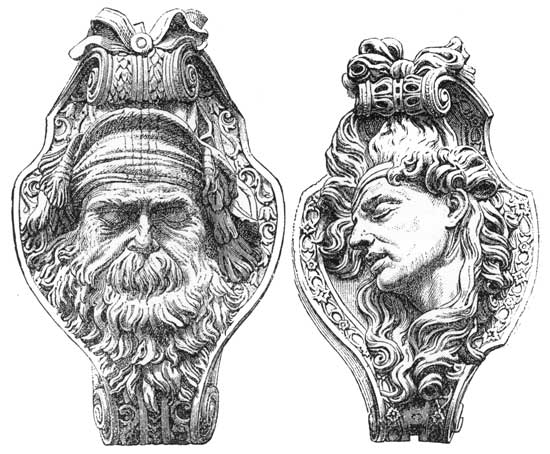 Fig. 113.—Heads of Dying Warriors.
Fig. 113.—Heads of Dying Warriors.However, the masterpiece of this sculptor is the equestrian statue of the Great Elector for the long bridge at Berlin, which was completed in 1703 (Fig. 114). Lübke says of this: "Although biassed as regards form by the age which prescribed the Roman costume to ideal portraits of this kind, the horseman on his mighty charger is conceived with so much energy, he is filled with such power of will, he is so noble in bearing and so steady in his course, that no other equestrian statue can be compared with this[Pg 234] in fiery majesty. Equally masterly is the arrangement of the whole, especially the four chained slaves on the base, in whom we gladly pardon a certain crowding of movements and forms."
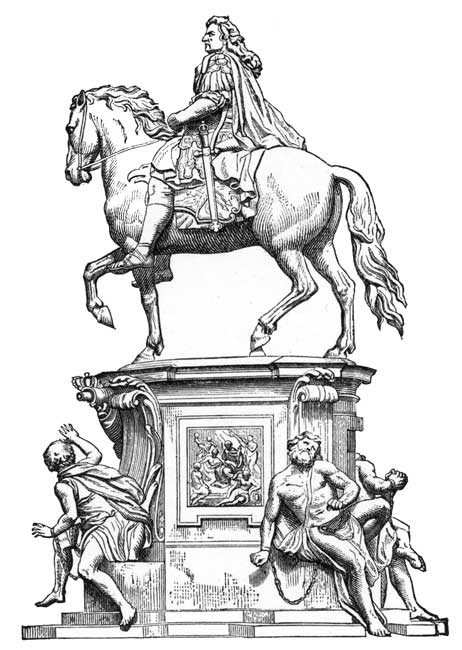 Fig. 114.—The Great Elector.
Fig. 114.—The Great Elector.Schlüter also made a statue of the Elector Frederic III., which is now in Königsberg. Besides his works in sculpture he was the architect of the royal palaces at Potsdam, Charlottenburg, and Berlin, and there are many sculptures by him at these places. When he was thus in an important position and at the height of professional prosperity he met with a sad misfortune, from the effects of which he never recovered. A chime of bells had been purchased in Holland, and Schlüter was commissioned to arrange an old tower for their reception. He carried it higher than it had been, and was proceeding to finish it, when it threatened to fall, and had to be pulled down. On account of this Schlüter was dismissed from his position as court architect; and though his office of sculptor was left to him his power was gone, and he was broken down in spirit. He was called to St. Petersburg by Peter the Great, and died soon after. Now, the verdict of judges is that he was one of the greatest artists of his age, and that his works, both in sculpture and architecture, belong to the noblest productions of his century.[Pg 235]

In the middle of the eighteenth century the arts had fallen into such a feeble state that a true artistic work—one conceived and executed in an artist spirit—was not to be looked for. As in the Middle Ages, too, thought seemed to be sleeping. Both art and letters were largely prostrated to the service of those in high places; they were scarcely used except for the pleasure or praise of men whose earthly power made them to be feared, and because they were feared they were flattered openly and despised secretly.
But about the end of the century another spirit arose; a second Renaissance took place, which may be traced in literature and in art, as it may be in the movement of political events and an independence of thought everywhere.
Naturally the question as to where artists could turn for their models was an important one, and as before in various epochs in art the antique had been the "only help in time of trouble," so it proved again. In 1764 Winckelmann published his "History of Ancient Art," in which the rich significance of classic art was clearly placed before the student. The service which this author rendered to art can scarcely be over-estimated, coming, as it did, at a time when the genius of art seemed to have turned his back upon the world, and all true inspiration was lost. At about the same time the monuments of Athens were recalled to[Pg 236] the European world by Stuart and Revett in their architectural designs, and by the end of the century the study of the antique had done its transforming work, and artists were striving for more worthy ends than the favor of kings and powerful patrons. This new study of classic art did not show its full and best results until the Danish sculptor Thorwaldsen executed his works; but before his time others were striving for that which it was his privilege to perfect.
Among the earliest and most famous of these eighteenth-century reformers was the Venetian, Antonio Canova (1757-1822). He was born in Possagno, and was the son and grandson of stone-cutters. His father died when he was very young, and he was thus left to the care and instruction of his grandfather, the old Pasino Canova, who lost no time in accustoming the boy to the use of the chisel, for there are cuttings in existence which were executed by Canova in his ninth year. Signor Giovanni Faliero dwelt near Possagno, and was in the habit of employing Pasino Canova frequently; he entertained such respect for the old stone-cutter that he sometimes asked him to spend a few days at his villa. On these visits the old man was accompanied by Antonio, who soon became a favorite with all the family of Faliero, and a friend of the young Giuseppe.
On one occasion when Pasino and the boy attended a festival at Villa Faliero, the ornament for the dessert was forgotten. When the servants remembered it at the last moment they went to the old Pasino in distress, and begged him to save them from the displeasure of the master. The old man could do nothing for them, but the young Tonin, as he was called, asked for some butter, and from it quickly carved a lion. At table this strange ornament attracted the attention of all the guests, and Tonin was called in to receive their praises; from this time the Senator Faliero[Pg 237] became his patron, and he placed the boy under the instruction of Giuseppe Bernardi, called Toretto, a Venetian sculptor who had settled at Pagnano.
At this time Canova was twelve years old; he studied two years under Toretto, and made many statues and models, which are still preserved by the Faliero family, or in other collections. His first really original work was the modelling of two angels in clay; he did these during an absence of his master's; he placed them in a prominent place, and then awaited Toretto's opinion with great anxiety. When the master saw them he was filled with surprise, and exclaimed that they were truly marvellous; from these models the grandfather cut two angels in pietra dura for the high-altar at Monfumo. At this same period Canova made his first representations of the human form; he was accustomed to make small statues and give them to his friends.
When he was fifteen years old Faliero sent for him, and received him into his own family. Canova wished to earn something for himself, and engaged to work half of the day for Giuseppe Ferrari, who was a nephew of his former master, Toretto. Of this time Canova afterward wrote: "I labored for a mere pittance, but it was sufficient. It was the fruit of my own resolution, and, as I then flattered myself, the foretaste of more honorable rewards." This circumstance proves how remarkable he must have been; it is unusual for a boy of fifteen to be paid for work instead of paying for instruction. In Venice he was able to learn much from observation. He divided his time systematically, spending his mornings in the Academy or some gallery, his afternoons in the shop where he was employed, and his evenings in studies for which he had had no opportunity as a child.
The first commission which was given to Canova was from the Commendatore Farsetti for a pair of baskets filled[Pg 238] with fruit and flowers, to be sculptured in marble, and placed on a staircase which led to the picture gallery in the Farsetti Palace, where Canova spent much time in study. These works have no special excellence.
After a year in Venice he went to Asolo with the Faliero family. Some time before this his patron had asked Canova to make for him a group of Orpheus and Eurydice, taking the moment when Eurydice beholds her lover torn away from her forever. Canova had been busy with this in his leisure hours in Venice, and he took with him to Asolo everything necessary to the work. He completed the Eurydice in his sixteenth year; it was life-size, and cut from pietra di Costosa.
With this first attempt Canova became convinced that the small models such as were in use by sculptors were quite insufficient to good work, and he determined that his models should be of the size which the finished work would have, even when colossal.
After this time he had his studio in a cell of the monastery of the Augustine friars attached to the Church of San Stefano, in Venice. During the next three years he was occupied with his Orpheus and a bust of the Doge Renier. At this time he studied entirely from nature; he devoted himself to the pursuit of anatomy, and after a time was accustomed to make dissections in order to sketch or model from important parts or some conformations that he desired in particular instances.
In 1776 his Orpheus was finished and exhibited, and it chanced to be at the annual festival of the Ascension, when the opera of Orpheus was brought out in Venice. Canova was accustomed to say that the praise he then received was "that which made him a sculptor;" and so grateful was he for it that later, when he became Marquis of Ischia, he chose for his armorial ensigns the lyre and serpent which are the mythological symbols of Orpheus and Eurydice. The[Pg 239] Senator Grimani ordered a copy of the Orpheus, and this was the first work of Canova in Carrara marble.
He soon found his workshop too small, and removed to one in the street of San Maurizio, where he remained until he left his native country. His next work was a statue of Æsculapius, larger than life; a short time before his death, when he saw this statue, he sorrowfully declared that "his progress had by no means corresponded with the indications of excellence in this performance of his youth." About this time he executed an Apollo and Daphne which was never entirely finished, and when twenty-two years old he completed a group of Dædalus and Icarus for the Senator Pisani. This was intended for an exterior decoration of his palace; but when it was done Pisani considered it worthy of a place in his gallery, already famous on account of the painting of Darius and his Family, by Paul Veronese, and other fine works. This may be called Canova's last work in Venice, as he went to Rome soon after his twenty-third birthday.
The Cavaliere Zuliani was then the representative of Venice in Rome, and Faliero gave Canova letters to him. Zuliani was an enlightened patron of art, and he received the young sculptor with great kindness, and soon arranged to have his model of Dædalus and Icarus exhibited to the best artists and judges of art in Rome. We can fancy the anxiety with which Canova went to this exhibition; but the praise which he there received secured for him a place among the artists then in Rome.
Canova had a great desire to undertake a group of some important subject, and Zuliani was his friend in this; for he gave him the marble, and promised if no other purchaser appeared to give him the full value of the work when completed. He also gave him a workshop in the Venetian Palace, to which no one had access, where he could be entirely free and undisturbed. The subject chosen for the[Pg 240] group was Theseus vanquishing the Minotaur, and the size was to be colossal. Canova now worked with untiring devotion; he was often seen before the statues on Monte Cavallo, with sketch-book in hand, as soon as it was light enough for him to see, and he studied faithfully in the museums and galleries of Rome. His friends in Venice had secured for him a pension of three hundred ducats, which placed him above want, and he was free to devote himself to his Theseus, although while at work on that he made a statue of Apollo, which was exhibited with Angelini's Minerva, and received much praise.
Meantime no one knew of the Theseus save the ambassador. When it was finished Zuliani prepared it for exhibition, and invited all the most distinguished men in Rome to an entertainment. A model of the head of Theseus was put in a prominent place, and the guests were busy in discussing it; they asked questions and expressed opinions, and when their interest was well awakened Zuliani said: "Come, let us end this discussion by seeing the original," and the statue was unveiled before their eyes. Canova often declared that death itself could not have been more terrible to him than were those moments. But he and all else were forgotten in the surprise and admiration which the group excited; in that hour the artists who afterward hated him gave him their sincere praise. From that day the fame of Canova was established.
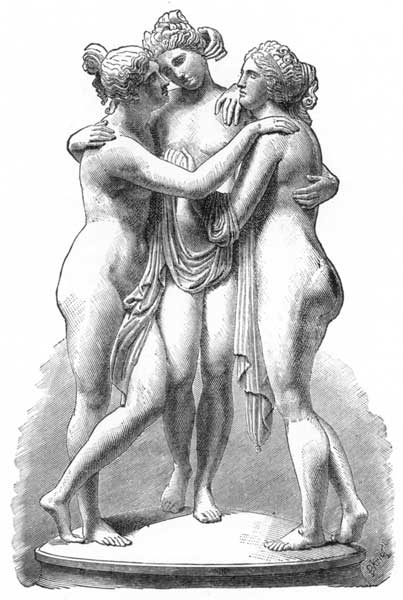 Fig. 115.—The Three Graces.
Fig. 115.—The Three Graces.Very soon he was selected to erect a monument to Clement XIV. This pope was a famous man; he was the collector of the Clementine Museum, the author of the elegant letters known by his family name of Ganganelli, and, above all, he was the suppressor of the Jesuits. While Canova felt the honor that was thus offered him he also thought himself bound to consult those who had conferred his pension upon him, and thus helped him to become the artist that he was. He went, therefore, to Venice and[Pg 242] sought direction from the Senate; he was told to employ his time as should be most profitable to himself. He therefore gave up his studio in Venice, and as his patron, Zuliani, had now left Rome, he fitted up the studio in the Strada Babbuino, which became so well known to lovers of art of all nations who visited Rome. In 1787 the above monument was exhibited, and was much admired. An engraving was made from it and dedicated to Zuliani; but Canova desired to do something more worthy for his patron, and made a statue of Psyche as a gift to him; Zuliani hesitated to accept it, but finally consented to do so if Canova would in turn accept a number of silver medals with the Psyche on one side and a head of Canova on the other, which he could give to his friends. In the midst of all this Zuliani died, and his heirs were so angry because he had left works of art to the Public Library that they refused to carry out his plans. In the end the Psyche was bought by Napoleon and presented to the Queen of Bavaria.
Canova executed a second papal monument to Pope Clement XIII. It was erected in St. Peter's by his nephews. The mourning genius upon it is frequently mentioned as one of Canova's happiest figures. The execution of these two monuments occupied almost ten years of the best part of this sculptor's life.
Canova's fame had extended over all Europe, and he was asked to go to St. Petersburg, and offered most advantageous terms if he would do so; but he declined, and executed the monument of Admiral Emo, on a commission from the Venetian Senate. For this work he received a gold medal and an annuity for life.
In 1798, during the revolutionary excitement at Rome, Canova went to Possagno, his native town. Here, in his retirement, he painted more than twenty pictures, which were by no means to be despised. His masterpiece represented the Saviour just taken from the cross, and sur[Pg 243]rounded by the Marys, St. John, Nicodemus, and Joseph of Arimathea. This was the first of the many gifts which he made to this little church, by which it became a splendid temple and the expression of Canova's love for his birthplace and early home.
After he returned to Rome his health was not sufficient to allow of his usual close application to work, and he went to Berlin and Vienna in company with Prince Rezzonico, and this so benefited him that he was able to resume his labors with new energy. He soon achieved a proud triumph, for his Perseus was placed in one of the Stanze of the Vatican by a public decree; this was the first modern work which had been thus honored.
In 1802-1803 Napoleon requested Canova to go to Paris to model a portrait bust for a colossal statue; the work was finished six years later. In 1805 the artist went again to Vienna, where he modelled a bust of the Emperor of Austria; in 1810 again to Paris to prepare a model for the statue of Maria Louisa. With the exception of these short journeys he was constantly at work in his Roman studio until 1815, when he was sent in an official capacity to France by the pope, for the purpose of reclaiming the works of art which had been carried from Italy in times of war, and which really belonged to the patrimony of the Church. Canova executed his commission with rare judgment, and then continued his journey to England. In London he received many honors; the king gave him an order for a group, held several conversations with him, made him valuable gifts, and intrusted him with a private letter to the pope.
Canova returned to Rome on January 5th, 1816. His entry might almost be called a triumphal one, for the people of Rome were so grateful for the restoration of their treasures that they expressed their joy in demonstrations to Canova. He had been President of St. Luke's Academy[Pg 244] before; he was now made President of the Commission to purchase works of art, and of the Academy of Archæology. In full consistory of all the high officers of the Church, the pope caused his name to be inscribed upon the "golden volume of the Capitol," and conferred upon him the title of Marquis of Ischia, with a pension of three thousand crowns a year.
Canova now determined to execute a colossal statue of Religion, which should commemorate the return of the pope from banishment. He endeavored to persuade the authorities to decide where it should be placed; this was not done, and he was much grieved at his failure to carry out the idea. But he determined that from this time he would devote his life and fortune to religion, and resolved to erect a church at Possagno, to adorn it with works of art, and to make it his own burial-place.
On July 8th, 1819, Canova assembled his workmen in his native town, and gave them a fête; many peasant girls joined in the festivities and assisted in the breaking of the ground; at evening, as they all passed before Canova to bid him farewell, each one received a gift from him. Three days later the religious ceremony of laying the corner-stone of the future church took place. An immense number of people from the surrounding country and from Venice were present; Canova, in his robes as a Knight of Christ, and wearing the insignia of other orders, led the procession; all who had seen Canova when a poor boy in their midst were much impressed by this occasion. Here, in a public manner, he consecrated his life and fortune to the service of God and the benefit of his birthplace. Every autumn Canova went to Possagno to encourage the workmen and to give directions as to how the whole should be done. Between these visits he worked devotedly, for he was forced to earn all he could in order to pay for his great undertaking.[Pg 245]
At this time he executed a statue of Washington, and was making an equestrian statue of Ferdinand of Naples, and in the month of May, 1822, went to that city, where he fell ill; he returned to Rome, and revived somewhat, and resumed his work. On September 17th he went to Possagno, in October to Villa Faliero, where, fifty years before, he had spent such happy days. From here he went to Venice, and on the 13th of the same month he died.
Solemn services were held in the cathedral, and his remains were then intrusted to the priests of Possagno, who bore them to their temple, where he was buried on the 25th of the month; the crowd was so great that the oration was delivered in the open air. Canova's heart was given to the Academy of Venice, and an elegant little monument was erected in the Palace of Arts to contain this relic of the sculptor. The Venetian artists arranged to erect to him a monument, and chose the design which he himself had made for the tomb of Titian; it is in the Church of Santa Maria de' Frari. In Rome a statue was decreed to him, and he was declared the perpetual President of her chief academy.
In personal appearance Canova was not grand or very attractive. His head was remarkably well placed upon his shoulders, and the loose manner in which he dressed his neck allowed this to be seen; his forehead was a noble one, his hair black, and his whole manner and dress was modest and simple. His habits were very orderly and quiet; he rose early to work, and went little into public society; but he welcomed a few friends to dinner almost daily. He entertained them cordially, but without display, and led the conversation to light, cheerful topics that did not touch upon art, or demand mental exertion. At eleven o'clock he retired to his own room and amused himself with a book or pencil before sleeping. Some of his best drawings were made at this hour, and have been published with the title of[Pg 246] "Pensieri," or thoughts. To describe one day was to give a picture of all, so regular were his habits of life.
In his professional life he was just and generous to others, and though he would have no pupils, he would leave everything to advise an artist or visit his works. He was also a patron of art, and had executed, at his own expense, the numerous busts of distinguished persons in the Capitoline Museum.
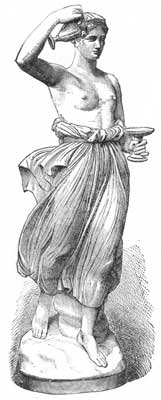 Fig. 116.—Hebe.
Fig. 116.—Hebe.There is a story of a romance in his life. It is said that when he first arrived in Venice he fell in love with a beautiful girl who was older than himself, who went to draw in the Farsetti Gallery. Day by day he watched her until she came no more; at length her attendant returned, and Canova inquired for her mistress; she burst into tears and answered, "La Signora Julia is dead." He asked no more, and never knew who Julia was or any circumstances of her history; but all his life he treasured her image, and when he endeavored[Pg 247] to unite the purity of an angel with the earthly beauty of a woman, the remembrance of Julia was always in his mind.
Canova was one of the few artists who received their full merit of praise and the benefits of their labors while alive. Without doubt he was a great sculptor, and coming as he did, at a time when art was at its worst, he seemed all the more remarkable to the men around him. But the verdict of to-day would not exalt him as highly as did his friends and patrons. His statues lack the repose which makes the grandest feature of the best sculpture; his female figures have a sentimental sort of air that is not all we could wish, and does not elevate them above what we may call pleasing art. His male figures are better, more natural and simple, though some of his subjects bordered on the coarse and brutal, as in the two fencers, Kreugas and Damoxenes, or Hercules and Lichas. But in his religious subjects he is much finer, and in some of his monuments he shows dignity and earnestness, while his composition is in the true artistic spirit. Taken on the whole, he was a wonderful artist and a man of whom his century might well be proud.
Other sculptors of this period and of different nations studied at Rome, and devoted themselves to the antique with enthusiasm. One of these was Antoine Denis Chaudet (1763-1810), who was born at Paris. His talent was so early developed that he was admitted to the Royal Academy when fourteen years old, and when twenty-one he gained the first prize, and with the royal pension went to Rome, where he remained five years. He soon took good rank among artists of that time, for he was a designer and painter as well as sculptor. He adhered strictly to the antique style, and attained much purity, though he was always cold in treatment. He was made a Professor of Sculpture in the French Academy, and made valuable contributions to the "Dictionary of Fine Arts."[Pg 248]
Chaudet's principal works in sculpture were the silver statue of Peace in the Tuileries; a statue of Cincinnatus in the Senate Chamber; a statue of Œdipus; a bas-relief of Painting, Sculpture, and Architecture, in the Musée Napoléon, and many busts and smaller works.
He also designed numerous medals and some of the illustrations for a fine edition of Racine, and painted a picture of Æneas and Anchises in the Burning of Troy.
Johann Heinrich Dannecker (1758-1841) was born at Stuttgart. By a statue of Milo he gained the prize of the academy founded by Duke Charles Eugene, and with the royal pension he went first to Paris and then to Rome, where he studied seven years. He then returned to Würtemberg, and was made Director of the Royal Academy, with a salary of fifteen thousand francs a year. During fifteen years Dannecker maintained a high rank in his art, but his health became so feeble that he was forced to see others excel him. One of his works has a wide reputation, and is known to many people the world over, through the generosity of Herr Bethmann of Frankfort, who admits visitors to his gallery, and from the models and pictures which have been made from it; it is the Ariadne on a Panther (Fig. 117).
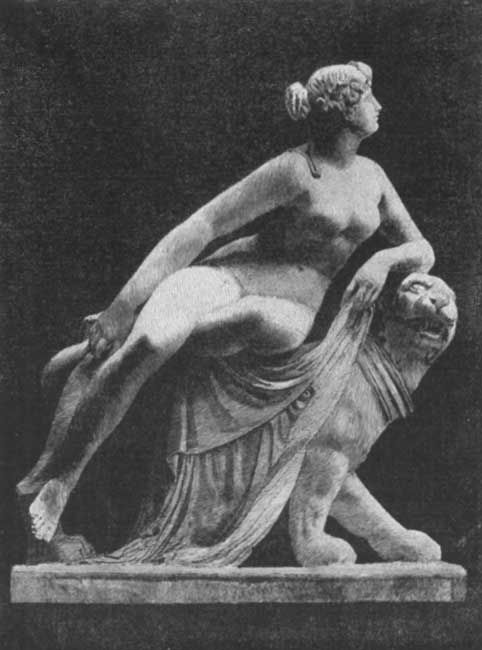 Fig. 117.—Ariadne and the Panther.
Fig. 117.—Ariadne and the Panther.Dannecker had a delicate feeling for nature; his figures were light and graceful, and his heads were noble in expression. He labored eight years upon a figure of Christ, which belongs to the Emperor of Russia; in Stuttgart a nymph pouring water on Neckar Street and two nymphs on a reservoir in the palace garden show his fine taste in architectural sculpture. Among his other works are a statue of Alexander, a monument to Count Zeppelin, a Cupid, and a Maiden lamenting a Dead Bird. Some of his works are among the very best productions of modern sculpture; his portraits are noble and true to nature; the works named here are by no means all that he did, and we should add[Pg 250] that his efforts in religious subjects exhibit a pure sense of the beautiful, and a true conception of Christian ideas.
We come now, for the first time, to a great English sculptor. John Flaxman (1755-1826) was born in York, but while he was still an infant his father removed to London, where he kept a plaster-cast shop. The boy began to draw and even to model very early; when but five years old he kept some soft wax, with which he could take an impression from any seal or ring or coin which pleased him. He was very delicate in health, and was once thought to be dead, and was prepared for burial, when animation returned; his parents tried to gratify all his wishes, and while a child he modelled a great number of figures in wax, clay, and plaster.
By the time he was ten years old he was much stronger, and was able to use the activity which corresponded to his enthusiastic feeling and imagination. About this time he read "Don Quixote," and was so moved by the adventures of that hero that he went out early one morning armed with a toy sword and bent upon protecting some forlorn damsel; he went to Hyde Park and wandered about all day, not finding any one who was in need of his services. At night he returned home, very hungry and weary, to find his family in great alarm over his unusual absence.
He now spent all his time in drawing and modelling, and never had more than two lessons from a master; at eleven years of age he began to gain various prizes, and at fourteen was admitted to study at the Royal Academy, and gained the silver medal there that same year. About this time he made some friends who aided him to study the classics and to learn more of history, all of which was of great use to him in his art. He was also fortunate in having the friendship of Mr. Wedgwood, for whom he made many models. He also painted a few pictures in oil.
Among his earliest sculptures were a group of Venus[Pg 251] and Cupid and a monument to Mrs. Morley, who, with her baby, died at sea. Flaxman represented the mother and child rising from the sea and being received by descending angels.
In 1782 Flaxman married Miss Ann Denman, whose intelligence and love of art were of great assistance to her husband. In 1787 he went to Rome, where he remained seven years. During this time he made a group for Lord Bristol, representing the Fury of Athamas, from the Metamorphoses of Ovid; this work cost him much labor, for which he received but small pay; it was carried to Ireland and then to Ickworth House, in Suffolk, where but few people see it. In Rome Flaxman also made a group of Cephalus and Aurora for Mr. Thomas Hope, and the designs from Homer, Æschylus, and Dante, which have such a world-wide fame.
In 1794 he returned to England, where he was constantly employed on important works until his death. We cannot give a list of his numerous works. Many of his monuments are seen in the churches of England. In Glasgow are his statues of Mr. Pitt and Sir John Moore, in bronze; in Edinburgh is that of Robert Burns. Flaxman executed much sculpture for the East Indies, one of these works being unfinished when he died. Some critics consider his Archangel Michael and Satan his best work; it was made for the Earl of Egremont, who had his life-size Apollo also.
In 1797 Flaxman was elected an Associate of the Royal Academy, in 1800 an Academician, and in 1810, when a Professor of Sculpture was added to the other professors of the Academy, he was appointed to the office. His lectures have been published. The friezes on the Covent Garden Theatre were all designed by Flaxman, and he executed the figure of Comedy himself. His last work was making designs for the exterior decoration of Buckingham Palace,[Pg 252] which would have been entirely under his direction and partly executed by him if he had lived.
His wife died in 1820, and her loss was a grief from which he could not recover; she had been a great advantage to him, and he had depended much upon her sympathy and counsel. Flaxman was a singularly pure man, and so attractive in manner that he was the friend of old and young alike.
Sir Richard Westmacott succeeded Flaxman as Professor at the Royal Academy; he said: "But the greatest of modern sculptors was our illustrious countryman, John Flaxman, who not only had all the fine feeling of the ancient Greeks (which Canova in a degree possessed), but united to it a readiness of invention and a simplicity of design truly astonishing. Though Canova was his superior in the manual part, high finishing, yet in the higher qualities, poetical feeling and invention, Flaxman was as superior to Canova as was Shakespeare to the dramatists of his day."
But the perfection of the results of the study of Canova and others who endeavored to raise sculpture to its ancient glory was seen in the Dane, Bertel Thorwaldsen (1770-1844), who was born in Copenhagen. The descent of this artist has been traced to memorable sources in two quite distinct ways. Those who claim that the Norsemen discovered America relate that during their stay upon this coast a child was born, from whom Thorwaldsen's descent can be distinctly followed. The learned genealogists of Iceland say that his ancestors were descended from Harald Hildetand, King of Denmark, who, in the eighth century, was obliged to flee, first to Norway and then to Iceland, and that one of his descendants, Oluf Paa, in the twelfth century, was a famous wood-carver. But this much is certain: in the fourteenth century there lived in Southern Iceland a wealthy man, whose family and descendants were much hon[Pg 253]ored. One of these, Thorvald Gottskalken, a pastor, had two sons and but a small fortune; so he sent his sons to Copenhagen, where one became a jeweller and died young; the other, who was a wood-carver, was the father of the artist, whose mother was Karen Gröulund, the daughter of a Jutland peasant.
The father was employed in a shipyard, and carved only the rude ornaments of vessels and boats; but these served to lead the mind of the little Bertel to the art he later followed. His father could not have dreamed of such a future as came to his son, but he was wise enough to know that the boy might do more and better than he had done, and he sent him, when eleven years old, to the free school of the Royal Academy to study drawing; and very soon the works of the father showed the gain which the son had made, for his designs were those now used by the old wood-carver.
Bertel was also sent to study his books at the school of Charlottenburg, and here he was so far from clever that he was put in the lowest class. When Bertel gained his first prize at the academy the chaplain of the school at Charlottenburg asked him if the boy who had taken the prize was his brother. He looked up with surprise, and blushing, said, "It is myself, Herr Chaplain." The priest was astounded at this, and said, "Herr Thorwaldsen, please to pass up to the first class."
The boy was amazed at these honors, and from this day retained the title of "Herr," which gave him much distinction. When, after many years, the sculptor had been loaded with honors, and stood on the heights of fame, he was accustomed to say that no glory had ever been so sweet to him as that first rapture which came from the words of the Chaplain Höyer when he was seventeen years old and a poor school-boy.
The effect of this first prize seemed to be to rouse his[Pg 254] ambition, and he worked with the greatest diligence and earnestness. Two years later he made a bas-relief of Love in Repose, which took the large silver medal. His father now thought him prepared to enter on the life of a ship's carver, and Bertel made no objection to doing so; but the painter Abildgaard, who had been his teacher in the academy, had grown very fond of him, and saw how much talent he had, and could not think of his being but a common tradesman without deep regret. He went, therefore, to the old carver, and after some difficulty obtained his consent that his son should spend half his time in study at the academy, and the other half in the earning of his daily bread at his father's side.
In 1790, when twenty years old, Thorwaldsen made a medallion of the Princess of Denmark, which was so good a likeness that a number of copies was sold. A year later he gained the small gold medal of the academy by a bas-relief of the Expulsion of Heliodorus from the Temple. The Minister of State now became interested in the young artist, and measures were taken to aid him to go on with his studies. His patrons desired him to study the subjects of the antique sculptures, and he chose that of Priam begging the Body of Hector from Achilles. Later in life he repeated this subject, and it is interesting to notice the strength and grandeur of the second when compared with the weakness of the first. And yet it was from the latter that predictions were made of Thorwaldsen's future greatness. In 1793 he gained the prize which entitled him to travel and study three years at the expense of the academy. The work he presented was a bas-relief of Saint Peter healing the Paralytic. In these works this sculptor already showed two qualities which remained the same through his life; in his subjects from antiquity he showed a Greek spirit, which has led some writers to speak of him as a "posthumous Greek," or a true Greek artist born after[Pg 255] other Greek artists had died; on the other hand, when he treated religious subjects his spirit was like that of the best masters of the Renaissance, and these works remind us of Raphael. All this excellence came entirely from his artistic nature, for outside of that he was ignorant; he knew nothing of history or literature, and was never a man of culture as long as he lived. Outside of the work connected with his profession Thorwaldsen was indolent, and only acquired knowledge of other matters through observation or from the conversation of others.
Although he gained the prize which allowed him to travel in 1793, he did not leave Copenhagen until May, 1796. In the mean time he had done what he could to earn something: he had made designs for book-publishers, given lessons in drawing and modelling, and made some bust and medallion portraits, reliefs, and so on. The vessel in which the young sculptor sailed for Naples was called the Thetis, and the captain engaged to watch over him; the voyage was long, and all on board became fond of Thorwaldsen, though the captain wrote, "He is an honest boy, but a lazy rascal." This opinion is very amusing when we know what an enormous amount of labor he performed. At Naples he remained for some time, and saw and admired all its works of art. He did not reach Rome until about nine months after leaving Copenhagen, but from that time his whole thought and life were changed. He was accustomed to say, "I was born on the 8th of March, 1797; before then I did not exist."
While in Naples Thorwaldsen had been ill, and suffered from a malarial affection, which compelled him to be idle much of the time. But he was always studying the antique statues, and made many copies. Some of the first original works which he attempted were failures, when, at last, he modelled a colossal statue of Jason, which was well received by those who saw it, and made him somewhat[Pg 256] famous in Rome (Fig. 118). Canova praised it, and other critics did the same; but Thorwaldsen had no money; the academy had supported him six years; what could he do? Quite discouraged, he was engaged in his preparations for leaving Rome, when Mr. Thomas Hope, the English banker, gave him an order for the Jason in marble. In an hour his life was changed. He was living in Rome not as a student on charity, but as an artist gaining his living. We are forced to add that Mr. Hope did not receive this statue until 1828, and Thorwaldsen has been much blamed for his apparent ingratitude; but we cannot here give all the details of the unfortunate affair.
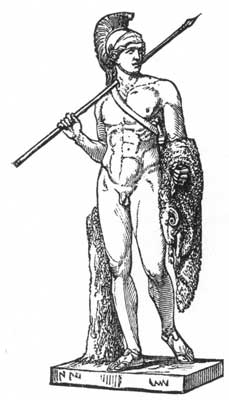 Fig. 118.—Jason.
Fig. 118.—Jason.Thorwaldsen had a true and faithful friend in Rome, the archæologist Zoëga; at his house the young Dane had met a beautiful Italian girl, Anna Maria Magnani, whom he loved devotedly. She was too ambitious to marry a poor sculptor, so she married a rich M. d'Uhden; but she persuaded Thorwaldsen to sign an agreement by which he bound himself to take care of her if she should not agree with her husband and should leave him; this was just what happened in 1803, and the sculptor received her into his house, where she remained sixteen years, when she disappears from his life. He provided an honorable marriage for their daughter.
In 1803 Thorwaldsen also made the acquaintance of the Baron von Schubart, the Danish Minister, who presented[Pg 257] the sculptor to Baron von Humboldt; and through the friendship of these two men, and the persons to whom they presented him, Thorwaldsen received many orders. In 1804 his fame had become so well established that he received orders from all countries, and from this time, during the rest of his life, he was never able to do all that was required of him. He was much courted in society, where he was praised for his art and beloved for his agreeable and pleasing manner. In this same year he was made a Professor of the Royal Academy of Florence; and though the Academy of Copenhagen expected his return, they would not recall him from the scene of his triumphs, and sent him a gift of four hundred crowns. A few months later he was made a member of the Academy of Bologna and of that of his native city, in which last he was also appointed a Professor.
Many circumstances conspired to increase his popularity and to excite the popular interest in him, when, in 1805, he produced the bas-relief of the Abduction of Briseis, which still remains one of his most celebrated works. His Jason had put him on a level with Canova, who was then at the height of his fame; now the Briseis was said by many to excel the same type of works by Canova, and there is no question that in bas-relief the Dane was the better sculptor of the two. This relief and his group of Cupid and Psyche, which was completed in 1805, mark the era at which Thorwaldsen reached his full perfection as a sculptor. In this same year he modelled his first statue of Venus; it was less than life-size; and though two copies of it were finished in marble, he was not pleased with it, and destroyed the model: later he made the same statue in full size.
In 1806 he received his first commission for religious subjects, which consisted of two baptismal fonts for a church in the island of Fionia. But he was devoted to mythological subjects, and preferred them before all others,[Pg 258] and in this same year modelled a Hebe while engaged upon the fonts. His industry was great, but he found time to receive many visitors at his studio, and went frequently into society. At the house of Baron von Humboldt, then Prussian Ambassador at Rome, Thorwaldsen was always welcome and happy; here he met all persons of note who lived in or who visited Rome.
It was at this period that the young Prince Louis of Bavaria entered into a correspondence with Thorwaldsen, which ended only with the sculptor's life. Louis was collecting objects for his Glyptothek at Munich, and he frequently consulted Thorwaldsen in these matters; his advice was of value, and he more than once saved Louis from imposition by dealers. Louis gave the sculptor the order for the fine Adonis, now in the Glyptothek; it was modelled in 1808, but was not completed until 1832; this splendid work was executed entirely by Thorwaldsen's own hands. In 1808 he also received the order for four bas-reliefs to be used in the restoration of the Palace of Christiansborg, which had been injured by fire. This was the year, too, when he was made an honorary member of the Academy of St. Luke.
The year 1809 brought deep sorrows to Thorwaldsen in the death of his two friends, Stanley and Zoëga. He interested himself in the settlement of the affairs of the latter, and had much trouble and anxiety; but he managed to accomplish the modelling of six bas-reliefs in this year, in spite of the disturbed state of Rome on account of the pope's departure, and in spite of the hindrances in his own life.
In 1810 the King of Denmark made Thorwaldsen a Knight of Danebrog, and he was then known in Italy as the Cavaliere Alberto. His work this year was in bas-reliefs, and in 1811 he modelled a colossal statue of Mars, the bust of Mademoiselle Ida Brun, a lovely statue of Psyche, and his own portrait as a colossal Hermes.[Pg 259]
The people of Denmark were growing very impatient at the prolonged absence of their artist. He had left home a mere boy, and was now famous over all the world. They wished for his return; a marble quarry had been discovered in Norway, and even Prince Christian Frederick wrote to Thorwaldsen to urge his going home. The sculptor wished to go, and even made some preparations to do so, when he received so important a commission that it was impossible to leave Rome. This new work was a frieze for one of the great halls in the Quirinal Palace. He chose the Entrance of Alexander the Great into Babylon for his subject, and it proved to be one of the most important works of his life. It was completed in June, 1812; and though it had been somewhat criticised as too rough in its finish, when it was elevated to its proper height it was all that had been expected by the artist's friends; later he repeated this frieze for his own countrymen. In Rome he was now frequently called the "Patriarch of Bas-relief." Soon after this he was made a member of the Imperial Academy of Vienna.
In 1813 Thorwaldsen was again a victim of malignant fever, and visited the baths of Lucca, in company with the Baron and Baroness von Schubart, for the benefit of his health. He met many people and received much honor, especially from the Grand Duchess of Tuscany. His health was improved, but his old and tried friend, the Baroness von Schubart, died the winter following; he felt her loss deeply, for she had been his friend and confidante from the time of his arrival in Rome.
He was always busy, and one after another of his almost numberless works was finished. In 1815 he made the Achilles and Priam, a relief which is sometimes called his masterpiece; in the same year he made the famous and familiar medallions of Night and Morning; it is said that he conceived the first while awake in a sleepless, rest[Pg 260]less condition, and modelled it entirely on the following day; these medallions have been reproduced in all possible forms—in engravings, on cameos, gems, in metals, and a variety of marble, plaster, and porcelain.
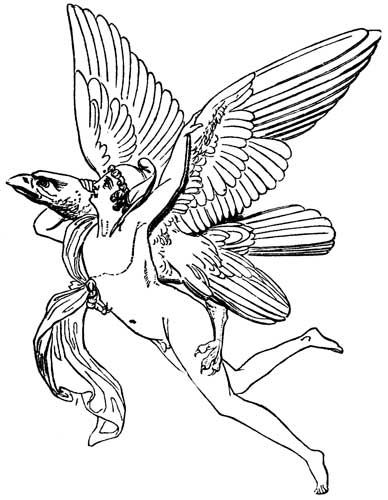 Fig. 119.—Ganymede and the Eagle.
Fig. 119.—Ganymede and the Eagle.About this time Thorwaldsen removed to a spacious studio with gardens, and received pupils, and was overwhelmed with orders, so that he could not yet go to Denmark, in spite of the urgent letters he received. He executed many important original works, and also restored the marbles of Ægina, now at Munich; this was a great task, but his study of the antique had made him better able to do it than was any other modern sculptor.
The exquisite group of Ganymede and the Eagle (Fig. 119) shows the effect of his study of the antique, and the same may be said of his statue of Hope, a small copy of which was afterward placed above the tomb of the Baroness von Humboldt. The Three Graces (Fig. 120) belongs to the year 1817; the Mercury was of about this date, as well as the elegant statue of the Princess Baryatinska, which is his finest portrait statue.[Pg 261]
After an absence from Denmark of twenty-three years he left Rome in July, 1819, and turned his face toward home. His model for the famous Lion of Lucerne had already been sent on before him, and the work commenced by one of his pupils, Bienaimé. Thorwaldsen first went to Lucerne, where he gave all necessary advice in this work, and then proceeding on his journey reached Copenhagen on the 3d of October. Apartments had been prepared for him in the Academy of Fine Arts, and as soon as it was known that he was there he was the centre of attraction and importance. Crowds went to welcome him to his home. A great reception and a grand banquet were given in his honor, and he was lauded to the skies in speeches, and was made a Counsellor of State, in order that he might sit at table with the royal family and not violate the court etiquette.
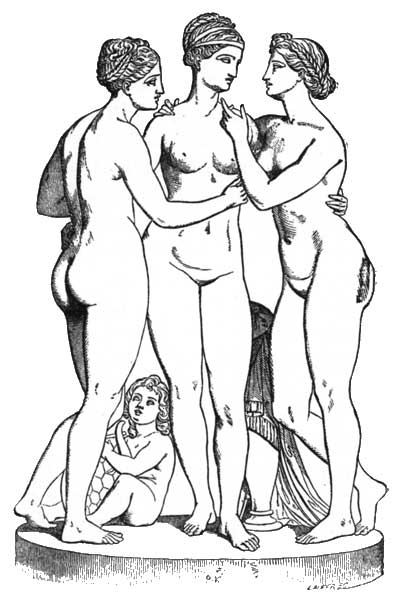 Fig. 120.—The Three Graces.
Fig. 120.—The Three Graces.All this must have gratified the artist, who had earned such proud honors by the force of his genius; but it interests us much more to know that he received commissions[Pg 262] for some very important works, among which those of the Church of Our Lady are very interesting. The orders for all the work which he did here were not given at once, but in the end it became a splendid monument to this sculptor, and embraces almost all his religious works of any importance. There are the figures of Christ and the Twelve Apostles; the Angel of Baptism, which is an exquisite font; the Preaching of St. John the Baptist, which is a group in terra-cotta on the pediment of the church; a bas-relief in marble of the Institution of the Lord's Supper; another in plaster of Christ's Entry into Jerusalem; one of Christ Bearing the Cross; one of the Baptism of Christ; another of the Guardian Angel, and one of Christian Charity.
He did not remain very long in Denmark, but went to Warsaw, where he had been summoned to arrange for some important works. He was presented to the Emperor Alexander, who gave him sittings for a portrait bust; this was so successful that for some years Thorwaldsen employed skilled workmen to constantly repeat it, in order to fill the demand for it which was made upon him. While at Warsaw he received an order for a monument to Copernicus, which was dedicated in 1830; other important commissions were given him, and after visiting Cracow, Troppau, and Vienna, he reached Rome in December, 1820, where he was heartily welcomed by the artists, who gave him a banquet, on which occasion the Prince Royal of Denmark sat next to the sculptor.
Before this a correspondence had established a friendship between Thorwaldsen and Prince Louis of Bavaria; but from the year 1821 intimate personal relations existed between them. He took up work with great energy; he had returned to Rome with so much to do that he required much room, and employed a large company of workmen. In the summer of 1822 he was able to secure a large build[Pg 263]ing which had been used for a stable to the Barberini Palace, and here he was able to set up all his large models.
In 1824 Thorwaldsen was summoned by the Cardinal Consalvi, who gave him the commission for the monument to Pius VII., now in the Clementine Chapel of St. Peter's at Rome; this work was not completed when the cardinal himself died, and his own monument by Thorwaldsen was placed in the Pantheon before that of Pius VII. was put in its place. He also made a cross for the Capuchins for which he would accept no reward, though they were entirely satisfied with it.
In 1825 Thorwaldsen was elected President of the Academy of St. Luke with the advice and consent of Pope Leo XII., who paid him a visit in his studio. Many delays occurred, and the monument to Pius VII. was not erected until 1831.
The works upon which the artist and his assistants were engaged were far too numerous to be mentioned; he was at the very height of fame and popularity, and was forced to refuse some of the commissions sent him. In 1830 he went to Munich to superintend the setting up of his monument to Eugène Beauharnais, the Duke of Leuchtenberg. This gave Louis of Bavaria an opportunity to show his regard for the sculptor, which he did in every possible way. Soon after the monument was unveiled Thorwaldsen received the cross of an officer of the Legion of Honor.
Thorwaldsen's place in Rome was a very important one, not only as an artist, but as a man. He had the respect and esteem of many good men of all nations; he also suffered some things from the envy of those who were jealous of him, as is the case with all successful men; but he was a fearless person, and did not trouble himself on account of these things. The frequent agitations of a political nature, however, did disturb him, and he began to think seriously of returning to Denmark. In 1837, when the[Pg 264] cholera broke out in Rome, he determined to leave; his countrymen were delighted, and a government frigate was sent to take him home; he sailed from Leghorn in August, 1838. His arrival was hailed with joy in Denmark, and wherever he went his progress was marked by tokens of the pride which his countrymen felt in him. As soon as it was known in Copenhagen, on September 17th, that the "Rota," which brought the sculptor, was in the harbor, a flag was run up from St. Nicolas Church as a signal for the beginning of the festivities which had been arranged.
Although it rained heavily, boats filled with artists, poets, students, physicians, mechanics, and naval officers went out to meet him; each boat had a flag with an appropriate device, that of the artists having Thorwaldsen's Three Graces, the poets, a Pegasus, and so on. The meeting with his friends on the deck of the ship was a pleasant surprise to the artist, who was hurried ashore amid the firing of salutes and all sorts of joyous demonstrations, a vast number of boats rowing after that in which he was seated. His carriage was drawn by the people from the quay to Charlottenburg, where a vast crowd assembled to get a sight at him. His form was tall and erect, his step firm; his long white hair fell on his shoulders, and his clear eye and benevolent face beamed with intelligence and sympathetic interest in all around him. He was led out on a balcony, where, uncovered, he saluted the people, who greeted him with wild applause. Thorwaldsen smiled and said, "Would not any one think that we were in Rome, and I were the pope about to give the benediction urbi et orbi from the balcony of St. Peter's?"
One ovation after another followed, day by day, and such crowds of visitors went to see him that he was unable to unpack and arrange his possessions which he had brought from Italy, or to work at all, which was worse to him. At last he began to do as he had done in Rome, and to receive[Pg 265] his friends with his chisel or modelling-stick in hand. He lived frugally, and continued many of his Roman habits of life; but he was forced to dine out every evening.
He was now sixty-eight years old, but he did a vast amount of work in one way and another, and was so pursued by all sorts of people who wished to engage his attention in a variety of projects, that he seriously considered the question of leaving Copenhagen. He became very fond of certain families where he visited, among which was that of the Baron von Stampe, who, with his wife and children, were soon treated by the sculptor as if they were his own kindred. He went with them to their summer home at Nysoë, and while there the baroness persuaded him to model his own statue. He did this imperfectly, as he had no suitable workshop; and when the baroness saw his difficulty in working in an ordinary room she had a studio built for him in a garden near the castle. She took the time to do this when Thorwaldsen was absent for eight days, and in this short space the whole was completed, so that when he returned it seemed to him like magic. This studio was dedicated in July, 1839.
He then began the proper modelling of his own statue, and was progressing very well when he received a letter from the poet Oehlenschlaeger, who was in great haste to have a portrait bust made of himself. Thorwaldsen felt that he ought not to make his own statue when thus wanted for other work, and he threw down his tools, and would have broken the model. But the baroness succeeded in getting him away, and locked the studio, keeping the key. However, no argument or entreaty would move the sculptor, and she could do nothing with him until she happened to think of crying. When she began to weep and to accuse him of having no affection for her, and reminded him of the proofs of her devotion which she had given him, he was taken in by her mock tears, and exclaimed, "Well,[Pg 266] they may think what they like. My statue is not for posterity, but I cannot refuse it to a friend to whom it will give such pleasure." He then resumed his work, and completed his statue in seventeen days. He represented himself standing with one arm resting upon his statue of Hope.
After this summer Thorwaldsen divided his time between Copenhagen and Stampeborg, and worked with the same industry in one place as in the other. The life in the country was a great delight to him; he played games, listened to fairy tales from the poet Andersen, or to music from the young girls of the house, all with equal pleasure; and if he were allowed to have his mornings for work he would spend the rest of the day in the woods or pay visits, and was perfectly happy in this succession of labor and leisure.
Baroness Stampe did not stop at one trick upon the old artist, for she found it more easy to gain a point in this way than by argument. He had promised to execute a statue of Christian IV. for Christian VIII., the reigning king; he put it off until the king was impatient. One day, when he had gone for a walk, the baroness went to the studio and began a sketch in clay as well as she could. When Thorwaldsen returned he asked what she was doing, and she answered, "I am making the statue of the king. Since you will not do it, and I have pledged my word, I must do it myself." The artist laughed, and began to criticise her work; she insisted it was all right, and at last said, "Do it better, then, yourself; you make fun of me; I defy you to find anything to change in my work." Thorwaldsen was thus led on to correct the model, and when once he had begun he finished it.
It would be impossible to give any account here of the numerous incidents in the later years of the life of this sculptor; of the honors he received, of the many works he was consulted about and asked to do, of the visits he[Pg 267] paid and received from persons of note; few lives are as full as was his, and the detailed accounts of it are very interesting.
He had always desired to go again to Rome, and in 1841, when the Baron von Stampe decided to go there with his family, Thorwaldsen travelled with them. They went through Germany, and were everywhere received as honorably as if he were a royal person: he was invited to visit royal families; court carriages were at his service; Mendelssohn gave a musical fête for him; in all the great cities he was shown the places and objects worthy of his attention; poets and orators paid him respect, and nothing that could be done to show appreciation of his genius and his works was omitted.
In Rome it was the same; he remained there almost a year, and upon his arrival at Copenhagen, in October, 1842, he experienced the crowning glory of his life. During his absence the Thorwaldsen Museum had been completed, and here, the day after he reached home, he was received. The building was decorated with garlands, and he went over the whole of it; at last he entered the inner court, where he was to be buried; here he stood for some time with bowed head, while all about him kept silence. Can any one fancy the thoughts that must have come to him? Here he must be buried, and yet here would he live in the works of his hand which would surround him and remain to testify to his immortal powers.
He lived three years more, and was always busy. His mind was strong and his conceptions of his subjects had lost nothing, but his ability to execute his works was less; his hand had lost somewhat of its cunning. He went much into society, was fond of the theatre, and under the devoted care of his servant, Wilkens, he enjoyed all that was possible to a man of his age. On the 24th of March 1844, the Baroness von Stampe went to ask him to dine at[Pg 268] her house; he said he was not well and would not go out; but as his daughter was to be there and expected him he decided to go. He was modelling a bust of Luther, and threw down before it a handful of clay and stuck a trowel in it; just so, as he left it, this now stands in the museum, preserved under glass, with the print of his hand in the clay.
He was merry at dinner, and in speaking of the museum said he could die now, whenever he chose, since the architect Bindesböll had finished his tomb. After dinner he went to the theatre, and there it was seen that he was really ill; he was taken out with haste and laid upon a sofa, when it was found that he was already dead. The Charlottenburg joined the theatre, and there, in the hall of antique sculpture, he was laid. He was first buried in the Frue Kirke, which he had so splendidly decorated; four years later he was borne to the vault in the centre of the Thorwaldsen Museum, where above him grows the evergreen ivy, a fitting emblem of his unfading fame.
Thiele, in his splendid book called "Thorwaldsen and his Works," gives a list of two hundred and sixty works by this master; and as one journeys from Rome, where are some of his sculptures in St. Peter's and the Quirinal, to Copenhagen, with the Frue Kirke and the Museum, one passes through few cities that are not adorned by his statues and reliefs. Among his most important works are the frieze of Alexander's entrance into Babylon, at the Quirinal; the Lion of Lucerne; the many statues, groups, and bas-reliefs in the Frue Kirke; more than thirty sepulchral and commemorative monuments in various cities and countries; sixteen bas-reliefs which illustrate the story of Cupid and Psyche; twenty bas-reliefs of Genii; twenty-two figures from antique fables, and many portrait busts and statues, and various other subjects.
Thorwaldsen was a very remarkable man. No circum[Pg 269]stance of his youth indicated his success, and a certain indolence which he had would have seemed to forbid it; but the power was within him, and was of that genuine quality which will declare itself; and a man who has it becomes great without intending to be so, and almost without believing that he is remarkable beyond others. The true antique spirit seems to have been revived in him. His characteristics as a sculptor are severe simplicity, perfect beauty in form, distinctness, and repose. Thiele says of him: "He has challenged and has received the decision of the world's Supreme Court, that his name shall stand on the rolls of immortality. And if his life might be embodied in a single emblem, perhaps it should be that of a young lion, with an eye that glows and flashes fire, while he is bound with ivy and led by the hand of the three graces."
The sculpture of Germany in the last part of the eighteenth and the early years of the present century was very interesting. The architect Schinkel was a great lover of antique art, and he had much influence over all arts, as well as in his special department. Thorwaldsen himself so admired the sculptor John Rudolph Schadow (1786-1822) that when the King of Prussia gave him a commission for a statue he replied: "Sire, there is at this moment in Rome one of your faithful subjects who is more capable than I of performing to your satisfaction the task with which you deign to honor me; permit me to solicit for him your royal favor." The commission was given to Schadow, and he made his charming work, The Spinner. John Rudolph was the son of John Gottfried Schadow (1764-1850), who was court sculptor, and long survived his gifted son. The chief works of the father were the statues of Count von der Mark, at Berlin; that of Frederick the Great, at Stettin; Luther's monument in the market-place at Wittenberg, and Blücher's statue at Rostock.
John Rudolph Schadow studied under both Canova and[Pg 270] Thorwaldsen, and was a very gifted artist. He was engaged upon a group of Achilles protecting the body of Penthesilea at the time of his death; it was finished by Wolff.
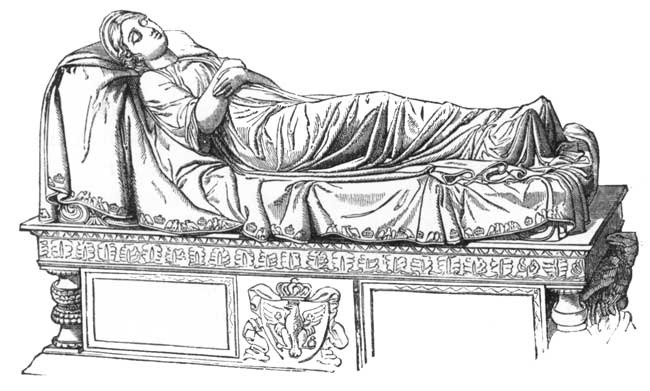 Fig. 121.—Statue of Queen Louise.
Fig. 121.—Statue of Queen Louise.Christian Frederic Tieck (1776-1851) was an eminent sculptor of his time, and decorated with sculpture some of the fine edifices erected at Berlin by Schinkel. He was very active in establishing a gallery of models from the antique at Berlin, and was a Director of the Sculptures in the Museum as well as a member of the Academy. His most successful original works were portrait busts, and he had many notable people among his sitters. Among them were the Emperor of Germany, the King of Bavaria, Schelling, Goethe, Lessing, and many others.
Christian Rauch (1777-1857). This eminent sculptor was born at Waldeck, and followed the manner of Schadow, which he carried to its perfection. His statue of Queen Louise (Fig. 121) is one of the finest works of modern sculpture, and his statues of the Generals Scharnhorst and Bülow, in Ber[Pg 271]lin, are very fine; the reliefs upon the pedestals are of classic beauty. But his masterpiece is the grand Friedrichs monument. Rauch executed many excellent busts; he made good portraits, and yet he elevated the character of his subjects to the greatest nobleness of which they were capable. As a rule Rauch avoided religious subjects, but late in life he modelled the group of Moses supported in prayer by Aaron and Hur.
Among his important works are the statue of Blücher, at Breslau; that of August Hermann Franke, at Halle; Dürer, at Nuremberg; monument to Maximilian I., at Munich; and six marble Victories for the Walhalla. His works are numerous, and in them we feel that this artist had not a great imaginative power; he rarely conceived imaginary subjects, but he took some fact or personality as his motive, and elevated it to the highest point to which it could be brought, and under his masterly style of execution produced splendid results.
Ernst Rietschel (1804-1860) was a gifted pupil of Rauch. After spending some time in Rome he settled in Dresden, and executed the statue of Friederich August of Saxony, for the Zwingerhof, when but twenty-seven years old. His chief excellence was in portrait statues, and those of Lessing and Luther are remarkable for their powerful expression of the intellectual and moral force of those men. His religious subjects were full of deep feeling, and his lighter works have a charming grace about them.
Ludwig Schwanthaler (1802-1848) studied much in Rome, and was as devoted to the antique as was Thorwaldsen. He executed many works in Munich, the principal ones being the interior decoration of the Glyptothek; also that of the Königsbau and two groups for the Walhalla. A prominent work by this master is the bronze statue of Bavaria, which is fifty-four feet high and stands in front of the Ruhmeshalle. He also made twelve gilt-bronze statues[Pg 272] of Bavarian sovereigns. Schwanthaler had remarkable powers of invention and a fruitful imagination; in these points he ranks with the first of modern sculptors; but his works rarely rise above what we call decorative art, and in spite of his excellent gifts he lacked the power to arouse any enthusiasm for his statues.
There are many other names that might be mentioned in connection with modern sculpture in Germany. Nowhere have the monuments and portrait statues and busts reached a higher excellence than in what we may call, in general terms, the Berlin school. Profound attention has been given to the proper reproduction of the individual characters of its subjects, while the art has not been allowed to sink into caricature or commonplaceness. Nowhere does the traveller better appreciate the art of our own day than in the sculpture of Germany.
But there are exceptions to this rule; some such artists as Theodore Kalide and Ludwig Wichmann are wanting in the serious qualities of Schadow, Rauch, and their followers, and sometimes fall into a coarse realism; but in spite of this, the revival of love for the antique, which began with Canova and his time, has borne rich fruit in the works of modern German sculptors.
In France the spirit of modern sculpture has been largely that of the severe classic style, and it has shown many of the same qualities that we have seen in modern German sculpture; but the different characteristics of the two nations have had their influence here as in everything else. In France the artist has aimed at a fine effect—flowing outline and dazzling representations of dramatic motives—far more than the northern sculptors have done. There is less thought and depth of feeling, more outward attraction and striking effect. The classic taste which asserted itself in the time of Canova was adopted in France, but in a French manner; and one of the earliest artists who showed[Pg 273] its effects was François Joseph Bosio (1769-1845), who was much honored. He was made a member of the Institute of France and of the Royal Academy of Berlin: he was chief sculptor to the King of France, and executed many public works. He made many portrait busts of the royal family and other prominent persons, but his chief works were the reliefs on the column of the Place Vendôme, the Chariot on the arch of the Place du Carrousel, the[Pg 274] monument to the Countess Demidoff, and statues of mythological heroes and heroines. For the Chapelle Expiatoire, Bosio executed a group representing Louis XVII. receiving comfort from an angel; the design is not as good as in some of his classic works, but the conception is pure and noble.
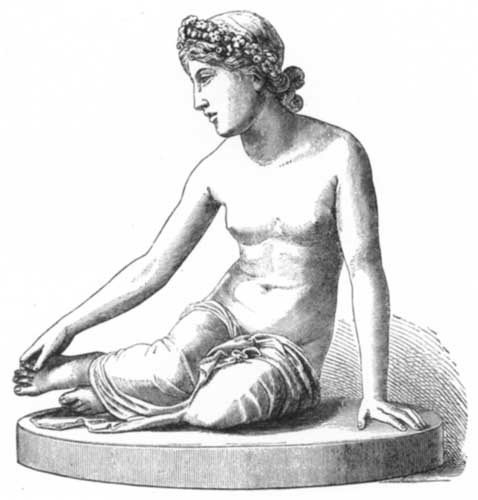 Fig. 122.—Nymph.
Fig. 122.—Nymph.James Pradier (1790-1832), though born in Geneva, was essentially a French sculptor, and excelled the artists of his day in his representations of feminine beauty. His masterpiece is a fountain at Nimes, in which the figures are fine and the drapery noble and distinct in treatment. The serious and comic Muses of the Fountain Molière are excellent works. He made several separate statues which are well known; his Psyche has a butterfly poised on the upper part of the arm; Atalanta is fastening her sandals; Sappho is in despair. His Niobe group showed his power to represent bold action, and his Prometheus chained, erected in the garden of the Tuileries, is grand and spirited.
We could name a great number of French sculptors belonging to this period whose works are seen in many public places which they adorn, but whose genius was not sufficient to place them in the first ranks of the world's artists, or make the accounts of them anything more than a list of works which has little meaning, except when one stands before them. Perhaps no one man had so wide an influence upon this art as had Pierre Jean David (1793-1856), who is called David of Angers, which was his birthplace, in order to distinguish him from Jacques Louis David, the great painter, who was like a father to this sculptor, though in no way connected with him by ties of kindred, as far as we know. But when the sculptor went to Paris, a very poor boy, David the painter, whose attention was called to him in some way, was his friend, and gave him lessons in drawing and aided him in other ways. In 1811 David of Angers obtained the prize which enabled him to go to[Pg 275] Rome, and after his return to Paris he was constantly employed. The amount of his work was enormous; many of his statues were colossal, and he executed a great number of busts and more than ninety medallions.
He made the statue of Mme. de Staël; one of Talma for the Théâtre Français; the colossal statue of King René at Aix; monument to Fénelon at Cambray; the statue of the great Condé at Versailles; the Gutenberg memorial at Strasburg, which is one of his most successful works, and a large number of other sculptures.
His chief characteristic is realism, and he carried this so far that it frequently became coarseness. David designed the relief for the pediment of the Pantheon. The inscription on the building declares that it is dedicated by a grateful country to its great men, and the sculptor seems to have had this in mind, for he represented in his group a figure of France surrounded by those who had been great in its times of war and days of peace. It is too realistic to be pleasing, and is far less creditable to the sculptor than are many of his less prominent works.
If little can be said of the modern French sculpture prior to our immediate time, there is still less to be told of that of England. There are many public monuments there, but they do not show forth any high artistic genius or rise above the commonplace except in very rare instances. There is but one English sculptor of whom I shall speak. John Gibson (1791-1866) was born near Conway, in Wales. When he was nine years old his parents went to Liverpool with the intention of sailing for America; but they gave up the idea, and the boy was sent to school in Liverpool. Before this he had been in the habit of drawing and of making sketches of anything that he saw and was pleased with; he now studied the prints in the shop windows, and made pictures, which he sold to his fellow-pupils. He attracted the attention of a print-seller, who was so interested in him[Pg 276] that he allowed him to draw from studies and casts from the antique which he had. When fourteen years old the boy was apprenticed to a cabinet-maker, but after a year he persuaded his employer to allow him to leave his shop, and was then apprenticed to a wood-carver. He did not stop at this, however, for when he became acquainted with the Messrs. Francis, who had a marble-yard, he persuaded his second master to release him, and was apprenticed for the third time, and in this case to the occupation which he had determined should be that of his life.
He was now very happy, and his improvement in drawing, modelling, and working in marble was very rapid. After a few months he made the acquaintance of William Roscoe, who became his friend and patron. He remained in Liverpool until he was twenty-seven years old; he had improved every advantage within his reach, but he was very desirous of travelling. In 1817, armed with a few letters of introduction, he went to London, where he obtained several orders, and in October of that year went to Rome.
He had a letter to Canova, who took him under his care and gave him admission to the classes in the Academy, in which he could draw from living models. In 1819 he received his first important commission; it was from the Duke of Devonshire for a group of Mars and Cupid. From this time he advanced steadily in his profession, and was always busy. He lived twenty-seven years in Rome, and passed his summers in Innsbrück.
In 1844 he went to Liverpool to oversee the erection of his statue of Mr. Huskisson; he was received with enthusiasm, and when he went to Glasgow to superintend the placing of his statue of Mr. Finlay in the Merchants' Hall his reception was even more flattering, as it was given him simply as an artist, and not connected with any former associations, as in Liverpool. During this visit to England Gibson was summoned to Windsor to make a statue of[Pg 277] Queen Victoria, which he completed after his return to Rome. The queen was represented in a classical costume, and the diadem, sandals, and borders of the drapery were colored. This was very much criticised and much was written and said about it; Gibson took little notice of all this, and simply answered it by saying, "Whatever the Greeks did was right."
In 1851 Gibson sustained a great loss in the death of his brother Ben, who had lived with him in Rome for fourteen years. Five years later, when in perfect health, the sculptor was attacked by paralysis, and lived but a short time. He was buried in the English cemetery at Rome, and Lord Lytton wrote the inscription upon his monument. It says: "His native genius strengthened by careful study, he infused the spirit of Grecian art into masterpieces all his own. His character as a man was in unison with his attributes as an artist—beautiful in its simplicity and truthfulness, noble in its dignity and elevation." A monument was also raised to Gibson in the church at Conway.
The master left the models of all his works and the larger part of his fortune to the Royal Academy in London. Among his works are Mars and Cupid, at Chatsworth; Psyche borne by Zephyrs, in the Palazzo Torlonia, at Rome, and a replica at St. Petersburg; Hylas surprised by Nymphs, in the National Gallery, London; Sleeping Shepherd Boy, in the Lenox collection in New York; Cupid disguised as a Shepherd, which he often repeated; portraits of Queen Victoria, at Buckingham Palace and Osborne; Sir Robert Peel, in Westminster Abbey; George Stephenson, in St. George's Hall, Liverpool; eighteen portrait busts; sixteen bas-reliefs of ideal subjects and sixteen others for monuments to the dead. A large part of these are in the chapel of the Liverpool Cemetery. He modelled a bas-relief of Christ blessing little children.
Gibson found his entire happiness in his art. In his[Pg 278] own words, he worked on "happily and with ever new pleasure, avoiding evil and with a calm soul, making images, not for worship, but for the love of the beautiful. The beautiful elevates us above the crowd in this world; the ideal, higher—yes, higher still, to celestial beauty, the fountain of all. Socrates said that outward beauty was the sign of the inward; in the life of a man, as in an image, every part should be beautiful."
He was never elated by praise; he was glad of tributes which proved that he was respected, but he received all honors with a simplicity of self-respect which spoke the sincere nobility of his nature.
There are many amusing anecdotes told of his absentmindedness about everything not connected with his art. Miss Harriet Hosmer was his only pupil, and she said of him: "He is a god in his studio, but God help him when he is out of it." He never could master the ins and outs of railroad travelling, and even when put in the right train at the right time he would be sure to get out at the wrong place at the wrong time.
On one of his journeys, when he supposed he was at the right place, he got out and asked the porter to show him the way to the cathedral. In his own account he said: "But the scoundrel would have it there was no cathedral in the place, and at last had the impudence to ask me if I knew where I was. Then I discovered that instead of being in Chichester, where I had a particular appointment with the dean and chapter, I was safe in Portsmouth, where there was no cathedral at all."
The time has not come for any comprehensive estimate of the sculpture of our own country. So many of our artists are still living that it would be unjust to speak of them in connection with those whose work is complete and whose rank is fixed as a matter of history. We have no right to say of one who is still working that he has reached his full[Pg 279] height, and even after death a certain period must elapse before the true merit of an artist can be established and his name written in its just place upon the roll of fame. So, in leaving this subject, we will turn again to the land of which we first spoke in considering modern sculpture. In Italy this art has not risen above the elevation to which Canova and Thorwaldsen brought it; for though the last was a Dane, his work may truly be said to belong to the Roman school. We must regard Italy as the land of art in a peculiar sense, but it is easy to understand that under the political misfortunes which she has suffered an advance in artistic life could not be made. Now, when a new spirit is active there, and a freer thought prevails in other directions, may we not believe that in the arts there will be a revival of the best inspiration that has ever come to that home of grace and beauty?
As we glance over the entire civilized world of to-day we find an immense activity in all matters pertaining to the fine arts. Schools and academies are multiplied everywhere, and the interest in works of art is universal. Many a private gentleman is to-day as liberal a patron of artists as were the princes and nobles of the past. It is as if there were a vast crucible in which artists of all nations are being tested, and from this testing of their metal it would seem that much pure gold must come forth.
As we review the history of sculpture from its earliest days to the present, we are compelled to linger lovingly with the Greek or classic art. The period in which it existed was a blessed period for the sculptor. We all know that the best foundation for the excellence of art is the study and reproduction of nature, and in the times of the Greeks there was no reason why the human form, the most beautiful object in nature, should not be used by the sculptor for the decoration of the temple, for the statues of the public square or theatre, or for any position in which sculpture[Pg 280] could be used at all. The customs of modern life are opposed to this free exhibition of nude forms, and the difficulties that are thrown in the way of the sculptor by this one fact are almost more than we can realize; and the task of draping a figure and yet showing its shape and indicating its proper proportions and action is one before which even a Greek sculptor would have reason to doubt himself.
On the other hand, when a sculptor does succeed in producing a draped figure which satisfies artistic taste, he has achieved much, and merits the highest praise. A drapery which has gracefully composed masses and flowing lines adds great dignity to the figure of a patriarch or a prophet, and there are numerous subjects, religious and monumental, in which a full, graceful drapery is requisite; but when, as is often the case, the sculptor is required to reproduce the actual costume of the day, what can we look for? The truth is, it has no grace in itself; what, then, must it be when put into the fixedness of bronze or marble? Yet where is the remedy for this? We do not wish to see the men whom we have known and who have moved among us in the dress of other men put into an antique disguise by the sculptor; the incongruity of this is too apparent. Much has been written and said upon these points, and no solution of the difficulty has been found; but it is only just that when we judge of the statues made under such difficulties, we should remember them and give the artist the benefit of the consideration of all the hindrances that exist for him.
Westmacott, in his "Handbook of Sculpture," gives as his "Conclusion" an account of the mechanical methods of the sculptor, and I believe that I can add nothing here which will be of greater use to my readers than a quotation from that author.
"The artist, having invented or conceived his subject, usually begins by making a small sketch of it in some soft[Pg 281] and obedient substance, as clay or wax. He can change or alter this at his pleasure till he is satisfied with the lines and masses of the composition, and the proportions it will command of light and shadow. He then proceeds to copy this small but useful sketch, as his guide, in its general arrangement, for his full-sized model. Before commencing the larger model it is necessary to form a sort of skeleton or framework of iron and wood, with joints made of wire, to support the great mass of clay in which the figure or group is now to be executed. This iron frame is firmly fixed upon a turning bench, or banker, so that the model may be constantly moved without difficulty, so as to be seen in different lights and in various points of view. As the clay is likely to shrink as it gets dry, it is necessary occasionally to wet it. This is done by sprinkling water over it with a brush, or from a large syringe, and by laying damp cloths upon it. This is the ordinary process for making a model in the 'round.'
"In modelling in rilievo of either kind, alto or basso, a plane or ground is prepared upon which the design is, or should be, carefully drawn. This may be made of clay floated or laid upon a board, or the ground may be of slate, or even of wood, though the latter is objectionable, in large works especially, from its liability to shrink and to be warped by the action of damp or moisture. The clay is then laid in small quantities upon this ground, the outline being bounded by the drawing, which should be carefully preserved; and the bulk or projection of the figures is regulated by the degree of relief the sculptor desires to give to his design.
"If the final work is to be baked in clay (terra-cotta) there must be no iron or wooden nucleus, as it would interfere with the model drying regularly and uniformly, and probably cause it to crack in shrinking. The model is therefore prepared for drying without such support. When[Pg 282] perfectly free from moisture the model is placed in an oven and baked slowly, by which it acquires great hardness and the peculiar brownish-red color seen in these works. This art has been brought to great perfection in England in modern days.
"If the final work is to be in marble, or bronze, or only in plaster, the next process after finishing the model is to mould it, in preparation for its being reproduced in a material that will bear moving about without risk of injury to the design. This is done by covering it with a mixture of plaster of Paris with water, which quickly sets or becomes consistent, forming a hard and thick coating over the whole. The clay is then carefully picked out, and an exact matrix, or form, remains. This is washed clean, and the interior is then brushed over with any greasy substance, usually a composition of soap and oil, to prevent the plaster with which it is next to be filled adhering too firmly to it. The fresh plaster is mixed to about the consistency of cream and then poured into the mould, which is gently moved about till the inner surface is entirely filled or covered, so that all parts may be reached. The thickness or substance of the coating depends upon the size of the work and the degree of strength required.
"When the newly introduced plaster is set the mould is carefully knocked away with chisels, and a true cast appears beneath, giving an entire fac-simile of the original model. Some skill is required in making moulds, in order to provide for projecting parts and under-cuttings; practice alone can teach the artist how to deal with those difficulties when they occur. The above general instructions sufficiently explain the ordinary processes of moulding and casting in plaster.
"In metal-casting or founding great attention must be paid to the strengthening of the parts to bear the weight of the metal; but the principle described in plaster-moulding[Pg 283] applies also to the preparation for metal-casting. The mixture of metals to form bronze, the proper heating of the furnace, burning and uniting parts, chasing and other processes of founding cannot be fully described in this place. They belong to a distinct practice, and to be well understood must be studied in the foundry.
"If the model—now reproduced in plaster—is to be copied in marble or stone, the first step is to procure a block of the required size. Two stones, called scale-stones, are then prepared, upon one of which the model or plaster cast is placed, and upon the other the rough block of marble. The fronts of these stones have figured marks or 'scales,' to use the technical term, exactly corresponding. An instrument capable of being easily moved, and which is fitted up with socket-joints and movable arms, is then applied to the scale-stone of the model, and a projecting point or 'needle' is made to touch a particular part of the model itself. This is carefully removed to the scale-stone of the rough block, and the marble is cut away till the 'needle' reaches so far into the block as to correspond with the 'point' taken on the model. A pencil-mark is then made to show that the point is found and registered. This process is repeated all over the model and block, alternately, till a rough copy or shape of the model is entirely made. These 'pointing' machines are not always precisely alike in their forms, but the principle upon which they act is exactly similar in all. The statue being thus rudely shaped out, the block is placed in the hands of a superior workman, called a 'carver,' who, having the plastic model near at hand to refer to, copies the more minute portions of the work by means of chisels, rasps, and files, the pencil-marks made by the 'pointer' showing him the precise situation of the parts and the limit beyond which he is not to penetrate into the marble. When the carver has carried the work as far as the sculptor desires, he proceeds himself to give it[Pg 284] the finishing touches, improving the details of form and expression, managing the different effects produced by two different materials—one, the plastic model, being opaque; the other, the marble, being considerably diaphanous; giving the proper varieties of texture in the flesh, hair, and drapery, and, more especially, harmonizing the whole.
"The rich quality of surface that appears more or less in works of marble is produced by rubbing with fine sand or pumice-stone and other substances, and the ancients appear to have completed this part of their work by a process which is called 'circumlitio,' and may mean not only rubbing or polishing, but applying some composition, such as hot wax, to give a soft, glowing color to the surface. Many of the ancient statues certainly exhibit the appearance of some foreign substance having slightly penetrated the surface of the work to about one eighth of an inch, and its color is of a warmer tint than the marble below it; a process, be it observed, quite distinct from and not to be confounded with polychromy, or what is usually understood by painting sculpture with various tints, in imitation of the natural color of the complexion, hair, and eyes. Its object, probably, with the ancients as with modern sculptors, has been simply to get rid of the glare and freshness of appearance that is sometimes objected to in a recently finished work, by giving a general warmth to the color of the marble."[Pg 285]
End of the Project Gutenberg EBook of A History of Art for Beginners and
Students, by Clara Erskine Clement
*** END OF THIS PROJECT GUTENBERG EBOOK A HISTORY OF ART ***
***** This file should be named 25632-h.htm or 25632-h.zip *****
This and all associated files of various formats will be found in:
https://www.gutenberg.org/2/5/6/3/25632/
Produced by Juliet Sutherland, Janet Blenkinship and the
Online Distributed Proofreading Team at https://www.pgdp.net
Updated editions will replace the previous one--the old editions
will be renamed.
Creating the works from public domain print editions means that no
one owns a United States copyright in these works, so the Foundation
(and you!) can copy and distribute it in the United States without
permission and without paying copyright royalties. Special rules,
set forth in the General Terms of Use part of this license, apply to
copying and distributing Project Gutenberg-tm electronic works to
protect the PROJECT GUTENBERG-tm concept and trademark. Project
Gutenberg is a registered trademark, and may not be used if you
charge for the eBooks, unless you receive specific permission. If you
do not charge anything for copies of this eBook, complying with the
rules is very easy. You may use this eBook for nearly any purpose
such as creation of derivative works, reports, performances and
research. They may be modified and printed and given away--you may do
practically ANYTHING with public domain eBooks. Redistribution is
subject to the trademark license, especially commercial
redistribution.
*** START: FULL LICENSE ***
THE FULL PROJECT GUTENBERG LICENSE
PLEASE READ THIS BEFORE YOU DISTRIBUTE OR USE THIS WORK
To protect the Project Gutenberg-tm mission of promoting the free
distribution of electronic works, by using or distributing this work
(or any other work associated in any way with the phrase "Project
Gutenberg"), you agree to comply with all the terms of the Full Project
Gutenberg-tm License (available with this file or online at
https://gutenberg.org/license).
Section 1. General Terms of Use and Redistributing Project Gutenberg-tm
electronic works
1.A. By reading or using any part of this Project Gutenberg-tm
electronic work, you indicate that you have read, understand, agree to
and accept all the terms of this license and intellectual property
(trademark/copyright) agreement. If you do not agree to abide by all
the terms of this agreement, you must cease using and return or destroy
all copies of Project Gutenberg-tm electronic works in your possession.
If you paid a fee for obtaining a copy of or access to a Project
Gutenberg-tm electronic work and you do not agree to be bound by the
terms of this agreement, you may obtain a refund from the person or
entity to whom you paid the fee as set forth in paragraph 1.E.8.
1.B. "Project Gutenberg" is a registered trademark. It may only be
used on or associated in any way with an electronic work by people who
agree to be bound by the terms of this agreement. There are a few
things that you can do with most Project Gutenberg-tm electronic works
even without complying with the full terms of this agreement. See
paragraph 1.C below. There are a lot of things you can do with Project
Gutenberg-tm electronic works if you follow the terms of this agreement
and help preserve free future access to Project Gutenberg-tm electronic
works. See paragraph 1.E below.
1.C. The Project Gutenberg Literary Archive Foundation ("the Foundation"
or PGLAF), owns a compilation copyright in the collection of Project
Gutenberg-tm electronic works. Nearly all the individual works in the
collection are in the public domain in the United States. If an
individual work is in the public domain in the United States and you are
located in the United States, we do not claim a right to prevent you from
copying, distributing, performing, displaying or creating derivative
works based on the work as long as all references to Project Gutenberg
are removed. Of course, we hope that you will support the Project
Gutenberg-tm mission of promoting free access to electronic works by
freely sharing Project Gutenberg-tm works in compliance with the terms of
this agreement for keeping the Project Gutenberg-tm name associated with
the work. You can easily comply with the terms of this agreement by
keeping this work in the same format with its attached full Project
Gutenberg-tm License when you share it without charge with others.
1.D. The copyright laws of the place where you are located also govern
what you can do with this work. Copyright laws in most countries are in
a constant state of change. If you are outside the United States, check
the laws of your country in addition to the terms of this agreement
before downloading, copying, displaying, performing, distributing or
creating derivative works based on this work or any other Project
Gutenberg-tm work. The Foundation makes no representations concerning
the copyright status of any work in any country outside the United
States.
1.E. Unless you have removed all references to Project Gutenberg:
1.E.1. The following sentence, with active links to, or other immediate
access to, the full Project Gutenberg-tm License must appear prominently
whenever any copy of a Project Gutenberg-tm work (any work on which the
phrase "Project Gutenberg" appears, or with which the phrase "Project
Gutenberg" is associated) is accessed, displayed, performed, viewed,
copied or distributed:
This eBook is for the use of anyone anywhere at no cost and with
almost no restrictions whatsoever. You may copy it, give it away or
re-use it under the terms of the Project Gutenberg License included
with this eBook or online at www.gutenberg.org
1.E.2. If an individual Project Gutenberg-tm electronic work is derived
from the public domain (does not contain a notice indicating that it is
posted with permission of the copyright holder), the work can be copied
and distributed to anyone in the United States without paying any fees
or charges. If you are redistributing or providing access to a work
with the phrase "Project Gutenberg" associated with or appearing on the
work, you must comply either with the requirements of paragraphs 1.E.1
through 1.E.7 or obtain permission for the use of the work and the
Project Gutenberg-tm trademark as set forth in paragraphs 1.E.8 or
1.E.9.
1.E.3. If an individual Project Gutenberg-tm electronic work is posted
with the permission of the copyright holder, your use and distribution
must comply with both paragraphs 1.E.1 through 1.E.7 and any additional
terms imposed by the copyright holder. Additional terms will be linked
to the Project Gutenberg-tm License for all works posted with the
permission of the copyright holder found at the beginning of this work.
1.E.4. Do not unlink or detach or remove the full Project Gutenberg-tm
License terms from this work, or any files containing a part of this
work or any other work associated with Project Gutenberg-tm.
1.E.5. Do not copy, display, perform, distribute or redistribute this
electronic work, or any part of this electronic work, without
prominently displaying the sentence set forth in paragraph 1.E.1 with
active links or immediate access to the full terms of the Project
Gutenberg-tm License.
1.E.6. You may convert to and distribute this work in any binary,
compressed, marked up, nonproprietary or proprietary form, including any
word processing or hypertext form. However, if you provide access to or
distribute copies of a Project Gutenberg-tm work in a format other than
"Plain Vanilla ASCII" or other format used in the official version
posted on the official Project Gutenberg-tm web site (www.gutenberg.org),
you must, at no additional cost, fee or expense to the user, provide a
copy, a means of exporting a copy, or a means of obtaining a copy upon
request, of the work in its original "Plain Vanilla ASCII" or other
form. Any alternate format must include the full Project Gutenberg-tm
License as specified in paragraph 1.E.1.
1.E.7. Do not charge a fee for access to, viewing, displaying,
performing, copying or distributing any Project Gutenberg-tm works
unless you comply with paragraph 1.E.8 or 1.E.9.
1.E.8. You may charge a reasonable fee for copies of or providing
access to or distributing Project Gutenberg-tm electronic works provided
that
- You pay a royalty fee of 20% of the gross profits you derive from
the use of Project Gutenberg-tm works calculated using the method
you already use to calculate your applicable taxes. The fee is
owed to the owner of the Project Gutenberg-tm trademark, but he
has agreed to donate royalties under this paragraph to the
Project Gutenberg Literary Archive Foundation. Royalty payments
must be paid within 60 days following each date on which you
prepare (or are legally required to prepare) your periodic tax
returns. Royalty payments should be clearly marked as such and
sent to the Project Gutenberg Literary Archive Foundation at the
address specified in Section 4, "Information about donations to
the Project Gutenberg Literary Archive Foundation."
- You provide a full refund of any money paid by a user who notifies
you in writing (or by e-mail) within 30 days of receipt that s/he
does not agree to the terms of the full Project Gutenberg-tm
License. You must require such a user to return or
destroy all copies of the works possessed in a physical medium
and discontinue all use of and all access to other copies of
Project Gutenberg-tm works.
- You provide, in accordance with paragraph 1.F.3, a full refund of any
money paid for a work or a replacement copy, if a defect in the
electronic work is discovered and reported to you within 90 days
of receipt of the work.
- You comply with all other terms of this agreement for free
distribution of Project Gutenberg-tm works.
1.E.9. If you wish to charge a fee or distribute a Project Gutenberg-tm
electronic work or group of works on different terms than are set
forth in this agreement, you must obtain permission in writing from
both the Project Gutenberg Literary Archive Foundation and Michael
Hart, the owner of the Project Gutenberg-tm trademark. Contact the
Foundation as set forth in Section 3 below.
1.F.
1.F.1. Project Gutenberg volunteers and employees expend considerable
effort to identify, do copyright research on, transcribe and proofread
public domain works in creating the Project Gutenberg-tm
collection. Despite these efforts, Project Gutenberg-tm electronic
works, and the medium on which they may be stored, may contain
"Defects," such as, but not limited to, incomplete, inaccurate or
corrupt data, transcription errors, a copyright or other intellectual
property infringement, a defective or damaged disk or other medium, a
computer virus, or computer codes that damage or cannot be read by
your equipment.
1.F.2. LIMITED WARRANTY, DISCLAIMER OF DAMAGES - Except for the "Right
of Replacement or Refund" described in paragraph 1.F.3, the Project
Gutenberg Literary Archive Foundation, the owner of the Project
Gutenberg-tm trademark, and any other party distributing a Project
Gutenberg-tm electronic work under this agreement, disclaim all
liability to you for damages, costs and expenses, including legal
fees. YOU AGREE THAT YOU HAVE NO REMEDIES FOR NEGLIGENCE, STRICT
LIABILITY, BREACH OF WARRANTY OR BREACH OF CONTRACT EXCEPT THOSE
PROVIDED IN PARAGRAPH F3. YOU AGREE THAT THE FOUNDATION, THE
TRADEMARK OWNER, AND ANY DISTRIBUTOR UNDER THIS AGREEMENT WILL NOT BE
LIABLE TO YOU FOR ACTUAL, DIRECT, INDIRECT, CONSEQUENTIAL, PUNITIVE OR
INCIDENTAL DAMAGES EVEN IF YOU GIVE NOTICE OF THE POSSIBILITY OF SUCH
DAMAGE.
1.F.3. LIMITED RIGHT OF REPLACEMENT OR REFUND - If you discover a
defect in this electronic work within 90 days of receiving it, you can
receive a refund of the money (if any) you paid for it by sending a
written explanation to the person you received the work from. If you
received the work on a physical medium, you must return the medium with
your written explanation. The person or entity that provided you with
the defective work may elect to provide a replacement copy in lieu of a
refund. If you received the work electronically, the person or entity
providing it to you may choose to give you a second opportunity to
receive the work electronically in lieu of a refund. If the second copy
is also defective, you may demand a refund in writing without further
opportunities to fix the problem.
1.F.4. Except for the limited right of replacement or refund set forth
in paragraph 1.F.3, this work is provided to you 'AS-IS' WITH NO OTHER
WARRANTIES OF ANY KIND, EXPRESS OR IMPLIED, INCLUDING BUT NOT LIMITED TO
WARRANTIES OF MERCHANTIBILITY OR FITNESS FOR ANY PURPOSE.
1.F.5. Some states do not allow disclaimers of certain implied
warranties or the exclusion or limitation of certain types of damages.
If any disclaimer or limitation set forth in this agreement violates the
law of the state applicable to this agreement, the agreement shall be
interpreted to make the maximum disclaimer or limitation permitted by
the applicable state law. The invalidity or unenforceability of any
provision of this agreement shall not void the remaining provisions.
1.F.6. INDEMNITY - You agree to indemnify and hold the Foundation, the
trademark owner, any agent or employee of the Foundation, anyone
providing copies of Project Gutenberg-tm electronic works in accordance
with this agreement, and any volunteers associated with the production,
promotion and distribution of Project Gutenberg-tm electronic works,
harmless from all liability, costs and expenses, including legal fees,
that arise directly or indirectly from any of the following which you do
or cause to occur: (a) distribution of this or any Project Gutenberg-tm
work, (b) alteration, modification, or additions or deletions to any
Project Gutenberg-tm work, and (c) any Defect you cause.
Section 2. Information about the Mission of Project Gutenberg-tm
Project Gutenberg-tm is synonymous with the free distribution of
electronic works in formats readable by the widest variety of computers
including obsolete, old, middle-aged and new computers. It exists
because of the efforts of hundreds of volunteers and donations from
people in all walks of life.
Volunteers and financial support to provide volunteers with the
assistance they need, is critical to reaching Project Gutenberg-tm's
goals and ensuring that the Project Gutenberg-tm collection will
remain freely available for generations to come. In 2001, the Project
Gutenberg Literary Archive Foundation was created to provide a secure
and permanent future for Project Gutenberg-tm and future generations.
To learn more about the Project Gutenberg Literary Archive Foundation
and how your efforts and donations can help, see Sections 3 and 4
and the Foundation web page at https://www.pglaf.org.
Section 3. Information about the Project Gutenberg Literary Archive
Foundation
The Project Gutenberg Literary Archive Foundation is a non profit
501(c)(3) educational corporation organized under the laws of the
state of Mississippi and granted tax exempt status by the Internal
Revenue Service. The Foundation's EIN or federal tax identification
number is 64-6221541. Its 501(c)(3) letter is posted at
https://pglaf.org/fundraising. Contributions to the Project Gutenberg
Literary Archive Foundation are tax deductible to the full extent
permitted by U.S. federal laws and your state's laws.
The Foundation's principal office is located at 4557 Melan Dr. S.
Fairbanks, AK, 99712., but its volunteers and employees are scattered
throughout numerous locations. Its business office is located at
809 North 1500 West, Salt Lake City, UT 84116, (801) 596-1887, email
business@pglaf.org. Email contact links and up to date contact
information can be found at the Foundation's web site and official
page at https://pglaf.org
For additional contact information:
Dr. Gregory B. Newby
Chief Executive and Director
gbnewby@pglaf.org
Section 4. Information about Donations to the Project Gutenberg
Literary Archive Foundation
Project Gutenberg-tm depends upon and cannot survive without wide
spread public support and donations to carry out its mission of
increasing the number of public domain and licensed works that can be
freely distributed in machine readable form accessible by the widest
array of equipment including outdated equipment. Many small donations
($1 to $5,000) are particularly important to maintaining tax exempt
status with the IRS.
The Foundation is committed to complying with the laws regulating
charities and charitable donations in all 50 states of the United
States. Compliance requirements are not uniform and it takes a
considerable effort, much paperwork and many fees to meet and keep up
with these requirements. We do not solicit donations in locations
where we have not received written confirmation of compliance. To
SEND DONATIONS or determine the status of compliance for any
particular state visit https://pglaf.org
While we cannot and do not solicit contributions from states where we
have not met the solicitation requirements, we know of no prohibition
against accepting unsolicited donations from donors in such states who
approach us with offers to donate.
International donations are gratefully accepted, but we cannot make
any statements concerning tax treatment of donations received from
outside the United States. U.S. laws alone swamp our small staff.
Please check the Project Gutenberg Web pages for current donation
methods and addresses. Donations are accepted in a number of other
ways including including checks, online payments and credit card
donations. To donate, please visit: https://pglaf.org/donate
Section 5. General Information About Project Gutenberg-tm electronic
works.
Professor Michael S. Hart was the originator of the Project Gutenberg-tm
concept of a library of electronic works that could be freely shared
with anyone. For thirty years, he produced and distributed Project
Gutenberg-tm eBooks with only a loose network of volunteer support.
Project Gutenberg-tm eBooks are often created from several printed
editions, all of which are confirmed as Public Domain in the U.S.
unless a copyright notice is included. Thus, we do not necessarily
keep eBooks in compliance with any particular paper edition.
Most people start at our Web site which has the main PG search facility:
https://www.gutenberg.org
This Web site includes information about Project Gutenberg-tm,
including how to make donations to the Project Gutenberg Literary
Archive Foundation, how to help produce our new eBooks, and how to
subscribe to our email newsletter to hear about new eBooks.